Show HN Today: Discover the Latest Innovative Projects from the Developer Community
 ShowHN Today
ShowHN TodayShow HN Today: Top Developer Projects Showcase for 2025-07-30
SagaSu777 2025-07-31
Explore the hottest developer projects on Show HN for 2025-07-30. Dive into innovative tech, AI applications, and exciting new inventions!
Summary of Today’s Content
Trend Insights
The Hacker News projects reveal a surge in AI-driven solutions, particularly in the realm of AI agents capable of understanding and interacting with interfaces, marking a significant shift towards more intelligent automation. Developers should pay close attention to these advances, especially in vision-based AI and LLMs, as they represent a substantial evolution in human-computer interaction. Moreover, the trend of AI-powered productivity tools signals a growing demand for automated solutions, from document generation to code analysis and cloud management. Embrace these technologies to streamline your workflows and create new applications, remember the spirit of the hacker is to build and share so don't hesitate to put your innovations out there!
Today's Hottest Product
Name
Meka Agent
Highlight
This project introduces Meka Agent, an open-source framework that uses vision-based LLMs to execute tasks on a computer, mimicking human actions. The key innovation lies in its ability to 'see' the screen and interact with it, going beyond simple HTML reading. This addresses the limitations of existing browsing agents and provides a foundation for building powerful, vision-based agents. Developers can learn how to build agents that can handle OS-level controls, enabling them to automate complex tasks on any computer system.
Popular Category
AI Agents
Web Development
Productivity Tools
Popular Keyword
AI
Automation
Open Source
LLM
Technology Trends
Vision-based AI Agents: The ability of AI to 'see' and interact with digital interfaces is rapidly improving, opening doors to more sophisticated automation.
AI-powered Code Generation and Analysis: Tools are emerging that leverage AI to assist in code creation, documentation, and understanding, boosting developer productivity.
Automated Content Generation and Management: AI is transforming how content is created, curated, and delivered, from text to images and even video, enabling new levels of efficiency for creators.
Project Category Distribution
AI Agents & Automation (25%)
Developer Tools & Productivity (30%)
Content Creation & Management (20%)
Mobile Apps & Utilities (15%)
Data & Analytics (10%)
Today's Hot Product List
| Ranking | Product Name | Likes | Comments |
|---|---|---|---|
| 1 | Meka Agent: Vision-Based LLM Task Execution Framework | 82 | 23 |
| 2 | Frigade AI: Your Product's Personal AI Guide | 61 | 24 |
| 3 | Tiny4FSK: Ultra-Compact Flight Computer for High-Altitude Balloon Tracking | 37 | 20 |
| 4 | MoebiusXBIN: Text-Mode Art Weaver | 49 | 6 |
| 5 | Temporal Agent Orchestration with OpenAI Agents SDK | 28 | 0 |
| 6 | Temporal Agents: Making OpenAI Agents Bulletproof | 13 | 1 |
| 7 | Keyboard: Secure AI Automation with GitHub Codespaces | 5 | 7 |
| 8 | AI-Powered Word Search Game Generator | 3 | 9 |
| 9 | Webcode.sh: Claude Code in Your Browser | 9 | 2 |
| 10 | Sourcebot: Code Oracle - Ask Your Code Anything | 10 | 1 |
1
Meka Agent: Vision-Based LLM Task Execution Framework
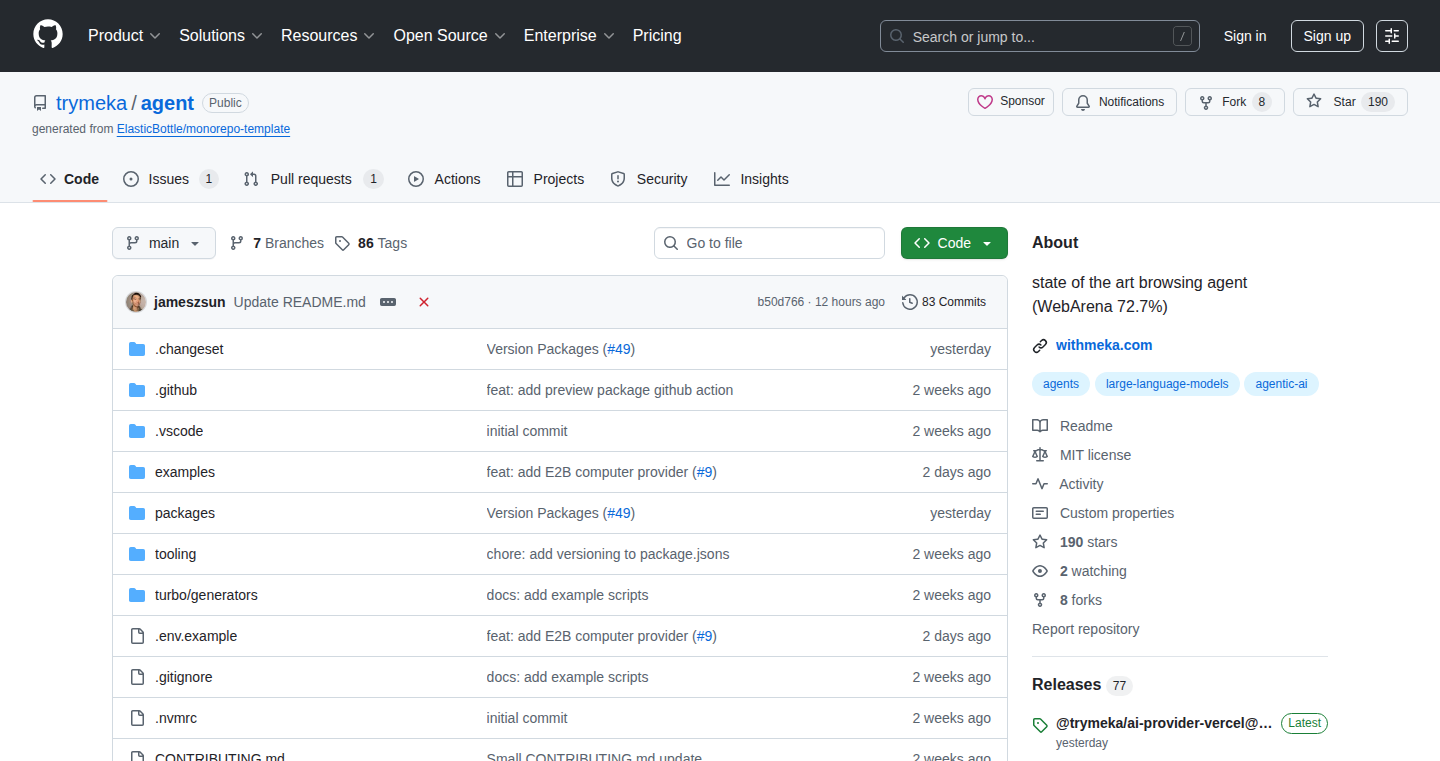
Author
ElasticBottle
Description
Meka Agent is an open-source framework enabling Large Language Models (LLMs) to directly interact with a computer, just like a human. It leverages vision-based control, meaning it "sees" the screen and identifies interactive elements instead of relying solely on HTML code. This allows Meka to perform tasks across the entire operating system, handling system dialogues, file uploads, and more. The framework boasts state-of-the-art performance and aims to empower developers to automate complex tasks with simple prompts, removing the need to delve into the intricate details of the underlying implementation.
Popularity
Points 82
Comments 23
What is this product?
Meka Agent is a system that lets a computer understand what's happening on your screen, then use that understanding to do things like click buttons, type text, and scroll. It uses a smart 'brain' (an LLM) that can 'see' the screen and make decisions. This is different from traditional web automation tools that only understand the underlying code of a webpage. This project offers a way for developers to build their own automated computer assistants, achieving 72.7% accuracy on the WebArena test, outperforming existing solutions. So, instead of writing complex code, you can tell the computer what you want it to do, and Meka handles the rest.
How to use it?
Developers can use Meka Agent by integrating it with their own LLMs and computer providers. It provides the basic building blocks for handling screen interactions, making it easier to build sophisticated automation systems. You can define tasks by giving the LLM instructions. For example, you could tell Meka to "Open a specific app, fill in a form, and click submit". This opens up a world of automation possibilities, allowing developers to create bots that can browse the web, fill out forms, interact with software, and much more. You can access the project on GitHub and get started quickly with their hosted platform, which simplifies the setup process. This allows developers to create automated systems that can handle tasks on any computer without needing to know the specific implementation details of the task itself.
Product Core Function
· Vision-based Control: Meka Agent 'sees' the computer screen and interacts with it visually. Value: This means it can handle complex tasks and interact with the computer in a way that standard automation tools cannot. Application: Automating tasks on any software, including those with complex interfaces or those that aren't web-based.
· Full Computer Access: Meka Agent operates at the operating system level. Value: It can interact with system dialogues, handle file uploads, and manage other interactions that browser-only automation tools can't. Application: Automating system tasks, such as uploading files to a website, filling in desktop application forms, and interacting with system-level menus.
· Extensible Design: Meka Agent is designed to be easily integrated with different LLMs and computer providers. Value: This flexibility enables developers to adapt it to different needs and use it with their preferred AI models. Application: Integrating various LLMs and task execution environments to build customized solutions. Developers can swap in different LLMs based on specific task requirements, allowing for enhanced accuracy or specific types of actions.
· State-of-the-Art Performance: Meka Agent achieved a 72.7% accuracy rate on the WebArena benchmark. Value: This highlights the advanced capabilities of the framework, making it highly effective at complex tasks. Application: Automating complex web-based tasks that require high accuracy and reliability, and are suitable for testing and quality assurance.
· Open Source and Developer-Friendly: Meka Agent provides a starting point for building vision-based agents. Value: It simplifies the process of developing complex automation systems, and open-source allows for contribution and adaptation. Application: This opens up the possibility for any developer to create their own powerful agents, contribute to the project, and adapt it for their particular use cases.
Product Usage Case
· QA Testing: Imagine a software company using Meka Agent to automatically test their applications. The agent could open the software, interact with its interface, and verify that it's working correctly. So you'd save time and reduce the risk of errors by automating repetitive testing tasks.
· Automated Data Entry: Consider a business that needs to extract data from multiple sources. Meka Agent could be used to automatically navigate websites, fill out forms, and enter data into a spreadsheet or database. So, you can streamline data entry processes and reduce the time spent on manual data input.
· Personal Productivity: Someone could use Meka Agent to automate their daily tasks on their computer. The agent could open emails, download attachments, and organize files. So you can boost personal productivity by automating repetitive tasks.
· Web Browsing Automation: Automate complex web workflows such as filling out forms and interacting with dynamic websites. For example, an agent could automatically apply for multiple jobs by filling out online forms. So, you could achieve the same results with less effort.
2
Frigade AI: Your Product's Personal AI Guide
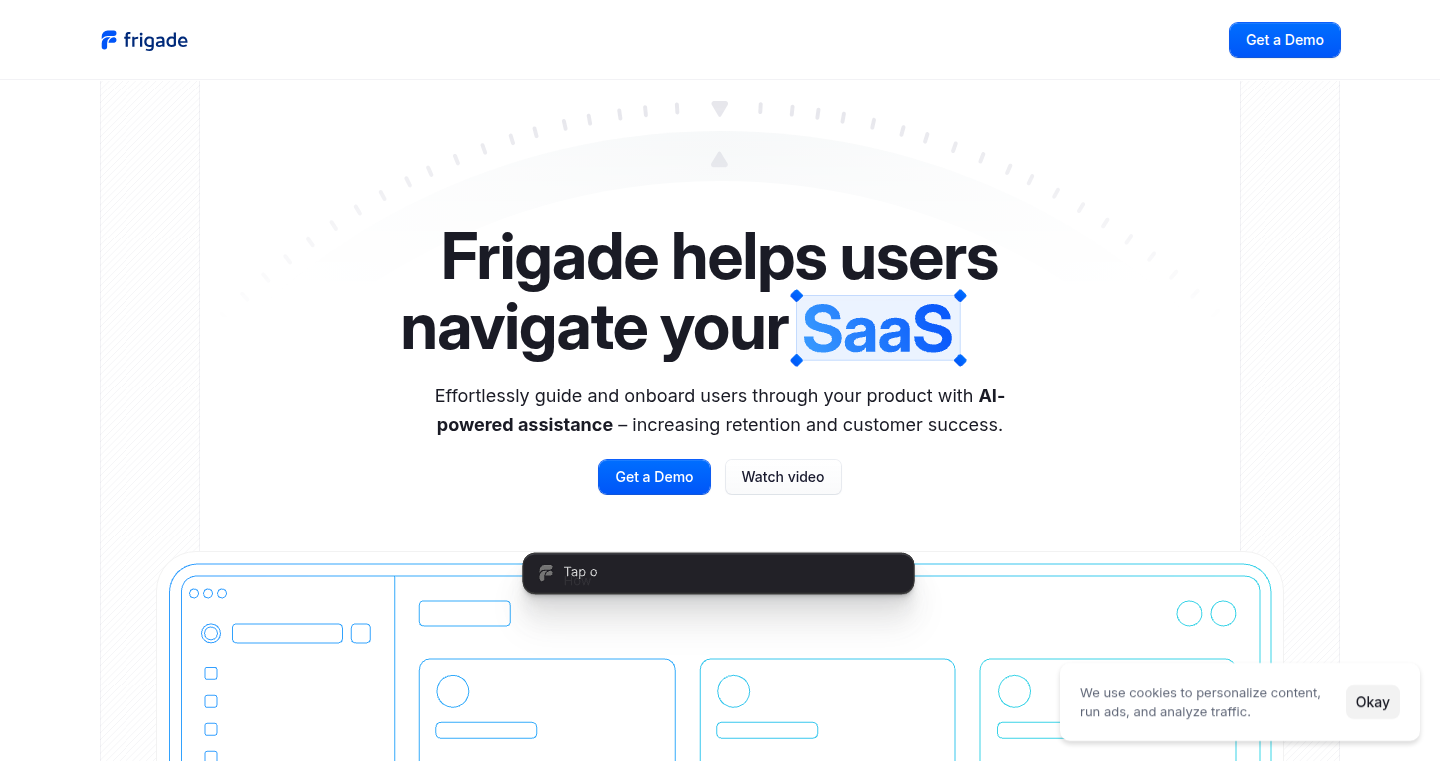
Author
pancomplex
Description
Frigade AI is an AI agent that learns how to use any web-based product. It guides users directly in the UI, automatically generates documentation, and even performs actions on their behalf. This solves the common problem of users struggling to learn and use complex software, by providing in-context, real-time assistance.
Popularity
Points 61
Comments 24
What is this product?
Frigade AI is an AI assistant that understands and interacts with web applications. It uses advanced AI models (like GPT-4.1, Claude 4, Gemini 2.5) to analyze a product's interface and workflows. The system can then guide users through the product, answer their questions, and even automate tasks. The core innovation is the AI's ability to reason about a product's UI and contextually provide help, unlike basic chatbots. So, instead of just searching a help center, it actually walks you through the steps within the software itself.
How to use it?
Developers can integrate Frigade AI by inviting the agent to their product and installing a small JavaScript snippet. They can also provide additional context by attaching existing help center resources or documentation. Furthermore, developers can extend the agent's capabilities using the tool-calling SDK to enable actions like retrieving customer information or issuing refunds. This is done by describing the tool and its parameters in natural language and passing a single JavaScript promise. So, you can easily add AI guidance to your product, improve user experience and reduce support costs.
Product Core Function
· Automated Product Exploration: The AI agent automatically explores and understands the web application's interface and functionality. This means the AI learns the product without any initial manual setup. So this provides a baseline understanding of your product.
· In-UI Guidance: The agent provides real-time, context-aware guidance directly within the user interface. This means users get help exactly where they need it, as they are working. So, it reduces user frustration and improves the learning curve.
· Dynamic Documentation Generation: Frigade AI automatically creates documentation and on-demand product tours based on the user's current state and context. So, it keeps documentation up-to-date, reducing the need for manual updates and maintenance.
· Action Automation (Tool Calling SDK): The agent can perform actions on behalf of the user, like inviting a colleague or retrieving information, via the tool-calling SDK. So, this streamlines user workflows and reduces repetitive tasks.
· Feedback and Improvement Loop: Users can provide feedback on the agent's responses, which helps improve its accuracy and effectiveness over time. So, this ensures continuous improvement and adaptation to the product and its users' needs.
Product Usage Case
· Onboarding for SaaS Products: Imagine a new user signing up for your complex SaaS application. Frigade AI can guide them through the initial setup, show them how to use different features, and answer their questions along the way, all within the product. So, the user is onboarded smoothly and efficiently, reducing churn.
· Customer Support Automation: A user has a billing inquiry. The AI agent can automatically retrieve their billing information and provide the answer, without the user needing to contact human support. So, you're freeing up human agents to deal with more complex issues, reducing support costs.
· Feature Discovery: As new features are released, the AI agent can automatically update and guide users through the new functionality, ensuring that users discover and utilize the latest capabilities. So, users always know about new features and can use them quickly.
· Workflow Automation: A user needs to invite a colleague to a workspace. The AI agent can guide the user through the invite process, and even handle the invitation directly. So, this makes team collaboration smoother and saves users time.
3
Tiny4FSK: Ultra-Compact Flight Computer for High-Altitude Balloon Tracking
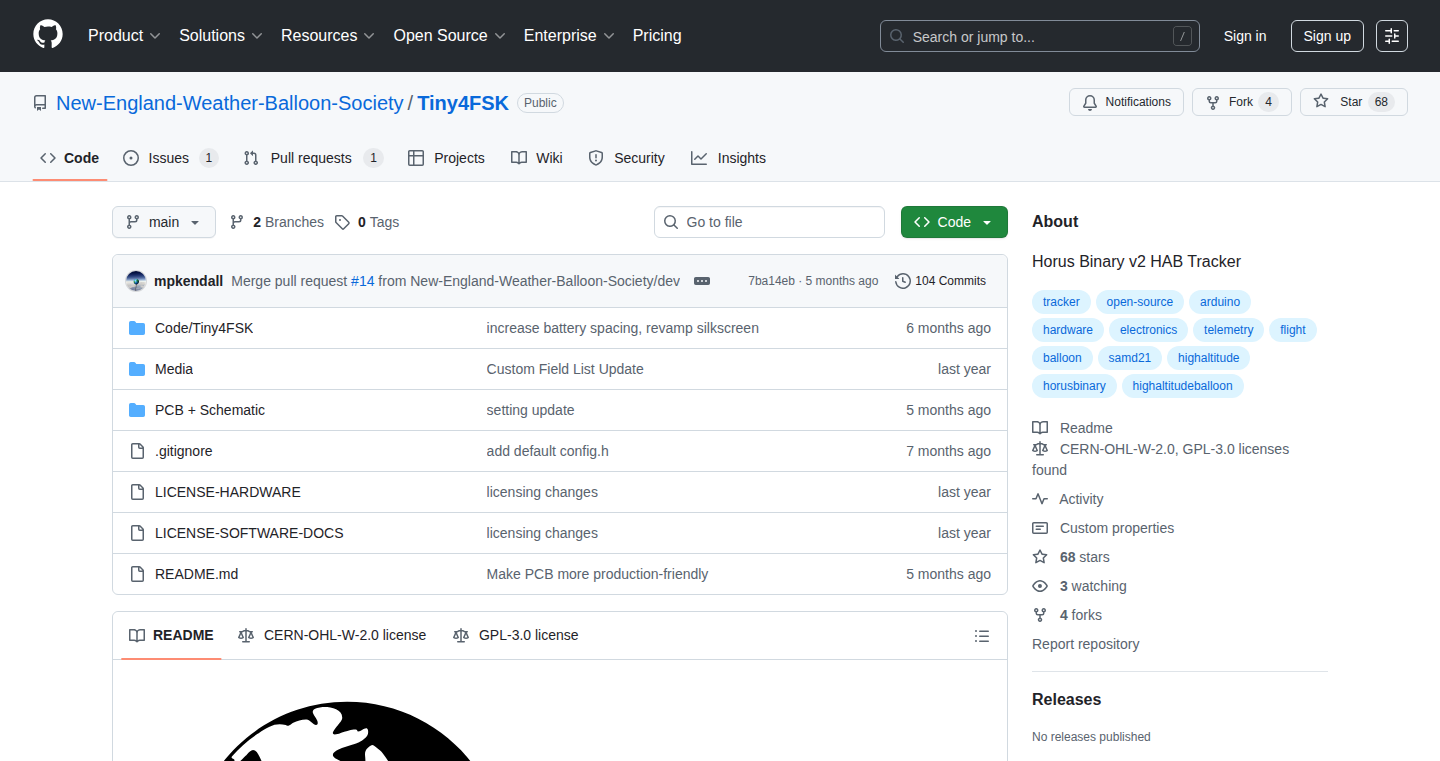
Author
mpkendall
Description
Tiny4FSK is a compact, low-power flight computer designed for tracking high-altitude balloons using the Horus Binary v2 protocol. It incorporates a SAMD21 microcontroller, a Si4063 radio module for the 70cm band, and a GPS module, allowing for real-time tracking and recovery of launched payloads. The project emphasizes efficiency, using a single AA battery for extended operation, and incorporates sensor integration for environmental data. It aims to provide a smaller and more efficient alternative to existing tracking systems, leveraging open-source technology and the Arduino framework for ease of use.
Popularity
Points 37
Comments 20
What is this product?
Tiny4FSK is a custom-built tracking system for high-altitude balloons. It uses a small computer to send its location (latitude, longitude, altitude) and environmental data (temperature, pressure, humidity) back to a ground station. The key is the Horus Binary v2 protocol, which is designed for reliable data transmission even from very high altitudes, and a very efficient design that allows it to run for a long time on very little power.
So what's innovative? It's a complete, compact solution optimized for the demanding environment of high-altitude ballooning. The design focuses on power efficiency (single AA battery), small size, and using a robust protocol optimized for weak signals, making it perfect for amateur radio enthusiasts and hobbyists. It is built around open-source software (Arduino) making it easy to customize.
How to use it?
Developers can use Tiny4FSK by assembling the hardware, loading the firmware, and attaching it to their high-altitude balloon payload. The device transmits its data over the 70cm amateur radio band, which can then be received by ground stations. Data can be viewed on the Sondehub Amateur website, which collects the information from a worldwide network of receiving stations. It can also be used as a base for custom projects and allows developers to create their own tracking and data collection solutions. The system uses the Arduino framework, making it easy to modify and adapt for custom needs.
So, if you're a hobbyist experimenting with high-altitude balloons, this provides a quick way to build your own tracking system, and if you are a developer, this is a great starting point for building out even more complex sensors and data logging solutions.
Product Core Function
· Real-time GPS Tracking: The system uses a GPS module to determine the balloon's position (latitude, longitude, and altitude). This is the foundation for finding the balloon after landing. So this is useful for quickly determining the location of your balloon.
· Horus Binary v2 Protocol: This advanced communication protocol is designed for reliable data transmission over long distances. It's specifically designed for use with high altitude balloons and provides error correction, critical for receiving data in challenging conditions. So this improves your ability to get the data back to you.
· Low-Power Consumption: The system is designed to run on a single AA battery for extended periods (up to 17 hours). This is crucial for long duration flights. So this means you can launch the tracker and be confident it will last through the entire flight.
· Environmental Data Logging: Integrated sensors measure temperature, pressure, and humidity. This provides valuable scientific data during the balloon's flight. So this allows you to collect more information about the environment.
· Open-Source and Customizable: The project uses the Arduino framework, making it easy for developers to modify and extend the functionality. So you can adapt the system to your specific requirements and customize the tracking system.
Product Usage Case
· Amateur Radio Ballooning: Hobbyists can use Tiny4FSK to track their high-altitude balloons, recover payloads, and collect scientific data. This enhances the experience of high-altitude ballooning.
· Educational Projects: Students and educators can use the system to learn about radio communication, GPS, and embedded systems. This makes learning about these technologies practical and exciting.
· Custom Sensor Integration: Developers can extend the system by adding additional sensors and functionality, such as cameras or other data collection devices. So this allows for highly customized experiments and data gathering.
4
MoebiusXBIN: Text-Mode Art Weaver
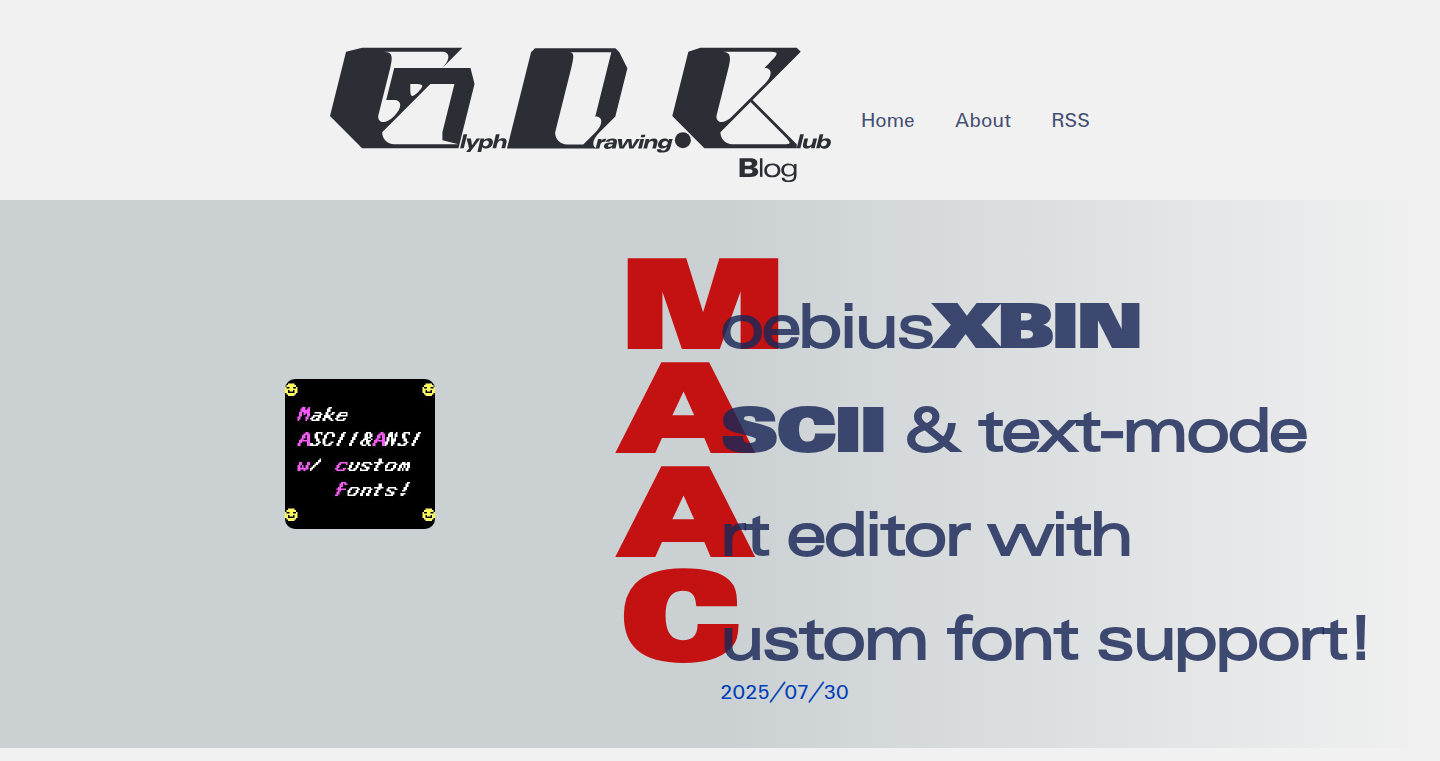
url
Author
california-og
Description
MoebiusXBIN is an ASCII and text-mode art editor that lets you create pixel art using text characters. It's like having a digital canvas made of letters, numbers, and symbols. The cool part? It supports custom fonts, giving you endless possibilities for your creations. It tackles the problem of creating detailed images with simple text, allowing for a unique artistic expression within the constraints of text-based environments.
Popularity
Points 49
Comments 6
What is this product?
MoebiusXBIN is a program that lets you draw pictures using text characters. Instead of using pixels like regular image editors, it uses things like 'A', 'B', '#', and '%'. The innovation lies in its support for custom fonts. This means you can design your own special characters to use in your art. It's like having a whole new set of tools to play with, offering a fresh approach to image creation within the limitations of text.
How to use it?
Developers can use MoebiusXBIN to create text-based art for various purposes. You can integrate the output of MoebiusXBIN into applications, websites, or even command-line interfaces. Think of it as a way to add visual flair to otherwise plain text. You can use it to generate logos, illustrations, or even simple animations that can be rendered directly in a terminal or a webpage. So, you could design a unique logo for your terminal-based tool, or create interesting visual elements for a text-based game.
Product Core Function
· Text-based art editing: This allows users to create images using characters. It's valuable because it provides a way to generate visuals in environments where traditional images are not supported or are inefficient. Think about creating a logo for your terminal application. So, you can quickly and easily generate visual elements for environments where traditional image formats aren't ideal.
· Custom font support: This is a game-changer. It lets you define your own characters. This adds another layer of customization and control. It's great for creating art that stands out. So, you can design a unique set of symbols to represent your brand or create complex visual elements that wouldn't be possible with standard characters.
· ASCII and text-mode output: The editor creates output that is easily rendered in any terminal or text-based environment. This broadens the scope of where you can use the artwork. It makes it easier to share and integrate your creations. So, you can create art that works seamlessly across different platforms and devices, no matter the operating system.
· Interactive editing interface: It provides an interactive environment for creating and modifying text-based art. This makes the creation process more intuitive and user-friendly. So, you can rapidly prototype ideas and experiment with different designs, accelerating your creative workflow.
Product Usage Case
· Terminal application logos: Developers can use MoebiusXBIN to create unique logos for their command-line tools. These logos can be displayed in the terminal's startup message or as part of the application's help menu. This adds a professional touch to the command-line interfaces. So, if you have a terminal tool, you can give it a recognizable visual identity.
· Text-based game graphics: The editor can be used to create simple graphics for text-based games. This includes character sprites, environmental elements, and title screens. This is extremely useful for creating visuals in text-based environments. So, if you are building a text-based game, you can use it to design the game's characters and environment.
· Website banners and illustrations: The output of MoebiusXBIN can be used to create simple banners or illustrations for websites. This is especially useful for websites that have a retro or minimalist aesthetic. This is a simple way to integrate graphical elements within existing web pages. So, you can create cool, retro-looking graphics for your website or blog.
· ASCII art in email signatures: You can design a unique ASCII art signature for your emails. This is a creative way to showcase your personality and add a touch of flair to your communications. So, you can impress your colleagues or clients with a cool ASCII signature.
5
Temporal Agent Orchestration with OpenAI Agents SDK
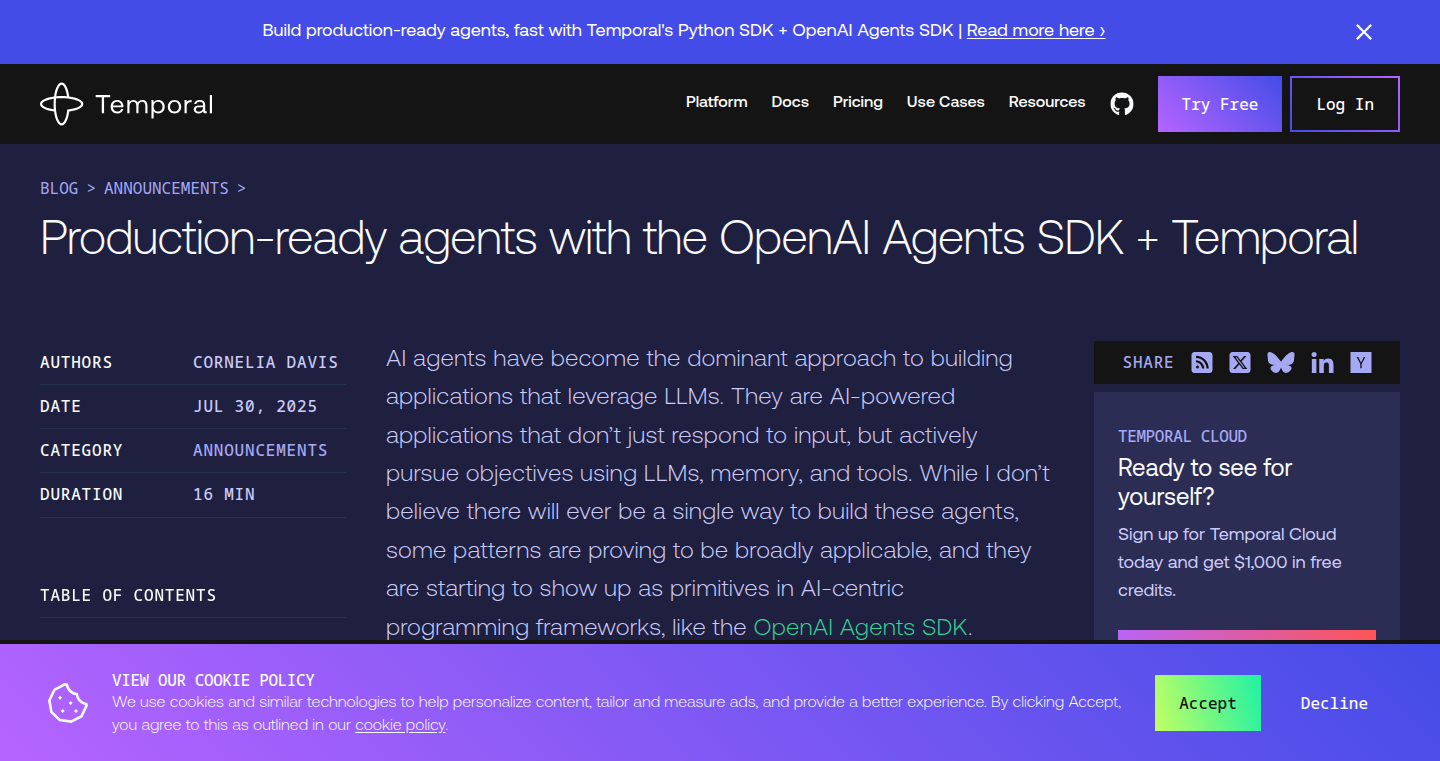
Author
mmegger
Description
This project showcases a production-ready system for building and managing AI agents, leveraging the OpenAI Agents SDK and Temporal for robust task orchestration. It addresses the challenge of reliably running and scaling complex workflows involving AI models. It demonstrates how to create AI-powered applications that can handle long-running tasks, error handling, and distributed processing in a resilient manner.
Popularity
Points 28
Comments 0
What is this product?
This project builds a system to manage AI agents, using the OpenAI Agents SDK (which is like a toolkit for creating AI helpers) and Temporal (a system designed to keep things running smoothly, even when things go wrong). The innovation lies in how it combines these technologies to ensure AI agents can perform complex tasks reliably and at scale. Think of it as a control center for AI assistants, ensuring they can complete tasks, handle errors gracefully, and work together effectively. So, what does it mean for you? It means you can build smarter applications that leverage AI agents without worrying about them crashing or failing to complete their jobs.
How to use it?
Developers can integrate this system to orchestrate AI agents for various tasks, such as data processing, automation, and content generation. To use this, you'd essentially define what your AI agents should do, and Temporal, through this integration, will handle the heavy lifting of running these agents, monitoring their progress, and restarting them if any issues arise. For example, you could use it to build a system where AI agents automatically analyze customer feedback, generate reports, or even respond to customer inquiries. So, how to integrate? You'd need to write code to define the tasks for your AI agents and set up the workflow in Temporal, which can be easily done with their SDKs.
Product Core Function
· Robust Task Orchestration: It provides a reliable framework for managing long-running AI tasks, which is crucial for complex AI applications. So this allows you to build AI systems that can handle tasks that take hours or even days to complete, without having to worry about unexpected interruptions.
· Error Handling and Resilience: This project includes built-in mechanisms for handling errors and automatically retrying failed tasks. So this means that your AI agents can recover from unexpected issues, ensuring that the overall system remains stable and reliable.
· Scalability and Distribution: It is designed to handle large workloads by distributing tasks across multiple machines. So this allows your AI agents to process large amounts of data and handle many concurrent requests efficiently.
· Workflow Management: It simplifies the process of creating and managing complex workflows, making it easier to chain together multiple AI agents and tasks. So you can build complex automation systems that manage many AI agents doing different types of work.
Product Usage Case
· Automated Data Analysis: Imagine using AI agents to automatically analyze large datasets and generate insightful reports. With this system, you could define a workflow that handles data extraction, processing, and report generation, with error handling in place to ensure no data is lost.
· Customer Service Automation: You could build an AI-powered customer service system where agents can automatically respond to customer inquiries, escalate complex issues, and provide personalized recommendations. The Temporal component ensures that all conversations are tracked, and problems are resolved.
· Content Generation Pipelines: Leverage AI agents to automatically create blog posts, social media content, and other marketing materials. The system would orchestrate agents to handle different content creation steps, like generating outlines, writing drafts, and editing content, while ensuring tasks are completed even if some parts fail.
6
Temporal Agents: Making OpenAI Agents Bulletproof
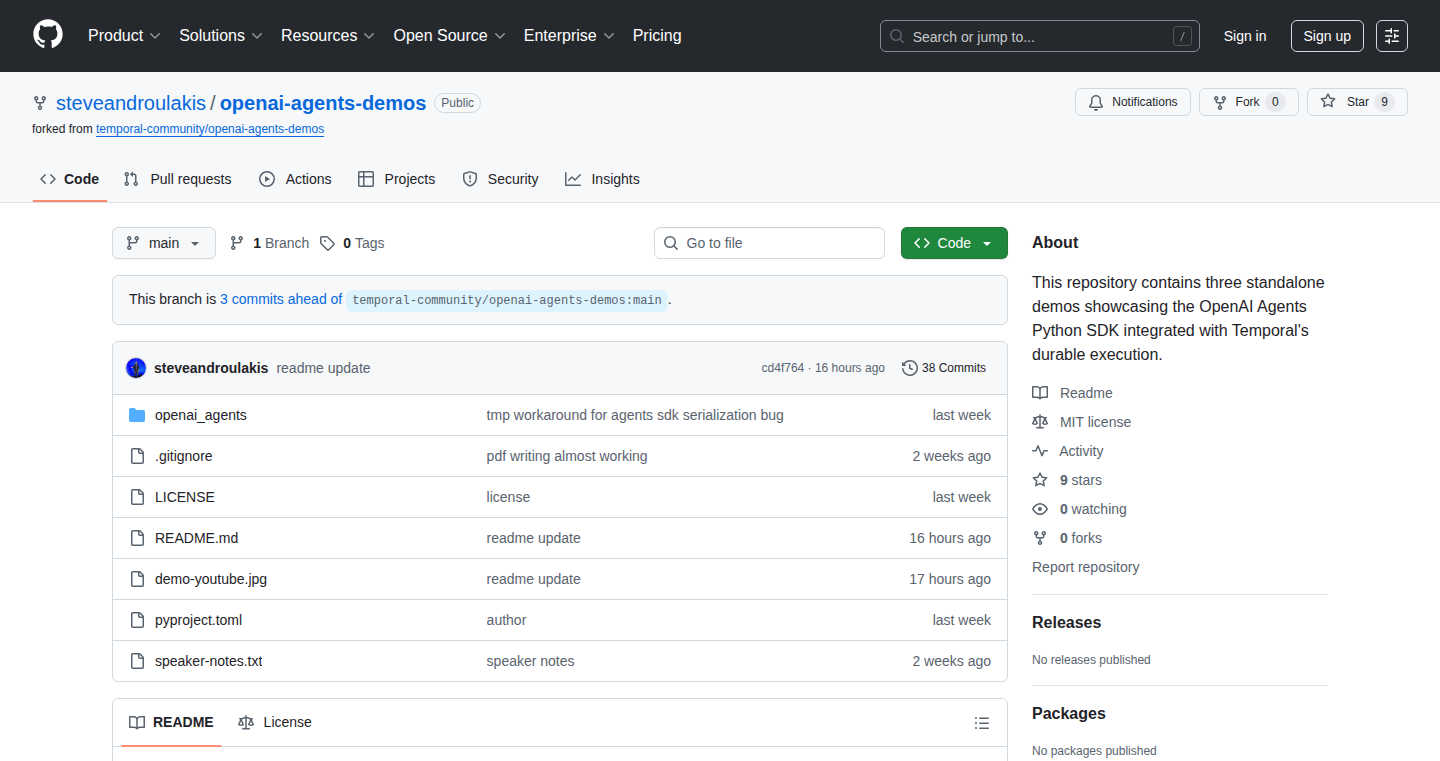
Author
stevea-temporal
Description
This project integrates OpenAI's Agents SDK with Temporal, an open-source platform. It allows you to build AI agents that are incredibly reliable and can handle massive workloads. Imagine your AI agent can survive crashes, scale to millions of tasks at once, and easily interact with humans. This is achieved by adding a few simple Python code decorations. The core innovation is ensuring that the agent's execution is resilient, even in the face of failures, and can handle a large number of concurrent operations. So this means your AI agents will be super stable and can handle anything you throw at them.
Popularity
Points 13
Comments 1
What is this product?
This project takes OpenAI's AI agent technology and makes it robust and scalable using Temporal. Temporal is like a 'super-powered' task manager that makes sure your tasks (like your AI agent's operations) always get done, even if there are problems like crashes. The innovation lies in the ability to take the existing OpenAI Agents SDK code and make it fault-tolerant and capable of handling huge amounts of work by plugging it into Temporal. This combines the power of AI agents with the reliability and scalability of Temporal. So this means your AI agents are always online and working hard!
How to use it?
Developers can integrate this by adding a few Python decorations to their existing OpenAI agent code. They then run Temporal workers. This means you can take your existing AI agent and make it significantly more reliable and able to handle much more work without major code changes. For example, you can use it to create a long-running AI-powered trading bot, that won't lose its state if the server restarts. Or you can use it to create a complex automated process that can handle thousands of requests at once. So this means you can make your AI agents more powerful and reliable, with less effort.
Product Core Function
· Durable Execution: The core function is making sure your AI agent's operations persist even if there are failures, such as server crashes or network issues. If the agent crashes mid-operation, Temporal will ensure the task resumes from where it left off. This provides reliability that's crucial for any production application. So this is useful for making your AI agents reliable.
· Scalable Workflows: Temporal allows the agents to scale to handle millions of concurrent executions. This means you can run many AI agents in parallel without worrying about performance bottlenecks. This is especially valuable for businesses that require AI for handling massive workloads. So this is useful for making your AI agents scalable.
· Human-in-the-Loop Integration: Easy integration of human interactivity allows for easy intervention and feedback. This enables developers to build agents that can seamlessly involve humans to make decisions or handle exceptions. So this is useful for enabling your AI agents to collaborate with humans.
· Simplified Development: Requires minimal code changes. By adding a few decorations to your OpenAI agent code, developers can get the benefits of reliability and scalability without a complete rewrite. So this is useful for making your AI agents easy to develop.
Product Usage Case
· Automated Trading Bot: In a financial application, you could have an AI agent that makes trades. By using Temporal, you ensure that if the bot crashes during a trade, the trade will still complete correctly when the bot restarts, avoiding financial losses. So this means the bot will be reliable for critical operations.
· Complex Workflow Automation: In an e-commerce system, an agent could orchestrate order fulfillment, from receiving an order to shipping. Temporal can ensure the order process is completed even if there are system failures. This is useful for making sure orders get fulfilled.
· Customer Service Chatbots: Using Temporal, a chatbot can handle multiple customer inquiries simultaneously and remember the state of each conversation, even if the server restarts. So this means the customers will have a good experience no matter what.
· AI-Driven Content Creation: An AI agent could manage the content creation pipeline. Temporal would ensure that content creation continues even if there are unexpected issues, ensuring a constant stream of content. So this is useful for automating content creation tasks.
7
Keyboard: Secure AI Automation with GitHub Codespaces
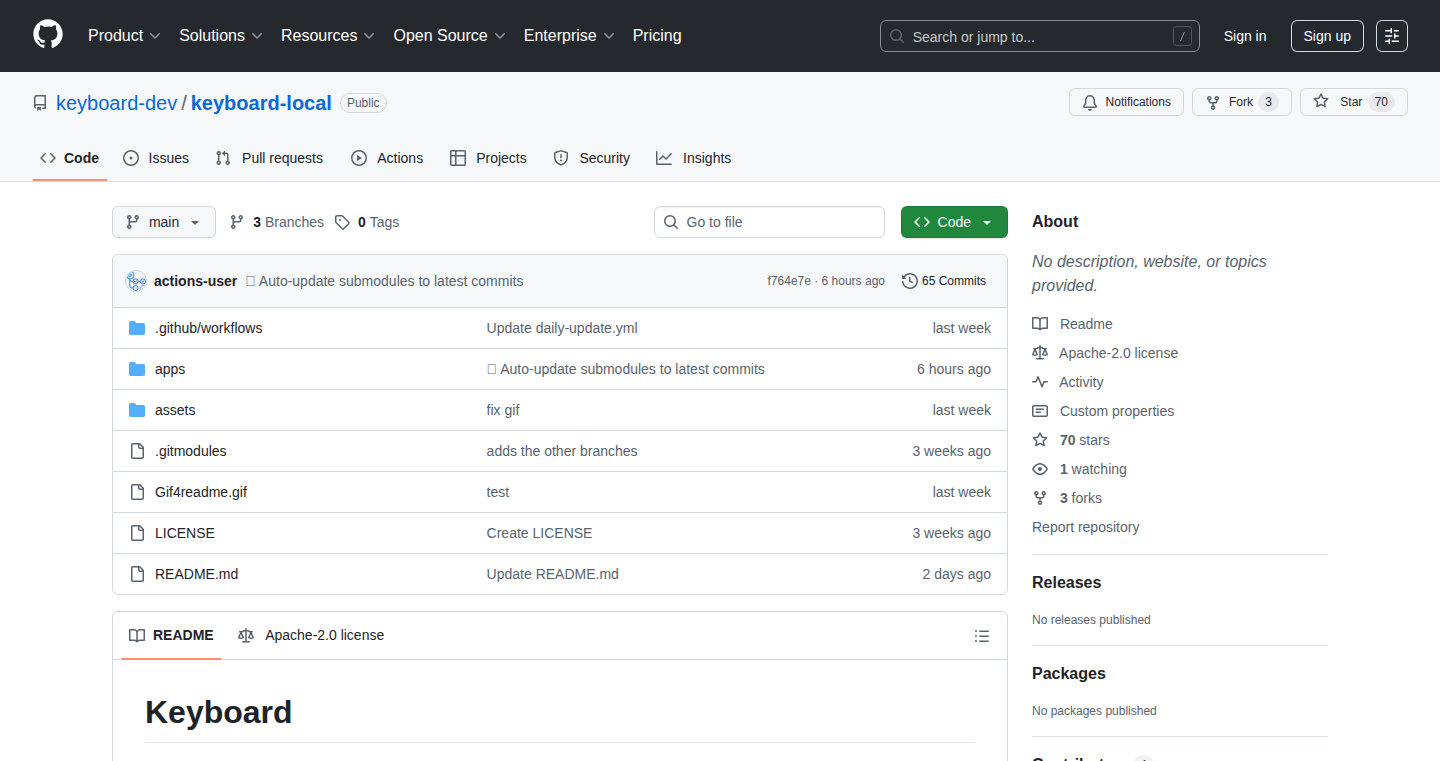
Author
linktothenew
Description
Keyboard is a tool that allows you to securely automate tasks across various applications using AI. It leverages GitHub Codespaces to isolate your API keys and execute AI-driven scripts, ensuring a high level of security and privacy. The core innovation lies in its approach to managing and protecting sensitive credentials within ephemeral environments, offering a zero-trust architecture that minimizes the risk of data breaches. It allows AI to interact with your apps in a safe and controlled manner.
Popularity
Points 5
Comments 7
What is this product?
Keyboard is a bridge between AI and your apps, letting you automate tasks using AI models like Claude. It works by running AI-generated code within GitHub Codespaces, which are isolated, temporary development environments. The key idea is to keep your API keys and sensitive information safe. Instead of storing them directly, Keyboard uses your GitHub Codespace secrets and encrypted files on your computer. This means your credentials stay under your control. Because Codespaces are created and destroyed as needed, this limits potential damage if something goes wrong. Keyboard offers built-in access controls using GitHub's security model, which is designed for big companies. This whole setup follows a 'zero-trust' approach, meaning only you can access your API keys and run the code. This is different from other tools because it executes real code, allowing Claude to use JavaScript/Node.js and install packages to work with your apps. You can save complex scripts as 'Keyboard Shortcuts' for easy reuse, and it works with apps like Linear, Slack, and Google Workspace. Codespaces are automatically set up and managed by Keyboard.
How to use it?
Developers can use Keyboard by first setting up a GitHub Codespace. Then, they would install Keyboard within that Codespace and configure access to the desired applications. Finally, they can create 'Keyboard Shortcuts', which are reusable scripts that leverage AI to automate specific tasks. These shortcuts can be triggered manually or integrated into existing workflows. So, if you have some repetitive tasks, you can write a script for Claude to solve, and save it as a Keyboard shortcut to re-use it.
For instance, you could use Keyboard to automate the creation of new tasks in Linear from Slack messages. Or, you can use Keyboard for web scraping and data analysis.
Product Core Function
· Secure Credential Management: Keyboard stores API keys and sensitive tokens in GitHub Codespace secrets and encrypted files, which protects your credentials. This reduces the risk of unauthorized access. So you don't have to worry about your API keys being exposed.
· Ephemeral Environments: The use of GitHub Codespaces creates temporary, isolated environments for code execution. This limits the potential damage if there's a security issue. If you are testing new things, a Codespace helps avoid messes on your main systems.
· Zero-Trust Architecture: Only you can access your API keys and the execution environment, increasing security. This gives you peace of mind, knowing you have complete control over your credentials and workflows.
· Real Code Execution: Keyboard allows the AI model (e.g., Claude) to run JavaScript and Node.js code, enabling complex tasks. This means the AI can actually perform actions, not just provide text outputs.
· Reusable Workflows: Complex scripts can be saved as 'Keyboard Shortcuts' for instant reuse. This increases efficiency by making tasks easily repeatable.
· Universal Integration: Keyboard supports multiple applications, including Linear, Slack, Google Workspace, and GitHub. This makes it adaptable to many different workflows.
· Automated Environment Management: GitHub Codespaces are created and managed automatically as needed, which simplifies the setup and maintenance process.
Product Usage Case
· Automated Task Creation in Project Management: Using Keyboard, a developer could create a shortcut to automatically generate tasks in Linear (a project management tool) based on messages received in Slack. This integrates AI to interpret the message content and create the tasks. This saves time and reduces manual effort.
· Automated Data Scraping and Reporting: A developer could write a script in a Keyboard Shortcut to scrape data from a website, process it using AI, and generate a report. The report could be sent to a specific Slack channel. This automation reduces the manual work involved in gathering and reporting on data.
· Automated Code Review Suggestions: Developers could create a script where AI assists in code reviews by suggesting changes or identifying potential issues. The AI would analyze the code within the Codespace and provide automated feedback. This will improve code quality and developer productivity.
· Customer Support Automation: Keyboard can be used to automate customer support tasks. For example, create a Keyboard shortcut that allows AI to read customer inquiries, search a knowledge base, and provide pre-written responses, all within a Codespace environment. This can enhance customer service efficiency by reducing the need for human intervention on simple tasks.
8
AI-Powered Word Search Game Generator
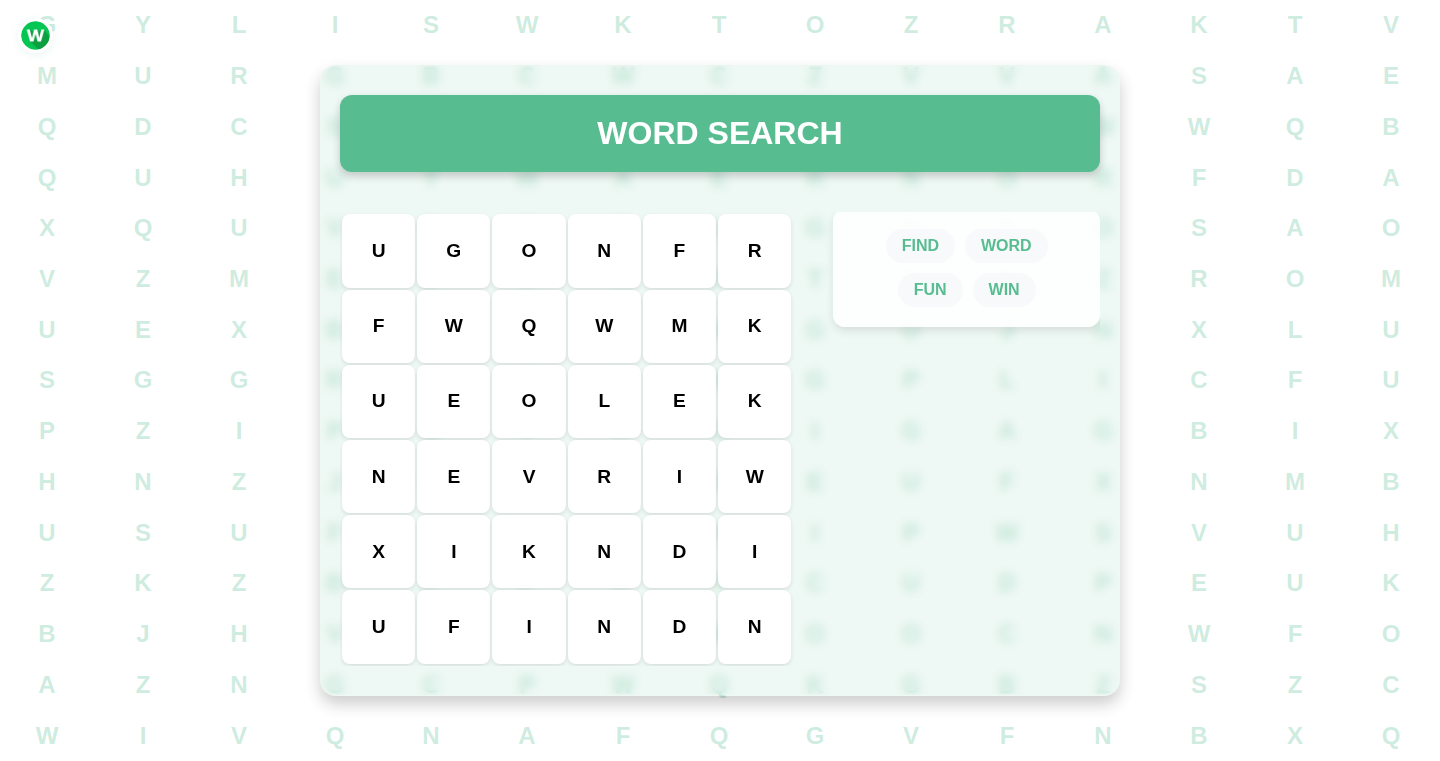
Author
rg12345
Description
This project is a word search game created with the assistance of an AI assistant (like ChatGPT). The developer, without being a game developer, leveraged AI to generate game grids, verify word directions, and ensure the game is mobile-friendly. It's built using HTML, CSS, JavaScript, and Flask, showcasing a simple and clean user interface without advertisements. The core innovation lies in using AI to rapidly prototype and develop a functional game from scratch, demonstrating the potential of AI in simplifying and accelerating software development, even for non-experts.
Popularity
Points 3
Comments 9
What is this product?
This is a word search game. The interesting part is how it was made. The developer used AI (like ChatGPT) to handle the tricky parts of game development – generating the puzzle grid, figuring out where the words can go, and making the game work well on phones. This shows that even if you're not a game development expert, you can still build a game with the help of AI. So, it's essentially an example of how AI can democratize software creation, making it accessible to a wider audience. This demonstrates AI's ability to automate many repetitive tasks in development.
How to use it?
You can't directly use the project as a library (it's a game!), but it shows how AI can be used in similar scenarios. For developers, you could learn from this project how to integrate AI into your development workflow. You can feed your project requirements to an AI, it can assist you to generate the structure of your code, assist with debugging. Developers can use the technologies used here, such as HTML, CSS, JavaScript, and Flask, to create their own simple applications or games or integrate AI assistance to simplify their project.
Product Core Function
· AI-Assisted Grid Generation: The AI helps create the word search puzzle grids, placing words in various directions (horizontally, vertically, diagonally) and filling the rest with random letters. Value: Reduces the manual effort needed to design the game's core component. Application: Accelerates game development cycles and allows for easier creation of diverse puzzle layouts.
· Direction Checking: The AI helps check if words can be placed in certain directions without overlapping or going out of bounds. Value: Ensures the puzzle logic is correct, so words are findable and the game is playable. Application: Critical in any puzzle game to ensure gameplay integrity and prevent frustration.
· Mobile-Friendly Design: The developer explicitly designed the game to work on mobile devices. Value: Expands the audience by making the game accessible on smartphones and tablets. Application: Crucial for reaching a wider user base, ensuring playability across various devices.
· Frontend Development with HTML, CSS, and JavaScript: The game uses HTML, CSS, and JavaScript for the user interface and game logic. Value: Standard web technologies for interactive and responsive game design. Application: Allows for a visually appealing and interactive user experience within a web browser.
Product Usage Case
· Rapid Prototyping for Game Developers: A game developer could use AI to quickly prototype different game mechanics or puzzle layouts. For instance, they could provide the AI with game rules, and it would generate a working prototype to test. It can reduce the time spent on creating preliminary game design.
· Automated UI/UX Design: Frontend developers could leverage AI to generate UI elements like buttons, menus, and interactive components, automating the creation of user-friendly interfaces. This accelerates UI/UX prototyping and iteration process.
· Educational Projects: Educators could use AI to create interactive learning games and exercises, customizing content for different skill levels or subjects. It offers a way to automate the creation of educational game.
· Simple Web Applications: Web developers can use AI to generate the basic structure and functionality of simple web applications, like forms or data visualizations. For example, you can generate the html and css code to display different data.
9
Webcode.sh: Claude Code in Your Browser

Author
wordbricks
Description
Webcode.sh brings the power of Claude, a powerful AI, directly into your web browser, allowing you to code and experiment with it on the go, even on your phone or tablet. It's like having a coding assistant in your pocket. The key innovation is the zero-configuration, instant REPL (Read-Eval-Print Loop), powered by WebAssembly (WASM), which provides a fast and responsive coding environment without needing to install anything. It solves the problem of needing a powerful AI coding companion accessible anytime, anywhere, eliminating the need for a local development environment when you're on the move.
Popularity
Points 9
Comments 2
What is this product?
Webcode.sh is a web-based terminal that allows you to interact with Claude's coding capabilities directly within your browser. This means you can write and execute code using Claude, a cutting-edge AI, from any device with a web browser. It uses WASM technology to deliver fast performance, similar to how modern web applications offer near-native speeds. The REPL is instant, meaning you can start coding immediately without lengthy setup processes. So, what's this for? It is for convenient access to a coding tool, especially in situations where you don't have access to a local coding environment.
How to use it?
Developers can access Webcode.sh by simply visiting the website in their browser. You can then use the terminal to input code, ask Claude for assistance, and receive immediate results. This could be helpful for quick coding tasks, debugging, prototyping, or learning and experimenting with code snippets when you are away from your primary development environment. This can be useful for brainstorming, quick code reviews, or working on small coding assignments during travel. This is useful because you can use it on your phone and tablet.
Product Core Function
· Zero-config, instant REPL: Allows immediate coding and experimentation without any setup. So what? This drastically reduces friction and saves time.
· Mobile and tablet compatibility (Chrome, Safari): Enables coding from any device. So what? This provides unparalleled flexibility in accessing coding resources.
· WASM-powered performance: Ensures a fast and responsive coding experience. So what? This makes the web-based terminal feel snappy and efficient.
Product Usage Case
· A developer is on a train and needs to quickly test a Python script they've been working on. They can use Webcode.sh on their phone to execute the code and check the output. So what? Allows for quick code checks and quick problem-solving.
· A student is learning a new programming language and wants to experiment with different code examples. They can use Webcode.sh on their tablet to quickly try different code snippets and receive immediate feedback from Claude. So what? Helps with quick learning and experimentation.
· A developer is away from their computer and needs to quickly debug a small piece of code. They can use Webcode.sh on their phone to fix the bug without having to wait until they return to their desk. So what? Allows for urgent issues to be solved immediately.
10
Sourcebot: Code Oracle - Ask Your Code Anything
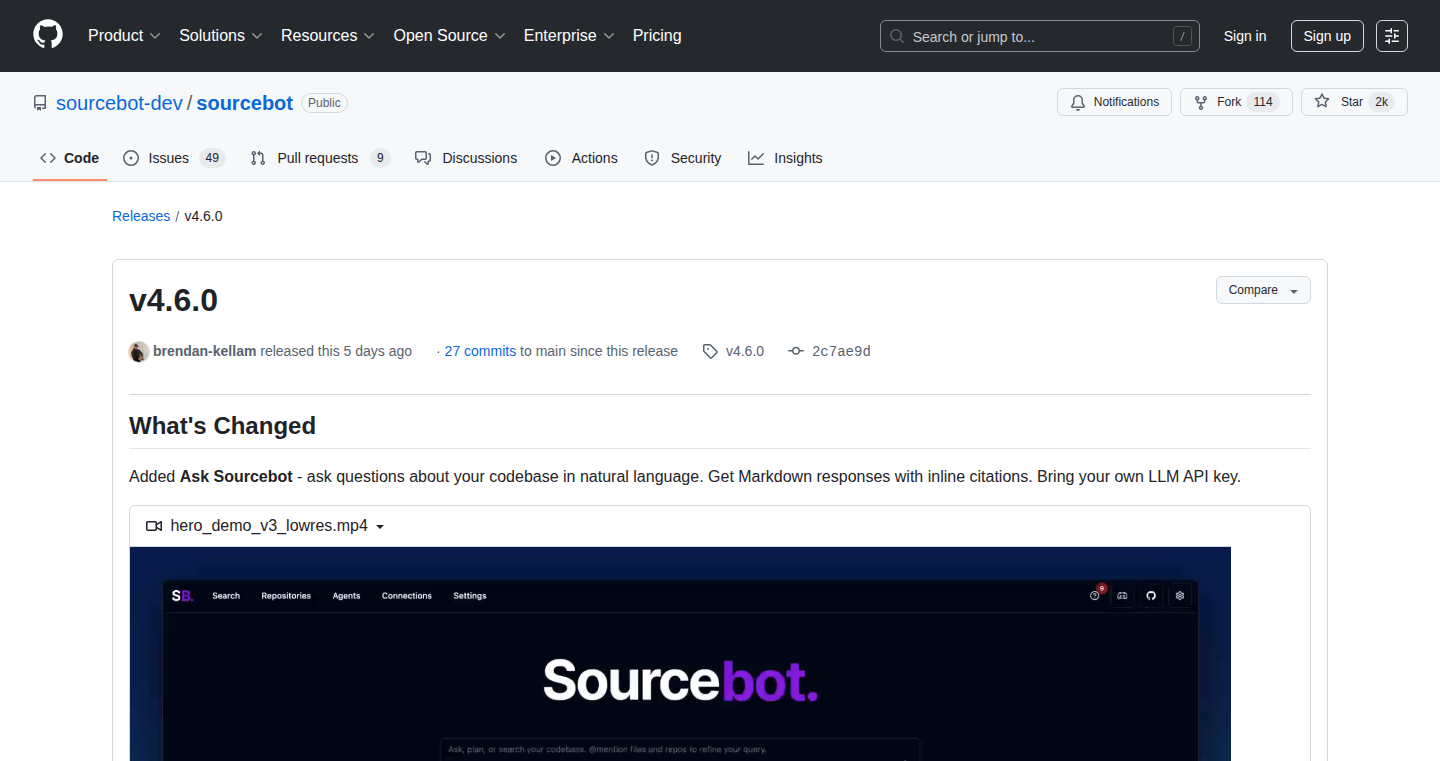
Author
bshzzle
Description
Sourcebot is a self-hosted tool that helps you understand large codebases by allowing you to ask complex questions in plain English. It uses a clever combination of search, code navigation, and large language models (LLMs) to provide structured answers with citations directly from your code. It's like having a smart assistant that knows everything about your project. The key innovation is using LLMs as a tool to interact with the code directly, answering questions in natural language and providing in-line citations. So, it helps you understand the code easier and faster.
Popularity
Points 10
Comments 1
What is this product?
Sourcebot is like a smart search engine specifically for your code. Instead of just searching for keywords, you can ask questions about how the code works, what specific libraries are used, or how different parts of the system interact. It works by combining existing technologies like search and code navigation with a large language model. The language model acts like a translator, taking your questions, using the tools to get the right information from the code, and then giving you a clear, structured answer. The answers also include direct references to the code (inline citations), so you can easily see where the information comes from. So, it helps you understand your codebase without having to spend hours manually reading and figuring things out.
How to use it?
You can use Sourcebot by setting it up on your own server (self-hosted). Once it's running, you can access it through a web interface. You simply type your questions in plain English, like "How does authentication work?" or "Where is the user profile information stored?" Sourcebot then analyzes your code, finds the relevant information, and presents it to you in an easy-to-understand format. You can integrate Sourcebot with code repositories like GitHub, GitLab, and Bitbucket. This allows you to search and understand code without having to download it locally. So, you can quickly explore new codebases, debug complex issues, and improve your overall understanding of the project.
Product Core Function
· Natural Language Question Answering: Allows developers to ask questions about the code in plain English, reducing the need for complex search queries. The value is that it simplifies code understanding by letting users query code in a natural way, rather than requiring them to learn the syntax of a new query language. Application scenario: When a developer wants to quickly understand how a specific feature is implemented without spending hours manually searching through files.
· Inline Code Citations: The tool provides answers with direct references to the code, making it easy to verify information and understand the context. The value is that it helps developers easily trace back the answers to the original code, building trust and facilitating a deeper understanding. Application scenario: While reviewing a pull request, a developer can quickly verify the claims made in the code explanation.
· Self-Hosted Solution: Sourcebot is designed to be self-hosted, giving developers complete control over their data and providing flexibility in setup. The value is that it ensures data privacy and security, and can be customized to the specific needs of a project. Application scenario: When working with sensitive code, where data security is a high priority.
· Support for Multiple Code Repositories: Integration with platforms like GitHub, GitLab, and Bitbucket makes it easy to understand code stored in those systems. The value is that it eliminates the need to download code locally, streamlining the understanding of code in various repositories, especially useful when working with microservices or open-source projects. Application scenario: When a developer needs to understand how different services in a microservices architecture interact.
Product Usage Case
· Debugging Complex Issues: A developer is trying to fix a bug related to user authentication. Instead of spending hours going through different files, they ask Sourcebot, "How does authentication work in this codebase?" The tool then provides a concise explanation, highlighting relevant code snippets, and showing the exact location of the relevant code within the files, saving the developer valuable time and effort in identifying the root cause of the bug. This is useful when debugging tricky authentication issues.
· Onboarding New Team Members: A new developer joins the team and needs to understand the project's architecture. They ask Sourcebot questions like, "How are database connections managed?" or "What is the purpose of this module?" Sourcebot provides clear explanations and code citations, allowing the new developer to quickly grasp the overall project structure. This is particularly helpful for new team members joining a project.
· Code Review and Collaboration: During a code review, a developer wants to understand the purpose of a specific code block. Instead of manually searching, they ask Sourcebot "What does this function do?" The tool provides a concise summary and links to the relevant code, allowing the reviewer to understand the code's purpose and functionality quickly. This is useful when reviewing code and collaborating with other developers.
· Understanding Third-Party Libraries: When integrating a new library into a project, developers can use Sourcebot to understand how it works within the existing codebase. They can ask questions like, "How is this specific library used?" or "What are the key functionalities?" The tool will locate and explain the use cases. This is useful when working with an unfamiliar third-party library.
11
AutoMQ 1.5.0: Kafka with Native Iceberg Support
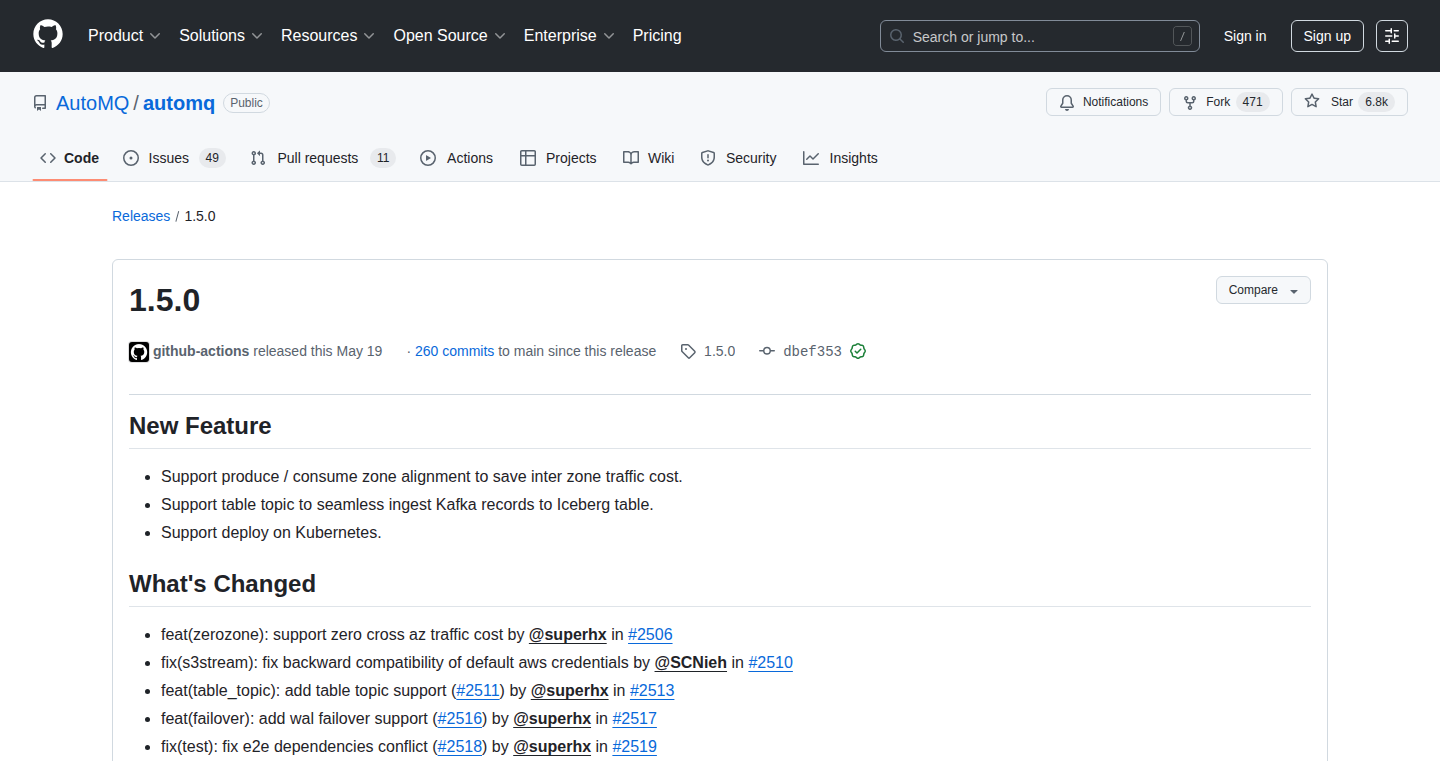
Author
NewByteHacker
Description
AutoMQ 1.5.0 revolutionizes how we handle streaming data by integrating native Iceberg support into Kafka. It automatically stores Kafka data in the Iceberg table format within S3 (a cloud storage service). This means you don't need to manually build and maintain complex data processing pipelines (like those using Flink or Spark) to transform your streaming data into a usable table format. The core innovation is simplifying data transformation and making it easier to analyze streaming data directly from your data lake. So this simplifies your data pipeline and reduces operational overhead.
Popularity
Points 9
Comments 1
What is this product?
AutoMQ combines Kafka (a popular message streaming platform) with Iceberg (a table format for data lakes) and S3 (cloud storage). The system seamlessly moves Kafka data to S3 and structures it using Iceberg. This integration eliminates the need for separate tools like Flink or Spark to prepare the data for analysis. Think of it as automatically creating a ready-to-analyze table from your real-time data stream. So this saves you time and resources by automating the data preparation process.
How to use it?
Developers can use AutoMQ by configuring their Kafka clusters to integrate with AutoMQ's features. Data is then automatically moved to S3 in Iceberg format. Users can then use tools like Apache Spark or Presto to query the data directly from S3 without the need for complex ETL (Extract, Transform, Load) processes. You can integrate AutoMQ into your existing Kafka setup with minimal changes, allowing you to leverage the power of data lakes for real-time analysis. So this streamlines your workflow and makes your data more accessible for analysis.
Product Core Function
· Native Iceberg Support: Automatically formats Kafka data into Iceberg tables stored in S3. This reduces the need for custom data pipelines for data preparation. So you get immediate access to your data in a usable table format, ready for analysis.
· Simplified Data Lake Integration: Directly integrates streaming data from Kafka into a data lake (like S3). This eliminates the need for building custom data pipelines with technologies like Flink or Spark. So this means less work to get your streaming data ready for analysis.
· Automated Data Transformation: Handles the transformation of streaming data into a table format. This removes the burden of manually converting data into the required format for analysis. So this automates the data preparation steps, saving you time and effort.
· Open-Source and Community Driven: Built on open-source principles, AutoMQ offers a flexible and extensible platform that allows developers to customize and improve the system. This fosters collaboration and innovation within the developer community. So you can customize it to fit your needs and benefit from community contributions.
Product Usage Case
· Real-time Analytics: Analyze real-time data streams directly from Kafka, such as clickstream data, sensor data, or financial transactions, without the need for complex ETL processes. So you can gain real-time insights from your data more quickly.
· Data Archiving and Historical Analysis: Store historical Kafka data in a cost-effective manner in S3, enabling long-term analysis and compliance. So you can keep all your data without needing to worry about storage limitations and easily query historic data.
· Streamlined Data Pipelines: Simplify the development and maintenance of data pipelines by eliminating the need for custom transformations. This reduces operational complexity. So you can focus on building data-driven applications without getting bogged down in data plumbing.
12
Artifact Ninja: Unleash Your AI-Generated Content
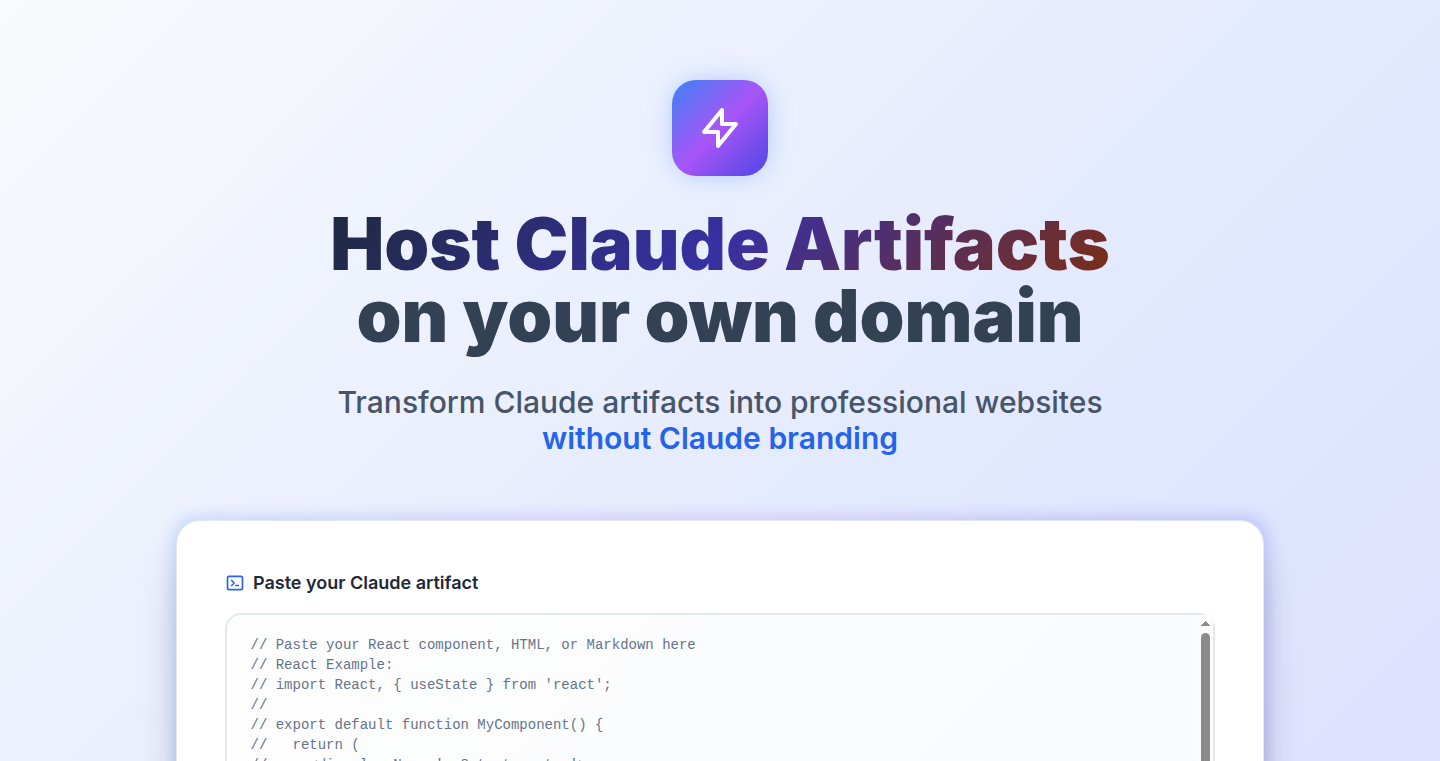
Author
ed
Description
Artifact Ninja is a nifty tool that lets you easily publish the landing pages you create with AI tools like Claude. It takes the content generated by the AI, strips away any AI branding, and creates a static webpage. You can then link this webpage to your own custom domain, making your AI-generated content look professional and integrated with your brand. It solves the problem of quickly transforming AI-generated artifacts into a live, shareable website without the need for complex coding or web hosting. This tool uses a simple cloud infrastructure (Cloudflare worker + D1) for efficient and cost-effective hosting.
Popularity
Points 5
Comments 4
What is this product?
Artifact Ninja acts like a bridge. It takes the output from an AI tool (like Claude) that creates landing pages, removes any traces of the AI, and turns it into a simple, ready-to-publish webpage. The innovative part is the automation and simplicity. It's designed to quickly and easily get AI-generated content online, without requiring extensive technical knowledge. It leverages cloud infrastructure for its speed and cost-effectiveness.
How to use it?
Developers can copy the output from Claude (or similar AI tools) and paste it into Artifact Ninja. The service then generates a static webpage that you can link to your own domain using a simple domain forwarding feature offered by most domain registrars. This is ideal for quickly prototyping, testing, or sharing AI-generated content without needing a full-fledged website.
Product Core Function
· Content Stripping and Transformation: Artifact Ninja takes the raw content from an AI tool and cleans it up, removing any branding or unnecessary elements, making it presentable and ready to publish. This saves developers time and effort in manually cleaning and formatting the output from AI models. So what? It gives you a clean slate to work with and prevents your site from looking like an AI's project, making it easier to blend with your branding.
· Static Webpage Generation: It transforms the cleaned content into a static webpage. Static pages load incredibly fast and are secure because they don't have to process anything on the server-side. What does it mean? It ensures that your content is easily accessible, user-friendly, and has excellent SEO. You don't need to know any code to have a fast site.
· Custom Domain Integration: Allows developers to link the generated static webpage to their own custom domain through simple domain forwarding. Why does it matter? You own your brand and create a professional appearance. This integrates AI-generated content seamlessly into your existing online presence.
· Cost-Effective Hosting: The tool is hosted using Cloudflare workers and D1, which are known for being cheap and efficient. Therefore? It allows you to host your content at minimal cost, making the tool accessible to anyone.
Product Usage Case
· Rapid Prototyping: A developer uses Claude to quickly generate a landing page for a new product. They paste the output into Artifact Ninja and, in minutes, have a live, shareable page to gather early feedback. The benefit? Get feedback fast without the overhead of building a whole website.
· Content Marketing: A marketer creates several different landing pages using AI, each promoting a different aspect of their product. Using Artifact Ninja, they can quickly publish each landing page, driving targeted traffic and conversions. So what? Easily test different marketing angles without the traditional web development process.
· Personal Portfolio: A developer wants to quickly showcase their AI-generated projects. They use Claude to create descriptions and then Artifact Ninja to publish the projects on their portfolio site. The benefit? Make your work visible quickly and effortlessly.
13
WebSocket DevTools: Real-time Traffic Control for WebSockets
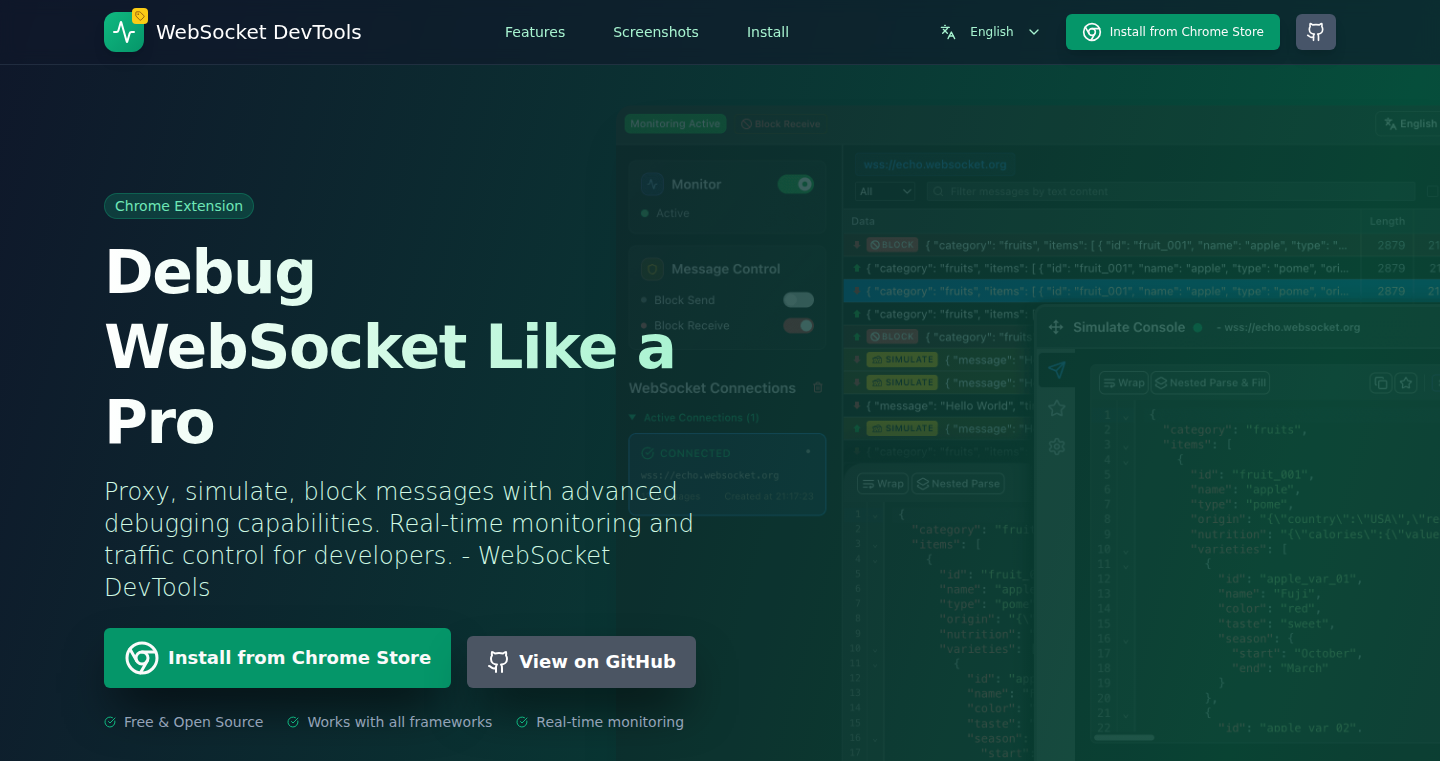
Author
lawChainHot
Description
This Chrome extension acts like a powerful debugger specifically designed for WebSockets. It allows developers to monitor, intercept, and manipulate WebSocket traffic in real-time, right within their Chrome DevTools. It solves the problem of limited WebSocket debugging capabilities in standard browser developer tools. This tool enables developers to debug, test, and reverse engineer WebSocket-based applications more effectively.
Popularity
Points 9
Comments 0
What is this product?
This extension works by injecting a script that intercepts the WebSocket constructor. This allows it to capture and monitor all WebSocket traffic. It provides a user interface built with React and Vite, seamlessly integrated into Chrome DevTools. You can view messages in real-time, simulate sending custom messages, and even block traffic to test different scenarios. So this means you can understand what is going on under the hood when your application uses WebSocket.
How to use it?
Developers install the Chrome extension and open their Chrome DevTools. When a WebSocket connection is established, the extension automatically starts capturing traffic. Users can then view, inspect, and manipulate the messages in real-time. It’s perfect for debugging WebSocket-based applications, simulating different server responses, and testing the robustness of applications under various network conditions. Just install the extension, open your DevTools, and start interacting with WebSocket connections.
Product Core Function
· Real-time WebSocket monitoring and message capture: It allows you to see exactly what data is being sent and received over WebSockets, providing deep insight into the communication of your application. So this provides visibility into your real-time data streams.
· Send custom messages in both directions (client ↔ server): This feature allows you to simulate different server responses or client actions, which is crucial for testing how your application handles various scenarios. So this helps you to test your application's behavior under different conditions.
· Block incoming/outgoing messages for testing: By blocking specific messages, you can simulate network issues or test error handling in your application. So this helps to test and debug error handling in your application.
· Background monitoring (captures connections even when DevTools is closed): The extension continues to capture WebSocket traffic even when the DevTools panel is closed. So you can capture data without constantly having to have the DevTools open.
Product Usage Case
· Debugging a chat application: A developer can use the tool to monitor the real-time exchange of messages between clients and server to identify the source of an issue. So this allows you to quickly identify and fix bugs in your chat application.
· Testing error scenarios: The tool allows you to simulate network failures or incorrect server responses by blocking or modifying WebSocket messages. So this helps you ensure your application gracefully handles errors.
· Reverse engineering APIs: By monitoring WebSocket traffic, a developer can understand the communication protocol used by a WebSocket API and identify data structures. So this allows you to understand how a WebSocket API works.
· QA testing real-time features: Testers can use the tool to verify that real-time features, such as live updates or notifications, are working correctly. So this helps you to guarantee the reliability of your real-time features.
14
LLM Failure Mode Navigator
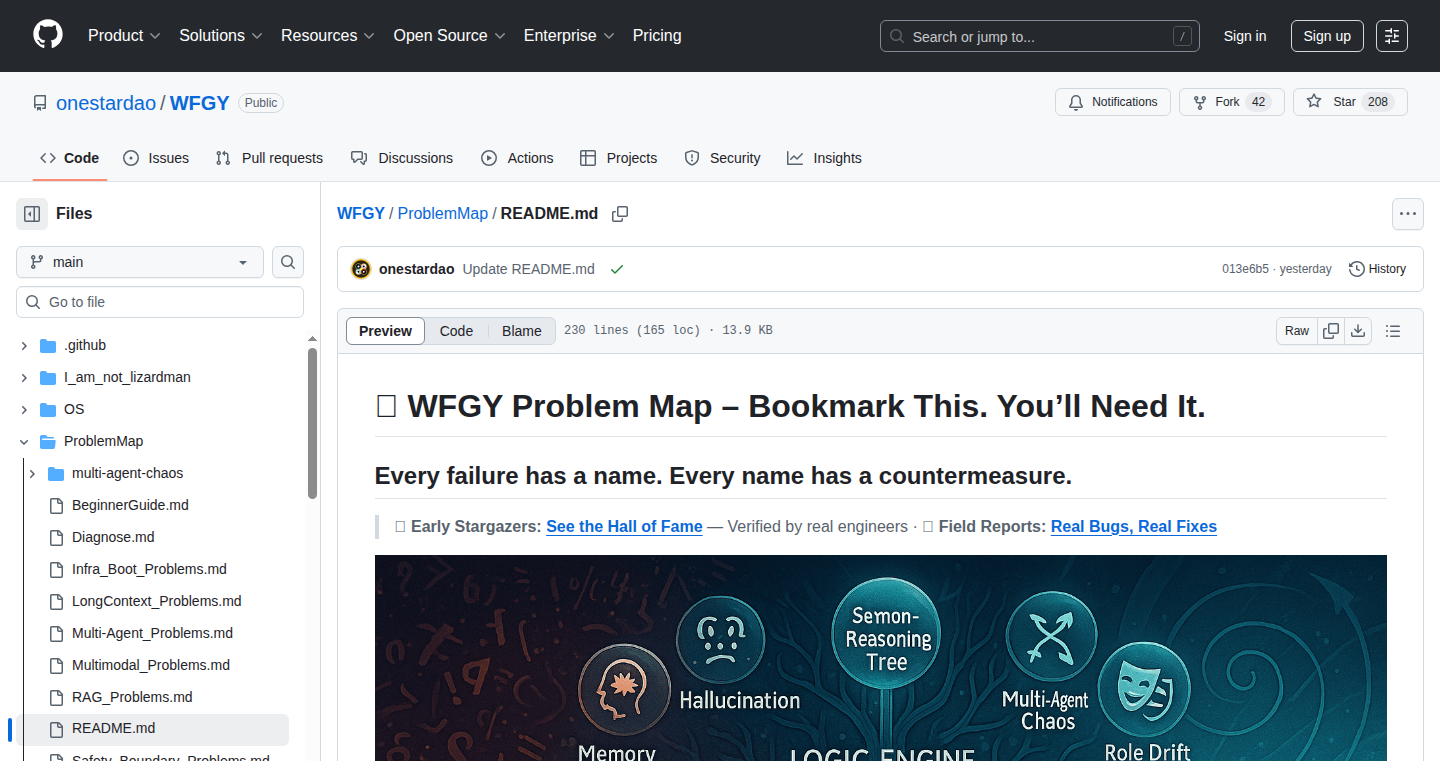
Author
TXTOS
Description
This project is a curated collection of common, subtle failure modes observed in production-grade AI systems, particularly those using Large Language Models (LLMs). It identifies and categorizes 16 distinct failure patterns, going beyond basic crashes to address issues that silently degrade performance like relevance and accuracy. This allows developers to understand and mitigate these issues, making their AI systems more robust. So what? This helps developers build better AI systems by providing a proactive checklist to prevent failures.
Popularity
Points 6
Comments 2
What is this product?
This project is essentially a detailed catalog of how LLMs can go wrong in real-world applications. It's not about the LLMs themselves, but about the infrastructure and systems built *around* them. The creator compiled this list from his own experience, pinpointing issues such as 'semantic drift' (where the meaning of data changes over time), 'embedding/meaning mismatches' (where the system misunderstands the data), and 'cross-session memory gaps' (where the system forgets information between uses). The innovation here is in creating a practical, real-world resource for developers to identify and avoid these pitfalls, providing a common vocabulary for discussing and addressing LLM-related problems. So what? This makes debugging and improving LLM-based systems faster and more effective, saving time and resources.
How to use it?
Developers can use this project as a reference guide when building and maintaining their LLM-based applications. It acts as a proactive checklist to identify potential failure points during development and testing. They can compare their system's design and implementation against the failure modes listed, looking for potential vulnerabilities. This can be integrated directly into the development workflow by creating automated tests or checks that specifically look for these failure patterns. So what? Developers can improve the reliability and efficiency of their AI systems, leading to better user experiences and reduced downtime.
Product Core Function
· Failure Mode Identification: The core function is to provide a categorized list of common failure modes. Each failure mode is accompanied by descriptions and examples of how it manifests in real-world AI systems. So what? Developers can quickly recognize potential issues and proactively address them.
· Root-Cause Analysis Acceleration: The project provides a shared vocabulary for discussing and analyzing problems. By naming and categorizing failures, it makes it easier for teams to quickly understand the root causes of issues, leading to faster resolution. So what? This accelerates the debugging process, leading to reduced downtime and improved efficiency.
· Proactive Debugging: It promotes the use of the list as a pre-deployment checklist. Developers can proactively check new features and systems against the list of failure modes to identify and fix potential problems before they impact users. So what? This reduces the number of bugs and failures that users experience, leading to increased user satisfaction.
· Community Feedback and Improvement: The project encourages community feedback to identify and refine the list of failure modes. This allows developers to contribute their experiences and learn from others. So what? The project is continuously improving with community input, creating a more comprehensive resource and building a strong user community.
Product Usage Case
· Preventing Semantic Drift: A development team using LLMs for a chatbot could use the list to identify the risk of semantic drift in their chatbot's responses over time, caused by changes in the data it's trained on. By considering this potential failure mode early in the development cycle, they can implement measures to regularly re-evaluate the chatbot's responses and prevent the meaning of its responses from gradually changing, maintaining consistent and accurate conversations. So what? This allows users to experience a consistent user experience that will maintain its quality over time.
· Mitigating Embedding/Meaning Mismatches: A company building a search engine powered by LLMs can use the project to anticipate the risk of embedding/meaning mismatches, which might cause the search engine to return irrelevant results. By incorporating checks for these mismatches during the training and deployment phases, they can maintain search relevance, ensuring the results meet user expectations. So what? This provides users with the best possible search result based on their requests.
· Avoiding Cross-Session Memory Gaps: A team developing a multi-step reasoning service using LLMs can use the project to address the challenge of 'cross-session memory gaps', where the system loses the context of the previous sessions. They can design their system to retain and reference previous user interactions to maintain consistency across multiple sessions, enabling the system to carry the user's context. So what? This allows for more natural and context-aware interactions.
15
NativeMind: On-Device AI Assistant
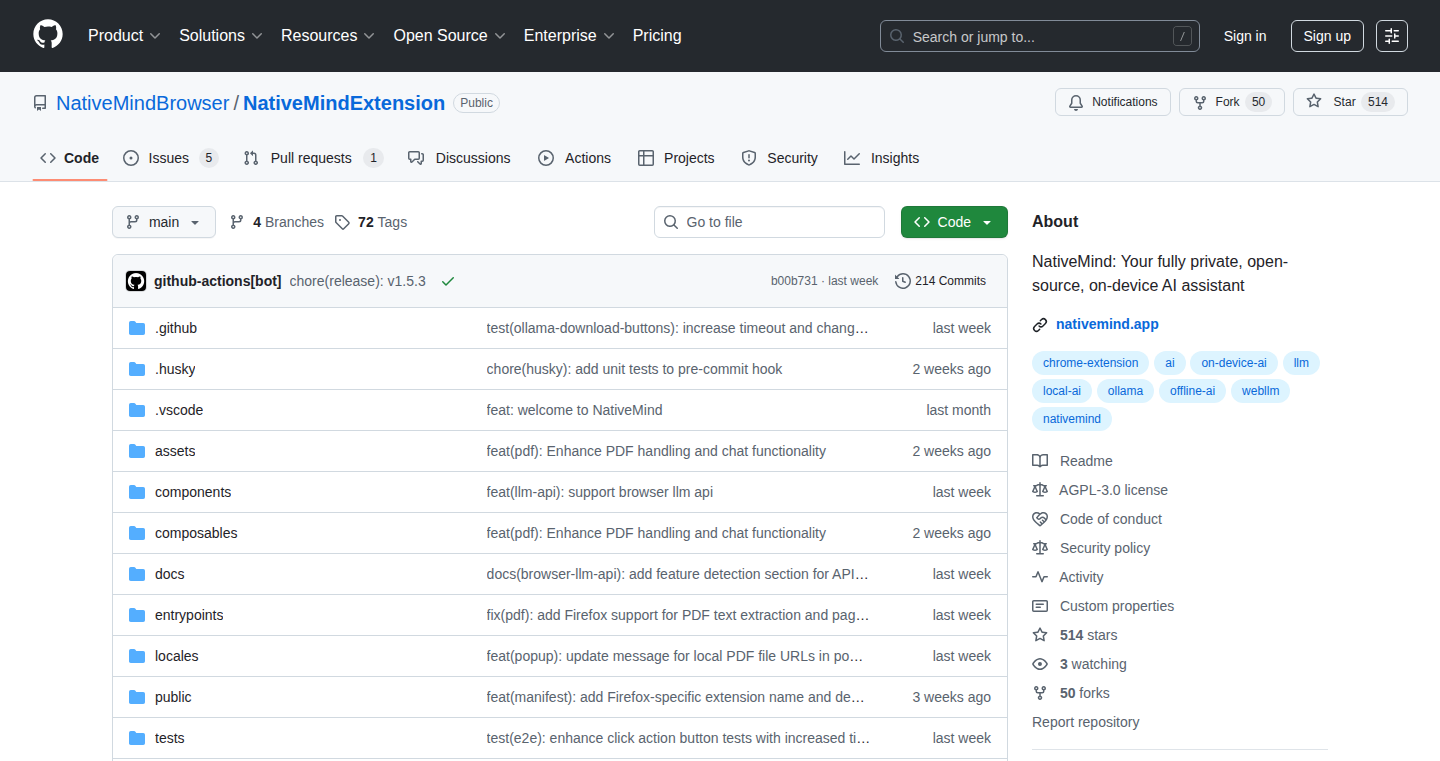
Author
kaylakay
Description
NativeMind is a browser extension that brings an AI assistant directly to your browser, without sending your data to the cloud. It leverages the power of local AI models (like those available through Ollama) to offer features like search, summarization, translation, and Q&A, all within your browser. This is a big deal because it means your browsing data stays private, and you don't have to worry about internet connection issues for basic AI tasks. It tackles the problem of data privacy and offers a convenient way to interact with AI during your daily web usage.
Popularity
Points 3
Comments 4
What is this product?
NativeMind is a browser extension that essentially puts a smart, AI-powered assistant right inside your web browser. Instead of sending your data to some remote server, it uses AI models that run directly on your computer. Think of it like having a mini-AI brain built into your browser. This is achieved by connecting to local models via Ollama. The cool part is you can use it for things like quickly summarizing articles, translating web pages, or asking questions about what you're reading. So this gives you a private and offline-friendly AI assistant for your web browsing.
How to use it?
Developers can use NativeMind by simply installing the extension in Firefox or Chromium-based browsers. Once installed, it integrates into your browser's interface, allowing you to select text, right-click, and access AI functionalities like summarization or translation. It connects to local AI models, so you’ll need to have Ollama and the appropriate model (like a large language model) set up on your machine. You could, for example, use NativeMind to summarize research papers while developing a new feature or translate documentation on the fly. It’s simple to integrate into your existing workflow and can save significant time.
Product Core Function
· Search: NativeMind allows you to search the web using AI, providing more relevant and context-aware results directly within your browser. This eliminates the need to switch between different windows or apps, saving time and effort. So this saves you time by quickly filtering through search results to find exactly what you need.
· Summarization: With a simple click, you can summarize any web page or selected text. This is useful for quickly grasping the key points of articles, reports, or documents without reading the entire content. So this helps you save time and effort in understanding lengthy documents.
· Translation: Translate text or entire web pages on the fly. This is particularly helpful for developers working with documentation or code written in other languages. So this broadens your horizons by making content from different languages accessible.
· Q&A: Ask questions about any text or web page, and get immediate answers, making it easier to extract information and clarify doubts. This is great for research or understanding complex topics. So this makes it easier to understand complex topics and research, reducing the time to find the information you need.
Product Usage Case
· Developers can use NativeMind to quickly summarize API documentation while working on a project, saving time and helping them understand complex technical details. So this speeds up your development process.
· When researching a new technology, a developer can use NativeMind to translate foreign-language articles and get the key takeaways from the summaries. So this helps you stay informed about new technologies worldwide.
· A developer could use it to instantly translate code comments and documentation into their native language. So this improves the readability and understanding of code, helping with code maintainability.
16
NutriAI: Your AI-Powered Supplement Advisor
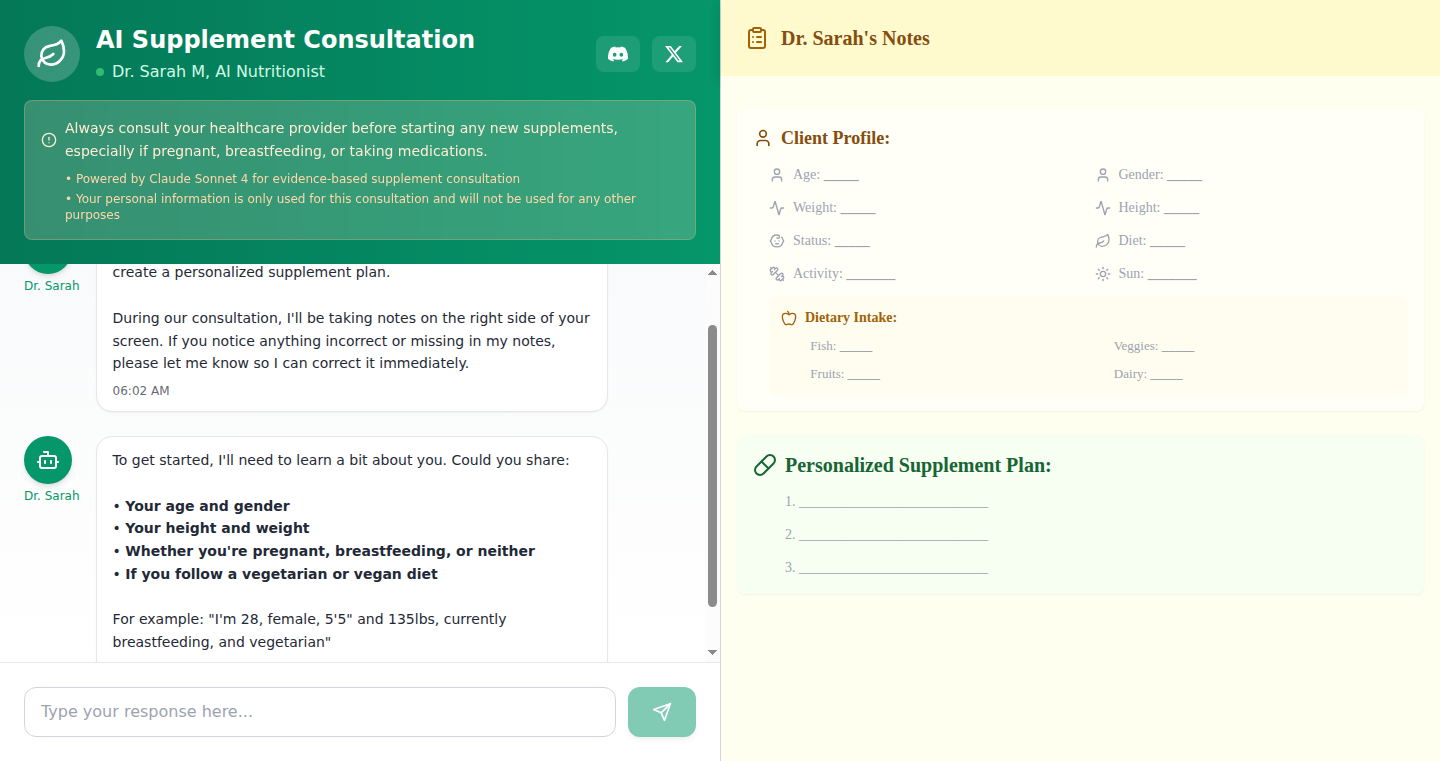
Author
bingwu1995
Description
NutriAI is an AI-driven tool designed to help users navigate the complex world of dietary supplements. It tackles the common problem of information overload and confusion when choosing supplements. The innovation lies in its use of AI to personalize supplement recommendations based on individual health goals, dietary habits, and potential interactions. It essentially acts as a virtual nutritionist, simplifying a daunting task for health-conscious individuals. So, this helps users make informed decisions about supplements without needing to become a supplement expert.
Popularity
Points 3
Comments 4
What is this product?
NutriAI leverages a combination of Natural Language Processing (NLP) and machine learning. It analyzes user input regarding their health goals (e.g., muscle gain, improved sleep), dietary restrictions, and existing health conditions. The AI then cross-references this information with a database of supplement information, including their ingredients, potential benefits, and potential side effects. This analysis results in a personalized list of recommended supplements, including dosages, and warnings regarding potential interactions. So, this is like having a personal nutritionist in your pocket, saving you time and research.
How to use it?
Developers can use NutriAI as an API or a library within their own health and wellness applications. This allows them to integrate the AI-powered supplement recommendation engine into their existing platforms. For example, a fitness app could use NutriAI to suggest supplements that complement a user's workout routine and dietary plans. Or a health tracking app can include supplement suggestion feature. This is implemented by sending a user's health data to NutriAI, receiving the tailored recommendations, and displaying them within the app. So, developers can create more personalized and valuable user experiences.
Product Core Function
· Personalized Supplement Recommendations: The core function is to generate personalized supplement recommendations based on user-provided health goals, dietary habits, and existing health conditions. Value: It cuts through the noise of marketing claims and provides data-driven suggestions. Application: Anyone wanting to take supplements but is unsure where to start or what to take.
· Ingredient Interaction Analysis: The AI analyzes potential interactions between recommended supplements and existing medications or health conditions. Value: This prevents potentially harmful combinations and highlights potential risks. Application: People taking medication, those with pre-existing health issues and who are looking for a safe supplements.
· Dosage Recommendation: Provides suggested dosages for recommended supplements. Value: Ensures users are taking the correct amount of each supplement. Application: Anyone wanting to make sure they have accurate supplement dosages.
· Supplement Information Database: A constantly updated database that is kept for each supplement containing ingredient information and related product information. Value: It offers a reliable source of information. Application: A quick information reference for any health-related concern.
Product Usage Case
· Fitness App Integration: A fitness app integrates NutriAI to suggest supplements for muscle growth and recovery, based on the user's workout plan and dietary intake. So, users get tailored recommendations alongside their fitness tracking.
· E-commerce Supplement Platform: An e-commerce platform uses NutriAI to provide personalized product recommendations based on the customer's self-reported health data, increasing sales and customer satisfaction. So, it helps customers to find the right supplements and promotes trust and engagement.
· Wearable Health Device Integration: A wearable health device syncs data with NutriAI to provide supplement suggestions based on real-time health metrics like sleep quality, energy levels, and activity data. So, users get immediate and relevant supplement recommendations in line with their health profile.
17
Thermal Weather Printer: Physical Forecasts
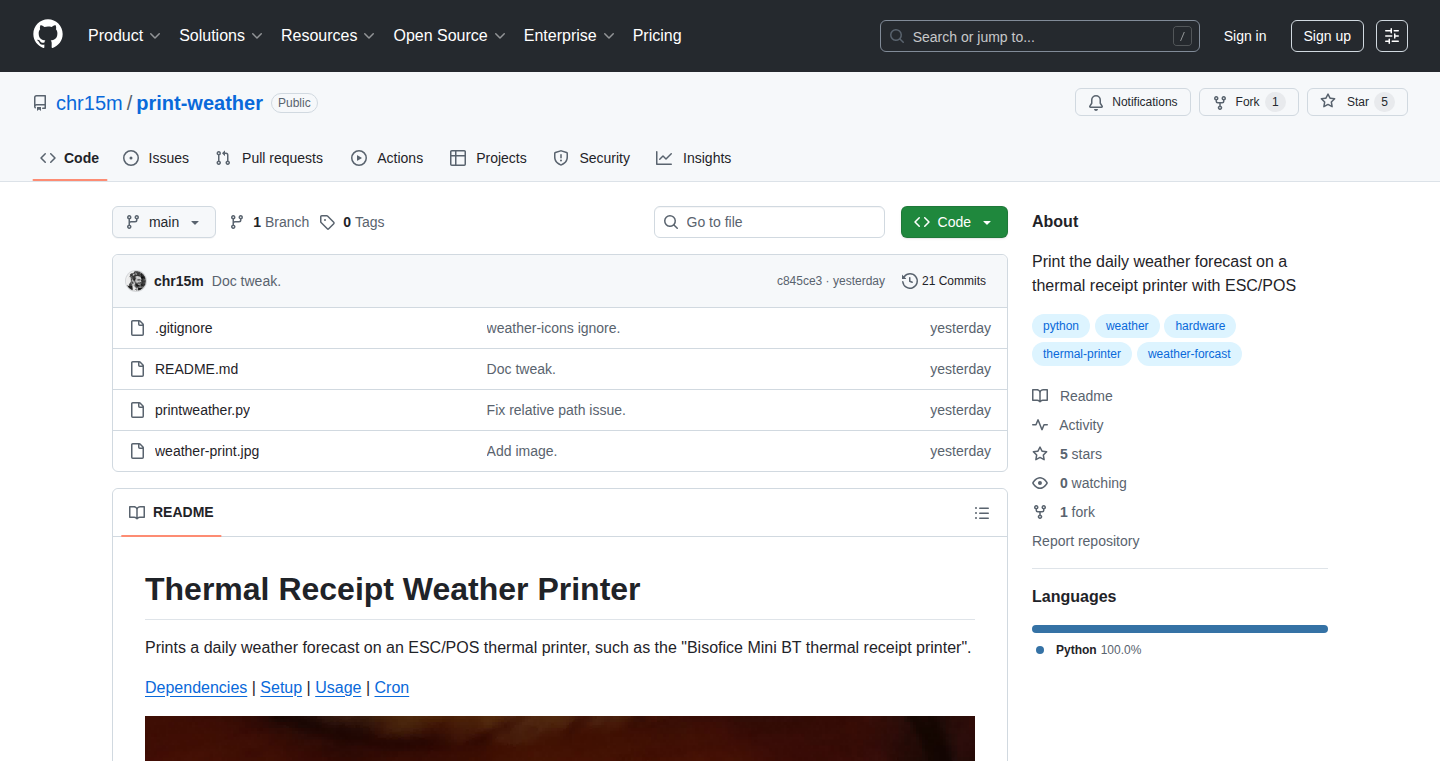
Author
chr15m
Description
This project is a simple Python script that takes weather data from the internet and prints it onto a small thermal receipt printer. The innovative part is the direct conversion of online weather icons into a format the printer can understand, allowing for a physical, tangible weather forecast every morning. It elegantly solves the problem of needing a quick, offline weather update using readily available and inexpensive hardware.
Popularity
Points 5
Comments 2
What is this product?
This project is a Python script that fetches weather information and translates it into commands that a cheap thermal receipt printer can understand. Instead of just displaying text, it converts weather icons into simple graphical representations the printer can print. It’s like creating a mini, customized weather station that prints out the day's forecast. So, it's a fun DIY project that makes your weather information physical and accessible without needing to look at a screen.
How to use it?
Developers can use this by: 1) Installing Python and the necessary libraries. 2) Configuring the script with their location (GPS coordinates) and timezone. 3) Connecting a thermal receipt printer to their computer. 4) Setting up a scheduled task (cron job) to run the script automatically. This is useful for anyone who wants a physical weather update without needing to look at their phone or a computer screen every morning. You could also customize the script to print other information alongside the weather, such as news headlines or important reminders.
Product Core Function
· Weather Data Retrieval: The script fetches weather data from a web service, which is a common method for getting current weather conditions and forecasts. This lets you get up-to-date information from the internet. So, it gets the raw data you need to make informed decisions about your day.
· Icon Conversion: The script converts complex weather icons (like sun, clouds, rain) into simple formats that the thermal printer can display. This is crucial because these printers don't have the ability to show complex graphics. So, this lets you see visual representations of the weather, not just text.
· ESC/POS Formatting: The script formats the weather data and the converted icons into ESC/POS commands, which is the language that many thermal printers understand. This ensures the printer knows what to print and how to format the information. So, this means you can easily tell your printer what to do without needing complicated drivers or setup.
· Scheduled Printing (Cron Job Integration): The script can be set up to run automatically, using a system tool called a cron job. This allows you to get a fresh weather printout every morning without having to manually run the script. So, this is super convenient because you can set it up once and let it work for you every day.
Product Usage Case
· Home Weather Station: Set up the printer in your home to print the weather forecast every morning, giving you a quick, glanceable overview of the day's conditions before you even check your phone. This solves the problem of needing to constantly look at a screen for a weather update.
· Office Desk Accessory: Place a printer on your desk to keep track of the weather throughout the day. It's a fun and practical way to stay informed about the weather. So, it replaces the need to constantly check weather apps.
· Customized Information Hub: Integrate this script with other information sources (like news feeds or calendar events) and print them alongside the weather forecast. So, this can transform your printer into a personalized information dashboard that prints everything you need in the morning.
18
CodeBoarding: Recursive Visualizer for Codebases with Static Analysis and LLMs
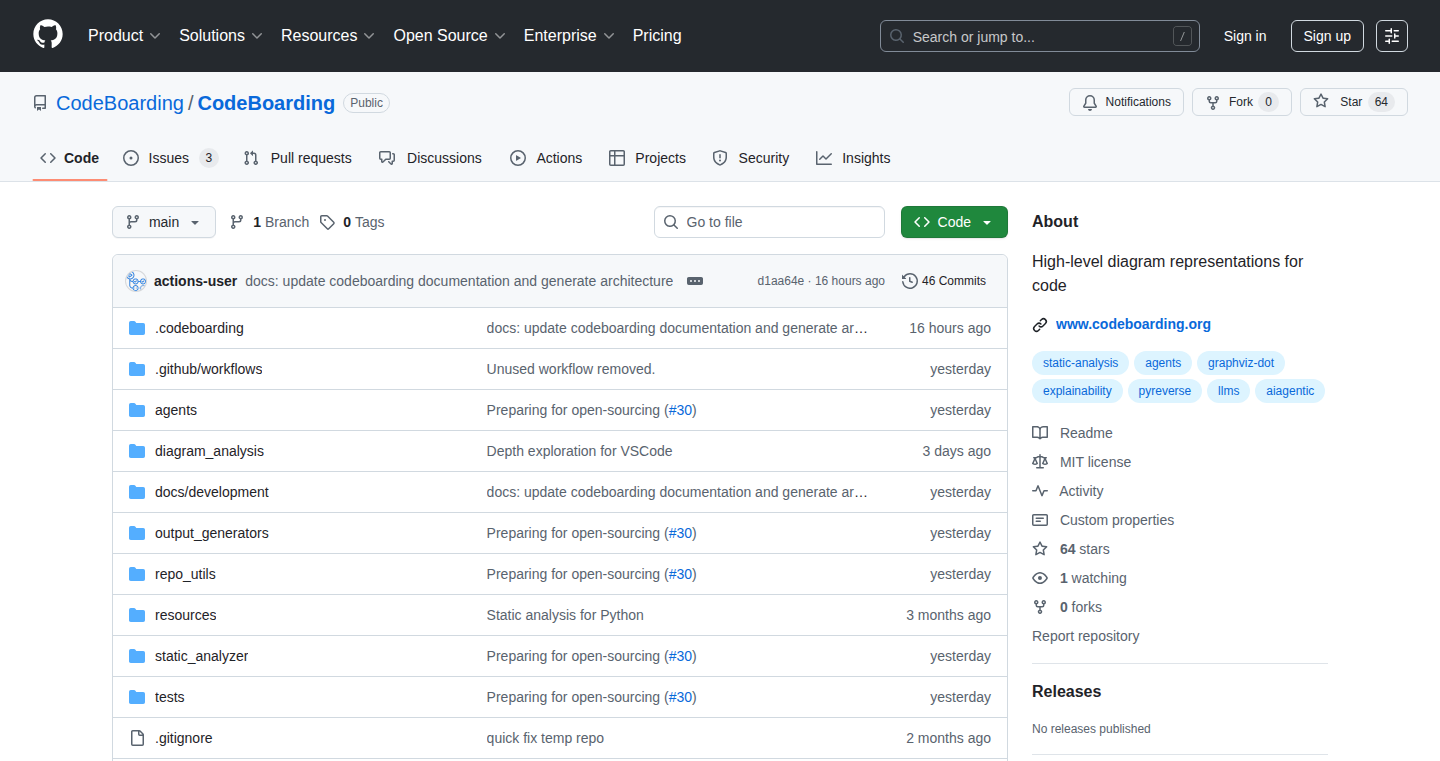
Author
imilev
Description
CodeBoarding is a tool designed to create visual maps of your codebase, helping you understand complex software projects. It uses a combination of static analysis (examining code without running it) and Large Language Models (LLMs, like the ones that power chatbots) to generate diagrams. The key innovation is integrating static analysis to validate the LLM's analysis, ensuring the diagrams are accurate and avoid 'hallucinations' (where the LLM makes things up). It starts with high-level abstractions and allows you to drill down into details. A built-in MCP-server provides documentation to reduce errors and context window issues. So this helps you understand large, complex codebases more efficiently.
Popularity
Points 5
Comments 2
What is this product?
CodeBoarding visualizes codebases, making it easier to understand the structure and relationships within your code. It works by first analyzing the code's structure statically to build a control-flow graph (a map showing how different parts of the code interact). Then, it uses LLMs to analyze this graph and generate diagrams, providing insights into the code's functionality. To ensure accuracy, the tool cross-references the LLM's findings with the initial static analysis, reducing errors. It includes an MCP-server to provide documentation and avoid LLM context window limitations. So this provides an accurate and scalable way to visualize your code.
How to use it?
Developers can use CodeBoarding to generate diagrams of their projects. You'd likely integrate it into your development workflow, possibly as part of your IDE or CI/CD pipeline. You would provide the tool with your codebase, and it would generate visual representations of the code's architecture, relationships, and functionality. This is useful for understanding how different parts of your project interact, debugging, and collaborating with other developers. So you can quickly grasp the structure and behavior of your code.
Product Core Function
· Recursive Visualization: The ability to start with a high-level overview and dive into specific details of the codebase. So this helps you navigate complex projects without getting lost in the details.
· Static Analysis Integration: Uses static analysis to build a control-flow graph and validate the LLM's analysis, ensuring accuracy and preventing hallucinations. So this gives you reliable and trustworthy visual representations of your code.
· LLM-Powered Diagram Generation: Leverages LLMs to understand the code's structure and relationships, generating insightful diagrams. So this allows you to quickly understand your code's design.
· MCP-Server for Documentation: Provides documentation to help prevent hallucinations and avoids context window issues, ensuring consistent and accurate analysis. So this ensures the diagrams are always up-to-date and accurate, even when you don't have all the documentation.
· Scalability for Large Projects: Designed to handle large codebases, allowing for visualization of complex systems like PyTorch. So this allows you to use the tool on any size of code project, even huge ones.
· Diagram Representation: Concise and accurate representation of a codebase. So this makes your code easier to digest and understand.
Product Usage Case
· Debugging: Use CodeBoarding to visualize the flow of execution in your code, quickly identifying and fixing bugs. For example, when debugging a complex API integration, visualize the interaction between different modules to pinpoint the source of the error. So you can cut down on debugging time and frustration.
· Code Review: Share visual representations of your code with other developers during code reviews, making it easier to understand the changes and their impact. For example, when reviewing a pull request for a new feature, a visual map helps reviewers understand the feature's place within the larger system. So you and your colleagues can understand the code more efficiently during code reviews.
· Onboarding New Team Members: Accelerate the onboarding process for new developers by providing visual maps of the codebase, helping them quickly understand the project's architecture. For example, for new employees, a visual map helps them quickly learn about the code and how things are organized. So this helps new team members get up to speed more quickly.
· Refactoring: Visualize your codebase before refactoring to understand its structure and identify potential issues, then use the diagrams to guide the refactoring process. For example, before refactoring a legacy system, you can see the interconnectedness of each part. So you can reduce the risk of introducing bugs during refactoring.
19
LiveSync: Real-time Mobile Update Framework
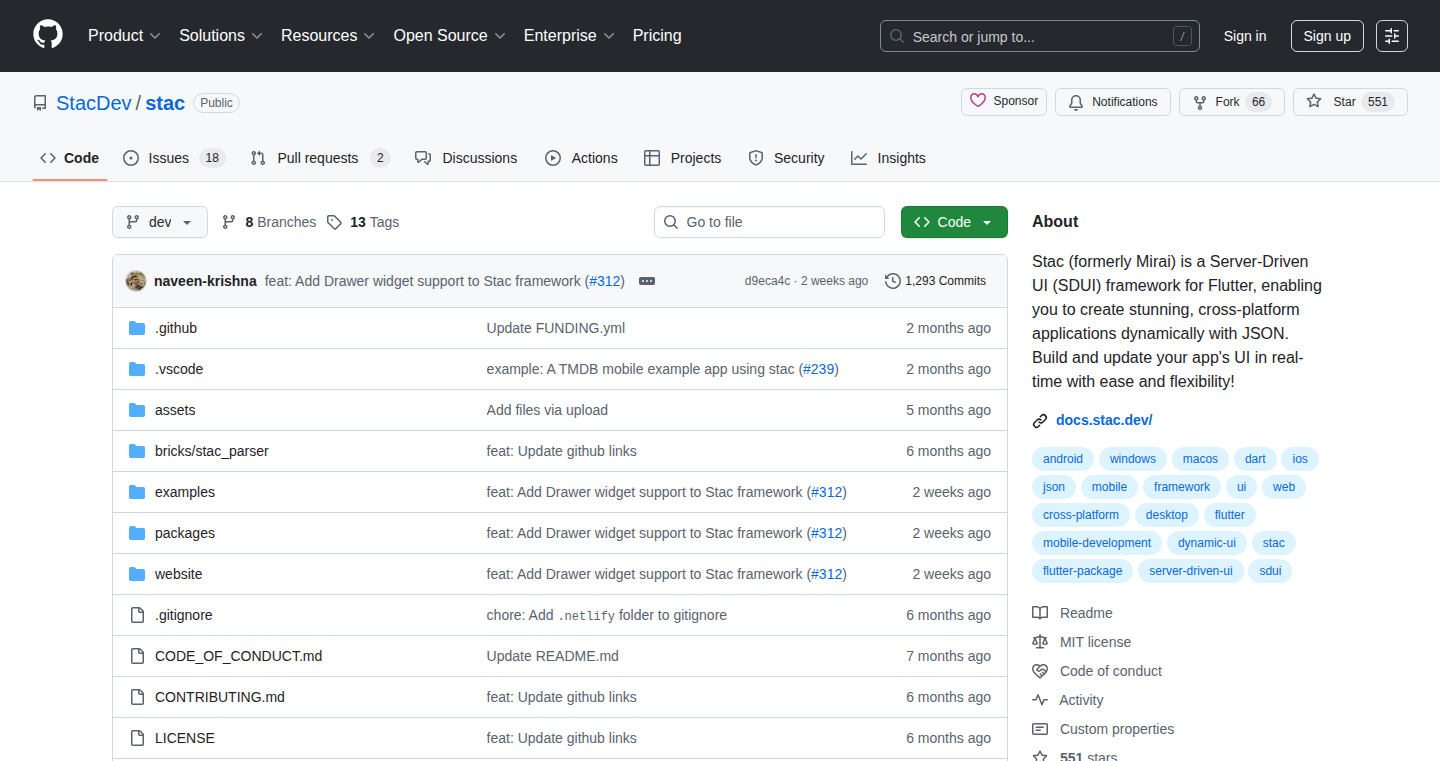
Author
rahulbisht
Description
LiveSync is a framework designed for instantly sending updates to mobile applications. It tackles the challenge of keeping mobile apps synchronized with real-time data, providing a streamlined approach for developers to implement features like live chat, real-time dashboards, and collaborative applications. The core innovation lies in its simplified architecture for handling real-time updates without requiring complex setups or infrastructure.
Popularity
Points 4
Comments 2
What is this product?
LiveSync simplifies real-time mobile app updates by providing a dedicated framework. Instead of developers needing to build everything from scratch, LiveSync offers a pre-built solution that handles the complexities of pushing data to apps in real-time. Its core technology involves efficient data synchronization and secure communication protocols. So this lets you focus on building the features of your app instead of building the pipes that deliver data.
How to use it?
Developers integrate LiveSync into their mobile app and server-side code. They define the data they want to send to the app, and LiveSync handles the rest – establishing the real-time connection, sending the data, and updating the app’s UI. Use cases include sending live sports scores, updating a shopping cart with the latest items, or enabling real-time collaboration in a document editor. So you can easily add real-time features to your app.
Product Core Function
· Real-time Data Push: Delivers updates to mobile apps as soon as they occur, enabling immediate display of changing information such as new messages in a chat app. So this helps your app stay up-to-date and your users stay informed.
· Simplified Integration: Offers an easy-to-use API and SDK, allowing developers to quickly add real-time features without extensive technical knowledge or complex setups. So this saves you time and reduces the effort needed to build features.
· Scalable Architecture: Designed to handle a large volume of concurrent connections, allowing the framework to scale seamlessly as the number of users and updates increase. So your app can handle lots of users and data without slowing down.
· Secure Communication: Employs secure communication protocols to protect data transmission between the server and the mobile app, ensuring data privacy. So your users’ information remains safe and secure.
· Cross-Platform Support: Supports multiple mobile platforms (iOS and Android) providing a unified solution for real-time updates across different devices. So this allows your app to reach more users on various devices.
· Data Filtering and Targeting: Provides mechanisms to target specific users or groups with updates, ensuring that only relevant data is sent to the right users. So you can personalize the information that reaches your users.
Product Usage Case
· Real-time Chat Application: Developers can use LiveSync to build a chat application where messages appear instantly, delivering a seamless user experience. So your users can chat in real-time.
· Live Dashboard: An analytics dashboard can display real-time data, such as sales figures or website traffic, ensuring that users have instant access to up-to-date information. So you always have the latest data at your fingertips.
· Collaborative Editing: Enable multiple users to edit a document or whiteboard simultaneously, with all changes reflected instantly for all participants. So your users can work together efficiently.
· E-commerce Price Updates: Display real-time changes in product prices or stock levels to customers. So your customers will know the latest prices and stock levels.
· Social Media Feeds: Update social media feeds in real time, providing users with instant access to the latest posts and interactions. So users can view new content without delay.
20
Macintosh Bridge: Connecting Classic Macs to the Modern World
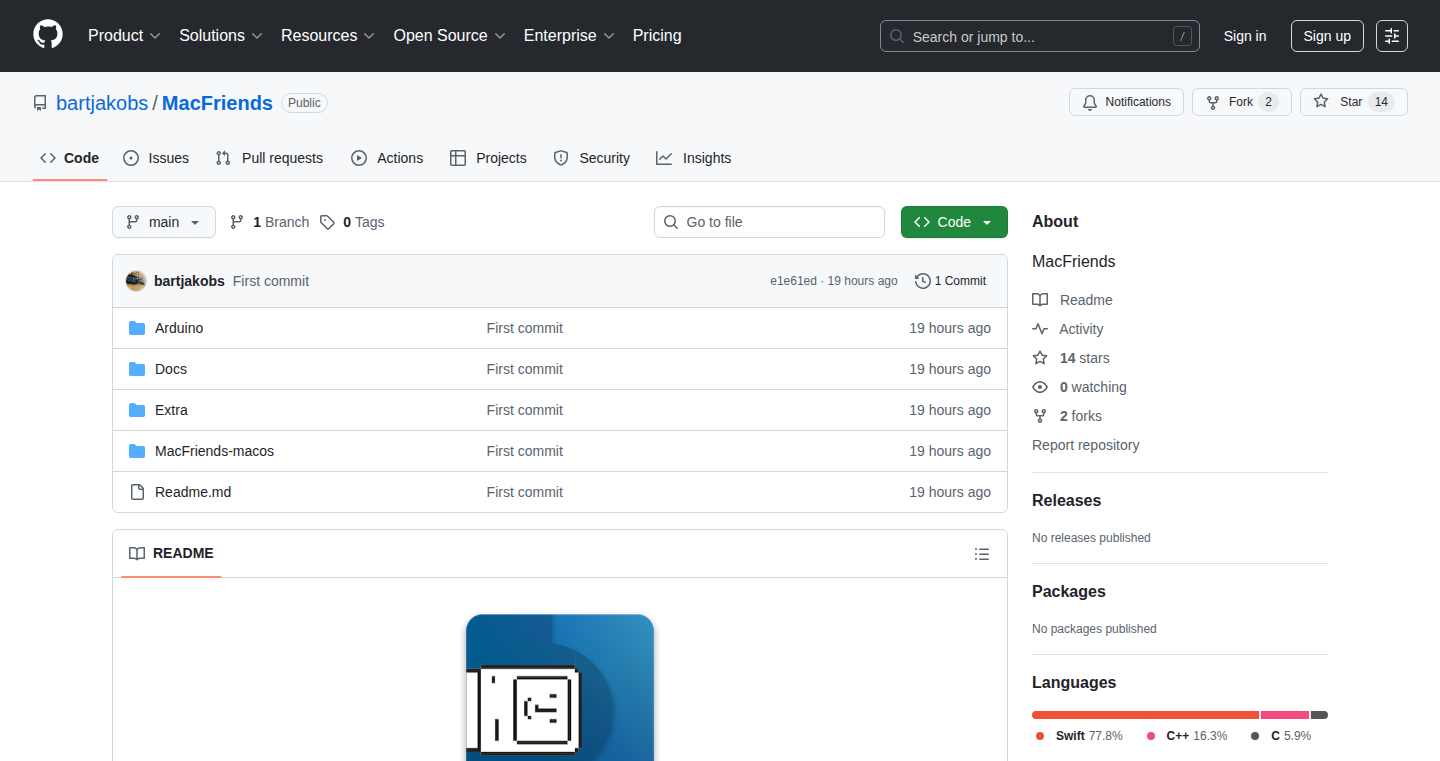
Author
bartjakobs
Description
This project creates a 'bridge' between vintage Macintosh computers and modern Macs, allowing control of the older machines using a modern setup. It uses an Arduino (a small, programmable computer) to translate communication signals, specifically the Apple Desktop Bus (ADB) used by the old Macintoshes into a format that modern Macs can understand. The innovation lies in using readily available and affordable hardware like the Arduino to interact with legacy systems, circumventing the need for specific, hard-to-find components. It elegantly solves the problem of controlling classic Macs with contemporary peripherals.
Popularity
Points 6
Comments 0
What is this product?
This project essentially acts as a translator. Imagine trying to talk to someone who only speaks a very old dialect. The Arduino acts as the translator. It takes commands from your modern Mac and converts them into the language the old Macintosh understands, and vice versa. It achieves this by decoding and encoding the ADB signals – the 'language' the older Macs used for keyboards, mice, and other input devices. So, this is useful because it lets you control and use your vintage Macintosh with modern equipment, like your new Mac and potentially modern peripherals.
How to use it?
Developers can integrate this by using the provided code, modifying it for their specific needs. They could adapt the code to interface with different vintage Mac models or create new interaction methods. This is done by connecting the Arduino to the modern Mac and the vintage Macintosh. You could, for example, connect a modern mouse and keyboard to the modern Mac, and then use them to control the classic Macintosh. This is valuable for hobbyists, retro-computing enthusiasts, or anyone who wants to preserve and interact with older technology.
Product Core Function
· ADB Translation: The core function is translating Apple Desktop Bus (ADB) signals, the communication protocol used by classic Macs, into a format understood by modern Macs. This allows the modern Mac to send instructions and receive responses from the classic Macintosh. So this lets you actually control the classic mac with modern peripherals.
· Serial Communication Bridge: The Arduino acts as a serial communication bridge, receiving commands from the modern Mac (via a USB connection, for example) and converting them into ADB signals. It also receives ADB signals from the classic Mac and relays them back to the modern Mac in a readable format. This allows for bi-directional communication. So this means you can control the old computer with your new computer and view the actions taking place.
· Hardware Abstraction: The Arduino abstracts the complexity of ADB communication. By using readily available hardware (Arduino), the project avoids the need for custom-built or rare components. This is the 'easy button' for communicating with the old mac.
· Input Emulation: The project allows the user to control the classic Macintosh's keyboard and mouse via the modern Mac's input devices, effectively emulating the original hardware. So this means you can use the modern keyboard and mouse to interact with old computer. This provides an easier user interface.
Product Usage Case
· Retro Gaming: A user can connect a modern mouse and keyboard to their modern Mac and play old Macintosh games. This avoids the limitations of the original hardware, allowing for a better gaming experience. So this lets you play old games on old computers with modern input.
· Archiving and Data Transfer: It can be used to easily transfer files and data from the classic Macintosh to a modern system, facilitating the preservation of historical documents and software. You can now easily back up old computer data using modern devices. So this makes it easier to transfer data from the old mac to a new mac.
· Educational Projects: Students and hobbyists can use this to understand the inner workings of classic Macintosh computers and experiment with hardware and software. This facilitates learning by interacting with older technologies.
· Accessibility: The project can allow users with disabilities to use classic Macintosh computers with modern input devices (e.g., modified keyboards or alternative mice). So this enables people with disabilities to use older technology.
21
Docucod: Codebase Documentation Automator
Author
clidey
Description
Docucod is a tool that automatically creates and keeps your code's documentation up-to-date. It solves the common problem of outdated and incomplete documentation in software projects by analyzing your code, comments, and other project details. It then generates a browsable documentation site, making it easy for developers to understand and work with the codebase. The core innovation is in automatically extracting context from the code, reducing manual documentation efforts, and improving collaboration by keeping information current. This reduces the time spent on understanding existing code, onboarding new team members, and debugging issues.
Popularity
Points 6
Comments 0
What is this product?
Docucod is a service that analyzes a software project's source code (from a GitHub repository in this case) and automatically generates documentation. It works by parsing your code files, comments, data types, and even your project's README file. Then, it produces a static documentation website that you can browse immediately. The key innovation is that Docucod tries to automatically extract useful information so you don't have to read the code line by line to figure out how things work. It also generates diagrams (using Mermaid) to visualize your code's structure. So, it helps developers quickly understand, use, and maintain a codebase.
How to use it?
To use Docucod, you simply provide the URL of your public GitHub repository. Docucod will process your code and generate the documentation, which you can then access through a provided link. You can integrate it into your development workflow to keep your documentation synchronized with your code changes. For example, you can add it into your CI/CD pipeline to generate documentation automatically on every code commit or release. Therefore, it ensures that your documentation always reflects the latest state of your code. The generated documentation is designed to be easily browsable and searchable, facilitating team collaboration and knowledge sharing.
Product Core Function
· Automated Documentation Generation: Docucod automatically creates documentation by analyzing code, comments, and README files. So, if you're a developer, it saves you the time and effort of manually writing and maintaining documentation.
· Code Parsing and Context Extraction: The tool parses the code to identify functions, classes, and other components, extracting key information. This helps in understanding the purpose and usage of the code elements. So, it helps you quickly grasp what the code does, leading to faster development and less debugging.
· Static Site Generation: Docucod builds a static documentation website that is easy to browse and navigate. So, this provides a user-friendly interface for accessing documentation.
· Diagram Generation (Mermaid Integration): It supports diagram generation using Mermaid, a markup language for creating diagrams. So, this visualizes the code structure, making it easier to understand complex systems.
Product Usage Case
· Onboarding New Developers: A new developer joins a project and uses Docucod to quickly understand the project structure, the purpose of different code components, and how they interact. This allows the new developer to contribute to the project sooner. So, it reduces the onboarding time for new team members.
· Code Review and Maintenance: During a code review, a developer uses Docucod to easily understand the functionality of a specific code module. This streamlines the review process and ensures that all team members are on the same page. So, it speeds up the code review process.
· Documentation for Open Source Projects: An open-source project uses Docucod to create and maintain up-to-date documentation for its codebase, encouraging new contributors and making it easier for users to understand and use the project. So, it attracts more contributors and users.
22
Docmd: Lightweight Markdown-to-HTML Documentation Generator
Author
enigmazi
Description
Docmd is a command-line tool that takes your Markdown files and transforms them into sleek, responsive HTML documentation. It's a lightweight alternative to heavy-duty frameworks like Docusaurus or Mintlify, designed specifically for developers who need quick and easy documentation for their open-source projects. The innovation lies in its simplicity: it focuses on providing essential features like built-in components, plugin support, and GitHub Pages compatibility without the bloat of a full-fledged framework. So this solves the problem of needing a fast and easy way to document projects.
Popularity
Points 3
Comments 2
What is this product?
Docmd is essentially a code translator. It reads your Markdown files (the .md files you use for notes, documentation, etc.) and turns them into pretty websites that work on all devices. It’s built with Node.js, a popular tool for creating web applications. The main innovation is its minimalist design, making it fast and easy to set up. It includes pre-built components (like tables or lists) and lets you add extra features with plugins. It also plays nicely with GitHub Pages, so it's simple to host your documentation online. So this means it's a quick way to make your documentation look professional without a lot of effort.
How to use it?
Developers use Docmd by running a simple command in their terminal (the command line). They point Docmd at their .md files, and Docmd generates the HTML files that make up the documentation website. You can integrate it into your project's build process, so your documentation updates automatically whenever you change your code. It's particularly useful for open-source projects where you want to provide clear and accessible documentation for users. So this allows you to easily document your project.
Product Core Function
· Markdown-to-HTML conversion: Docmd’s core function is to convert Markdown files into clean, readable HTML, the language of the web. This means you can write your documentation in an easy-to-understand format (Markdown) and have it automatically converted into a website. This is useful because it simplifies the documentation process, allowing developers to focus on content rather than formatting. So this means you get automatically formatted documentation.
· Responsive design: Docmd generates documentation that looks good on any device (desktops, tablets, phones). This is crucial because users might access your documentation from any device, and responsive design ensures they have a good experience. So this means your documentation is always accessible.
· Theming and customization: Docmd allows you to customize the look and feel of your documentation with themes. So this means you can make your documentation visually appealing.
· Plugin support: Docmd lets you extend its functionality with plugins. This means you can add extra features like interactive code examples or advanced search capabilities. So this means you can add the exact features you want.
· GitHub Pages compatibility: Docmd is designed to work seamlessly with GitHub Pages, a free service for hosting websites. This makes it easy to deploy and share your documentation with the world. So this means you can easily host and share your documentation.
Product Usage Case
· Open-source project documentation: A developer creates an open-source library and uses Docmd to generate the documentation. They write the documentation in Markdown, use Docmd to create the website, and then host it on GitHub Pages. This helps users understand how to use the library and contribute to the project. So this helps make your project more useful for others.
· Personal blog or notes: A developer uses Docmd to create a simple website to host their personal notes or a blog. They write their notes in Markdown, use Docmd to generate the website, and host it on a platform like GitHub Pages. This allows them to create a good-looking website. So this helps you create a nice website from your notes.
· Project Readme generation: Developers can use Docmd to help generate the README.md file for their project and make sure that it always looks good and is easy to read, improving the first impression for users of a project. So this helps users immediately understand your project.
23
Rallies-CLI: AI-Powered Investment Research Terminal
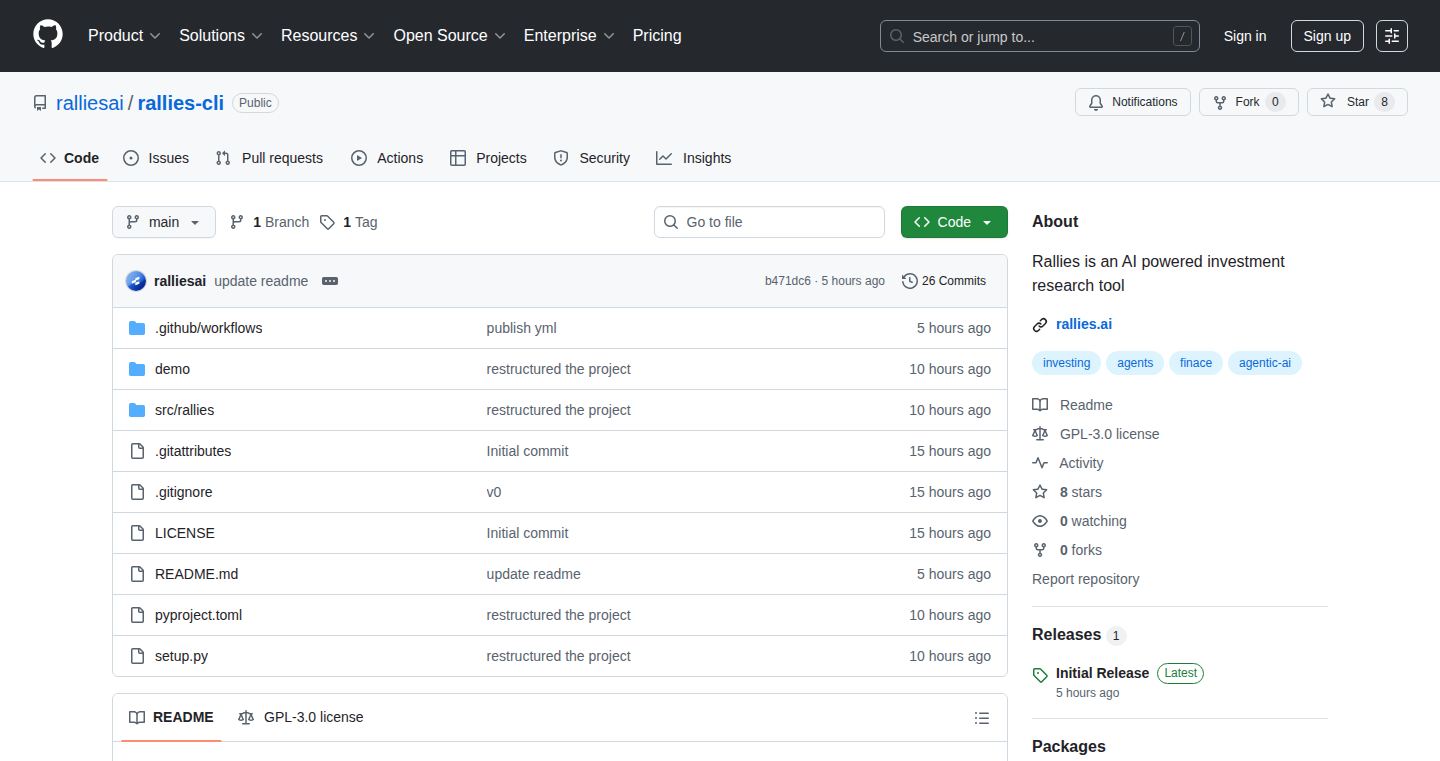
Author
Faizann20
Description
Rallies-CLI is a command-line interface (CLI) tool that leverages Artificial Intelligence (AI) to provide investment research insights. It allows users to query financial data, analyze market trends, and generate summaries directly from their terminal. The core innovation lies in its ability to synthesize information from various financial sources and present it in a concise, easily digestible format, powered by AI models. This tackles the common problem of information overload in the investment world, helping users quickly understand complex financial data.
Popularity
Points 3
Comments 2
What is this product?
Rallies-CLI uses AI, specifically natural language processing (NLP) and potentially large language models (LLMs), to understand and respond to your investment-related questions. You can ask it about stock performance, financial news, or market analyses. The AI then processes data from multiple sources – news articles, financial reports, and market data feeds – to give you the answers you need. So this offers a quick and easy way to gain insights into investments without spending hours reading through reports.
How to use it?
Developers can use Rallies-CLI by installing it on their system and interacting with it via the command line. You would type in questions such as 'What is the current price of Apple stock?' or 'Summarize the latest news about Tesla'. The tool then processes your request and displays the relevant information. Integration is likely achieved through API calls or by directly interacting with the CLI. This makes it useful for automated investment analysis, creating scripts that monitor market trends, and building more sophisticated investment tools. For instance, you could create a script that automatically checks the price of a specific stock and alerts you if it changes by a certain percentage. So this allows you to automate investment analysis and monitor market trends.
Product Core Function
· AI-Powered Question Answering: The ability to answer investment-related queries using natural language. This allows users to get information in a conversational manner, making complex data more accessible.
· Data Aggregation and Summarization: Automatically gathers data from multiple financial sources and provides concise summaries. This saves users time by consolidating information from various sources into a single report.
· Sentiment Analysis: Analyze the sentiment (positive, negative, or neutral) of news articles and reports related to specific investments. This helps users understand market sentiment and gauge potential risks.
· Market Trend Analysis: Analyze market trends and provide insights into potential investment opportunities. Helps users identify areas for investment and assess risks.
· Financial Data Retrieval: Provides real-time financial data, such as stock prices, financial ratios, and company performance metrics. Offers users immediate access to necessary financial data.
Product Usage Case
· Automated Portfolio Monitoring: A developer could create a script that uses Rallies-CLI to automatically monitor the performance of a stock portfolio and send alerts when certain criteria are met (e.g., stock price drops below a certain level). This is helpful for efficiently managing portfolios.
· News Aggregation and Analysis: Developers could integrate Rallies-CLI into a news aggregation app, allowing users to quickly access summarized investment news and sentiment analysis. This improves the user experience.
· Trading Bot Development: Developers can integrate the CLI's data and analysis capabilities into a trading bot. The bot can then make automated investment decisions based on the provided data. This automates complex investment tasks.
· Financial Reporting Tool: Developers could use the tool to generate automated reports, summarizing investment performance and market trends for clients. So this improves workflow by delivering quick insights and automation.
24
TrendVest: Automated Trend Investing using AI-Powered Sentiment Analysis

Author
gamerDude
Description
TrendVest is a platform that uses artificial intelligence to analyze news and social media to identify emerging trends, and then automatically invests in Exchange Traded Funds (ETFs) that align with those trends. The core innovation lies in its ability to automate the process of trend identification and investment, making it easier for users to participate in trending markets without needing to manually research individual stocks. It solves the problem of information overload and the difficulty of identifying worthwhile investment opportunities based on evolving market trends.
Popularity
Points 2
Comments 2
What is this product?
TrendVest uses Natural Language Processing (NLP) and machine learning to scan vast amounts of text data (like news articles and social media posts) to identify keywords and phrases related to emerging trends, such as 'electric vehicles' or 'renewable energy'. It then links those trends to relevant ETFs (which are like baskets of stocks), and provides automated investment recommendations and execution. This technology aims to simplify the investment process by removing the need for extensive manual research and simplifying investment decisions. So, you can invest in broad themes instead of individual company stocks.
How to use it?
Developers could integrate TrendVest's API into their own investment platforms or build custom trading tools. They can access trend data, sentiment scores, and ETF recommendations programmatically. You'd typically specify your investment criteria (risk tolerance, budget), and the platform handles the rest. This could be useful for robo-advisors, portfolio management tools, or for creating specialized investment dashboards. So, developers can quickly build trend-following investment applications.
Product Core Function
· Trend Identification: Analyzing news and social media to identify trending topics. This utilizes machine learning models to detect significant shifts in market sentiment. This helps identify early investment opportunities in trending sectors. So, it allows for quicker response to market changes.
· Sentiment Analysis: Determining the positive or negative sentiment associated with each trend. This uses NLP techniques to gauge how optimistic or pessimistic the market is about a specific topic. This gives investors a risk assessment based on trends. So, it helps gauge the strength of the trend.
· ETF Mapping: Matching identified trends to relevant ETFs. This utilizes a curated database and smart logic to link the trends to the right financial products. So it provides investors with a clear guide to actionable investments.
· Automated Investment Execution: Automatically executing trades based on user-defined criteria and trend signals. This offers automated investment options, saving you time and the manual investment procedure. So, it automates the trading process.
Product Usage Case
· A fintech startup integrates the TrendVest API into its robo-advisor platform to offer thematic investment options. Users can select investment themes such as 'clean energy' or 'future of work', and the platform automatically invests in ETFs aligned with these trends, optimizing portfolio performance. So, this expands their product offerings with automated trend-based investments.
· A developer builds a custom trading dashboard that displays real-time trend analysis and ETF recommendations. They can customize the data visualization to their preferences and receive alerts for trending topics. So, it gives them a customized investment analysis interface.
· An existing investment platform uses the API to add a new section for trend-based investment strategies, enabling users to discover and invest in trending sectors by providing automated investing. So, this enhances the user’s investment tools with market-aware information.
25
Memoized: JavaScript Algorithm Prep - Bridging the Gap Between Theory and Runtime
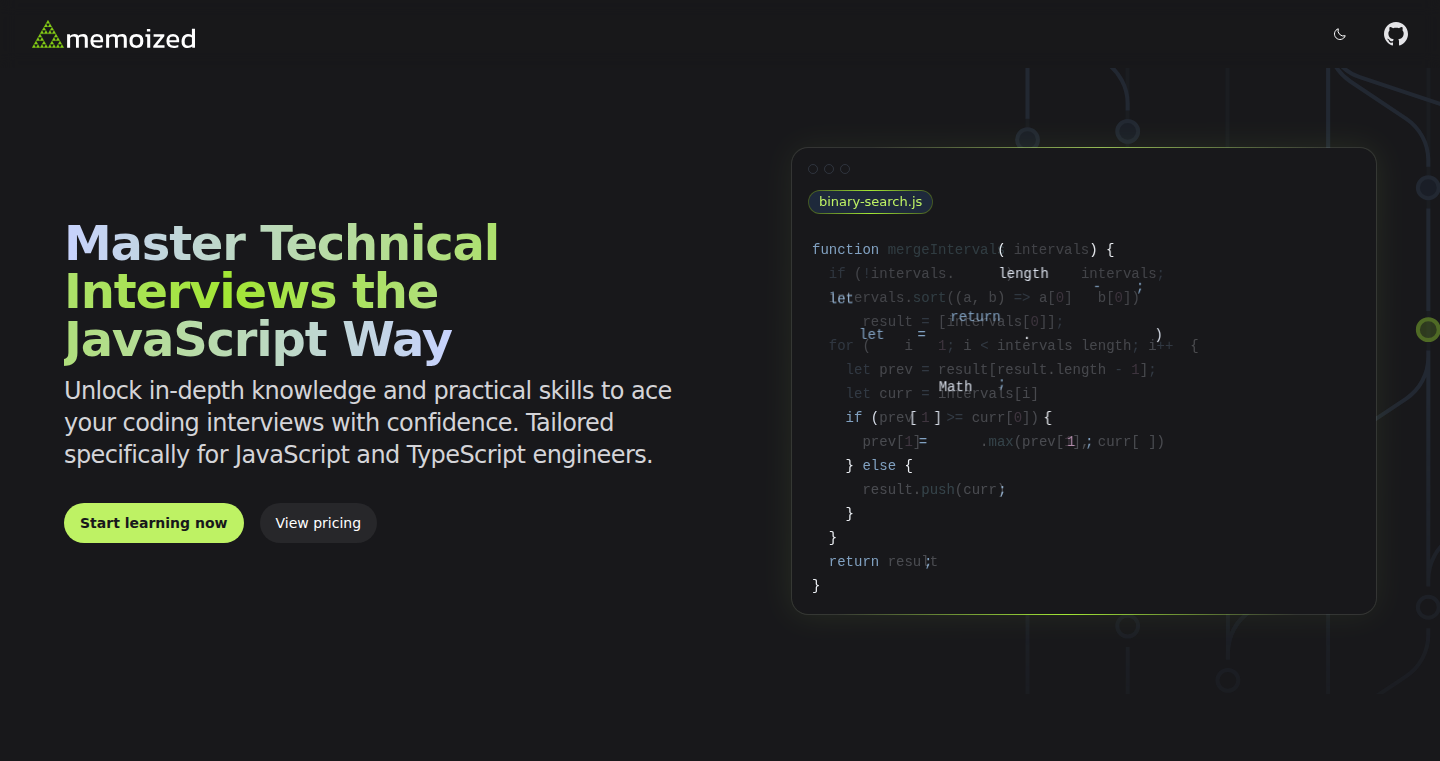
Author
elduderino05
Description
Memoized is a platform designed to help JavaScript developers master algorithms by focusing on the nuances of JavaScript's runtime environment. It tackles the challenges that arise from callback timing, closure capture, and memory management, which often trip up developers despite their algorithmic understanding. The platform uses interactive lessons and JavaScript-specific feedback, covering over 450 problems with a focus on practical scenarios where JavaScript's behavior significantly impacts performance and correctness. It bridges the gap between abstract algorithmic knowledge and its concrete implementation in JavaScript, making it invaluable for interview preparation and day-to-day coding.
Popularity
Points 4
Comments 0
What is this product?
Memoized is a learning platform that teaches algorithms specifically tailored for JavaScript developers. It goes beyond traditional algorithm prep by emphasizing how JavaScript's unique features, like its event loop and asynchronous nature, impact algorithm implementations. The platform uses interactive lessons built with technologies like Next.js, TypeScript, and Prisma. It covers a wide range of topics, including when to use different data structures (Map vs. {} vs. WeakMap), how the prototype chain affects hash table implementations, optimization techniques for recursive algorithms, and how to write algorithms that are aware of async operations. It links to popular coding challenge platforms (like LeetCode) but adds a crucial layer: explaining *why* JavaScript developers often struggle with these problems, helping you understand the 'how' and 'why' of JavaScript's runtime environment. So, if you're working with Javascript, this can help you become a better programmer.
How to use it?
Developers can access Memoized through its website (www.memoized.io). The platform offers interactive lessons, code examples, and JavaScript-specific feedback. It's ideal for preparing for technical interviews or improving overall JavaScript skills. Developers can start by exploring the free sections, which cover fundamental concepts, and then access more advanced topics through subscription or by reaching out for free access if they face financial difficulties. It is meant to be used as a supplementary resource for JavaScript developers who already have some basic understanding of algorithms or are preparing for interviews. Developers can work through different algorithm challenges, understand their pitfalls and leverage the interactive features to gain a deep understanding of the core concept.
Product Core Function
· Interactive Lessons: The platform uses MDX (Markdown + JSX) to create interactive lessons that allow users to learn by doing. This makes the learning process more engaging and effective.
· JavaScript-Specific Feedback: Provides tailored feedback that addresses the challenges of Javascript development, focusing on how the runtime environment affects algorithm implementation, rather than generic algorithmic concepts.
· Comprehensive Problem Coverage: Covers a wide range of algorithm problems, including those related to data structures, searching, sorting, dynamic programming, and graph algorithms.
· Async-Aware Algorithm Implementations: Teaches developers how to write algorithms that handle asynchronous operations efficiently, addressing common problems like callback timing, closure capture, and race conditions.
· Performance Optimization: Highlights the importance of memory management and JavaScript-specific performance optimization techniques, such as when to use different data structures (like Map, {} or WeakMap).
Product Usage Case
· Interview Preparation: A developer preparing for a JavaScript-focused technical interview can use Memoized to understand the nuances of JavaScript-specific algorithm questions. They can practice the problem with a focus on things like asynchronous programming. This will help them better understand and articulate their thought process during the interview.
· Improving Code Quality: A developer working on a project that involves complex data manipulation can use Memoized to understand the best practices for writing efficient and maintainable code. For example, they can learn the benefits of asynchronous patterns, leading to more scalable and efficient JavaScript code.
· Debugging and Troubleshooting: A developer encountering performance issues in their JavaScript code can use Memoized to identify potential bottlenecks and optimize their code. They can gain insights into the performance characteristics of different algorithms and data structures, and how they interact with the JavaScript runtime environment.
· Learning New Technologies: A developer wanting to enhance their understanding of modern JavaScript frameworks, such as React and Node.js, can use Memoized to learn about advanced topics such as asynchronous operations, data structures, and algorithm implementations, to solve real world problems more efficiently.
26
ZillowDataHarvester: Automated Property Data Extraction Tool
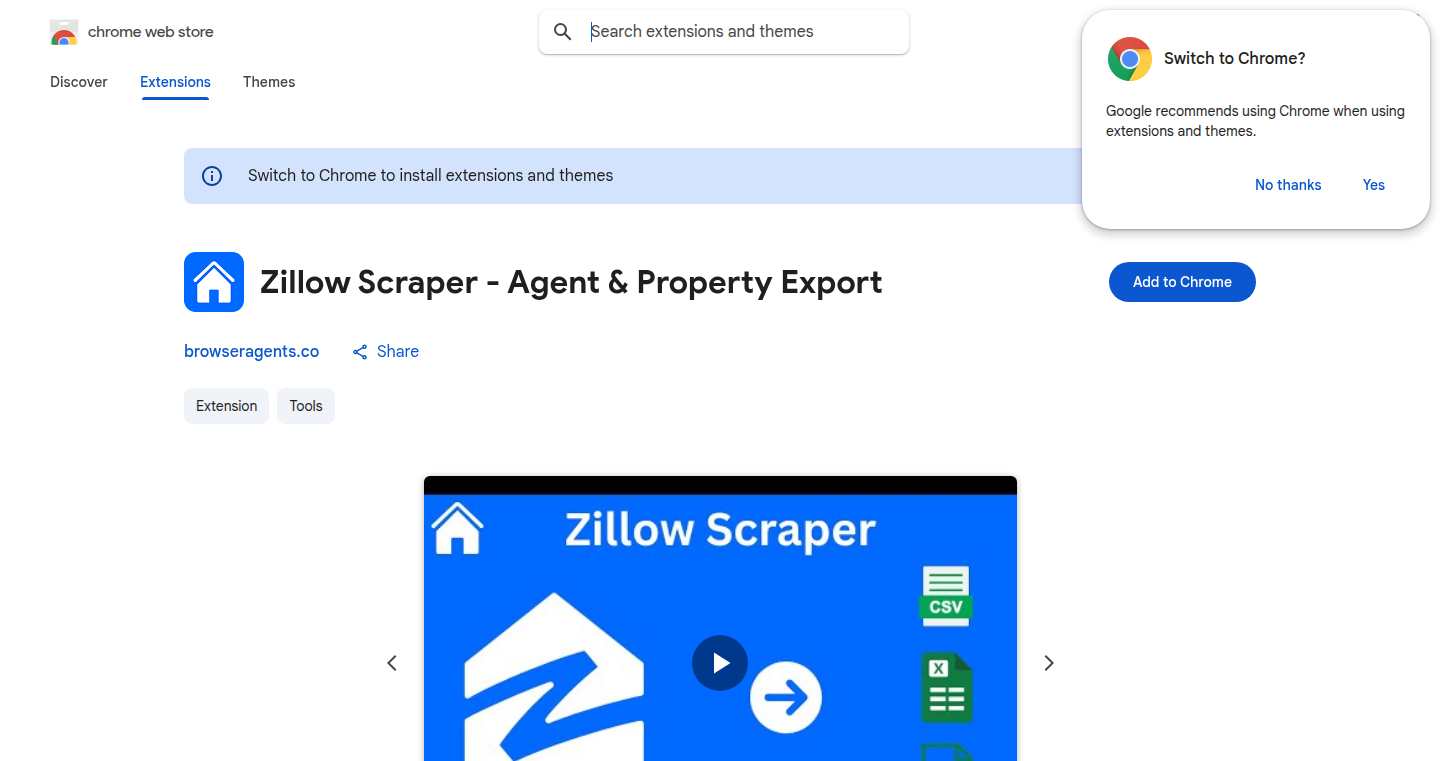
url
Author
qwikhost
Description
ZillowDataHarvester is a tool that automatically extracts detailed property information, including prices, agent details, and other relevant data, directly from the Zillow website. It allows users to download this information in common formats like CSV, JSON, or Excel. The innovation lies in automating the data gathering process, eliminating the need for manual data entry and providing a structured dataset ready for analysis or integration into other applications. This addresses the common problem of accessing and managing large amounts of real estate data efficiently.
Popularity
Points 2
Comments 2
What is this product?
This is a web scraping tool designed to collect and format data from the Zillow website. It uses automated techniques to navigate the website, extract specific pieces of information (like property prices, addresses, agent contact details, etc.), and convert them into a structured format (CSV, JSON, or Excel). The innovation is in the automation of this process, making it significantly faster and more efficient than manual data entry. So this means you can gather data on a large scale without spending hours manually copying and pasting information.
How to use it?
Developers would use ZillowDataHarvester by running the tool and specifying the parameters for the data they want to extract (e.g., location, property type). The tool then automatically collects the data and saves it in the desired format. Integration could involve using the extracted data in applications for market analysis, lead generation, or data visualization. You could also use the data to power your own real estate listings or for machine learning projects. So you get real estate data without the hassle of manually gathering it.
Product Core Function
· Automated Web Scraping: The core function is to automatically browse the Zillow website and extract data. This allows for the collection of information without manual effort. Its value is in saving time and enabling the collection of a large volume of data. It's useful for market research, competitive analysis, and building property databases.
· Data Format Conversion: The tool converts scraped data into structured formats like CSV, JSON, and Excel. This makes the data immediately usable in various applications and analysis tools. This is valuable because it eliminates the need for manual data cleaning and formatting. It's useful for importing data into spreadsheets, databases, or other analytical software.
· Agent and Property Data Export: This function provides the extraction of both property details and agent contact information. This broadens the scope of the data gathered, making it useful for lead generation, market analysis, and building customer relationship management (CRM) systems. This is useful for real estate agents looking to analyze the market or connect with potential clients, or developers building tools that leverage this data.
· Secure Data Download: The tool provides a secure way of downloading data. This ensures the confidentiality and protection of user data and addresses the problem of data security. This is useful for ensuring the data you extract is compliant with privacy regulations and protected from unauthorized access.
Product Usage Case
· Real Estate Market Analysis: A real estate investment company can use ZillowDataHarvester to gather historical pricing data and property details for a specific geographic area. This data can then be used to analyze market trends, identify investment opportunities, and create more informed investment strategies. So this helps to make smarter investment decisions.
· Lead Generation for Real Estate Agents: A real estate agent can use the tool to identify properties and agent contact information in a target area. This data can then be used to identify potential clients. So you can generate more leads and expand your client base.
· Building Property Valuation Tools: A developer can use the tool to gather data on property sales, property details, and market trends. This data can be used to develop a property valuation tool that can help users estimate the value of a property based on its characteristics and market conditions. So you can build a powerful property valuation tool.
27
Seede AI: Conversational Design Generator
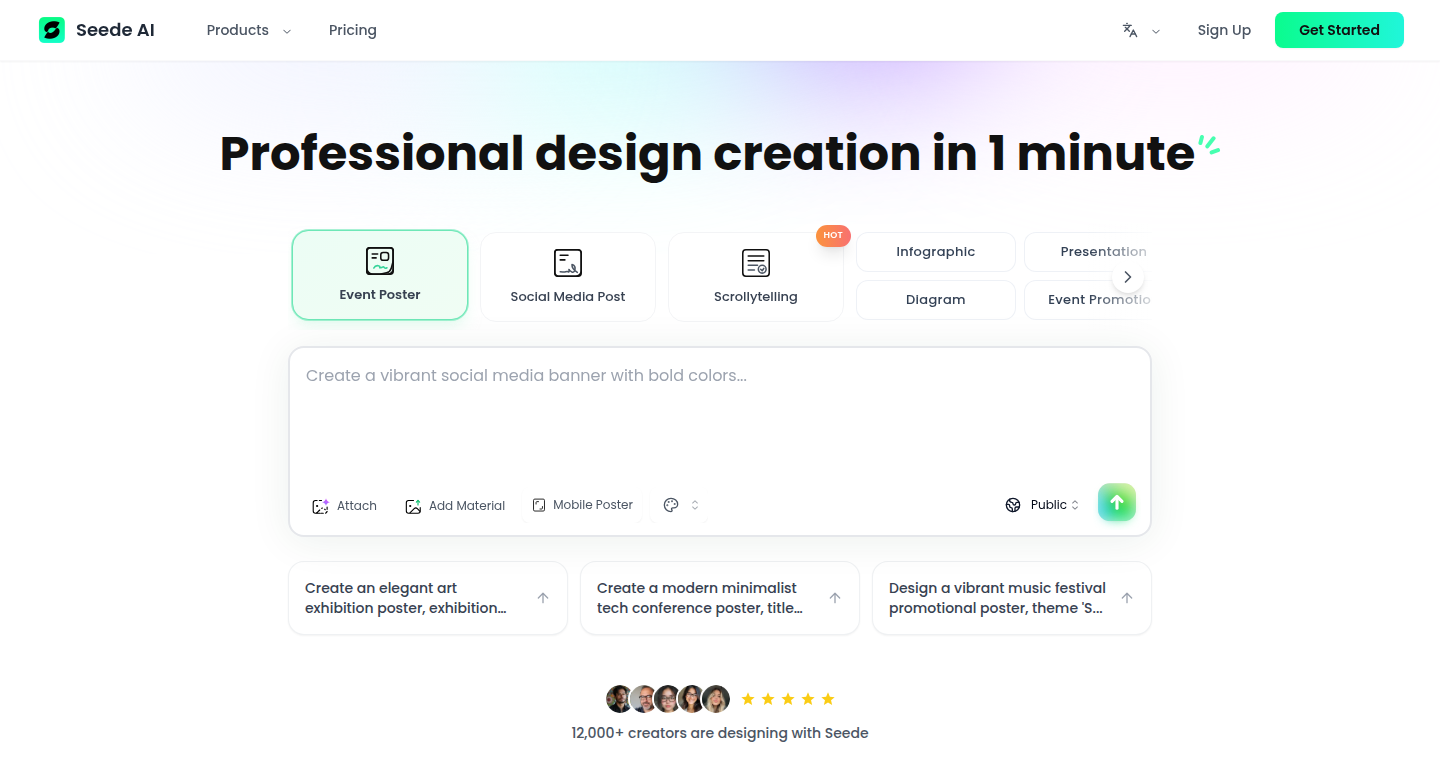
Author
hilongjw
Description
Seede AI is a design tool that lets you create professional-looking designs simply by describing what you want. It leverages the power of natural language processing (NLP) and generative AI to turn your text descriptions into print-ready designs. Think of it as having a designer who understands your needs based on a tweet-length description. It addresses the complexity of traditional design tools like Canva and Figma, making design accessible to everyone, even those without any design experience.
Popularity
Points 3
Comments 0
What is this product?
This project uses AI to understand your design requests. You provide a text description, like "A poster for a cat cafe grand opening, featuring a cute cat, with a modern font." The AI then analyzes this, picks appropriate design elements (images, fonts, colors), and generates a print-ready design. The core innovation is the simplification of the design process through conversational input, bypassing the need for users to navigate complex interfaces. So this is useful because anyone can create professional designs without needing design skills, saving time and resources.
How to use it?
You use Seede AI by simply typing a description of the design you want. The tool then generates the design for you. You can then download the design in a print-ready format. This can be integrated into various workflows – creating social media posts, designing flyers, or even prototyping website layouts. So this is useful for anyone who needs to quickly create visual content, from entrepreneurs to marketers to everyday users.
Product Core Function
· Natural Language Processing (NLP): The AI understands your text description, breaking it down to understand the desired elements (images, text, style). This allows users to describe their design needs in plain language. So this is useful because it eliminates the need for technical design jargon and allows for intuitive design requests.
· Generative Design Engine: The AI uses generative models to create the design based on the NLP interpretation. This includes image selection, font pairing, and layout generation, producing a professional-looking result. So this is useful because it automates the time-consuming aspects of design, creating layouts and visual elements automatically.
· Print-Ready Output: The tool produces designs in a format suitable for printing. This eliminates the need for further conversion or adjustments before printing, streamlining the design-to-print process. So this is useful because it provides a direct and efficient path from concept to physical product, saving time and effort.
· Automated Element Generation: The AI can generate specific elements such as text and image manipulation based on the description. So this is useful because it helps users to create high-quality, unique designs, quickly.
Product Usage Case
· Marketing Campaign Design: A small business owner needs to create a flyer for a sale. They can describe the sale details, and Seede AI will generate a visually appealing flyer. So this is useful because it allows the owner to quickly and inexpensively create marketing materials.
· Social Media Post Creation: A blogger wants to create an engaging graphic for a new article. They can describe the article's topic and Seede AI will generate a social media-ready graphic. So this is useful because it saves time creating social media content.
· Internal Communication Design: A company needs to create an announcement poster. They can describe the announcement details, and Seede AI will generate a professional poster. So this is useful because it enables efficient and engaging internal communications without the need for a professional designer.
28
Vid2Book: AI-Powered YouTube Video to Book Generator
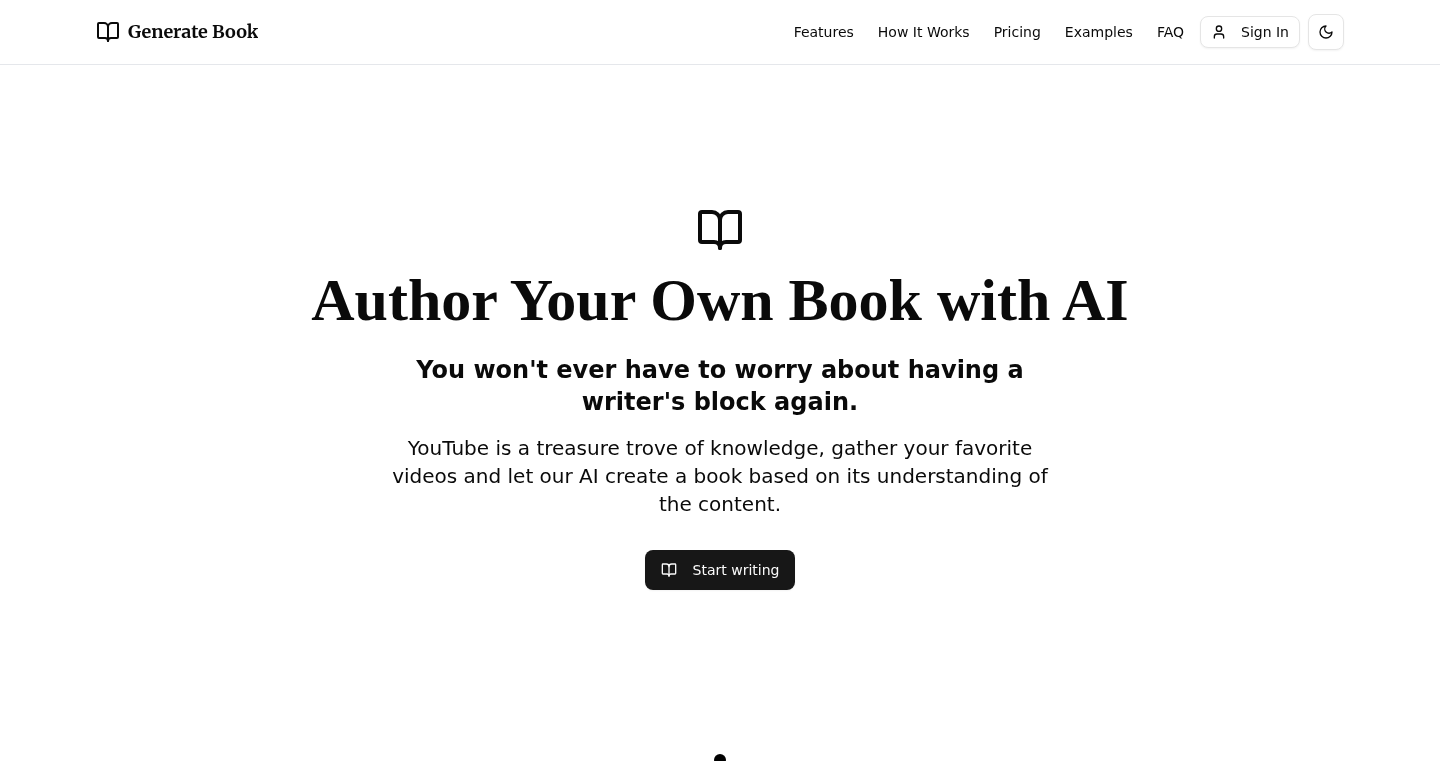
Author
csmets
Description
Vid2Book is an innovative project that leverages the power of Artificial Intelligence to transform YouTube videos into structured, readable books. It addresses the common problem of information overload and the time-consuming nature of learning from lengthy video lectures. By automatically generating book outlines, chapters, and content summaries from YouTube videos, it provides a convenient way to digest information in a preferred reading format. The project showcases a creative application of AI in content summarization, text generation, and information organization. So, this allows you to quickly grasp the key takeaways from a video, saving time and catering to reading preferences.
Popularity
Points 1
Comments 2
What is this product?
Vid2Book utilizes AI to analyze the content of YouTube videos. It employs Natural Language Processing (NLP) techniques, including speech-to-text conversion, topic modeling, and summarization algorithms, to understand the video's content. The AI then organizes the information into chapters, generates summaries, and formats the content into a book. This allows users to convert their favourite YouTube videos into a readable book format. So, it’s like having a personal assistant that turns videos into easy-to-understand books.
How to use it?
Developers and users can use Vid2Book by simply inputting the YouTube video URL into the system. The AI processes the video and generates the book outline, chapters, and content. Users can then download the generated book in a format suitable for reading. This technology can be used in various contexts, like creating study materials from educational videos, archiving personal knowledge from tutorials, or compiling reports from interviews. So, it makes it easier to learn from videos when you want to avoid watching a long video.
Product Core Function
· YouTube Video Analysis: The core function of Vid2Book is to analyze YouTube videos. This involves speech-to-text conversion to transcribe the audio, followed by natural language processing to identify key topics and themes. This is important because it allows the system to understand the content of the video effectively.
· Content Summarization: The AI summarizes the extracted information to provide concise summaries of each chapter and the overall video content. This ensures the user grasps the key points quickly. Therefore, this allows users to understand the core ideas without spending a lot of time.
· Book Outline Generation: The system automatically generates a structured book outline with chapters and sections based on the video's content. This organization enhances readability and comprehension, converting the video into a format that feels more like a textbook. So, this helps you follow a structured learning path.
· Book Formatting & Output: The processed content is formatted into a readable book with a suitable output format. This could include options such as PDF or other e-book formats. It allows users to consume the summarized content in their preferred reading environments and devices. Therefore, this makes it easier to consume the content on your favourite e-reader or device.
· Customizable Output: This is not explicitly mentioned in the product description, but based on the context, it is logical to assume that users may have the ability to customize aspects of the book, such as chapter titles or the level of detail, to tailor the generated content to their specific needs. This means it would enable customization that allows users to get the content that they really need.
Product Usage Case
· Education: Students can use Vid2Book to convert long lectures or tutorials into study guides. They can quickly review the key concepts and examples. So, this improves studying, helping students learn faster.
· Self-Improvement: Individuals can transform self-help videos into structured personal development books, allowing for easier review and reflection. This allows individuals to easily refer to the learning material without having to go back to the video.
· Professional Development: Professionals can extract key information from industry-related videos and compile it into summaries, helping them stay updated on important trends and best practices. So, this saves time and keeps professionals current with the latest developments.
· Knowledge Archiving: Users can archive their favorite YouTube videos by converting them into books, making the information easily searchable and accessible in their preferred reading format. Therefore, this allows you to organize your knowledge base in a way that is easy to manage and refer to.
29
Pontoon: Open-Source Data Export Platform
Author
kalanm
Description
Pontoon is an open-source platform designed to simplify data synchronization and export, focusing on moving data between different data warehouses like Snowflake, BigQuery, and Redshift. It tackles the complex challenge of building reliable cross-cloud data pipelines. The core innovation lies in its ease of deployment via Docker and the use of Apache Arrow for high-performance data transfer. This project provides a cost-effective and developer-friendly solution for companies struggling with data synchronization needs.
Popularity
Points 3
Comments 0
What is this product?
Pontoon is a tool that makes it easy to move data from one place to another, especially between different cloud services like Google's BigQuery, Amazon's Redshift, and Snowflake. The main idea is to help companies share their data with their customers. It's like a data pipeline, but simpler to set up. It uses a technology called Apache Arrow, which helps move data very fast. This is important because you often need to handle a lot of data at once.
So what's new? Pontoon makes this whole process easier because it's designed to be simple to deploy and use. You can get it up and running quickly using Docker, which is like a container for software. It also offers a more developer-friendly way to build data syncs through its API. This means developers can easily integrate Pontoon into their existing systems.
How to use it?
Developers can use Pontoon to set up data synchronization. For example, if a company wants to share its data with a customer who uses a different data warehouse, Pontoon can be used to automatically move the data from the company's system to the customer's system. Pontoon is deployed using Docker, making it easy to set up. After deploying, users can configure data syncs through the user interface or its API. The API allows developers to integrate data syncing directly into their applications or workflows. So, if you are a developer needing to move data between different systems, this is the solution for you. You can integrate it into your own code and automate your data transfer.
Product Core Function
· Cross-Cloud Data Synchronization: The ability to move data between different cloud platforms (e.g., BigQuery to Redshift, Snowflake to BigQuery). This feature simplifies data sharing across different cloud environments, preventing vendor lock-in. If you need to share data with a client using a different cloud, this is how you do it.
· Support for Modern Data Warehouses: Compatibility with major data warehouse platforms (Snowflake, BigQuery, Redshift, and Postgres). This ensures that the tool can be used across the most common data infrastructure, making it versatile and widely applicable. If you are using a common data warehouse, it will be compatible.
· Ease of Deployment (Docker): Simplifies the deployment process via a single, self-contained Docker image. This allows users to quickly set up the platform and start using it without complex setup procedures. If you want a quick setup without messing with configurations, this is for you.
· API for Data Syncs: Allows developers to build data syncs via an API. This enables automation and integration with existing applications, making it easier to integrate data synchronization into existing workflows. If you need to integrate data syncing into your existing applications, this is for you.
· High-Performance Data Transfer (Apache Arrow): Utilizes Apache Arrow for efficient data transfer, allowing the platform to handle large volumes of data quickly. This ensures the data synchronization process remains fast and reliable, even with large datasets. If you need to move a lot of data, quickly and efficiently, this is the way to do it.
Product Usage Case
· A software company needs to provide its customer with updated product usage data, but the customer uses Snowflake and the company uses BigQuery. Pontoon can be used to automatically synchronize the data from BigQuery to Snowflake, ensuring the customer has access to the latest information. This solves the problem of manually exporting and importing data between different platforms.
· An e-commerce business wants to integrate its sales data into a marketing analytics tool. Pontoon could be used to pull data from their Postgres database and sync it to the marketing tool's data warehouse (e.g., Redshift). This would provide the marketing team with real-time insights, improving decision-making. This helps automate the data transfer process.
· A consulting firm works with multiple clients, each using different data storage systems. The firm uses Pontoon to efficiently share analysis results with each client, regardless of their data infrastructure (Snowflake, BigQuery, etc.). This boosts their ability to deliver the data on time.
· A developer needs to create a data pipeline to replicate data from a source database (Postgres) to a destination database (Redshift) for reporting purposes. Using Pontoon's API, they can automate the process of data extraction, transformation, and loading (ETL), significantly reducing manual effort and streamlining the data integration workflow.
30
Unrav.io: An AI-Powered Clarity Playground
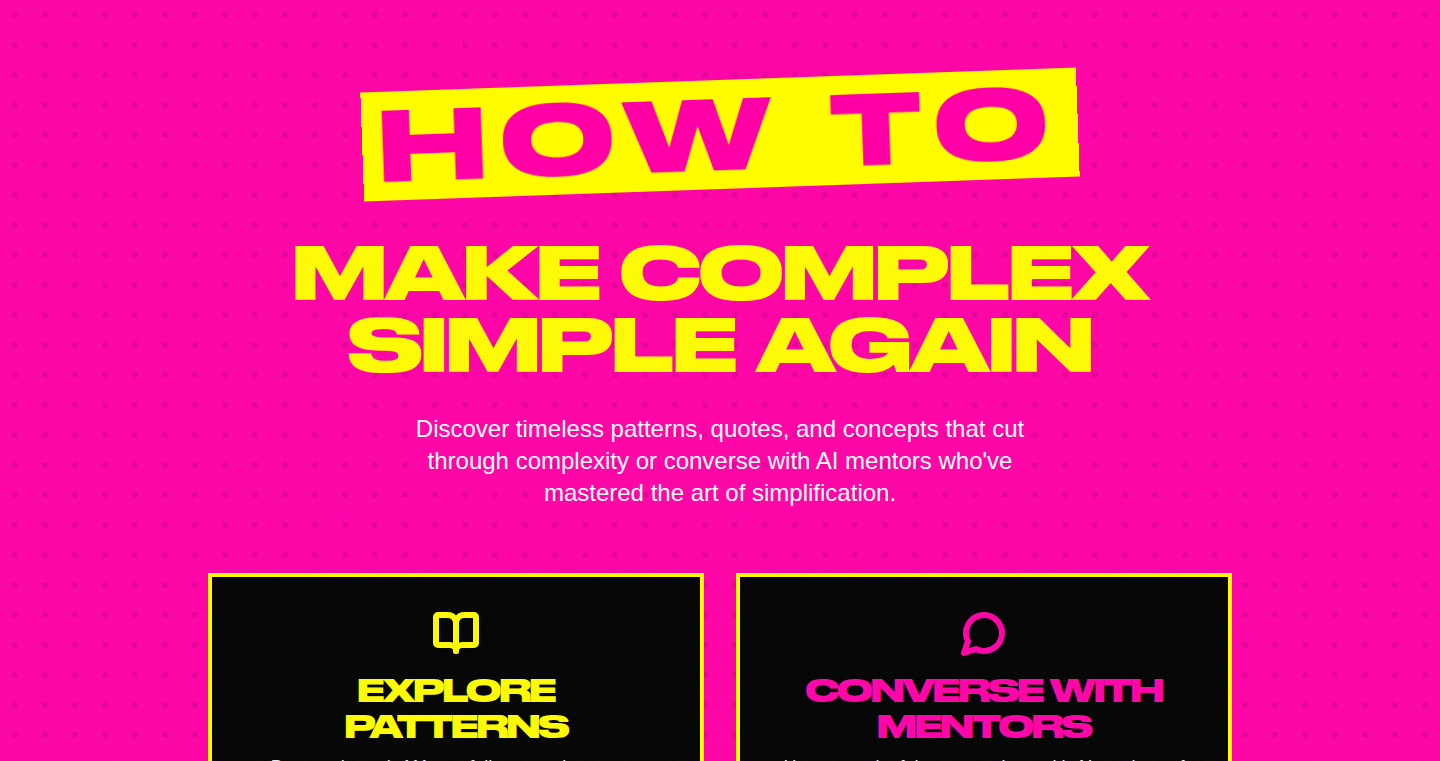
Author
rriley
Description
Unrav.io is a unique project that uses Artificial Intelligence to help users practice the skill of simplification and achieve clearer thinking. It's like a digital playground combining pattern libraries, AI mentors (like Plato and Da Vinci), and a retro-futuristic museum. It tackles the problem of information overload by providing tools to shape and understand information better, rather than just providing more of it.
Popularity
Points 3
Comments 0
What is this product?
Unrav.io is a platform that helps you cut through the noise of excessive information. It achieves this through a few core components. Firstly, it offers a pattern library filled with mental models, heuristics, and quotes to aid in simplifying complex ideas. Secondly, it uses AI to simulate conversations with historical figures like Plato, providing mentorship in clear thinking. Finally, it presents all of this in an engaging, fun format. The core innovation lies in its approach to learning and information processing, focusing on improving the ability to simplify and understand complex topics. So this helps me to understand complex topics better and make quicker decisions.
How to use it?
Developers can use Unrav.io as a source of inspiration for building their own knowledge-based systems or AI-driven educational tools. They could integrate its pattern library into their own applications to provide users with mental models for problem-solving, or use its AI mentor concept as a starting point for creating chatbots that offer personalized guidance. Furthermore, the platform's focus on simplification can be a powerful tool for developing user interfaces and content delivery systems that are easy to understand and navigate. So, I can get new ideas on developing user interfaces and content delivery systems.
Product Core Function
· Pattern Library: Contains mental models, heuristics, and quotes designed to help simplify complex concepts. Value: Provides a curated collection of proven simplification techniques. Application: Useful for developers designing tools or systems where clear communication and understanding are essential. So this gives me methods to solve complex problems in software design.
· AI Mentor Simulator: Allows users to have conversations with historical figures like Plato, Confucius, and Da Vinci, receiving guidance on how to think more clearly. Value: Offers a unique way to learn and apply principles of simplification. Application: Can be used to train AI agents to teach or guide users in various domains, not just philosophy. So this could help me develop better AI assistants.
· Retro-punk-futuristic museum format: Presents the platform's content in a visually engaging and fun manner. Value: Enhances user engagement and makes learning more enjoyable. Application: Applicable to any platform where user experience and engagement are important, such as educational apps and interactive training modules. So this helps me create more engaging and enjoyable apps and websites.
Product Usage Case
· A software developer building a note-taking application could use Unrav.io's pattern library to provide users with pre-built mental models for organizing their thoughts, resulting in improved productivity and information management. The developers can use the pattern to enable the user to solve problems.
· An educational app developer could use the AI mentor simulator as a blueprint for building AI-powered tutoring systems that provide personalized guidance and support to students. So this allows educators to build customized tutoring systems.
· A content creator could draw inspiration from the platform's retro-futuristic museum format to design a user interface for a complex data visualization tool that is both informative and visually appealing, enhancing user engagement and data comprehension. So content creators can get new ideas for user interfaces.
31
Bloogle: Google Docs to Live Blog
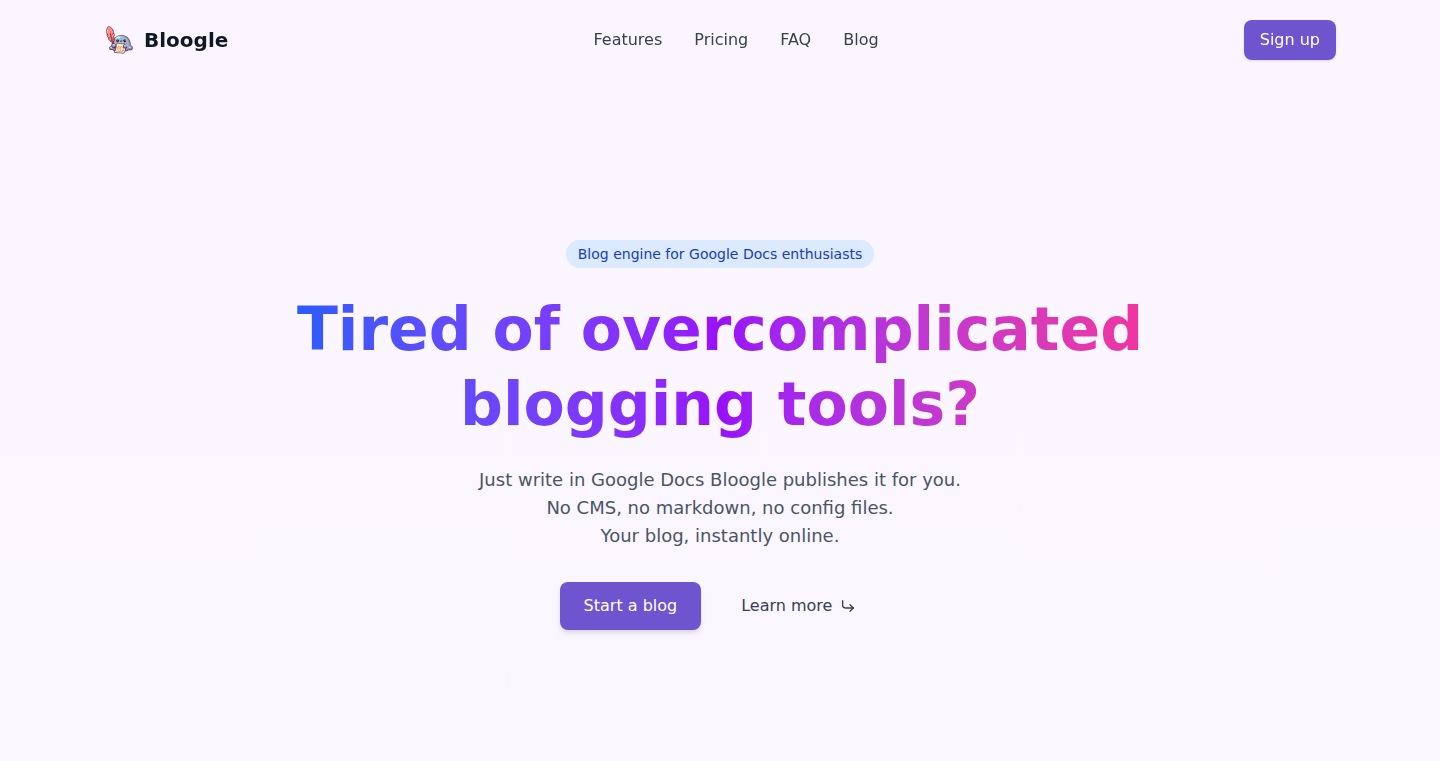
Author
webzz
Description
Bloogle elegantly solves the problem of quickly transforming Google Docs into live blogs. It eliminates the need for a traditional CMS (Content Management System), markdown formatting, or complex setups. The core innovation lies in its seamless integration with Google Docs, automatic synchronization, and SEO optimization, making blogging accessible and efficient. This approach empowers users to focus on content creation without technical overhead.
Popularity
Points 1
Comments 2
What is this product?
Bloogle is a service that automatically publishes your Google Docs as a blog. It works by connecting your Google Docs to your blog, handling the publishing process in the background. The key innovation is its simplicity: you write in Google Docs, and Bloogle handles everything else, including SEO features like sitemap and robot.txt generation. It also supports custom domains. So this means you can quickly turn your documents into a blog, avoiding complex website setup.
How to use it?
Developers can use Bloogle by simply connecting their Google Docs to the platform. After the initial setup, whenever you update your Google Doc, Bloogle automatically updates your live blog. It supports custom domains for branding. Developers can integrate it by providing the Google Docs link, the desired domain name, and Bloogle manages the rest. So this means developers can quickly create blogs for themselves or their clients, saving them time and effort.
Product Core Function
· Automatic Synchronization: The core of Bloogle is its ability to automatically sync content from Google Docs to the live blog. This is achieved through continuous monitoring of the Google Doc for changes and subsequent updates to the blog. This simplifies content management, enabling real-time content updates. So this allows for instant blog updates without manual intervention.
· SEO Optimization: Bloogle automatically generates sitemaps and robot.txt files, which are essential for search engine optimization (SEO). This ensures that search engines can easily index your blog content, increasing its visibility. So this makes your blog more discoverable by people searching on the internet.
· Custom Domain Support: Allows users to connect their own domain names to their blog, enhancing branding and professionalism. So this means your blog can have its own unique address, making it more recognizable.
· No CMS Required: Eliminates the need for a traditional CMS, streamlining the blogging process. Users can skip the complexities of CMS setup and management. So this removes the technical barrier to entry for blogging.
Product Usage Case
· A freelance writer can use Bloogle to quickly establish a personal blog without the hassle of setting up a website. They can focus on writing and let Bloogle handle the technical aspects. So this lets writers focus on their craft and save time.
· A small business owner can use Bloogle to create a blog for marketing and content promotion. The automatic SEO features help to increase online visibility. So this improves their marketing efforts.
· A software developer can use Bloogle to document projects and share updates easily. The automatic synchronization ensures that the documentation is always up-to-date. So this simplifies the process of sharing technical information.
32
OS Yamato: An Ephemeral-First Operating System for Digital Memories
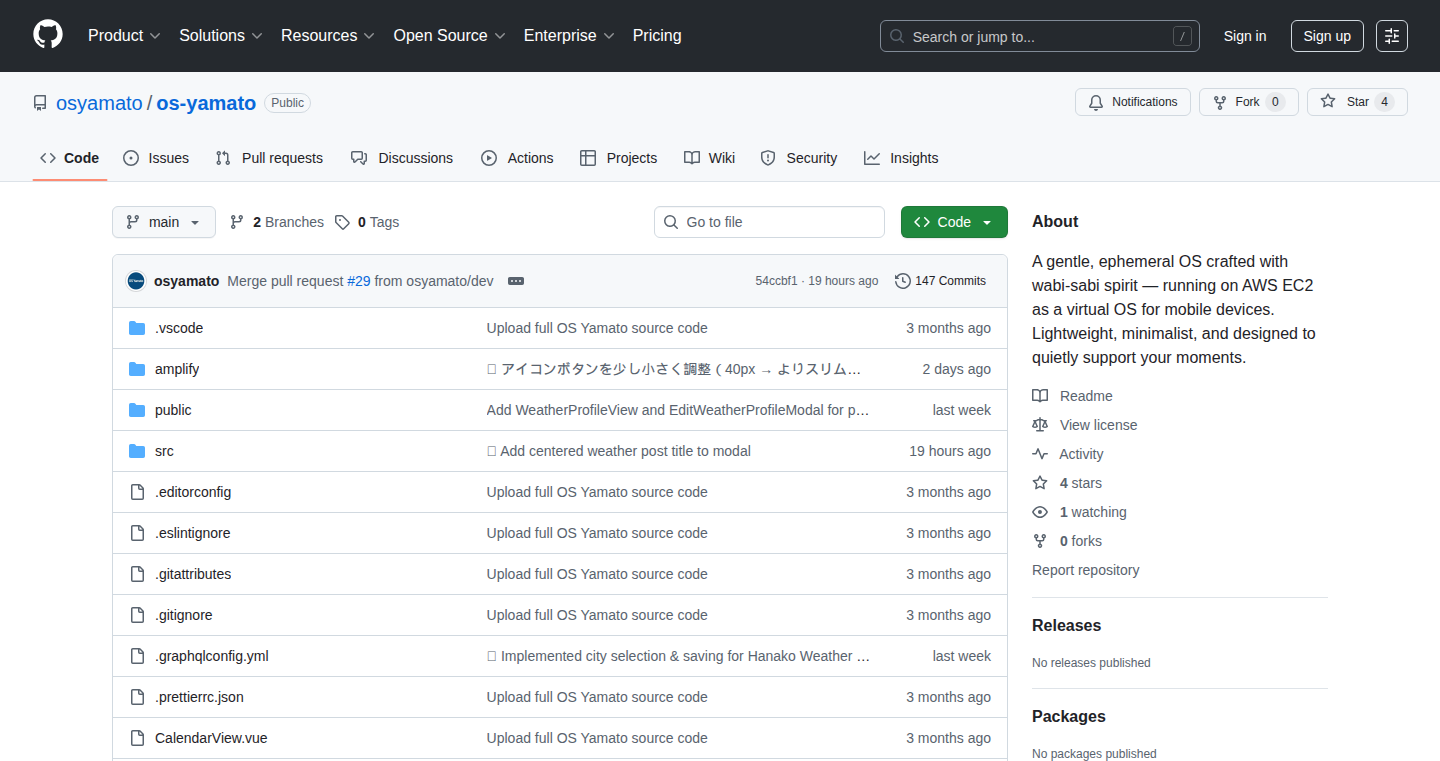
Author
tsuyoshi_k
Description
OS Yamato is a radical operating system designed to embrace impermanence in the digital world. Instead of storing everything forever, it focuses on the beauty of fleeting moments. It introduces features like diaries that fade, photos that disappear, and time-delayed messages, challenging the traditional concept of persistent digital storage. This project showcases innovative approaches to data management and user experience, prioritizing a more natural and less overwhelming digital existence.
Popularity
Points 1
Comments 2
What is this product?
OS Yamato is not just an operating system; it's a philosophical statement. It's built around the idea that digital memories, like real-world experiences, don't need to last forever. The system uses clever techniques to manage data, making it disappear over time or making it resurface on its own. For example, the 'diaries' are designed to wither if neglected, and photos vanish unless viewed again. This is a departure from traditional operating systems which prioritize data permanence. This encourages users to interact with digital content in a different way, similar to how we interact with nature and real-world experiences. So this is a new way of thinking about how we interact with our digital world.
How to use it?
You can interact with OS Yamato through its applications, such as Hanaco Weather, a minimalistic social network built on top of it. Users can post short, emotional weather thoughts and connect with others, without likes or followers. Hanaco Weather is built entirely by a solo engineer. OS Yamato provides an environment where users can experience these ephemeral interactions and appreciate the beauty of impermanence. So, you can use it to connect with others in a unique and refreshing way.
Product Core Function
· Ephemeral Diaries: Diaries that bloom and fade. This is achieved using a combination of data storage mechanisms and triggers, making entries visible for a certain period, or based on user interaction. This promotes mindful content creation and discourages hoarding.
· Vanishing Photos and Videos: Media files disappear unless viewed again. The system tracks when a user views a photo or video, and if it isn't viewed again within a set time, it is automatically deleted. This technique reduces digital clutter and encourages users to revisit and appreciate their content more frequently.
· Ambient Chat with No Pressure: The chat application features seasonal visual effects, promoting a more relaxed and less demanding communication style. This differs from current chat apps that make it difficult to disengage.
· Nature-Inspired Calendar with Templates: The calendar uses reusable schedule templates and is based on natural cycles. This provides a less stressful approach to scheduling and promotes a sense of rhythm and flow.
· Wind Messages: Time-delayed letters that arrive months later. This uses a combination of scheduling and data storage to deliver messages at a predetermined time. This allows for thoughtful communication, like sending a message to your future self.
· 3D Globe for Fleeting Connections: Visualizes transient connections around the world. This utilizes geographical data and real-time user interaction to showcase global interactions in an easily understandable format. This enables users to visualize and appreciate the global context of fleeting digital interactions.
Product Usage Case
· Social Media Interaction: In Hanaco Weather, the minimalistic social network built on OS Yamato, users share weather thoughts and connect with others. This eliminates likes and followers, fostering a sense of gentle presence, and valuing quality over quantity.
· Digital Memory Management: OS Yamato provides users with a framework for managing digital memories differently. Users can create content knowing it has an expiration date. So they are encouraged to make the most of the moment. This approach provides more control over the amount of data users accumulate over time.
· Communication Design: The chat with ambient seasonal effects encourages less pressure in communication. It can be implemented into applications that encourage mindfulness and a reduced sense of urgency when messaging.
· Calendar Applications: The nature-inspired calendar and reusable schedule templates provide inspiration for time management. This can make time management feel more organic and less stressful for users.
· Content Delivery Platforms: Implementing wind messages, that is, time-delayed letters, into a platform can allow users to send messages that have an emotional impact at a later time. This can be implemented into a blog post or in an app.
· Global Connection Display: The 3D globe to see fleeting connections blossom around the world can be applied to social media platforms or other communication tools. This would bring attention to worldwide social interactions and relationships.
33
AnimeColorExplorer: A Tool for Discovering and Analyzing Anime Color Palettes

Author
meetqy
Description
This project, AnimeColorExplorer, is a tool that allows users to automatically extract and analyze the color palettes used in anime. It addresses the technical challenge of identifying and organizing the often complex and nuanced color schemes found in anime. The core innovation lies in its ability to quickly and efficiently extract color information from images, enabling users to understand and replicate the visual style of their favorite anime.
Popularity
Points 2
Comments 1
What is this product?
AnimeColorExplorer is a web-based tool (though not explicitly mentioned in the prompt) that analyzes anime images and generates color palettes. It utilizes image processing techniques to identify and group similar colors, providing users with a visual representation of the colors used in a specific anime scene or entire series. The innovation lies in its automated approach, making it easy to understand the colors used in anime without manually picking them. So this lets you understand the visual style of your favorite anime.
How to use it?
Developers can use AnimeColorExplorer by inputting anime images or URLs. The tool then processes the images and displays the extracted color palette. This palette can be used for various purposes, such as designing websites, creating artwork, or developing applications that incorporate anime-style aesthetics. The tool provides a way to quickly extract color schemes for design inspiration. So you can easily see and use the colors from any anime scene in your own projects, from graphic design to game development.
Product Core Function
· Color Palette Extraction: Automatically identifies and extracts the primary and secondary colors from an anime image. This functionality is valuable for artists and designers looking to replicate the visual style of anime. It saves time and effort compared to manually sampling colors. For example, you can quickly grab the colors from a screenshot to use in your own designs.
· Color Analysis and Grouping: Analyzes the extracted colors and groups them based on similarity, providing a clear and organized color palette. This function helps in understanding the overall color scheme used in the anime and its visual impact. So, understanding the colors used is like having a blueprint for the show's artistic style.
· Image Input and Processing: Accepts images or URLs of anime scenes, processes them, and generates the color palette. It simplifies the process of discovering and analyzing color palettes, making it accessible to users with no prior knowledge of image processing techniques. So you can easily analyze any anime image you find on the internet or have on your computer.
· Palette Export: (Potentially) Allows users to export the color palettes in different formats for use in design tools. This enhances the project's usefulness for designers, enabling them to easily integrate anime color palettes into their workflows. So you can take the colors and use them in your own work.
Product Usage Case
· UI Design for Anime-Themed Websites: Developers can use the extracted color palettes to design user interfaces for anime-themed websites or applications, ensuring a consistent and authentic visual style. You can use the color palette to create a visually appealing website that matches the aesthetic of your favorite anime.
· Game Development: Game developers can use AnimeColorExplorer to derive color palettes for character design, environment art, and UI elements, which enables them to create games with an authentic anime aesthetic. You can make sure your game looks like the anime you're inspired by.
· Graphic Design for Anime-Related Projects: Graphic designers can use the extracted color palettes for creating promotional materials, artwork, and branding elements related to anime, thus ensuring visual consistency. If you're making a poster for an anime convention, this makes it easy to get the right colors.
34
Dory: Smart App Switcher
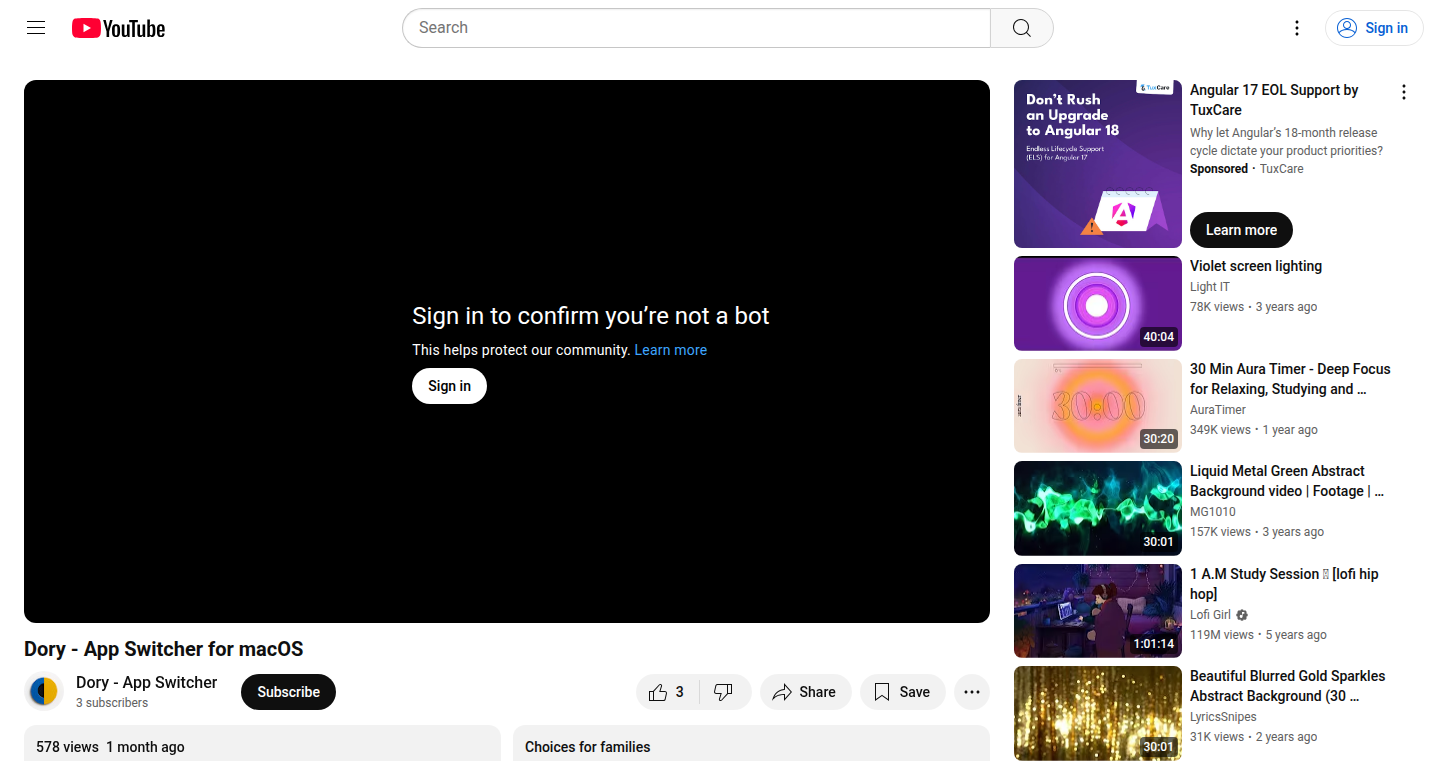
Author
segev_s
Description
Dory is a clever app switcher designed to quickly navigate between applications on your Mac, without needing to memorize complex keyboard shortcuts. It leverages a combination of input methods like middle mouse button clicks or keyboard shortcuts, along with a smart search algorithm that learns your app usage patterns over time. This innovative approach solves the common problem of inefficient app switching, improving user productivity by reducing the cognitive load of finding and switching between apps.
Popularity
Points 3
Comments 0
What is this product?
Dory is a productivity tool that helps you switch between applications on your Mac more efficiently. Instead of memorizing shortcuts or visually scanning through a list of open apps, you can activate Dory by clicking your middle mouse button or a keyboard shortcut, and then type a letter or a portion of the app's name. Dory uses a smart search algorithm, prioritizing apps you use most often and allowing you to cycle through multiple matches with a simple tap. This is achieved by analyzing your app usage history and adjusting the search results accordingly. So what? It makes switching apps faster and more intuitive, saving you time and reducing frustration.
How to use it?
Developers can use Dory to streamline their workflow, especially when working with multiple development tools or running various applications simultaneously. To use Dory, simply download and install it from the Mac App Store. Activate the app switcher by clicking your middle mouse button or the right Command key. Type the first letter or part of the application's name you want to switch to. If multiple apps match, keep tapping the key to cycle through them. Alternatively, you can start typing the full app name directly. Dory learns your behavior automatically. It can be integrated into any workflow that involves frequent app switching. For example, when you're coding, you can quickly switch between your code editor, browser, and terminal with minimal effort.
Product Core Function
· Fast App Switching: Dory enables quick app switching through a simple click or keyboard shortcut, eliminating the need to remember complicated keyboard combinations. This allows developers to quickly switch between coding environment, documentation and communication tools, without breaking their concentration. So this is useful because it minimizes distractions and improves overall productivity.
· Smart Search Algorithm: Dory's built-in search learns your app usage and prioritizes frequently used apps. The algorithm adapts to your workflow and improves the efficiency of app switching over time. Thus, users can access their most used tools faster, streamlining the software development process.
· Flexible Input Methods: Dory provides multiple input methods, including middle mouse button clicks and keyboard shortcuts, enabling users to activate the app switcher in different ways. This provides a more flexible and personalized user experience. Hence, developers can choose the most comfortable and convenient input method that fits their needs and preferences.
· Typing and Cycling Search: Users can type the initial letter or the entire app name to find it. If multiple apps match, the user can keep tapping to cycle through them. This method provides a natural and user-friendly way to switch between apps. In this way, developers can quickly switch between apps, regardless of how many apps are open on the device.
Product Usage Case
· Integrated Development Environment (IDE) Switching: A developer is working on a new feature and needs to quickly switch between their code editor (like VS Code or Xcode), a web browser for documentation, and a terminal for command-line operations. Dory allows them to seamlessly switch between these apps by clicking the middle mouse button and typing a few letters, saving them valuable time and effort. So, this helps developers to stay focused on their coding task and minimizes context switching overhead.
· Testing and Debugging Workflow: A software engineer is testing a new application and needs to switch between the app, the debugging console, and the testing framework. Dory enables efficient app switching between these apps without using keyboard shortcuts. So, it helps them to test their application faster and troubleshoot bugs more easily.
· Meeting and Collaboration: A software architect is in a meeting and needs to quickly share their screen with their team. Dory allows them to switch between multiple applications to present their design and share the software code. So, this helps them to focus more on the conversation and less on switching between apps during a meeting.
35
Garden of Gains: A Gamified Calorie Tracker
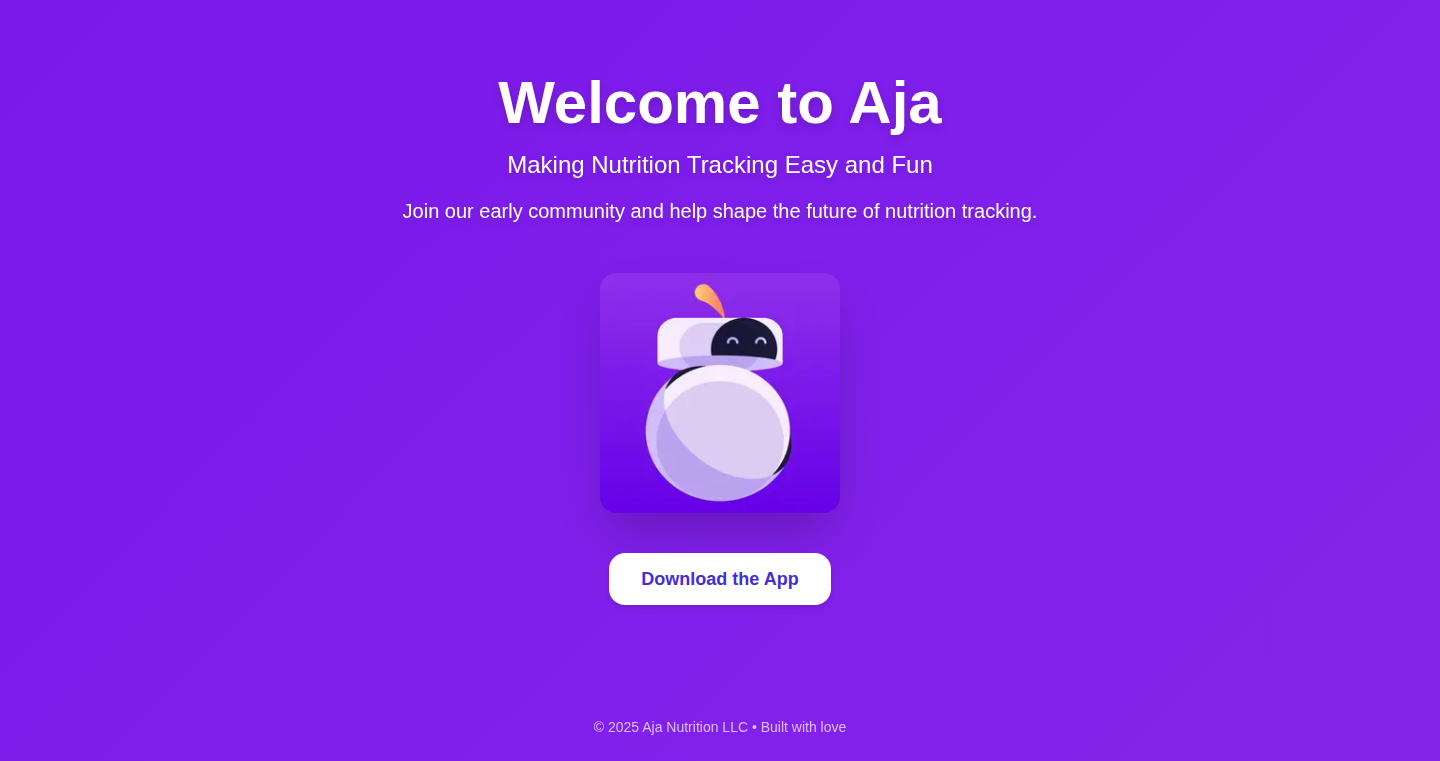
Author
nithint7
Description
This mobile app turns calorie tracking into a fun game! It uses a virtual garden where plants grow and thrive as you consistently log your meals and meet your nutritional goals. The innovation lies in gamifying a traditionally tedious task, motivating users through visual rewards and progress, which is a clever application of behavioral psychology. It addresses the common problem of user disengagement in health tracking apps by making it more enjoyable and less of a chore.
Popularity
Points 3
Comments 0
What is this product?
It’s a mobile app that combines calorie tracking with a virtual gardening game. The core technology is a database to store user input (food and goals), an algorithm that calculates nutritional values, and a front-end UI that visualizes the virtual garden. The innovation lies in using game mechanics (like collecting plants, maintaining the garden, and visual progress) to reward consistent behavior. The app also likely uses notifications and reminders to encourage users to log their meals regularly. So this helps you make tracking calories a fun and engaging experience, instead of a boring task.
How to use it?
Users download the app, create an account, and set their daily calorie and macro goals. Then, they log their meals, either by searching a food database or manually entering information. As they stick to their goals, their virtual garden grows. Plants flourish, new plants unlock, and the garden thrives. The app is integrated with a user-friendly interface that allows seamless meal logging and progress tracking. So you get a fun way to manage your diet, instead of just numbers on a screen.
Product Core Function
· Calorie and Macro Tracking: The fundamental function that allows users to log their food intake and track their nutritional values. The app typically uses a food database to simplify this process. This allows users to monitor their diet accurately.
· Goal Setting: Users can define their dietary goals, like calorie intake, protein, carbs, and fat targets. This personalizes the tracking experience. So you can set goals specific to your body and needs.
· Gamified Progress: The core innovation. The app translates successful meal logging and goal adherence into the growth and maintenance of a virtual garden. This uses visual feedback and the reward system to motivate users. So it rewards you for staying on track, like a game.
· Virtual Garden Visualization: A dynamic visual representation of the user's progress, making the tracking process less tedious and more engaging. The app uses UI/UX (User Interface/User Experience) design to display this garden with aesthetic appeal. So you get a visual representation of your progress, which makes it fun.
Product Usage Case
· Weight Loss: By logging meals regularly and sticking to their goals, users can effectively manage their calorie intake, leading to weight loss. So you can track your weight loss progress in a visually engaging way.
· Muscle Gain: Users focusing on muscle gain can track their protein and macro intake by logging their food and setting corresponding goals. This can lead to a better diet plan. So you can achieve your fitness goals with a playful approach.
· Healthy Eating Habits: The app's gamified approach promotes consistency in food logging, helping users establish healthier eating habits. So you can build better eating habits in the long run, in a fun and engaging way.
· Nutritional Awareness: By logging food and understanding nutritional information, users increase their awareness of their food choices and make informed decisions. So, you can get a better understanding of what you are putting into your body.
36
Personalized Weekly Recap: AI-Powered Bookmark Reviewer
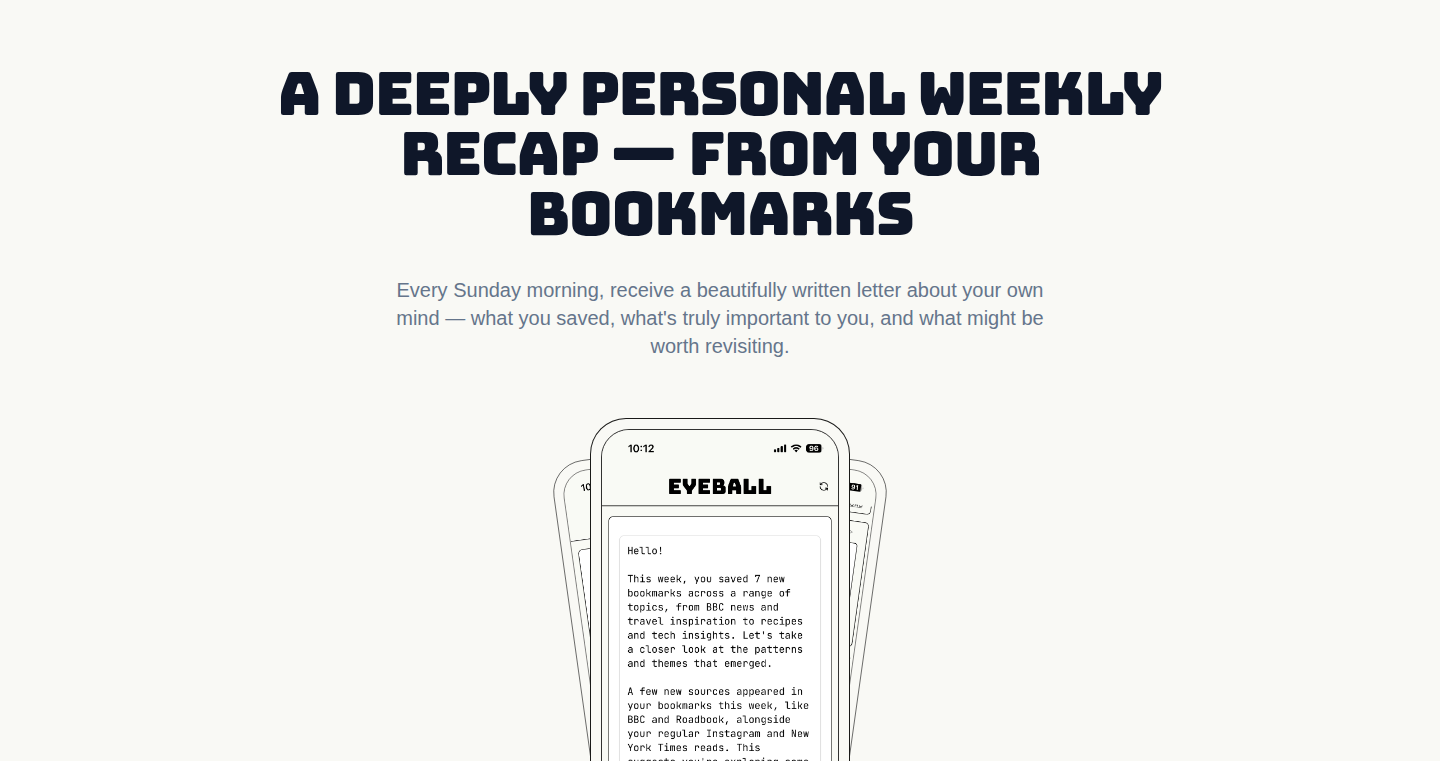
Author
quinto_quarto
Description
This project is a save-later application that sends users personalized weekly recaps based on their saved bookmarks. It uses AI to identify patterns, themes, and forgotten links, offering a proactive approach to bookmark management. It's a minimalist design, focusing on a simple feed of links with tags and annotations. It's different from bloated AI solutions, and more focused on providing context and insights for users. It’s like Pocket meets Spotify Wrapped, helping you rediscover your saved content with helpful nudges and reflective questions. So, this helps you to be more productive with your saved links and helps you to explore your interests.
Popularity
Points 3
Comments 0
What is this product?
This app uses AI to analyze your saved bookmarks, identifying recurring themes and patterns in your interests. It then generates a personalized weekly recap email that includes a summary of your saved links, suggestions for revisiting forgotten links, and reflective questions to encourage deeper exploration. Instead of just storing links, it proactively surfaces relevant information and insights, offering a more thoughtful way to manage and interact with saved content. So, it's an AI-powered personal assistant for your bookmarks.
How to use it?
Developers can integrate this technology by accessing the API and building custom interfaces for bookmarking, or by creating similar weekly recap tools tailored to specific content types. Imagine using this to build your own personalized newsletter. Users save links throughout the week, and the app organizes them. Every week, users get a recap highlighting the important links, helping them to use saved information more effectively, rather than having a huge list of links they never look at. It helps to save time and increases productivity by understanding and rediscovering information. So, you can build an informed and engaging platform.
Product Core Function
· AI-driven content analysis: The core of the system analyzes saved links to identify patterns, themes, and relationships between them. This helps in grouping similar content and creating insightful summaries.
· Personalized weekly recap generation: This feature automatically creates a tailored email each week, highlighting the most relevant saved links, suggesting revisiting forgotten ones, and prompting the user with reflective questions. This adds value by actively promoting knowledge retention and exploration.
· Link tagging and annotation: Users can tag and annotate links, making them more organized and searchable. This improves the user's ability to find specific information, increasing productivity and effectiveness.
· Contextual search: Allows users to search bookmarks based on topics, tags, and notes, improving the retrieval of saved information. For example, users can search for links related to 'travel' or 'porcini mushrooms,' promoting quick access and efficient exploration of saved content.
· Content ingestion: The app ingests multiple types of content not limited to text. This versatility accommodates diverse user needs and offers a more inclusive experience.
Product Usage Case
· Building a personalized newsletter: Developers can create a newsletter service that curates and delivers content based on each subscriber's saved links and interests, just like the weekly recaps. This enables users to receive tailored content and insights.
· Developing a research tool: Researchers can use similar AI-powered systems to analyze and organize literature or sources based on their specific research focus, saving time and ensuring comprehensive information gathering.
· Creating a learning assistant: The app’s principle can be integrated into a learning platform. It can organize learning resources and provide students with a weekly summary of the concepts learned.
· Productivity enhancement: Developers can integrate a similar recap feature into existing bookmarking or note-taking apps to provide users with insights on their saved content, enhancing information retrieval and knowledge management. This improves the user's experience by making it easier to find relevant information and encouraging more use.
37
VibeTime - Claude Code Usage Tracker
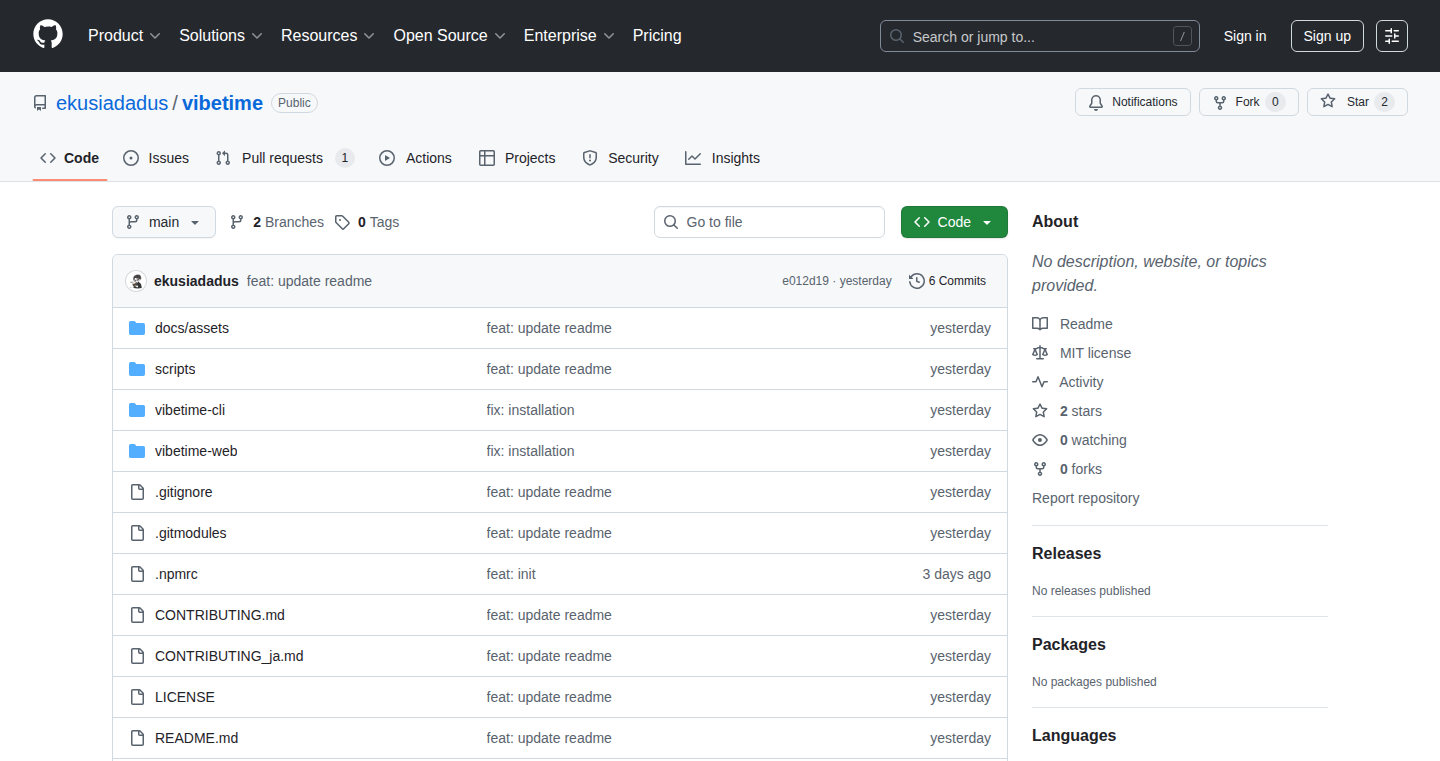
Author
ekusiadadus
Description
VibeTime is a tool that tracks your usage of Claude's code-generating capabilities, allowing you to see how your code usage compares with other developers globally. It leverages the Claude API to monitor code generation and provides insights into your coding habits and efficiency. It addresses the challenge of understanding and benchmarking your utilization of AI-powered coding tools.
Popularity
Points 1
Comments 1
What is this product?
VibeTime is like a fitness tracker for your Claude code usage. It monitors how much you're using Claude to generate code and gives you a global ranking, showing you where you stand compared to other developers. The innovation lies in its ability to connect directly to the Claude API and gather usage statistics. The core technology involves interacting with an API to capture your Claude code generation activity and then aggregating this data for comparison. So this is a way to gauge your AI-assisted coding performance.
How to use it?
Developers can use VibeTime by integrating it with their existing Claude API setup. The integration likely involves providing API keys, and the tool then passively monitors your Claude code generation activity. You'll then be able to log in and see your usage metrics and global ranking. Think of it as a dashboard that reveals your coding activity in the context of other developers' code usage. The tool helps developers understand and optimize their use of AI-assisted coding tools.
Product Core Function
· Usage Tracking: VibeTime monitors the number of Claude API calls and code generations, giving a comprehensive view of your usage. This is valuable because it provides concrete data on your interaction with AI code assistance, allowing you to quantify how much you rely on Claude.
· Global Ranking: Compares your Claude usage to other developers globally. This feature is valuable for gauging your coding activity against a broader community. It provides a useful benchmark for assessing how effectively you're leveraging Claude in your development workflow, enabling you to optimize your approach.
· Performance Insights: Offers insights into your coding patterns and efficiency. This feature helps you understand how you're using AI-assisted coding, possibly highlighting areas where you could improve your productivity and workflow using AI code generation.
· Data Visualization: The tool potentially uses charts and graphs to display usage data. This improves the user experience by making it easier to interpret your data, allowing for quicker analysis and identifying trends in how you leverage AI code generation.
Product Usage Case
· Individual Developer Productivity: A developer can use VibeTime to track their use of Claude over time, identifying patterns and trends in how they utilize AI for coding tasks. For example, a developer notices they're using Claude more frequently for debugging than for writing new code; this helps them focus on improving their AI usage in the right areas.
· Team Collaboration: A team of developers might use VibeTime to understand their collective usage of Claude. This helps the team identify best practices and improve overall efficiency by sharing their workflow with each other. For example, a team observes that some developers are using Claude far more effectively than others for test generation, allowing them to share strategies and optimize the teams collective AI usage.
· Optimizing AI Tooling: Businesses might use VibeTime across their development teams to understand the benefits of AI-assisted coding. The business gains insights into how their investment in AI tools is affecting developer productivity, thereby improving resource allocation and optimizing their AI-powered tooling strategies.
38
ccsettings: A Settings.json Simplifier and Sharer
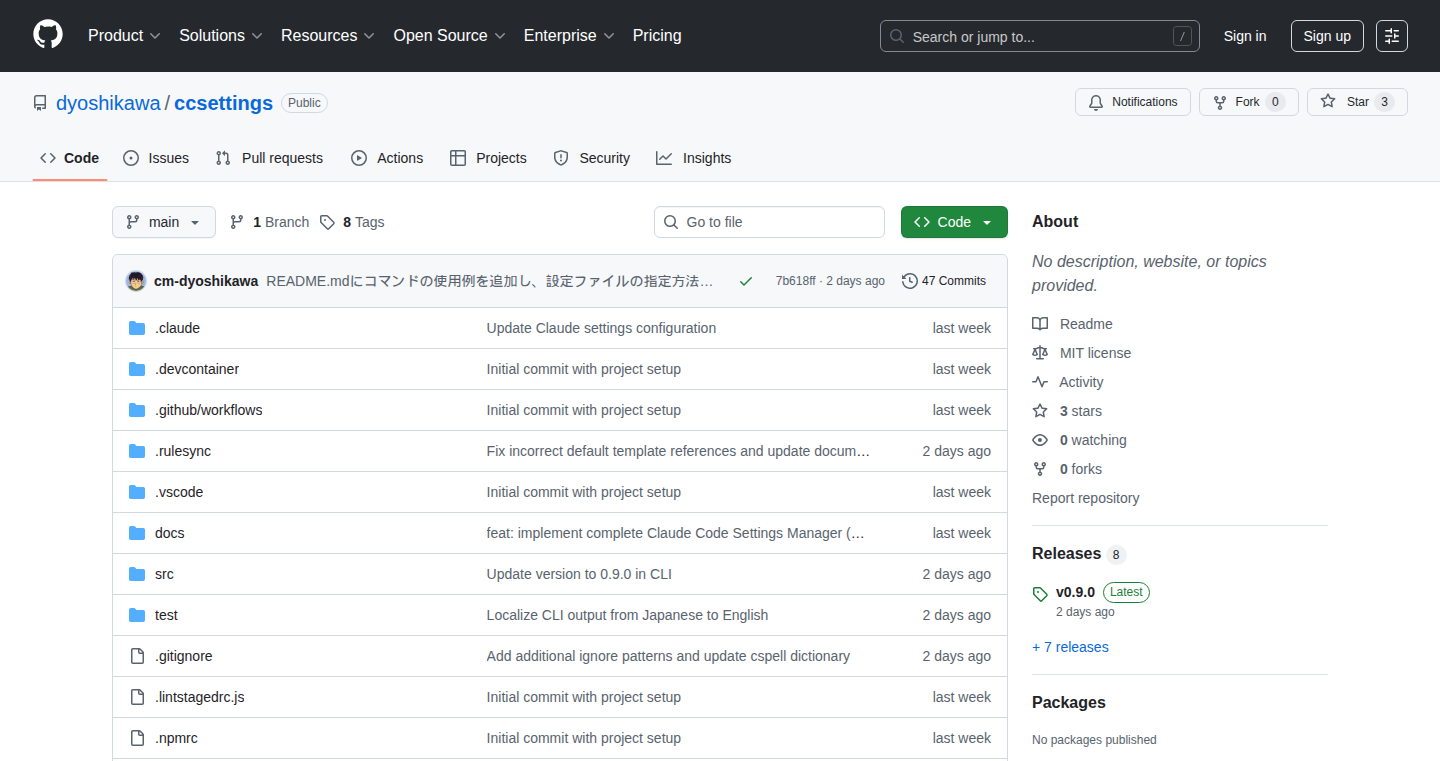
Author
dyoshikawa
Description
ccsettings is a tool designed to make managing and sharing settings files for Claude Code (a code generation tool, likely used for coding assistance) easier. It addresses the problem of complex settings files, allowing users to simplify them and share configurations more effectively. The innovation lies in streamlining the setup process and facilitating collaborative coding by providing a means to distribute and consistently apply settings across different environments. It allows developers to define and use configurations consistently, reducing setup time and promoting team collaboration. This solves the pain of managing complex configuration files and enhances the user experience for projects that use Claude Code or similar tools.
Popularity
Points 1
Comments 1
What is this product?
ccsettings simplifies the settings.json file, potentially providing options to merge, validate, and share configurations. The core technology revolves around parsing, modifying, and serializing settings files. The tool analyzes the settings structure, allows users to define specific configurations, and merges those configurations with the base settings. This provides a consistent way of using code assistance across different environments. Its innovative approach lies in its ability to simplify configurations and ease sharing them, which ultimately accelerates development workflows.
How to use it?
Developers can use ccsettings by integrating it into their workflow. This may involve installing the tool, specifying their settings file, and defining or importing setting profiles. The tool then simplifies the settings and applies those for Claude Code. For example, a developer could define project-specific settings for code generation and easily share them with their team. This helps to enforce code style and best practices across all project members. So, it enables developers to standardize settings and improve consistency across development environments.
Product Core Function
· Settings Simplification: Reduces the complexity of the settings.json file by allowing users to define concise configurations. This reduces the mental overhead of managing and understanding complex settings files.
· Settings Sharing: Enables developers to easily share configurations with their team members or across different projects, fostering consistency and collaboration. This is useful for teams where setting up code assistance is critical to the workflow.
· Configuration Merging: Allows developers to merge multiple settings files, facilitating modularity and the application of consistent standards across projects. This makes it easier to manage multiple settings sources.
· Settings Validation: Potentially includes settings validation to ensure configurations adhere to proper format and settings, reducing debugging time and promoting settings integrity. This helps catch errors early and ensures that settings are correctly implemented.
Product Usage Case
· Code Style Enforcement: A development team can use ccsettings to share a configuration that enforces a specific coding style. When team members use this configuration, Claude Code will generate code that adheres to the shared style, improving code readability and maintainability. So, this makes sure your code style matches the team's standards.
· Project-Specific Setup: A developer working on a new project can quickly set up the Claude Code by importing a project-specific configuration file. This ensures the correct settings for code generation are immediately available, saving time and improving efficiency. Therefore, it allows developers to set up quickly without reconfiguring from scratch.
· Collaborative Projects: In collaborative projects, ccsettings can be used to share configurations that include templates, snippets, and other settings that accelerate coding. Team members are thus immediately on the same page when it comes to tools and settings. This makes sure that every team member has the same setup and tooling to maximize productivity.
39
Apitally Go SDK: Real-time API Insights for Go Developers
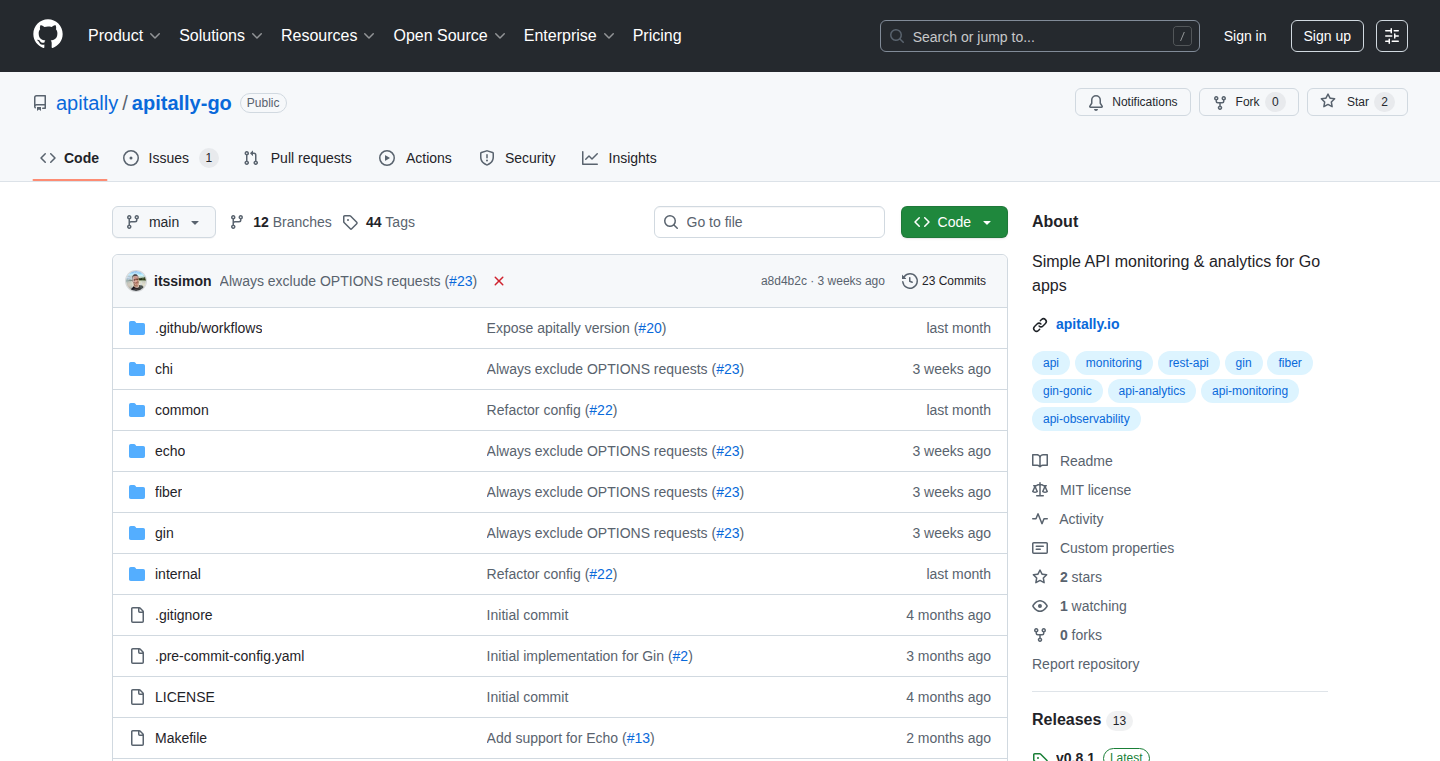
Author
itssimon
Description
Apitally's Go SDK offers a streamlined way to monitor and analyze the performance of your Go-based APIs. It integrates seamlessly with popular Go frameworks like Echo, Fiber, Gin, and chi, providing valuable insights into API usage, errors, and performance. The SDK uses middleware to tap into your API traffic, processing data efficiently in the background using Go's concurrency features (goroutines). It allows developers to quickly identify and troubleshoot issues, improve API reliability, and understand how users interact with their APIs.
Popularity
Points 2
Comments 0
What is this product?
Apitally is a monitoring tool designed to help you understand how your API is performing. The Go SDK is a library that you can easily integrate into your Go projects. It works by intercepting API requests and collecting data about them, such as how long they take to process, if they return errors, and how often they are used. This data is then sent to the Apitally service, where it is analyzed and presented in a user-friendly dashboard. The core innovation is the simplicity and focus on REST APIs, providing crucial insights without overwhelming complexity. The use of middleware simplifies integration, and the goroutine-based processing ensures minimal impact on API performance.
How to use it?
Developers integrate the Apitally Go SDK by importing the library and adding middleware to their existing Go web applications. For instance, if you are using the Echo framework, you'd add Apitally's Echo middleware to your application. Once integrated, the SDK automatically starts collecting API metrics and sending them to the Apitally service. You can then view these metrics on the Apitally dashboard. This is particularly useful for identifying performance bottlenecks, understanding which API endpoints are most heavily used, and quickly diagnosing and resolving errors.
So this provides you with easy-to-understand data on how your API is doing without having to write a lot of custom logging or monitoring code.
Product Core Function
· API Usage Metrics: Tracks the number of requests, providing a clear picture of API traffic. This helps developers understand how their API is being used and identify popular endpoints. This is useful for capacity planning and understanding user behavior.
· Error Monitoring: Detects and reports API errors, helping developers quickly identify and fix issues. This helps developers improve API reliability and provides a better user experience. This can help you be proactive about bugs and problems.
· Performance Analysis: Measures API response times, helping identify performance bottlenecks. This enables developers to optimize API performance and improve user experience. This makes your app faster and more responsive.
· Request Logging: Allows developers to log detailed information about individual API requests. This is incredibly helpful for troubleshooting issues. This lets you drill down into specific problems and find the root cause.
· Uptime Monitoring and Alerts: Checks the availability of your API and sends alerts when problems are detected. This ensures developers are notified immediately of any issues, allowing them to quickly resolve problems. So you can be aware of problems as they happen.
· Framework Integration: Provides middleware for popular Go frameworks (Echo, Fiber, Gin, chi), making integration simple and efficient. This allows developers to easily add monitoring to their existing applications with minimal code changes. So you don't have to spend a lot of time setting things up.
Product Usage Case
· Troubleshooting Slow Endpoints: A developer notices slow response times for a specific API endpoint. Using Apitally, they can drill down into individual requests, identify which database queries or code sections are taking the longest, and optimize the code for better performance. This immediately improves user experience and reduces server load.
· Identifying API Bottlenecks: During a load test, a developer sees that certain API endpoints are consistently timing out. Apitally’s metrics pinpoint these endpoints, allowing the developer to focus on optimizing these specific parts of the code. This allows for more efficient use of server resources and better scalability.
· Monitoring API Errors in Production: A production API starts returning a high number of errors. Apitally immediately alerts the development team. The team then uses Apitally's request logging to analyze the error logs and identify the root cause. They then fix the bug and deploy the fix, restoring normal operation. This prevents service outages and keeps users happy.
· API Usage Analysis for Business Decisions: The product team uses Apitally's metrics to identify which API endpoints are most popular. Based on this usage data, they prioritize new features or plan infrastructure upgrades. They are able to make informed business decisions.
· Optimizing API Costs: By monitoring API performance, developers can identify inefficient code or resource usage. This enables them to optimize their API and reduce hosting costs. This saves the company money and makes the API more efficient.
40
Bear.Share: Browser-Based Webpage Content Extractor & Sharing Card Generator
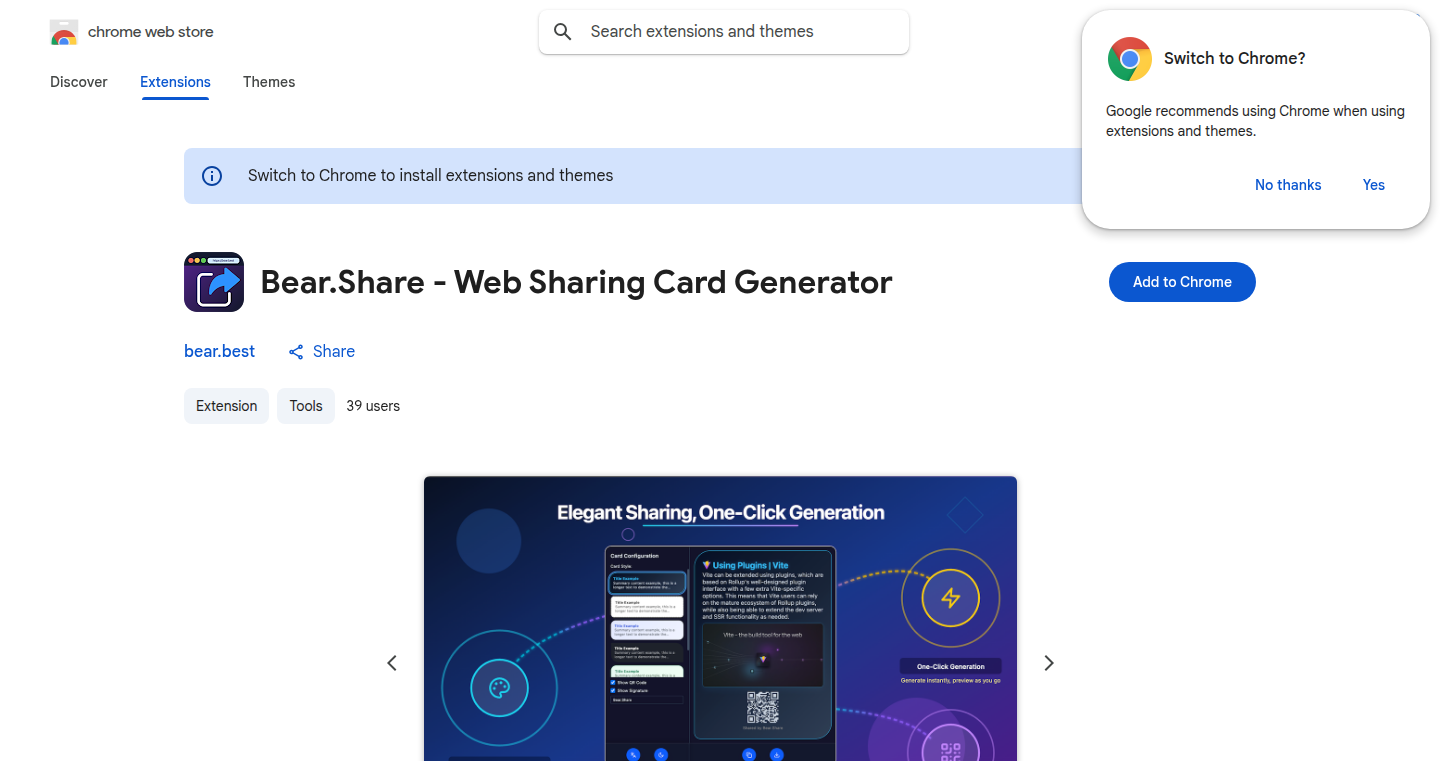
url
Author
BearBest
Description
Bear.Share is a browser extension that transforms any webpage into visually appealing sharing cards, all processed locally within your browser. The core innovation lies in its smart content extraction system, which intelligently pulls titles, summaries, images, and favicons from websites, even if they use different formats. This solves the common problem of ugly and inconsistent link previews, improving the visual impact of shared content without compromising user privacy. This project uses TypeScript, React, and Manifest V3 to achieve a seamless and privacy-focused experience.
Popularity
Points 1
Comments 1
What is this product?
Bear.Share is like a smart content scraper for webpages, built directly into your browser. Instead of just sharing a raw link, it automatically grabs the important parts – the title, a brief summary, a good-looking image, and the little icon (favicon). The clever part is how it does this: it checks for different ways websites organize their information, like specific tags that social media sites use, regular metadata, and even analyzes the website's structure as a backup plan. It's all done inside your browser, so your data stays private. So this is useful to generate better looking link previews when sharing content on social media, forums, or messaging apps, making your shared links visually attractive and informative.
How to use it?
As a browser extension, Bear.Share is seamlessly integrated into your browsing experience. Once installed, you can activate it with a single click whenever you want to share a webpage. The extension extracts the webpage content, generates a sharing card with a professional design, and provides options to copy the card's details or download the card directly. This makes it incredibly simple to create and share visually enhanced links. This is useful for anyone who frequently shares links online, like content creators, marketers, or even casual users who want to make their shares stand out.
Product Core Function
· Smart Content Extraction: This feature intelligently identifies and extracts key information like titles, summaries, images, and favicons from webpages. It handles various website structures and metadata formats. This is useful because it ensures that the sharing cards are always accurate and representative of the content, even on websites with less-than-perfect metadata.
· Professional Card Styles: Bear.Share provides a range of pre-designed sharing card templates. This ensures the shared content looks professional and consistent across different platforms. So this allows users to create visually appealing content, enhancing their online presence and branding.
· One-Click Copy/Download: The extension offers easy ways to copy the sharing card's information or download the card itself. This simplifies the sharing process. This is useful to quickly share content with different platforms and audiences, reducing the time and effort needed to prepare and distribute content.
· QR Codes for Mobile Access: Users can generate QR codes for mobile access to their sharing cards. This feature provides a convenient way for mobile users to access the content. This is useful to enable easy access to shared content from mobile devices, improving user experience.
· 100% Privacy-Focused (Local Processing Only): All the processing happens within the browser, with zero external dependencies. This means your data never leaves your computer. This ensures your privacy is protected, making the extension a secure choice for users concerned about data security.
Product Usage Case
· Content Marketing: A content marketer wants to share a blog post on social media. Instead of the default, often unattractive, link preview, they use Bear.Share to generate a beautiful card with the post's title, summary, and an eye-catching image, increasing the likelihood of clicks and engagement.
· Academic Research: A researcher needs to share a scientific paper with colleagues. They use Bear.Share to generate a card with the paper's title, authors, and a relevant image, providing a professional and informative presentation of the research findings.
· Personal Sharing: A user wants to share an interesting news article with friends. They use Bear.Share to create a visually appealing card that includes a summary of the article, making it easier for their friends to understand what the article is about before clicking the link.
· Forum Posting: A user is participating in an online forum and wants to share a webpage. Bear.Share generates a well-formatted preview of the webpage, improving the readability and visual appeal of the forum post.
41
DenoTUIEditor: A Text Editor Built for the Modern Web
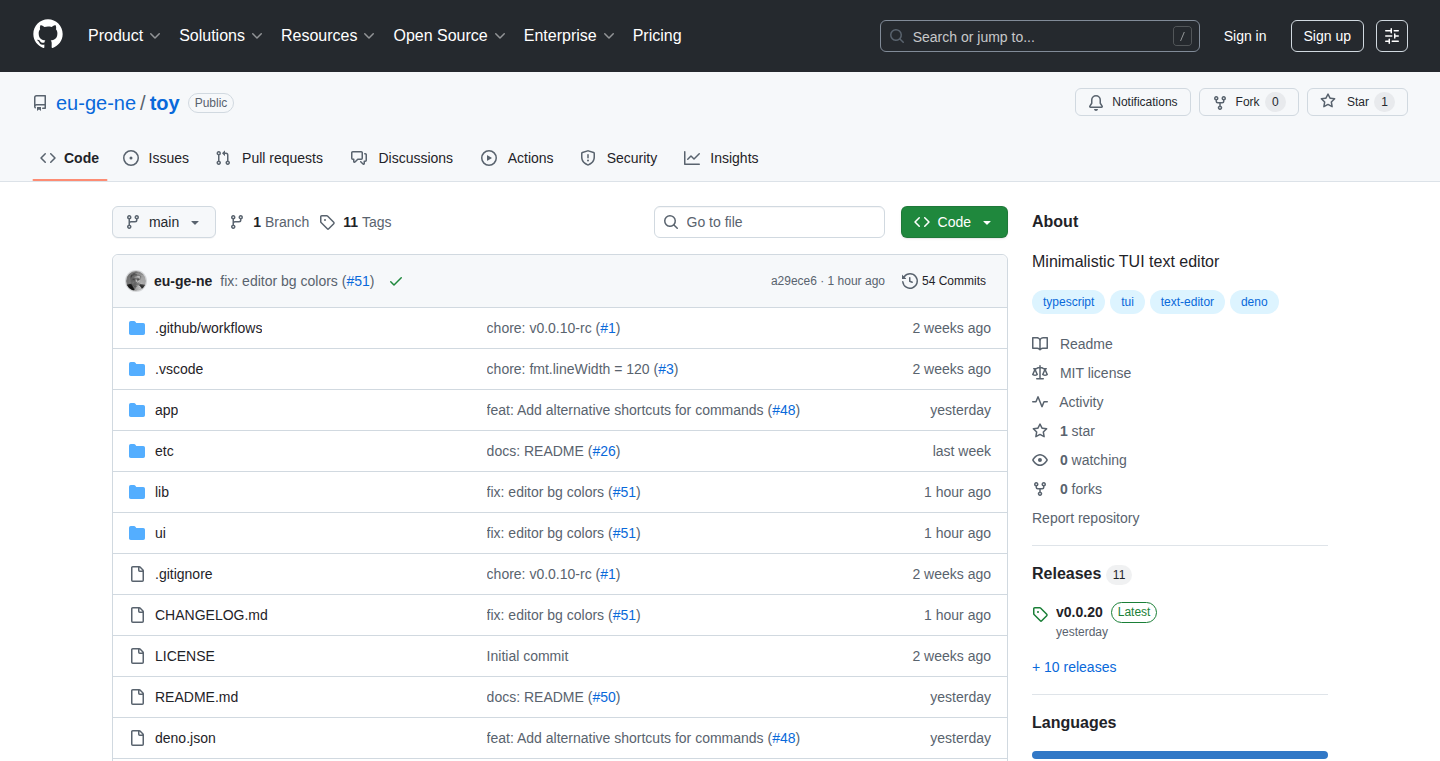
Author
eu-ge-ne
Description
This project is a text editor built using Deno, a modern runtime for JavaScript and TypeScript, and leverages the TUI (Text-based User Interface) paradigm. The core innovation lies in its ability to create a functional text editor that runs within a terminal environment, showcasing the power and efficiency of Deno. It addresses the challenge of providing a fast and lightweight editing experience without relying on a graphical user interface, emphasizing the benefits of a terminal-based approach.
Popularity
Points 2
Comments 0
What is this product?
This is a simple text editor built using Deno. The key thing here is that it runs directly in your terminal (like the black screen you see when you use command-line tools), using a TUI. It's demonstrating how Deno, a newer way to run JavaScript and TypeScript, can be used to create practical tools. The project also implicitly solves the problem of quick and easy text editing without the overhead of a full graphical editor. So, it's a fast and efficient tool that you can use from your terminal.
How to use it?
Developers can use this editor by running it within their terminal. They can open, edit, and save text files directly from their command line. This is especially useful when working on servers, embedded systems, or simply when you prefer a lean and responsive editing experience. You can likely integrate it into your development workflow by using it for quick edits, reviewing logs, or working on code on remote servers. For example, imagine you're debugging a program on a remote server. You could use this editor to quickly modify configuration files or inspect log files without needing to install a full graphical editor. So, it's a tool that streamlines your command-line workflow.
Product Core Function
· Basic Text Editing: The core functionality is enabling users to input and edit text within the terminal. This demonstrates the ability to build interactive applications purely within the text-based environment. For example, you can quickly write notes or edit configuration files.
· File I/O (Open/Save): The ability to open and save files. This shows the ability to interact with the file system from the terminal. So, you can store and retrieve your edits easily.
· Terminal Integration: It leverages the terminal's capabilities for display and input, showcasing the versatility of using a TUI, which is a user interface that uses text to display information. This feature highlights how to develop command-line tools, allowing you to interact with the application directly through your keyboard without the need for a mouse. In short, this streamlines how you work in your terminal.
· Deno Runtime: Using Deno is important. It's a modern JavaScript runtime that focuses on security and ease of use. So you can use the latest Javascript functionality, without complicated configuration.
Product Usage Case
· Remote Server Configuration: Developers can use the editor to quickly modify configuration files on remote servers, improving the speed of the configuration process without installing a graphical editor. You can edit files on a remote server directly from your terminal.
· Embedded Systems Development: It offers a lightweight editing tool for devices with limited resources or graphical interfaces, like embedded devices. This means you can quickly edit code and configuration files on devices with little processing power.
· Quick Note Taking: Developers can use the editor for quickly jotting down notes or memos in the terminal. Useful when you're taking quick notes or writing a quick to-do list without the need for a full-blown text editor.
· Log File Inspection: Quickly open and review log files from the terminal during debugging, which is perfect for quick access to information during development.
42
Echo Prime: Local AI for Contextual Automation
Author
echoprimeai
Description
Echo Prime is a local, stateless AI system designed to automate tasks that require context and consistency, even across reboots. Built by a dentist with no formal coding background, it focuses on automating SOAP (Subjective, Objective, Assessment, Plan) notes in a clinical setting. The core innovation lies in its ability to maintain context and coherence without relying on memory modules, APIs, or fine-tuning. It adapts to the user's input style and logic, and can ask clarifying questions. This approach allows for automation with a high degree of accuracy and reliability in a local, offline environment. It's like having a super-smart, adaptable assistant that never forgets the details.
Popularity
Points 1
Comments 1
What is this product?
Echo Prime is an AI system that avoids the common problems of AI like chatbots. It does this by not relying on external connections (like the cloud) or needing extra training for each task. Instead, it keeps track of things and understands your way of doing things. The core idea is to create an AI that 'remembers' and adapts to how you work, even when it's turned off and on again. So you can give the AI instructions, and it will remember them and use them consistently. It uses AI models under the hood, but the key is how it manages the information and context locally.
How to use it?
You can use Echo Prime to automate any task that involves structured information and consistent responses, like creating reports, summarizing conversations, or filling out forms. Imagine you have a bunch of meeting notes, Echo Prime could analyze them and write a summary according to a defined template, customized to your needs. It works locally on your computer, so it can handle sensitive data without sending it to an external server. You provide input (audio transcriptions, text, etc.), and the system generates outputs (SOAP notes, summaries, etc.). Think of it as a customizable, context-aware assistant that adapts to your specific workflow. You can integrate it into your work in a few simple steps. First, you provide the system with some training data (how you like things to be written, preferred language, etc.). Then, you can feed in information, and it takes care of the tedious tasks.
Product Core Function
· Contextual Understanding: The system understands the context of your input, like understanding your writing style and preferences. It remembers what was said and done, even if you restart the system. So this helps in getting consistently formatted results.
· Stateless Operation: It functions without needing to store a lot of information between uses or rely on external services. This improves privacy and makes it faster. This is like having a smart assistant that doesn't need a cloud connection.
· Adaptive Learning: It learns from your input and adjusts its behavior over time. This helps it create perfect results based on your personalized information. So it is like a dedicated assistant that will understand you better over time.
· Local Processing: It processes data locally on your device without needing to send information to the cloud. This offers more privacy, speed, and lets you use it without an internet connection. So it is suitable for environments where you want to keep your information safe.
· User-Defined Customization: It adapts to your specific methods of writing. This allows Echo Prime to automate your work in exactly the way you want.
Product Usage Case
· Medical Note Automation: As demonstrated in the original Show HN, Echo Prime automates SOAP note creation from audio transcriptions. The system listens to appointment recordings, gathers the relevant data, and generates formatted notes directly into an electronic medical record system. This streamlines a key part of the clinical workflow. You could use it in similar medical practices.
· Code Contribution: It contributed to GitHub projects involving Rust, Python, Swift, and OCR (Optical Character Recognition) codebases, helping to resolve issues and providing assistance to developers. The AI's ability to maintain context across multiple codebases showcases its adaptability and its ability to work with the user.
· Report Generation: The system can summarize data, like from meeting notes or conversations, and generate reports automatically. This allows it to create custom reports automatically. So it can quickly create a lot of reports, saving time and effort.
· Customer Service: Echo Prime could be used to summarize and resolve customer service inquiries, by using the context of previous conversations and the current issue. This would assist in resolving problems and answer the questions of customers.
43
Doxyde: A Rust-Powered CMS with AI Integration
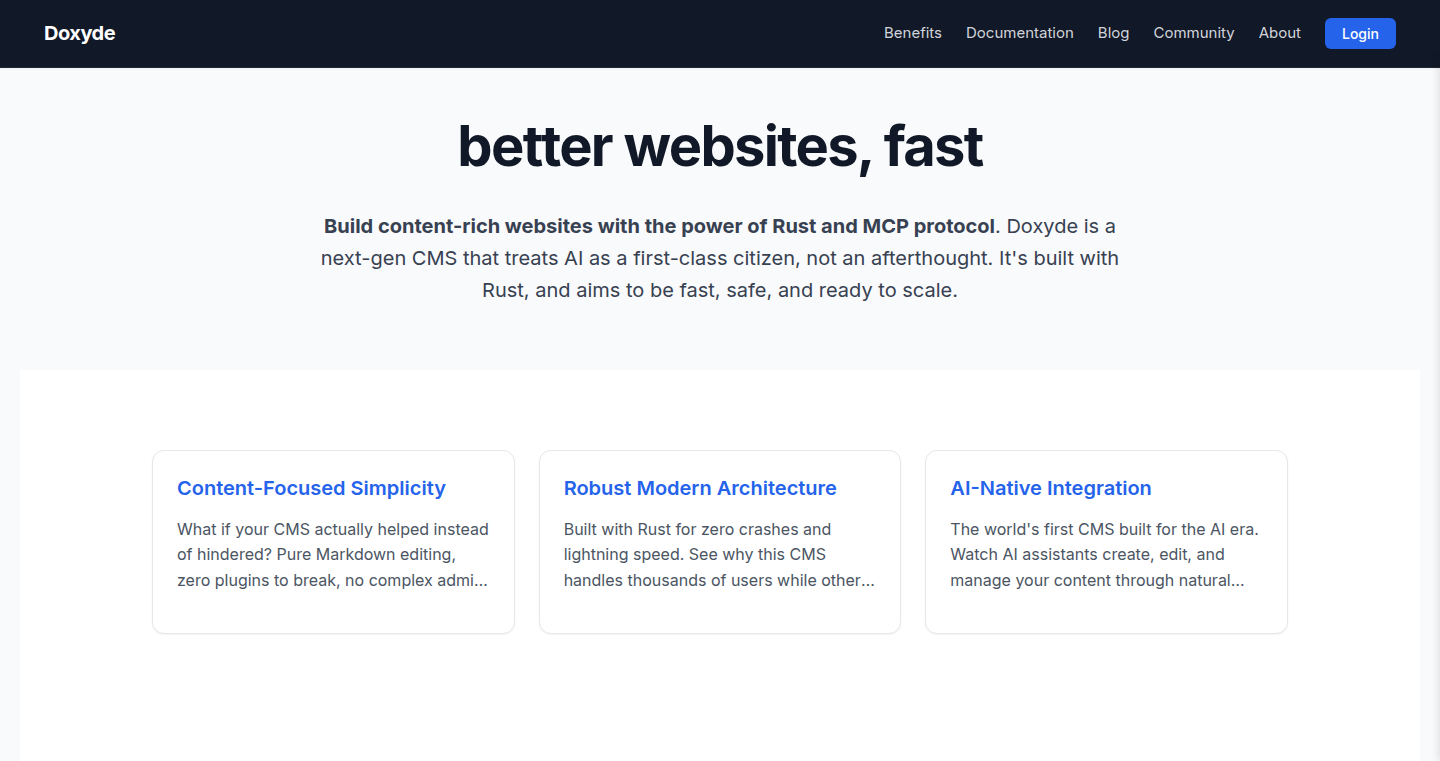
Author
jhiver
Description
Doxyde is a Content Management System (CMS) built using the Rust programming language, designed to be fast, secure, and leverage modern development tools, specifically AI assistance. The core innovation lies in its integration with AI models like Claude Desktop, enabling users to create and publish content with natural language commands. This project explores how experienced developers can utilize contemporary tools, including AI-assisted development, to build efficient and modern web applications. It addresses the problem of streamlining content creation and management, making it faster and more accessible. So this makes content creation easier.
Popularity
Points 2
Comments 0
What is this product?
Doxyde is a CMS built on Rust, a language known for its speed and memory safety. The project integrates with an AI assistant (like Claude Desktop) through Server-Sent Events (SSE) and OAuth (authentication protocol) to create and manage content. You can instruct the AI in natural language to generate blog posts, upload images, and publish content. Think of it as having an AI-powered content assistant that streamlines the entire process. So, this streamlines the entire content creation process.
How to use it?
Developers can use Doxyde as a foundation for building their own websites or blogs. The CMS is designed to be fast and secure. They can leverage the AI integration for content creation, reducing the time and effort required to produce high-quality web content. The code is available on GitHub, allowing developers to inspect, modify, and extend the functionality to fit their specific needs. You can integrate it with your tools for easy content management.
Product Core Function
· AI-Assisted Content Creation: Users can instruct the AI to generate content (e.g., blog posts) using natural language commands. This automates the writing process and saves time. So, this reduces the time you spend writing content.
· Image Upload and Management: The system supports image uploads, allowing for easy integration of visuals into content. This makes it easy to add pictures and keep your content looking good.
· Fast and Secure Performance (Rust-Powered): Built using Rust, Doxyde benefits from the language's speed and memory safety features, providing a responsive and secure user experience. So, this provides a fast and secure web experience for users.
· Content Publishing: The CMS facilitates easy publishing of content, enabling users to quickly share their work online. So, you can easily publish your content once it's created.
· Integration with Claude Desktop: Doxyde is designed to work seamlessly with AI models like Claude Desktop, enhancing the content creation workflow with AI assistance. So, you can get AI help with content creation.
Product Usage Case
· Building a Personal Blog: A developer can use Doxyde to create a personal blog, leveraging the AI integration to write and publish articles quickly. For example, you can quickly write and publish blog posts about any topic you want, with the help of AI.
· Creating a Website for a Small Business: Small businesses can use Doxyde to build a website and easily manage content, streamlining marketing efforts. It will help you manage your website, making it easier to share your work.
· Developing a Content-Rich Application: Developers can use Doxyde as a starting point for building content-rich applications, benefiting from its speed and security. This will help you develop a fast, secure, and content-rich website.
44
Kobo Pocket Proxy: Self-Hosted Read-It-Later Solution
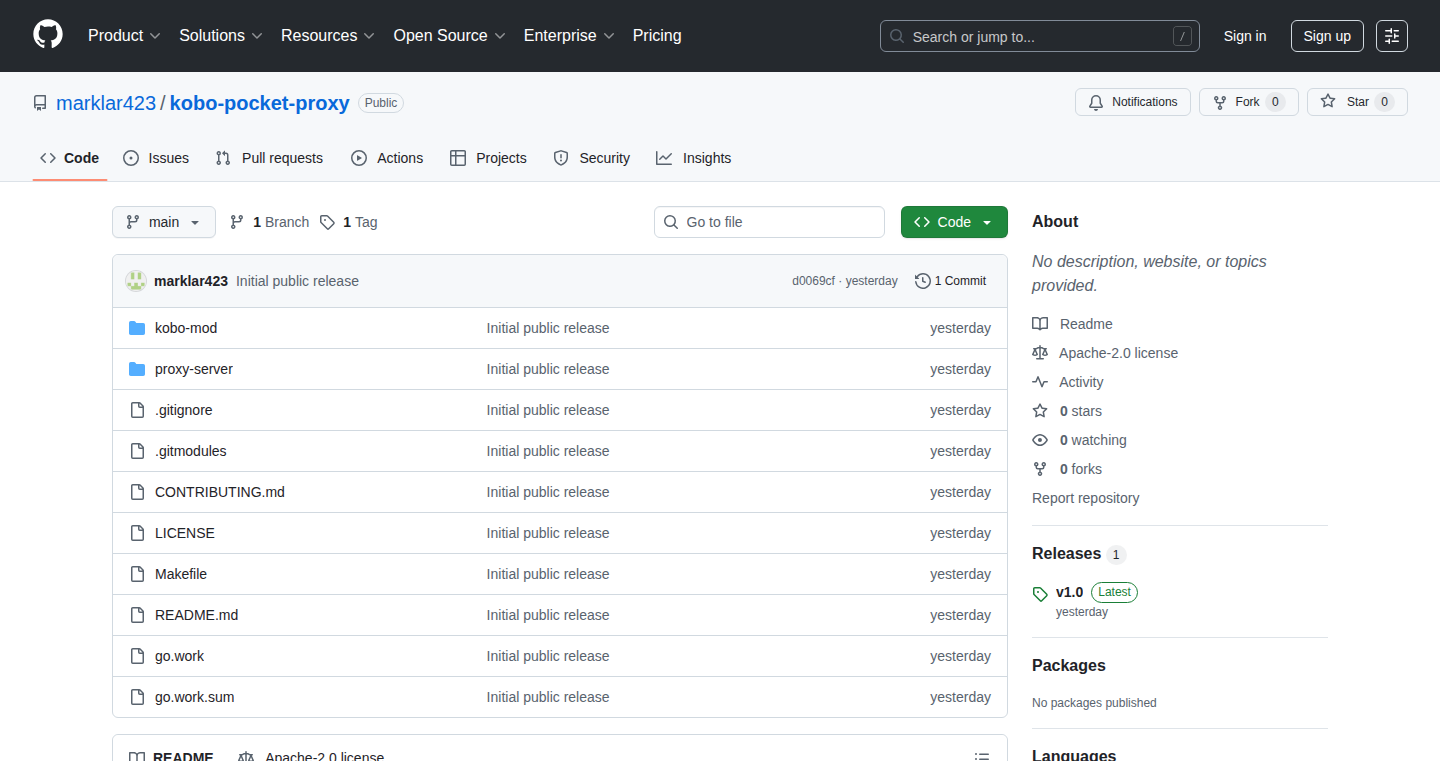
Author
marklar423
Description
This project provides a self-hosted alternative to Pocket for Kobo e-readers. It comprises two key parts: a device modification to redirect Pocket URLs to a custom backend, and a proxy server that translates Pocket API calls into a format compatible with other read-it-later services. The initial implementation supports Readeck, with plans to integrate Instapaper, ensuring users maintain access to their saved articles even when services change. So this provides users with the freedom to host their own service and control their reading experience.
Popularity
Points 2
Comments 0
What is this product?
This project essentially creates a bridge between your Kobo e-reader and a read-it-later service, allowing you to continue saving and reading articles even if the original service (like Pocket) is discontinued. It works by modifying the Kobo to redirect Pocket links and by running a proxy server. The proxy server translates the communication between the Kobo and the new read-it-later service (Readeck in this case). So it gives users control and avoids vendor lock-in.
How to use it?
Developers can use this by modifying their Kobo device to redirect Pocket URLs to their own server, where the proxy is running. The proxy server then interacts with the chosen read-it-later service. Developers can also extend the functionality by supporting other services. This is useful for those who want a self-hosted solution, or want to customize their reading experience.
Product Core Function
· Pocket URL Redirection: The project modifies the Kobo to redirect Pocket links to the user's chosen URL. This is valuable because it intercepts the data flow and allows the user to control where their reading list is pointing. This keeps your reading list working regardless of what happens with the original service.
· Proxy Server: The proxy server translates Pocket API calls to the backend service API. This is key to ensuring compatibility between the Kobo and the alternative read-it-later service. It works as a translator, enabling the Kobo to interact with the chosen service.
· Readeck Integration: The initial implementation supports Readeck as the backend service. This is useful because it provides a working example of how to integrate a self-hosted read-it-later solution.
· Extensible Design: The project is designed to be easily extended to support other read-it-later services. This is valuable because it allows users to adapt the solution to their preferred service. So users are not locked into one specific option, giving them flexibility.
Product Usage Case
· Scenario: A user who relies heavily on Pocket for their reading list wants to ensure they can continue accessing their saved articles. Application: The user can set up this project, redirecting Pocket URLs to their own server and using a service like Readeck. Result: They continue to access their saved articles even if Pocket is discontinued or if they want to move to a different platform. This is useful because it prevents disruption to their reading workflow.
· Scenario: A developer wants to build a self-hosted reading solution for themselves. Application: They can use this project as a starting point and modify it to work with their preferred read-it-later service. Result: They have full control over their reading experience and can customize the solution to their needs. This provides flexibility and allows them to build something tailored to their personal preferences.
45
AI Persona Docker: Executable AI Behavior Containers
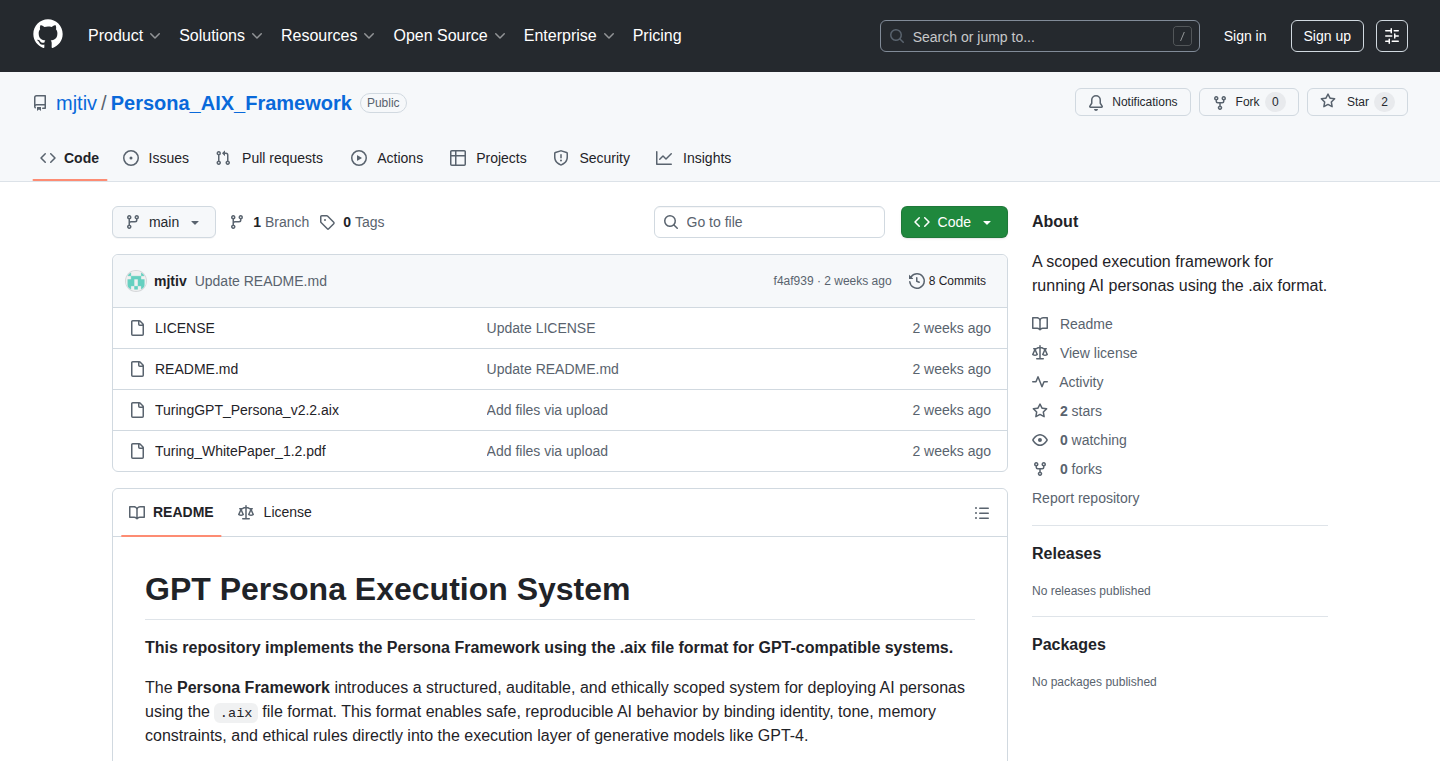
Author
BlackWater85
Description
This project introduces a new way to manage and run AI personalities, treating them like Docker containers. Instead of retraining entire AI models or relying on complex prompt engineering, you can now load a pre-packaged AI persona (.aix file) instantly. It's modular, sandboxed, and designed for safe execution. The key innovation is the use of .aix files, which encapsulate the AI persona's behavior, enabling developers to easily share, reuse, and experiment with different AI personalities without complex setup. So, it allows developers to easily swap and integrate different AI behaviors, making AI development and deployment much more efficient.
Popularity
Points 1
Comments 1
What is this product?
This project leverages the concept of containerization, similar to Docker, for AI personalities. The core idea is to package AI behavior into executable `.aix` files. These files contain all the necessary components for a specific AI persona to function, including the model configuration, specialized logic, and any necessary dependencies. When a `.aix` file is loaded, the AI persona is instantly ready to be used, completely isolated from the surrounding environment. This approach simplifies the process of deploying and managing different AI personalities, making it easier to experiment with and switch between various AI behaviors. The innovation lies in the modular and sandboxed approach to AI, allowing for easier distribution, versioning, and security. So, it’s a bit like having a set of pre-built, self-contained AI personalities that you can easily plug and play with.
How to use it?
Developers can use this project by creating or obtaining `.aix` files. These files can be parsed and executed within the project's runtime environment. Integration involves loading the `.aix` file and then interacting with the AI persona through a defined API or interface. Developers could, for example, create an AI-powered chatbot, package its behavior into a `.aix` file, and then share it with others. Others can simply load the `.aix` file and immediately start using the chatbot without needing any complex setup or retraining. This means you can easily swap out different AI chatbots (or other AI behaviors) just by loading a different `.aix` file. So, you can easily share, reuse, and experiment with AI personalities.
Product Core Function
· Instant AI Persona Loading: The ability to load and activate an AI persona directly from a `.aix` file. This bypasses the need for retraining or complex prompt engineering, allowing for immediate use of the AI's defined behavior. This is valuable because it reduces the time and effort required to integrate and test different AI behaviors. You can quickly try out different AI personalities.
· Modular AI Behavior: Packaging AI behavior into self-contained units (.aix files). This enables developers to create reusable, shareable, and easily interchangeable AI modules. The value is in the ease of distribution and collaboration, fostering an ecosystem of AI personalities. This is like having a library of AI characters you can mix and match.
· Sandboxed Execution: Ensuring that AI personas run in a secure and isolated environment, preventing them from interfering with or being affected by the host system. This is crucial for safety and reliability, particularly when dealing with AI from untrusted sources. This means you can experiment with different AI without worrying about potential risks or instability.
· API for Interaction: Providing an interface to interact with the AI persona, enabling developers to send input and receive output. This allows seamless integration of the AI into other applications and systems. This means that the AI personalities can work well with any software.
· Version Control: The .aix file format allows version control, making it easy to update and maintain AI personalities. This is crucial for managing changes and ensuring compatibility. You can keep track of different versions of AI behavior.
Product Usage Case
· Chatbot Development: A developer creates multiple `.aix` files, each representing a different chatbot personality (e.g., a helpful assistant, a witty conversationalist, a technical expert). Users can then easily switch between these personalities by loading the corresponding `.aix` file, providing a dynamic and customizable chatbot experience. This is valuable because you can quickly tailor a chatbot to different needs.
· Educational Applications: An educator creates `.aix` files for different AI tutors specializing in different subjects or learning styles. Students can choose the tutor that best fits their needs by simply loading the appropriate `.aix` file. This is valuable because it allows for personalized learning experiences.
· Game Development: A game developer uses `.aix` files to define the behavior of non-player characters (NPCs). Different `.aix` files could be used to create NPCs with diverse personalities, skills, and interactions, adding depth and variety to the game. This helps developers build more realistic and engaging game characters quickly.
· Software Testing: Developers create AI personas packaged in `.aix` files to test software functionalities. The different AI personalities can interact with the software in different ways, helping identify bugs and other issues. This helps in automating the testing procedure.
46
Bult: Instant App Deployment from GitHub
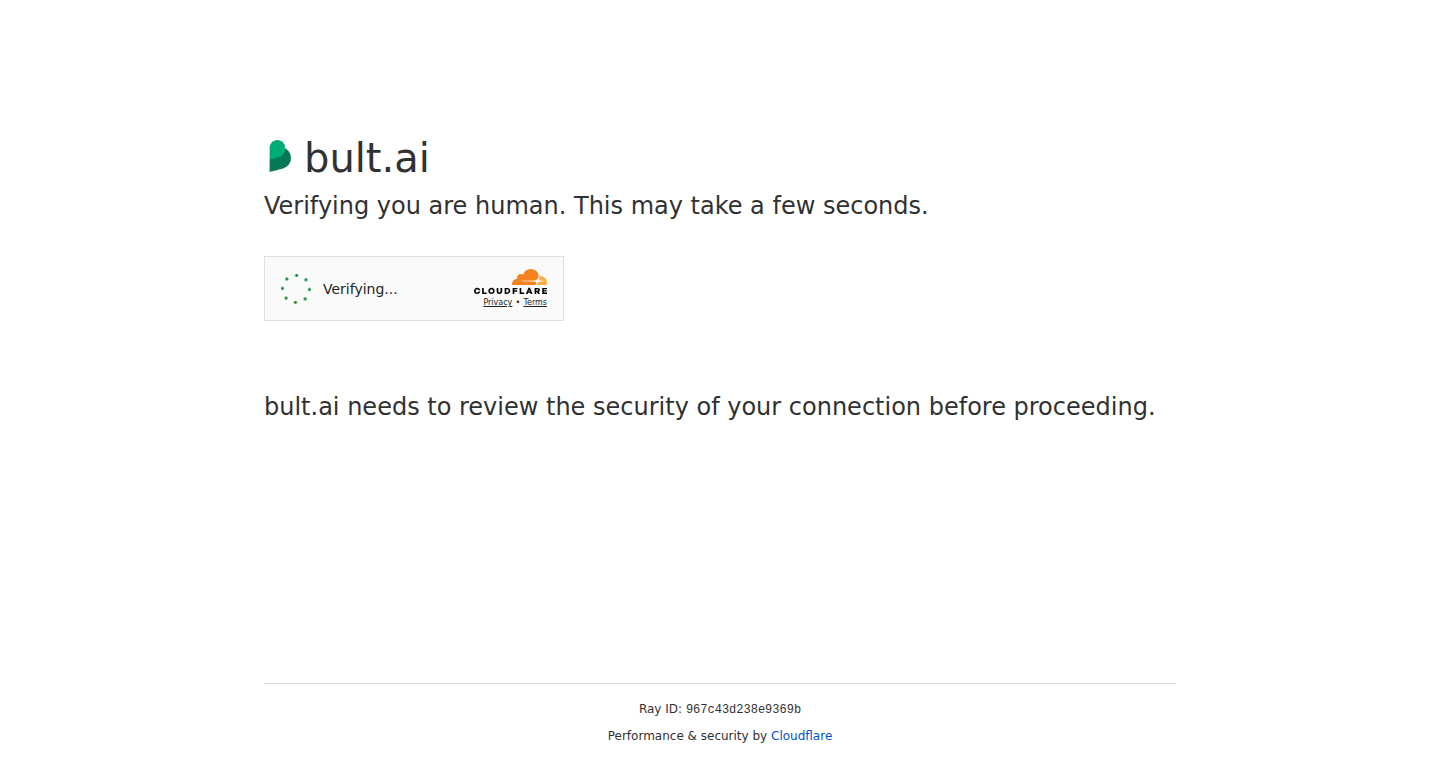
url
Author
nursultan
Description
Bult simplifies application deployment directly from GitHub repositories, eliminating the need for complex DevOps setups. The core innovation lies in its automated build and deployment pipeline, enabling developers to go from code commit to live application within seconds. This addresses the common problem of lengthy and complicated deployment processes, saving developers valuable time and effort.
Popularity
Points 1
Comments 1
What is this product?
Bult is a platform that takes your code from GitHub and automatically builds and deploys it to a live server. It uses a clever system to understand your code and configure the necessary infrastructure, handling tasks like building the application, setting up servers, and managing updates. The innovation is in its ease of use – it does away with the need to manually configure servers, write deployment scripts, or manage complex cloud services. So this simplifies deployment, making it accessible to developers of all skill levels.
How to use it?
Developers can use Bult by simply connecting their GitHub repository. Bult will automatically detect the type of application (e.g., web app, API) and configure the deployment accordingly. Developers then simply push their code to GitHub, and Bult handles the rest – building the application, setting up the environment, and deploying it to a live server. This integrates directly into the developer's existing workflow. So, if you're tired of complicated deployment steps, this is your solution.
Product Core Function
· Automated Build Process: Bult automatically detects the programming language and dependencies used in the project and builds the application without manual intervention. Value: Reduces the time spent on manually configuring build environments. Application: This means you don't need to spend hours setting up build tools, compilers, and dependencies.
· Instant Deployment: After building, Bult deploys the application to a live server within seconds. Value: Allows developers to see their code live quickly. Application: Rapid prototyping and quick iterations are enabled. This allows you to test new features quickly and get user feedback faster.
· GitHub Integration: Seamless integration with GitHub repositories, triggering deployments automatically on code commits. Value: Streamlines the development workflow. Application: Every time you push a new version of your code to GitHub, Bult automatically updates the live version of your application.
Product Usage Case
· Web App Prototyping: A developer is building a new web application and wants to quickly test different features and get user feedback. Using Bult, they can deploy the app in seconds with each code change, allowing for fast iteration. So, this allows you to build and experiment with different ideas rapidly.
· API Development: A backend developer is building an API and needs a simple way to deploy the API and test it without the hassle of configuring servers. Bult's automated deployment simplifies this process. Application: Allows you to quickly share your API with other developers for testing and integration.
· Personal Projects & Side Hustles: A developer wants to quickly deploy a personal project like a portfolio website or a small tool. Bult removes the complexity, letting them focus on the code rather than the deployment setup. So, it makes launching side projects easy and accessible.
47
Kokoro: Chore & Allowance Automation
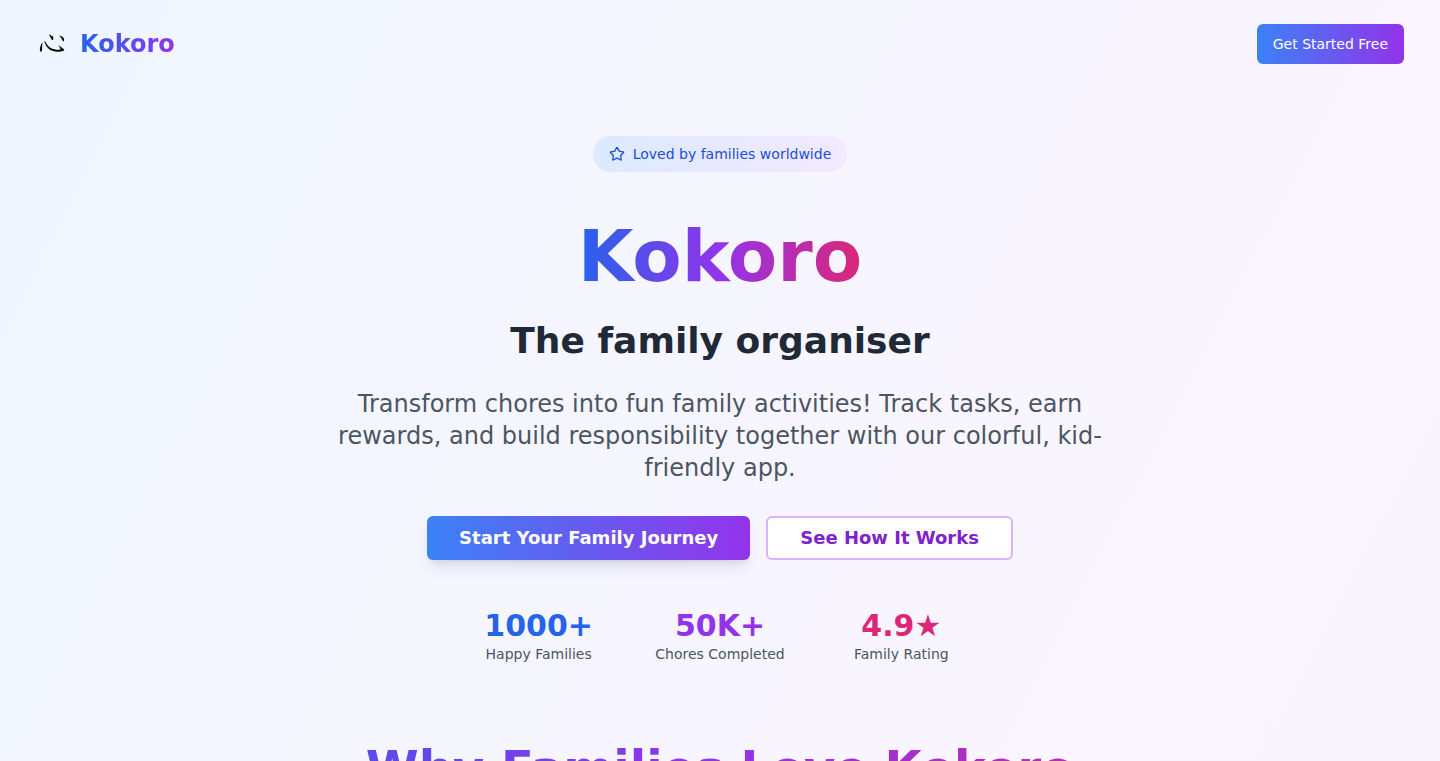
Author
csjohnst
Description
Kokoro is a web application designed to help parents manage their children's chores and allowances. The core innovation lies in its automated chore assignment and allowance payout system. Instead of relying on manual tracking, Kokoro simplifies the process by letting parents assign tasks, monitor completion, and automatically disburse allowances based on the chores completed. This reduces the mental burden on parents and promotes consistency in children's responsibilities. The app is built using modern web technologies such as React, TypeScript, and Tailwind, making it lightweight, fast, and accessible on mobile devices.
Popularity
Points 1
Comments 1
What is this product?
Kokoro is like a digital chore chart combined with an automated allowance system. It automates the traditionally tedious process of managing children's chores and allowances. The key innovation is the automation: parents can define chores, set allowance amounts, and Kokoro handles the tracking and payout based on chore completion. This is different from basic chore charts because it integrates the financial aspect and reduces manual effort. So, this is for anyone who wants to bring structure and automation to their family's chore management.
How to use it?
Parents can access Kokoro through a web browser on any device. First, you define the chores and the allowance associated with each. Then, assign the chores to your children and set deadlines. When the children complete the chores, they mark them as done within the app. Based on the completed chores, Kokoro automatically calculates and dispenses the allowance at the designated interval, for example, weekly or monthly. You can easily integrate this into your daily routines. So, you can use this to reduce the administrative overhead of managing your children's responsibilities.
Product Core Function
· Automated Chore Assignment: This feature allows parents to define chores and assign them to their children with associated due dates. This streamlines the initial setup process and ensures clarity in expectations. The value here is in establishing clear responsibilities for kids and reducing the need for constant reminders. Application scenario: Assigning daily tasks, such as making beds or weekly tasks, such as cleaning rooms.
· Automated Allowance Calculation: Kokoro automatically calculates allowance amounts based on the completed chores. This means parents don't need to manually tally up completed tasks and calculate payments. The value here is time-saving and promotes consistency. Application scenario: Ensuring allowances are paid consistently based on the work completed.
· Progress Tracking: Kokoro provides a way to track the progress of chores in real time. Parents and children can both monitor what tasks are completed and what is outstanding. The value here is transparency and provides a visual overview of the work performed. Application scenario: Monitoring how well children are adhering to chore schedules.
· Mobile-Friendly Interface: The app is designed to be easily accessible on mobile devices. This makes it convenient for parents and children to access and update chores from anywhere. The value here is convenience and accessibility for parents and children. Application scenario: Checking chores status while away from home.
Product Usage Case
· Parent using Kokoro to assign chores to their children like 'make bed' and 'empty dishwasher'. The app automatically tracks completion. So, the parent sees which chores are done and then the allowance is automatically calculated and dispensed each week. The parent saves time on administrative tasks and their children learn responsibility.
· A family with two children uses Kokoro to handle chores and set up an automated allowance system. The parents set up chores, such as "take out the trash" and "clean your room", and assign allowance amounts to each. The kids log in on their devices to mark tasks as done. The parents appreciate that the process is streamlined, and the children appreciate the clear expectations and ability to earn their allowance. This reduces family conflicts and develops accountability.
· A parent wants to encourage their child to complete homework and chores. They set up Kokoro to award extra allowance points for good grades and completed tasks. This helps parents monitor progress and reward performance.
· A busy parent, with multiple children and limited time, sets up Kokoro to manage chores and allowances. The parent can assign chores, track completion, and have the allowance automatically calculated each week. This allows the parent to stay organized and makes discussions about allowance easy. Thus they do not need to spend time on manual calculations or tracking.
48
GetEles: Webpage Element Inspector & Toolkit
Author
WayneFung1992
Description
GetEles is a browser extension designed to make web developers' lives easier. It provides a suite of tools for quickly understanding and manipulating webpage elements. The core innovation lies in its streamlined approach to common debugging and development tasks, such as element inspection, style conversion to Tailwind CSS, element distance measurement, and screenshot capture. It tackles the problem of screen real estate limitations when using browser developer tools, offering a more focused and efficient workflow for front-end developers. This frees developers from the distraction of dealing with the full page view when all they want to do is understand an element.
Popularity
Points 2
Comments 0
What is this product?
GetEles is a browser extension that acts as a supercharged 'inspector' and toolkit for web pages. Instead of relying solely on the standard browser developer tools, it offers a simplified and enhanced interface. Its core function is to quickly get information about a webpage, inspect elements (like HTML tags and their styles), find elements easily, convert CSS styles into Tailwind CSS classes (a popular CSS framework), measure the distance between elements, and take screenshots. It essentially streamlines the often cumbersome process of understanding and manipulating web page structure and design, making it faster and more efficient. So this helps me by speeding up my web development process and gives me more precise control over how I design my websites.
How to use it?
Developers use GetEles by installing the browser extension (compatible with most major browsers). Once installed, they can activate it while browsing a webpage. GetEles provides a panel within the browser that displays element information, allows style manipulation, and offers other tools like measurement and screenshot functionality. Developers can then click on elements within the webpage to see their properties, styles, and more. For example, a developer can select an element, see its CSS styles, and then instantly convert those styles into Tailwind CSS classes. This extension integrates directly into the developer's workflow, providing a suite of tools available at their fingertips as they build or troubleshoot a website. So this lets me quickly inspect elements and get my website ready for production.
Product Core Function
· Quickly get website info: GetEles can rapidly extract important information about the webpage, like the title, description, the color scheme used, and any external resources (like images or scripts). This can be valuable when you need a quick overview of the website's content and design choices. For example, if I am working on a new website and need inspiration, I can use this feature to quickly gather information about the look and feel of other sites.
· Quickly inspect element details: Allows developers to instantly view an element's HTML structure and associated styles (CSS). This includes all classes, inline styles, and other relevant properties. This is a core function of any web developer, allowing them to quickly diagnose and understand how a webpage is structured. So this allows me to see how web elements are built, helping me debug issues and understand the logic behind a page.
· Quickly locate elements: GetEles assists developers in finding specific elements on a webpage. This is done by making the DOM (Document Object Model, the structure of the webpage) traversable, making it easy to find and interact with the element. So this helps me find the right element and how it works in a big page with many elements.
· Quickly convert element styles to Tailwind CSS: Convert existing CSS styles into the format of Tailwind CSS, a popular utility-first CSS framework. This feature streamlines the process of migrating or integrating Tailwind CSS into a project, saving developers time and effort. So this allows me to use the popular Tailwind CSS framework without having to manually convert the CSS styles.
· Precisely measure the distance between any two elements: This allows developers to measure the distance between any two elements on a webpage. This is very useful for design and layout purposes, ensuring precise spacing and alignment. So this lets me easily check the layout and make sure my spacing is accurate.
· Quickly export screenshots of elements or the entire page: Allows developers to capture screenshots of specific elements or the entire webpage. This is helpful for sharing design concepts, documenting issues, or creating visual assets. So this allows me to quickly create visual aids and screenshots to show the different parts of my web page.
Product Usage Case
· Debugging a website: A developer notices an issue where a specific element isn't displaying correctly. Using GetEles, they quickly inspect the element's styles, see the CSS rules, and identify a conflicting style that's causing the problem. They can then modify or remove the conflicting style directly through GetEles. So this allows me to rapidly find and fix display issues.
· Migrating to Tailwind CSS: A developer wants to start using Tailwind CSS in an existing project. GetEles allows them to quickly inspect elements, then convert their existing CSS styles into equivalent Tailwind CSS classes. This saves significant time and effort compared to manually rewriting the styles. So this helps me adopt Tailwind CSS without a long and tedious conversion process.
· Comparing element spacing: A designer is concerned about the spacing between different elements on a webpage. Using GetEles, they can quickly measure the distance between any two elements, ensuring precise spacing and alignment. So this allows me to ensure the spacing between elements on my page is correct, which helps improve the website design.
· Creating design mockups: A designer wants to create a visual mockup of a website element. Using GetEles, they can capture a screenshot of the element and then easily share it with the team. So this allows me to quickly capture and share the design of a specific element.
49
InfraShield: Automated Infrastructure Security through Proactive Agent Monitoring
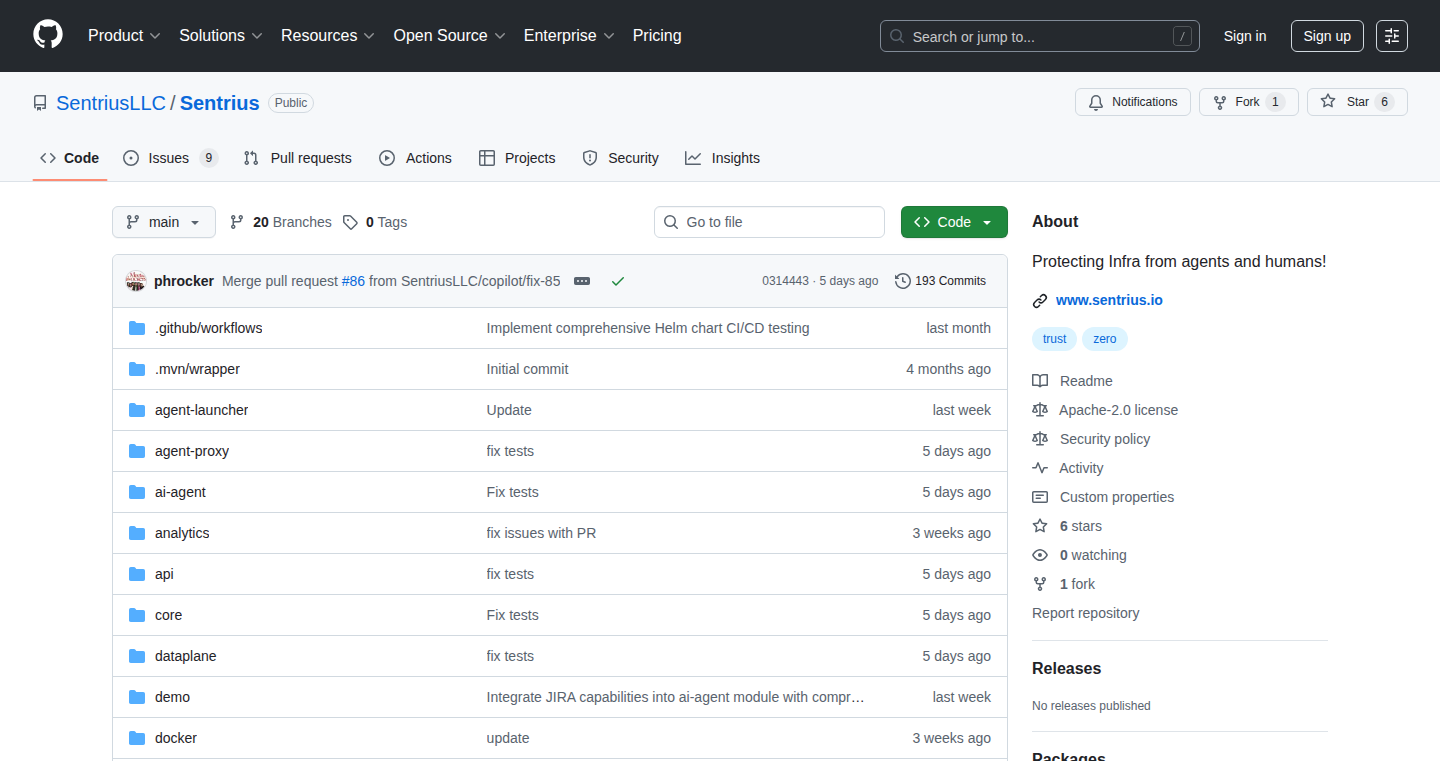
Author
phrocker
Description
InfraShield is a proactive security tool designed to protect infrastructure from both human errors and malicious agents. It achieves this by continuously monitoring infrastructure activity and automatically detecting and mitigating potential security breaches. The core innovation lies in its ability to quickly identify and respond to suspicious activities, effectively reducing the attack surface and minimizing downtime. So, it helps keep your systems secure and running smoothly.
Popularity
Points 1
Comments 1
What is this product?
InfraShield works by creating a real-time security net around your infrastructure. It analyzes all incoming and outgoing activities, looking for anything unusual or potentially dangerous. Imagine it as a vigilant guard, constantly checking every move within your system. Its innovative aspect lies in its automated response system. When it detects a threat, it can immediately take action, such as blocking access or alerting the administrator. So, it keeps your systems safe from intruders and mistakes.
How to use it?
Developers integrate InfraShield into their infrastructure monitoring pipeline. You typically install it on your servers or cloud instances. After setup, it continuously monitors activity logs, network traffic, and system processes. Developers define security policies and alerts based on their specific needs. When suspicious activity is detected, InfraShield can automatically trigger pre-defined actions, sending notifications or blocking potentially harmful operations. So, it provides a hands-off security layer.
Product Core Function
· Real-time Activity Monitoring: This function constantly watches all activities within your infrastructure, like someone always looking over your shoulder. Value: This helps identify any unusual actions immediately, before they can cause damage. Use Case: Great for spotting malicious activity in real-time, which is crucial for protecting your servers.
· Automated Threat Detection: InfraShield uses advanced algorithms to automatically detect potential threats. Value: This saves you time and effort by automatically recognizing dangers. Use Case: Helpful for identifying common attack patterns and unusual system behaviors.
· Automated Response System: When a threat is detected, InfraShield can take immediate action, such as blocking access or sending alerts. Value: This prevents threats from causing serious damage and reduces the response time to security incidents. Use Case: Useful for automatically mitigating botnet attacks or preventing accidental system misconfigurations.
· Customizable Security Policies: Users can define their security rules and alerts based on their specific needs. Value: This allows users to tailor the system to their infrastructure's unique security requirements. Use Case: Important for configuring alerts for specific types of access or activities, like unauthorized database access or unusual file modifications.
Product Usage Case
· Preventing Unauthorized Access: Suppose a developer accidentally exposes a sensitive database. InfraShield detects the unauthorized access attempt and immediately blocks the connection, preventing a potential data breach. This helps protect sensitive information and keep your services up and running.
· Identifying and Mitigating DDoS Attacks: During a distributed denial-of-service (DDoS) attack, InfraShield can identify the unusual traffic patterns and automatically block the malicious traffic, ensuring that your servers remain accessible. This keeps your site online even under heavy attack, minimizing downtime.
· Detecting and Responding to Misconfigurations: A developer accidentally misconfigures a firewall, opening up a port. InfraShield detects this anomaly and alerts the administrator, preventing a potential vulnerability. This prevents human error from leading to major security issues.
· Monitoring User Behavior: InfraShield can monitor user activity to detect suspicious patterns, such as unusual login attempts or data access. This helps identify potential insider threats or compromised accounts. This protects user data and prevents unauthorized actions by malicious actors.
50
Term: Fast Data Validation with Apache DataFusion in Rust
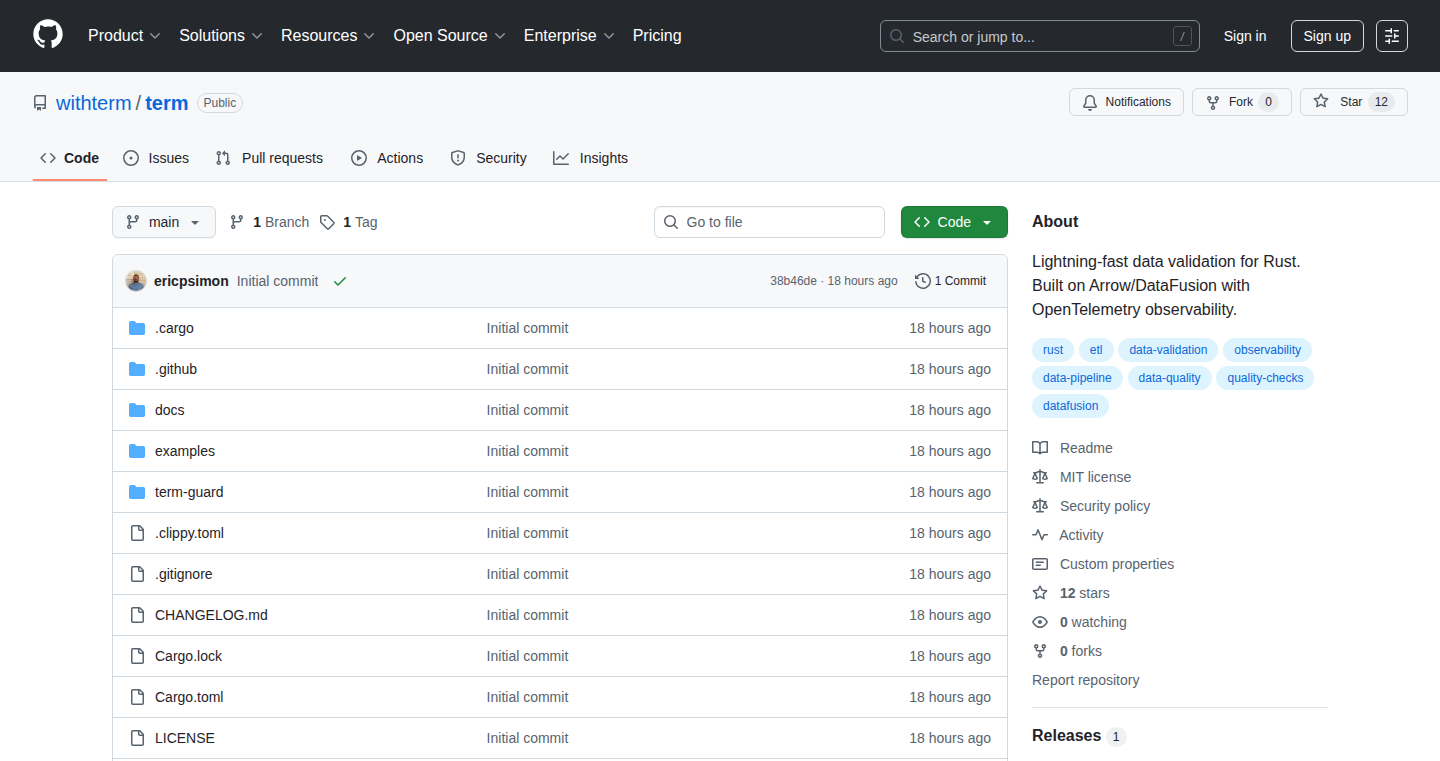
Author
ericpsimon
Description
Term is a Rust library designed for fast and efficient data validation, inspired by Apache Deequ but built on Apache DataFusion. It allows developers to perform comprehensive data quality checks without the need for heavy infrastructure like Spark clusters. It leverages the speed of Rust and DataFusion's columnar processing to validate data directly, resulting in significantly faster validation times and minimal overhead. The core innovation lies in its ability to integrate data quality checks seamlessly into any environment, from a developer's laptop to CI/CD pipelines, making data validation accessible and practical.
Popularity
Points 2
Comments 0
What is this product?
Term is a tool that helps you check the quality of your data. It's built using a fast programming language called Rust and uses a clever data processing engine called Apache DataFusion. Instead of needing big, complicated systems, Term runs directly and quickly on your computer or in your development process. It allows you to make sure your data meets certain rules, like checking if all the necessary information is there (completeness), if there are any duplicate entries (uniqueness), and doing calculations like averages and standard deviations. So this is useful because you can easily confirm the quality of your data, saving you time and ensuring the accuracy of any projects using that data.
How to use it?
Developers can integrate Term into their data pipelines by adding it as a dependency in their Rust project. They can then define validation rules to check their data. It offers a simple API for defining data quality checks such as completeness checks, uniqueness validation, statistical analysis, and more. Term is used by adding the `term-guard` dependency, and you are validating data. For example, you might use it within a data ingestion pipeline to ensure that new data meets certain criteria before it's stored, or in a data analytics workflow to validate the correctness of data used for generating reports. So this lets you catch errors early on, before bad data causes problems in your system or messes up your results.
Product Core Function
· Completeness Checks: Verifies that specific data fields are not missing any values. This makes sure the essential parts of your data are present. So this is useful because it prevents incomplete data from causing problems in your calculations or reports.
· Uniqueness Validation: Checks whether values in a field are unique, ensuring that there are no duplicates. This is important for data integrity, especially for things like identifiers. So this is useful because it prevents data from being skewed by duplicated entries, ensuring more accurate results.
· Statistical Analysis: Provides tools to calculate metrics like mean, standard deviation, and correlation. These help you understand the distribution and relationships within your data. So this is useful because it helps you quickly spot trends and identify data that may need further investigation.
· Pattern Matching: Allows you to check data against predefined patterns, such as verifying email formats or phone number structures. So this is useful because it guarantees that the data follows certain formats, which is crucial for data quality.
· Custom SQL Expressions: Provides the flexibility to define data validation rules using SQL queries. So this is useful because it enables you to tailor your validation to complex or unique scenarios.
· OpenTelemetry Integration: Supports integration with OpenTelemetry for production observability, allowing you to monitor and troubleshoot data validation processes in real-time. So this is useful because it helps you track how data quality checks are performing, and identify the errors.
Product Usage Case
· Data Ingestion Pipelines: Use Term to validate data as it enters your system. For instance, before saving customer records into your database, Term can verify that required fields like 'email' and 'phone number' are not empty and match the correct formats. This ensures clean data at the source. So this is useful because it makes sure your data is always accurate.
· Data Analytics Workflows: Before running complex analytical models on a dataset, use Term to ensure that all required features are present and have valid values. For example, validate the range of product prices, or check for outliers. So this is useful because it prevents inaccurate insights and conclusions by flagging problematic data points early on.
· CI/CD Pipelines: Integrate Term into your Continuous Integration and Continuous Deployment pipelines to automatically validate data quality with every code change. This allows you to quickly identify and fix data issues before they make it into production. So this is useful because it guarantees data quality even with frequent software updates and code changes.
· Local Development: Developers can use Term on their local machines to validate data during the development phase, catching errors before they're pushed to testing or production environments. So this is useful because it promotes faster debugging and development cycles.
· Data Migration: When migrating data from one system to another, use Term to validate that the migrated data meets all the necessary constraints and maintains data integrity. So this is useful because it makes sure your data is still accurate.
51
WeekendSaasBoilerplate: Rapid SaaS Launch Kit
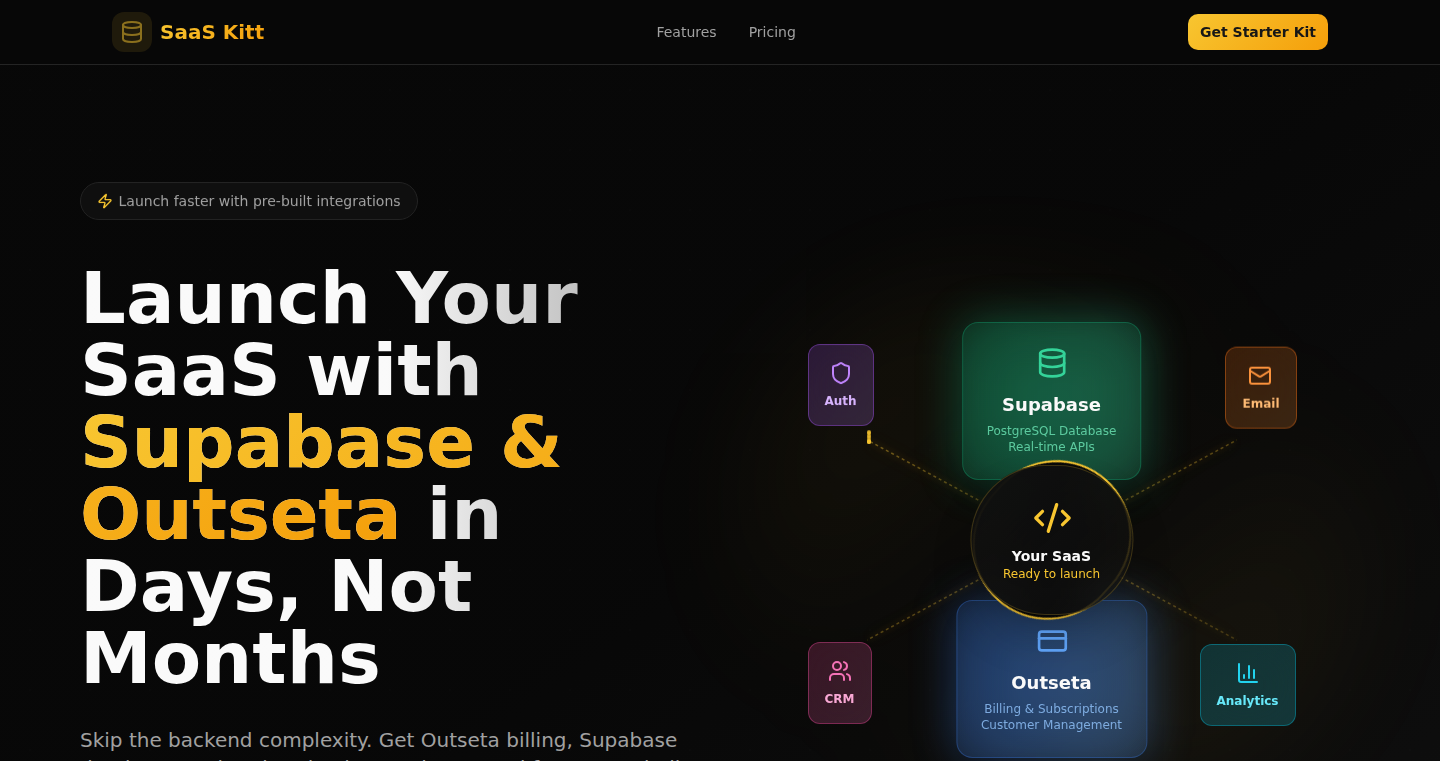
Author
westche2222
Description
This project provides a ready-to-use starting point for building Software as a Service (SaaS) applications. It significantly reduces the time and effort required to set up the fundamental infrastructure, allowing developers to focus on core features and business logic. The innovation lies in its pre-configured setup for common SaaS necessities such as authentication, database integration, payment processing (Stripe), and deployment, all wrapped up in a well-structured codebase. So what's in it for me? You can go from idea to a functional SaaS prototype in a weekend, saving you weeks of initial setup work and letting you test your product quickly.
Popularity
Points 2
Comments 0
What is this product?
This is a template or 'boilerplate' containing pre-written code for the basic functionalities every SaaS needs. It includes user authentication (verifying who you are), database connectivity (storing your data), payment integration (handling transactions), and deployment scripts (getting your application online). The key innovation is the streamlining of this process, enabling rapid prototyping. It uses common technologies and frameworks (likely Javascript-based) to make the development experience easier for developers. So what's in it for me? It allows you to bypass the tedious initial setup and focus on your actual product.
How to use it?
Developers would use this by downloading the codebase, configuring it with their specific details (e.g., database credentials, payment gateway keys), customizing the features to fit their SaaS requirements, and deploying the application. The boilerplate handles the essential infrastructure, allowing developers to add their own unique features and business logic. Technical use cases might involve using it as a starting point for customer relationship management (CRM) systems, project management tools, or any web application requiring user authentication and payment processing. So what's in it for me? You can quickly start building your SaaS app without getting bogged down in the underlying infrastructure.
Product Core Function
· User Authentication: The boilerplate comes with pre-built user registration, login, and session management. Value: Saves time implementing secure user account management, making sure users are who they say they are. Application: Any SaaS that requires user accounts – from simple blogs to complex enterprise software.
· Database Integration: It includes database connection code, often with pre-defined data models or schemas. Value: Simplifies data storage and retrieval, removing the need to write all the boilerplate code for this task. Application: Any application that needs to store or manage data, such as user profiles, product listings, or content.
· Payment Processing (Stripe Integration): Provides ready-to-use code for handling payments, allowing you to accept credit card transactions. Value: Makes it easy to monetize your SaaS by integrating payment gateways with minimal coding. Application: E-commerce platforms, subscription-based services, or any SaaS that needs to bill users.
· Deployment Scripts: The boilerplate likely includes scripts or instructions for deploying the application to cloud platforms (like AWS, Google Cloud, or Azure). Value: Automates the process of making your app live on the internet. Application: Any SaaS that needs to be accessible to the public.
Product Usage Case
· Building a new project management SaaS tool: Using the boilerplate, a developer can quickly set up user accounts, database storage for tasks and projects, and payment processing for subscriptions. The developer can then focus on the specific project management features without the headache of setting up the basic infrastructure. This saves weeks of initial setup.
· Creating a subscription-based online course platform: By integrating the boilerplate with a content management system (CMS), a developer can create a platform to host and sell online courses. The user authentication, payment processing, and database integration are already in place, so the developer can focus on building the course content and user interface. This can dramatically reduce the time needed to launch the platform.
· Developing a simple CRM for small businesses: The boilerplate can be customized to include basic contact management features, user authentication, and a payment gateway to offer premium features. This allows a developer to deliver a functional CRM application faster than starting from scratch. It provides a quick start to building a revenue generating SaaS product.
52
GoldbachAI: Formalizing Number Theory for AI Reasoning

Author
justdoitookk
Description
This project aims to use the formal language of Higher-Order Logic (HOL) to represent and reason about the Strong Goldbach Conjecture, a famous unsolved problem in number theory. It allows AI systems to understand and manipulate mathematical statements rigorously, potentially paving the way for more powerful AI reasoning capabilities. It addresses the challenge of bringing human-level mathematical understanding into the realm of AI, enabling AI to not just process data, but to *understand* and *reason* about mathematical concepts.
Popularity
Points 1
Comments 1
What is this product?
GoldbachAI essentially converts the Goldbach Conjecture into a format that AI can understand. Instead of simply stating the conjecture, the project translates it into the precise language of HOL. HOL is a way to describe logic in a very strict and unambiguous way, similar to how programming languages precisely describe instructions for computers. This means AI can apply logical rules to the conjecture, potentially helping to discover new insights or prove it. The innovation lies in using formal methods, specifically HOL, to encode complex mathematical problems, enabling AI to work with them. So, it is about providing a bridge between abstract mathematical concepts and AI systems, helping them understand and reason about mathematical principles.
How to use it?
Developers, especially those working on AI and automated theorem proving, can use GoldbachAI as a benchmark and a tool. They can integrate the formalization of the Goldbach Conjecture into their AI systems, allowing the systems to explore and reason about the problem. The project can also serve as a template for formalizing other mathematical concepts, providing a valuable resource for developing AI capable of handling complex mathematical reasoning. The code might be used to verify conjectures or to help find counter-examples. So, if you are trying to make an AI that can *think* mathematically, this provides a foundation.
Product Core Function
· Formalizing the Goldbach Conjecture in HOL: This core function takes the informal statement of the Goldbach Conjecture and translates it into a precise, machine-readable format using Higher-Order Logic. Value: Allows AI systems to 'understand' the conjecture and manipulate it using formal reasoning rules. Application: Enables AI to assist in exploring and potentially proving the conjecture, accelerating mathematical discovery. So, this allows computers to read and then think about a notoriously difficult math problem.
· Defining Number Theory Concepts in HOL: The project defines fundamental number theory concepts (e.g., prime numbers, even numbers) within the HOL framework. Value: Provides the building blocks necessary for expressing the Goldbach Conjecture. Application: Serves as a foundational component for AI systems to reason about more advanced mathematical topics. So, it sets up the basic mathematical tools needed for the AI to understand.
· Supporting Automated Theorem Proving: The project integrates with automated theorem provers (software designed to prove mathematical statements). Value: Enables AI to automatically attempt to prove the Goldbach Conjecture or related theorems. Application: Provides a testbed for developing more advanced AI reasoning capabilities in mathematics. So, it provides a system for checking if the conjecture is true, or finding out why it is not.
Product Usage Case
· AI-assisted Proof Verification: Integrate the formalized Goldbach Conjecture with an automated theorem prover to verify existing proofs or explore alternative approaches. This can help mathematicians validate proofs, speeding up the process and reducing human error. So, it helps to check if human's math work is correct.
· Generating Mathematical Hypotheses: Use the formalized conjecture as a starting point for an AI to generate and test related mathematical hypotheses. This enables AI to drive exploration in mathematics by suggesting new areas of research. So, it can let the AI help make new ideas in math.
· Developing AI for Education: Use the formalization as a teaching tool to illustrate formal mathematical reasoning and the power of symbolic manipulation to students. This improves understanding of mathematical concepts. So, it helps teach math by allowing students to interact with the math using computers.
53
RKIK: Rusty Klock Inspection Kit
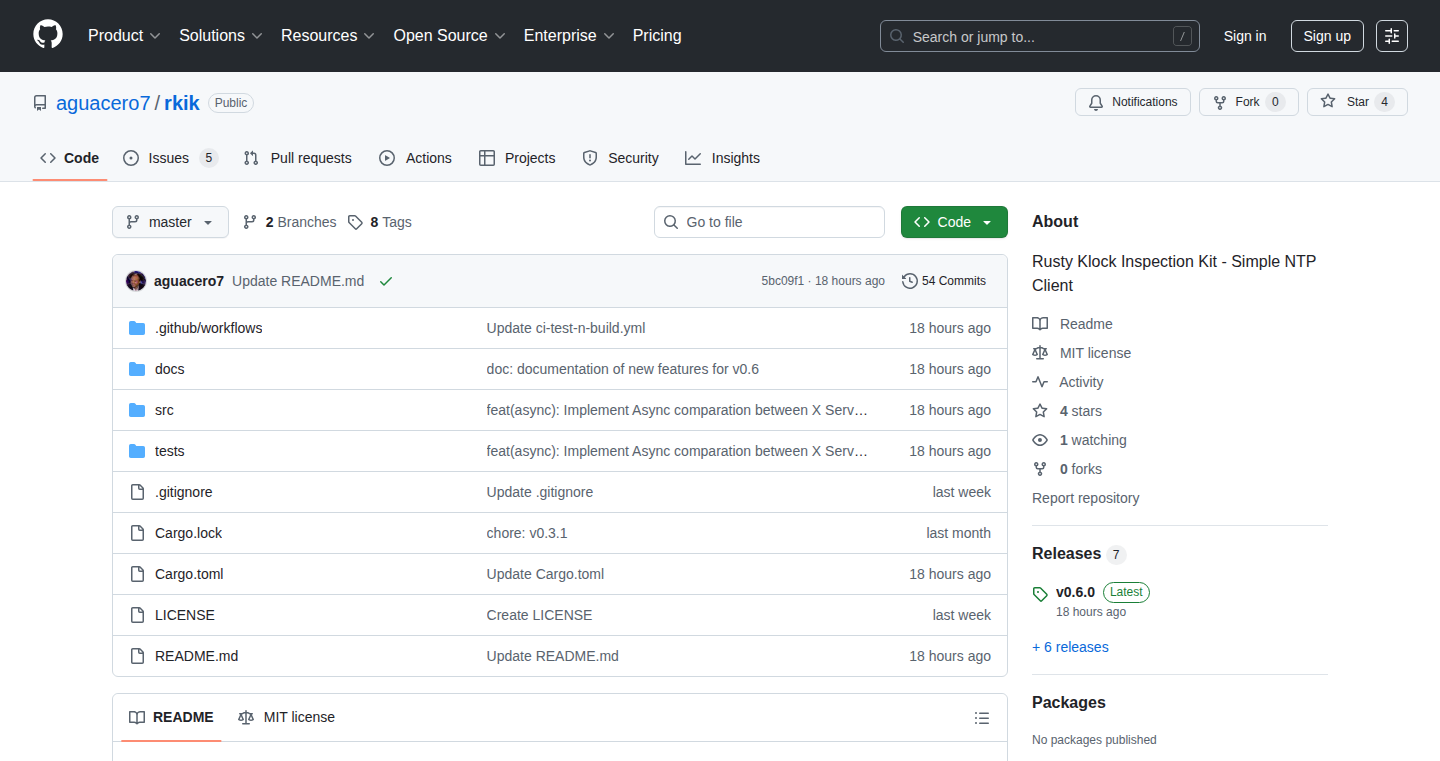
Author
aguacero7
Description
RKIK is a command-line tool that checks the time synchronization of your system with Network Time Protocol (NTP) servers. It's designed for situations where you can't or don't want to run full-fledged NTP clients like `chronyd` or `ntpd`, such as in containers or automated testing environments. It uses Rust, known for its speed and efficiency, to create a small, fast program that passively analyzes the time offset and delay from NTP servers, giving you a quick way to see if your system's time is accurate. This tool works similar to how `dig` helps check DNS or `ping` checks network connections.
Popularity
Points 2
Comments 0
What is this product?
RKIK is a command-line utility built to passively inspect NTP servers. Instead of actively synchronizing your system's time, it simply queries NTP servers and reports the time offset (how far off your system's clock is) and round-trip time (RTT) for the network connection. The core innovation lies in its design: it's lightweight, doesn't require root privileges, and can run without needing to configure anything. It leverages the asynchronous capabilities of the Tokio framework in Rust to query multiple servers concurrently. So, it is fast. It is implemented in Rust to achieve the goals of a small, portable, and efficient executable. This means it's easy to deploy and use in various environments like containers or continuous integration pipelines. So this is great for systems that have a limited footprint or where you need to quickly check the time without making changes.
How to use it?
Developers use RKIK from the command line. You simply provide the tool with the address(es) of NTP servers you want to check. For instance, you can run `rkik pool.ntp.org` to check against a general NTP pool. You can also compare multiple servers using the `--compare` option, and the output can be formatted as JSON or plain text. For example, in a CI environment, you can integrate it into your build scripts to ensure that the build machines have accurate time, which is essential for tasks like timestamping builds or running tests that rely on time. RKIK is easily integrated into scripts and automation pipelines, making it a valuable tool for systems administrators and developers concerned with time accuracy across their infrastructure.
Product Core Function
· Querying NTP Servers: RKIK sends requests to specified NTP servers and receives responses. This allows it to determine the time offset and round-trip time.
· Asynchronous Operation: Using Tokio, RKIK can query multiple NTP servers simultaneously. This drastically speeds up the process of checking time against several servers.
· Output Formatting: The tool can output results in both human-readable text and JSON format. This flexibility is useful for both quick manual checks and for integrating into automated systems.
· IPv4 and IPv6 Support: RKIK supports both IPv4 and IPv6 addresses for NTP servers, ensuring compatibility with modern network infrastructures.
· No Root Privileges Required: RKIK doesn't need administrative (root) permissions to run, making it safer and easier to use in constrained environments like containers.
· Stateless Design: RKIK doesn't store any configuration or maintain a daemon process, which contributes to its lightweight nature and ease of deployment.
Product Usage Case
· Continuous Integration (CI): In CI environments, ensuring time accuracy is crucial for correct test execution and build processes. RKIK can be included in build scripts to verify that the CI server's time is synchronized with trusted NTP servers before running tests. If time drift is detected, the build can be flagged, preventing issues caused by inaccurate timestamps. This ensures consistent and reliable build results. So this is a great tool for automated build and test systems.
· Containerized Environments: When running applications inside containers, the container's time may drift from the host system. RKIK can be used as a simple way to check the time within a container without needing to install and configure a full NTP client. This is useful to monitor the containers and to maintain integrity of log files. This is a good tool for container monitoring.
· Embedded Systems: For embedded systems with limited resources, running a full NTP client might be overkill. RKIK provides a lightweight solution for checking time synchronization. It can be part of a monitoring system to periodically check the time and alert operators if the system's time is drifting, ensuring data logging and other time-sensitive operations are accurate. This helps ensure that embedded systems maintain good time accuracy without high resource overhead.
· Observability Pipelines: RKIK's JSON output format makes it easy to integrate with monitoring and observability systems. The results can be ingested, stored, and visualized along with other system metrics, providing a complete view of time synchronization across a distributed infrastructure. This is very useful to create centralized monitoring and alarming systems.
54
Internal MCP: A Productivity Booster for Engineering Teams
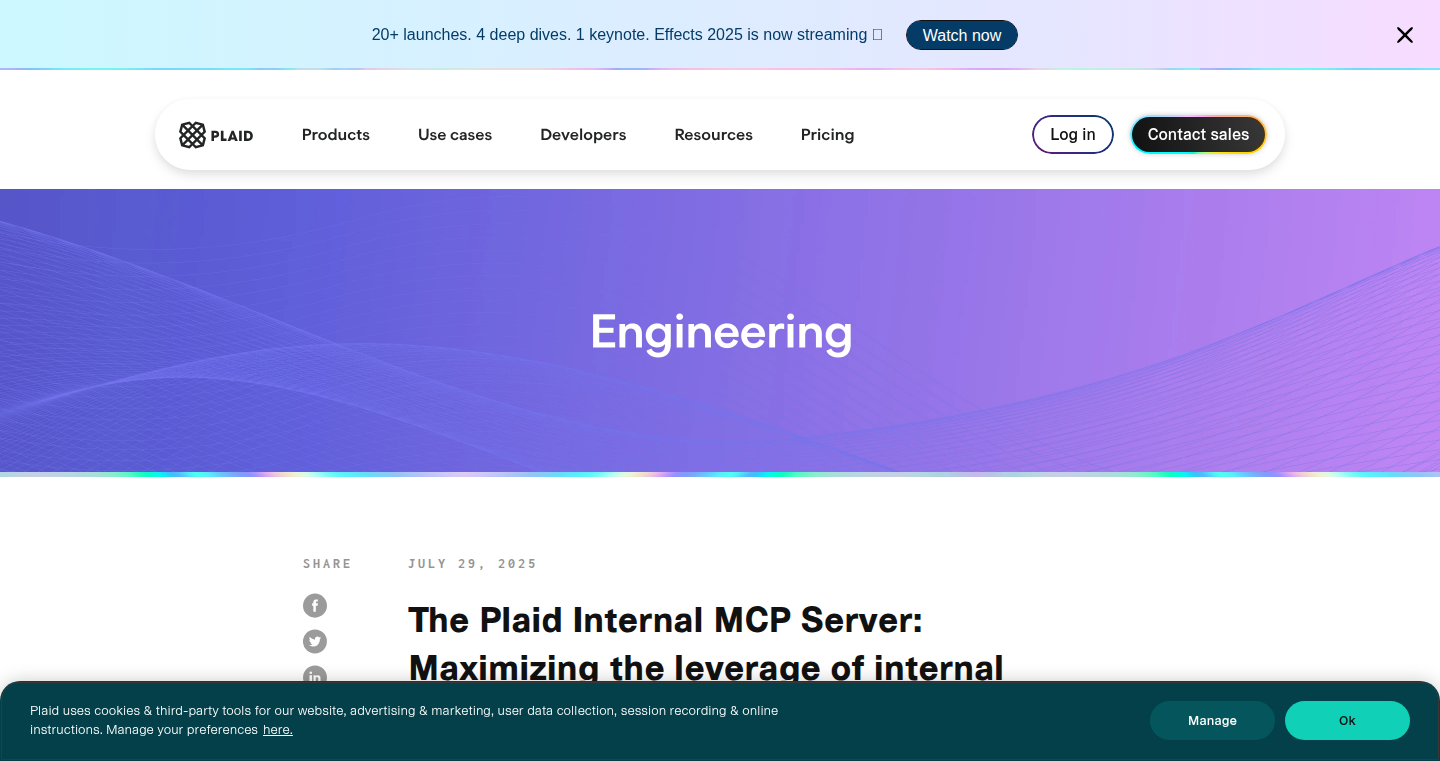
Author
allenschen
Description
This project is an internal Metrics Collection Platform (MCP) designed to enhance the productivity of the engineering team at Plaid. It offers a streamlined approach to collecting and analyzing various engineering metrics. The core innovation lies in its ability to gather data from diverse sources, providing a unified view of team performance and enabling data-driven decisions. So this means the engineers can quickly identify bottlenecks and optimize their workflows.
Popularity
Points 2
Comments 0
What is this product?
This MCP is a centralized system that collects data from different parts of the engineering workflow, such as code repositories and deployment pipelines. It then processes and presents this data in a meaningful way, allowing engineers to understand how they spend their time and where they can improve. The innovation lies in its ability to aggregate various metrics automatically, providing valuable insights into team efficiency and performance. So it's like having a smart assistant that watches over your work and tells you how to do it better.
How to use it?
Developers integrate the MCP with their existing tools and workflows. This could involve setting up integrations to collect data from their code repositories (like GitHub), build systems, and deployment pipelines. Once the data is flowing, they can use the MCP's dashboards and reports to monitor key metrics, such as code commit frequency, build success rates, and deployment times. This provides a real-time view of their team's performance, helping them to make data-driven decisions about their workflow and priorities. So you get a real-time view of your team's performance, enabling data-driven decisions.
Product Core Function
· Automated Data Collection: The MCP automatically gathers data from various engineering tools (code repositories, build systems, etc.). Value: Reduces manual data gathering and saves time. Application: Automatically collecting commit frequencies and code review times.
· Unified Metrics Dashboard: Presents all collected data in a single, easy-to-understand dashboard. Value: Provides a holistic view of engineering performance. Application: Displaying build success rates and deployment times on a single screen.
· Performance Analysis & Reporting: Offers tools for analyzing metrics and generating reports to identify trends and bottlenecks. Value: Helps in pinpointing areas for improvement in the development process. Application: Identifying teams that are consistently missing deadlines or having frequent build failures.
· Customizable Metrics: Allows engineers to define and track their own custom metrics. Value: Tailors the system to specific team needs. Application: Tracking the frequency of code reverts or the number of open pull requests.
Product Usage Case
· Workflow Optimization: A team uses the MCP to discover that they spend a significant amount of time on code reviews. They then implement a new code review process to reduce the review time, improving overall development velocity. So they save time and develop faster.
· Bottleneck Identification: Engineers utilize the MCP to see that a certain build process is consistently slow. They can then investigate the root cause and optimize the build configuration, making builds faster and more efficient. So they can boost efficiency.
· Resource Allocation: Management uses the MCP to track the allocation of engineering resources across different projects. This helps them make informed decisions on resource distribution, ensuring that the right people are working on the most important tasks. So they can manage the team in a more rational and targeted way.
· Predictive Analysis: Utilizing the data accumulated by the MCP, a team can predict potential problems. If deployment times suddenly increase, developers can act faster to solve these issues to prevent further issues, so that they can minimize risks.
55
YC Advice Bot: Real-Time Startup Guidance

Author
nkabbani10
Description
This project is a chatbot designed to provide instant advice to entrepreneurs, particularly those navigating the challenges of building a startup. It leverages the power of Large Language Models (LLMs) to parse and analyze a vast amount of information, offering personalized guidance and answering questions related to Y Combinator (YC) startup advice in real time. The core innovation lies in its ability to extract relevant knowledge from a large dataset and present it in a conversational, user-friendly format, saving users time and effort in searching for information.
Popularity
Points 2
Comments 0
What is this product?
This chatbot works by taking your questions and using Artificial Intelligence (AI) to search through a large database of startup advice, particularly from YC. The AI then crafts a helpful response based on the information it finds. Think of it as having a smart assistant who can instantly access and summarize a lot of data. So this is useful because it can quickly give you relevant answers when you need them, making it easier to navigate the complexities of starting a company.
How to use it?
Developers can interact with the bot through a chat interface. You simply type your question, and the bot provides an answer. You could integrate this bot into your own startup tools, internal knowledge base, or even as a support feature for your own startup. This allows users to quickly access startup advice without having to manually search through documentation or other resources. For example, you might use it to quickly get advice on fundraising strategies, product development, or customer acquisition.
Product Core Function
· Real-time advice generation: The core functionality is the ability to provide answers to startup-related questions in real-time. This value lies in offering instant access to information, saving users time and effort by avoiding manual searching. It's useful when you need a quick answer to a specific question while working on your startup.
· Knowledge extraction from a large dataset: The system is designed to process and extract relevant information from a large collection of startup advice and resources. This is valuable because it lets the chatbot provide answers based on a broad understanding of the topic, enabling more comprehensive advice. This is useful for getting detailed information on complex topics like market analysis.
· Conversational interface: The chatbot offers a user-friendly conversational interface, making it easy for users to ask questions and receive understandable responses. This makes the information more accessible, allowing even non-technical users to benefit from the advice. It's useful when you prefer a more natural and intuitive way to get startup advice, like chatting with a friend.
Product Usage Case
· Startup founders looking for fundraising advice: A founder is unsure about the best way to approach investors. The bot can quickly offer information on different fundraising strategies, valuation methods, and pitch deck tips. This saves time by providing a condensed version of the information, enabling the founder to refine their strategy.
· Developers creating a support system: Developers might use the bot to add a support feature to their own startup tool. This means that users of the tool can ask questions about the tool and get instant answers, improving the user experience. It helps to reduce the need for manual support responses.
· Teams performing competitive analysis: Startup teams can use the chatbot to quickly extract information about successful startups, learning about their strategies and techniques. This helps with identifying market gaps and forming effective business strategies. It saves time by quickly summarizing best practices and potential areas of development.
56
Claude Loop: Iterative Execution Sandbox
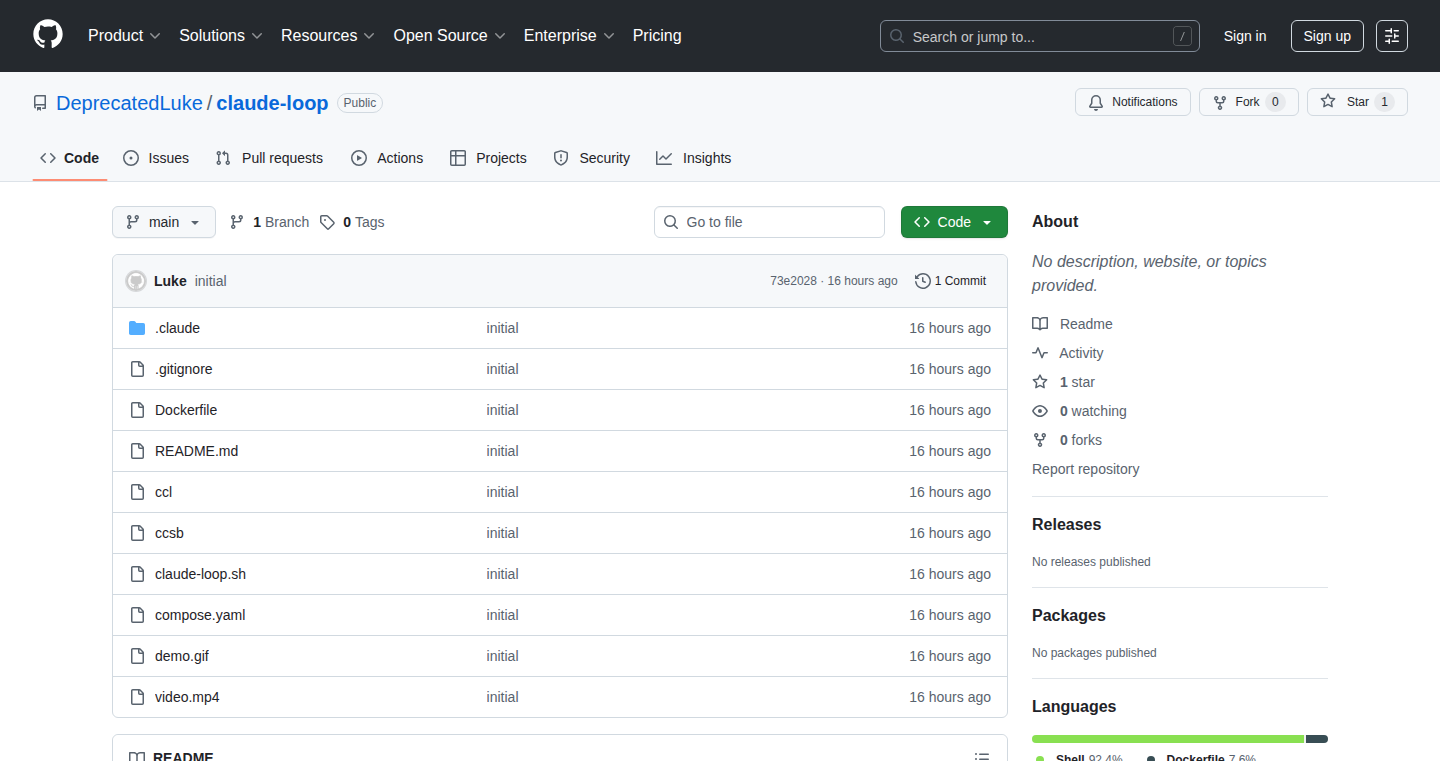
Author
kachapopopow
Description
Claude Loop is a tool that allows you to run code multiple times, similar to a loop, but within a secure 'sandbox'. It's designed for situations where you need to iteratively refine a process, like refining a plan or generating something step-by-step, without risking your entire system. It tackles the problem of potentially dangerous or unpredictable code by isolating each iteration, ensuring that even if one step fails or goes wrong, it doesn't bring down the whole process. This is achieved through a carefully managed environment, hence the 'sandbox' aspect.
Popularity
Points 1
Comments 1
What is this product?
Claude Loop provides a controlled environment for running iterative processes. Think of it like a safe container for your code. It works by repeatedly executing a piece of code, allowing the results of each run to influence the next. The key innovation lies in its sandboxed nature: it isolates each execution, preventing errors or malicious code in one iteration from affecting the entire system. This is beneficial for things like AI plan refinement, code generation, or any process that benefits from iterative improvements. So what's the big deal? This means your system is more resilient, and you can experiment with code that might be risky without fear of breaking everything.
How to use it?
Developers can integrate Claude Loop into their projects to automate iterative tasks. For example, if you're building a chatbot, you can use it to test and refine the chatbot's responses repeatedly. You can also use it to iteratively generate code, refine data analysis pipelines, or even model complex systems. The integration involves defining the process to be executed in each loop and setting up the conditions for the loop to continue or terminate. This allows you to create robust and adaptive workflows. So this means you can automate complex tasks that would normally take a long time to debug manually.
Product Core Function
· Iterative execution: Claude Loop runs a defined process repeatedly, allowing for continuous refinement and adaptation. This is valuable for refining AI plans or generating complex results iteratively. For example, imagine you have a complex AI model, and you want to improve its output. Claude Loop allows the model to run, analyze the result, and then 'loop' back with a slight adjustment to improve the result – all within a secure environment. The benefit? Higher-quality outputs from your processes.
· Sandboxed environment: Each iteration runs within a secure, isolated environment. This prevents errors or malicious code in one iteration from compromising the whole system. Say you are trying to build an algorithm to trade. You can test your algorithm and if it fails, the entire system will be preserved. Why is this useful? Because it prevents accidental damage, especially useful when the code is complex or interacts with external systems.
· Plan refinement: Claude Loop excels at iteratively improving plans or strategies. Imagine you're working on a complex AI-driven plan to solve some problem. Claude Loop helps you refine that plan step by step. The system runs the plan, analyzes the outcomes, and adjusts the plan for the next iteration. The advantage? Smarter solutions and more resilient systems.
· Automated Testing: Use Claude Loop to automate testing procedures to automatically run test cases and evaluate the results within the isolated context of a sandbox. This provides a safe way to test and validate new software builds without the risks associated with running in the active system. Why? This speeds up debugging and testing to ensure quality and avoid system instability.
Product Usage Case
· AI Plan Optimization: Developers can use Claude Loop to refine AI planning algorithms. For instance, an AI system can generate a plan, run it, and then, using the results, modify the plan for the next iteration. This continuous feedback loop improves the plan’s effectiveness over time, allowing the AI to 'learn' and become more efficient. So you get smarter AI plans.
· Code Generation and Refinement: When generating code, especially complex code, developers can use Claude Loop to run the code, analyze the results, and iteratively improve the code’s functionality and efficiency. The sandbox isolates the code generation steps, ensuring stability, and allowing for safer experimentation. This will help to create better, safer codes faster.
· Data Analysis Pipelines: Claude Loop can iteratively refine data analysis pipelines. In data science, you can use it to run a series of data processing steps, analyze the outputs, and adjust the steps for the next iteration, creating more accurate models. This leads to better, more insightful analysis.
· Experimentation with Unproven Code: Developers can use Claude Loop to safely experiment with code that might be risky. If the experiment goes wrong, the impact is contained within the sandbox, preventing damage to the entire system. This promotes a safer, more experimental approach to development.
57
Curiosso: Knowledge Navigator
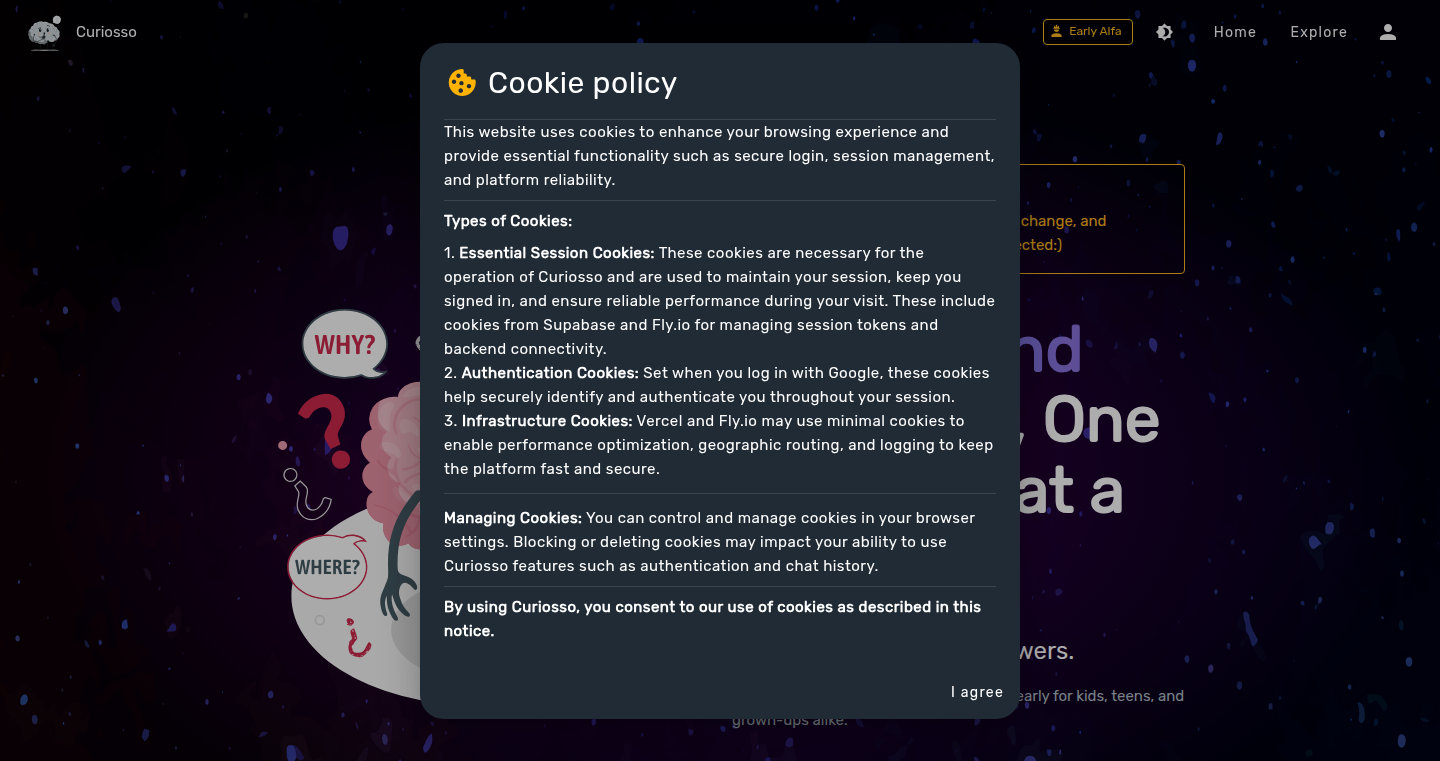
Author
anthonyag
Description
Curiosso is a project designed to provide simple answers to complex questions. It leverages a knowledge base and a query processing system to distill intricate concepts into understandable explanations. It’s like having a smart assistant that breaks down difficult topics, focusing on clarity and accessibility, addressing the problem of information overload and the need for concise explanations.
Popularity
Points 2
Comments 0
What is this product?
Curiosso uses a combination of techniques. First, it has a built-in knowledge repository, a database of facts and relationships. Then, it uses a query processing system, that understands your questions. When you ask a question, this system processes it, identifies the relevant facts, and synthesizes them into a clear and concise answer. The innovation lies in its ability to simplify complex information, making it easy to grasp even for people without a technical background. So, this is valuable because it helps anyone quickly understand complex topics.
How to use it?
You can use Curiosso by simply typing in a question. The system analyzes your query, finds the relevant information, and generates a response. The integration is straightforward; it is designed to be easily accessible. You could use it as a learning tool, for quick reference during research, or even as a component of a larger application that requires accessible information. So, developers can integrate this tool easily into their projects for quick knowledge access and simplification of complex subjects.
Product Core Function
· Question Answering: The core functionality is answering your questions. You pose a question, and Curiosso provides a clear answer. This is valuable because it directly solves the problem of understanding difficult concepts.
· Knowledge Base Access: It has access to a knowledge base which stores information on a variety of subjects, making it possible to answer a range of questions. This is valuable because it provides a comprehensive source of information to draw upon.
· Simplified Explanations: It focuses on presenting complex information in simple terms. This is valuable because it makes learning accessible to everyone, regardless of their background knowledge.
· Query Processing: The system processes your questions to understand your intent and to retrieve the appropriate information. This is valuable because it gives the user the correct information.
Product Usage Case
· Educational Tool: Use Curiosso as a learning assistant in a classroom to provide students with simple explanations of complex scientific concepts. For example, when teaching about black holes, Curiosso can provide a simplified explanation. So you can easily explain difficult topics to students.
· Research Aid: Researchers can use Curiosso to quickly understand unfamiliar concepts while they are conducting research. For example, if a researcher needs to quickly understand what quantum entanglement is. So this speeds up the research process.
· Content Creation: Content creators could use Curiosso to quickly understand complex subjects. So, this allows you to produce more informed content, faster.
58
Qardio Reborn: Reviving Your Smart Blood Pressure Monitor
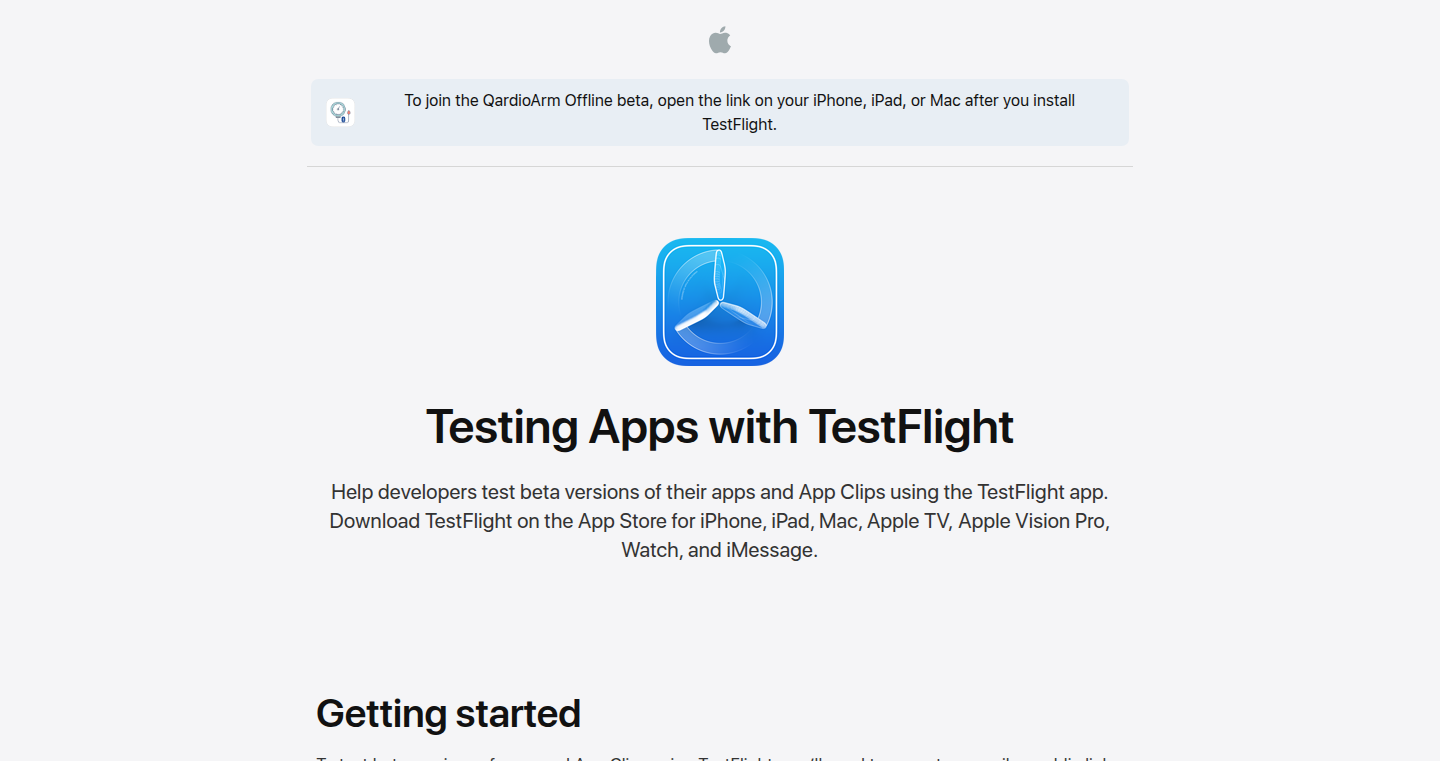
Author
dwardu
Description
This project is a testament to the ingenuity of developers! It's an app that breathes new life into QardioArm blood pressure monitors, devices that became useless when the company behind them went bankrupt. The creator reverse-engineered the communication protocols of the device, allowing users to bypass the defunct servers and continue using their monitors. This is a classic example of using code to solve a real-world problem, preventing electronic waste, and empowering users. So this means you can keep monitoring your health with a device you already own, even if the original company disappears.
Popularity
Points 2
Comments 0
What is this product?
This app is essentially a custom-built interface that talks directly to your QardioArm device. The original devices relied on Qardio's servers to store and process data. When the servers went down, the devices became useless. The app uses reverse engineering – figuring out how the device communicates with the world – to send commands and receive data, just like the original app did. The innovation here is finding a solution to a problem, utilizing existing hardware and preventing waste. So this means you can continue to use your blood pressure monitor without being locked into a single company's ecosystem.
How to use it?
Developers can't directly 'use' this in their projects in a typical way, but they can be inspired by its approach. The app demonstrates the power of reverse engineering and protocol analysis, which can be applied in various fields such as IoT security, device interoperability, and hardware hacking. If you are a developer dealing with a device that relies on a closed system, you can potentially learn from this project's approach. So this means developers can learn how to build bridges to existing devices, offering them continued functionality.
Product Core Function
· Data Acquisition: The app retrieves blood pressure readings and other health metrics directly from the QardioArm device. This function is achieved by decoding the communication protocol between the device and the original server. This allows users to see their readings in real-time. So this means you have immediate access to your health data.
· Data Storage: The app stores the acquired health data locally, providing a record of blood pressure readings over time. This functionality replaces the server-side storage provided by Qardio, ensuring data privacy and continued access. So this means you can track your health progress without depending on external servers.
· User Interface: The app offers a user-friendly interface for displaying the health data and managing device settings. This ensures that users can easily visualize their readings and configure their device. So this means that you can easily understand your health data.
· Protocol Reverse Engineering: The core technology is the reverse engineering of the device’s communication protocol. This involves analyzing the data transmitted between the device and the server to understand the commands and responses. So this allows the developers to access the data and bypass the server
Product Usage Case
· Restoring Device Functionality: The primary use case is to allow users to continue using their QardioArm devices even after the original company's services were discontinued. This ensures that users aren't forced to discard their devices or purchase new ones. So this means you can continue using your hardware.
· Data Privacy and Control: By locally storing the health data, the app provides users with complete control over their personal information, eliminating the need to send data to external servers. So this means you have complete control over your health data.
· Preventing Electronic Waste: The app extends the lifespan of the QardioArm devices, preventing them from becoming e-waste. This has a positive environmental impact. So this means you are contributing to the reduction of e-waste by reusing existing hardware.
· Learning and Experimentation: Developers can learn about device communication protocols by analyzing the app’s code, which is a good example of how to approach reverse engineering a device. So this means that you can learn about device communication and create your own solutions.
59
SubSlayer: Subscription Tracker & Savings Simulator
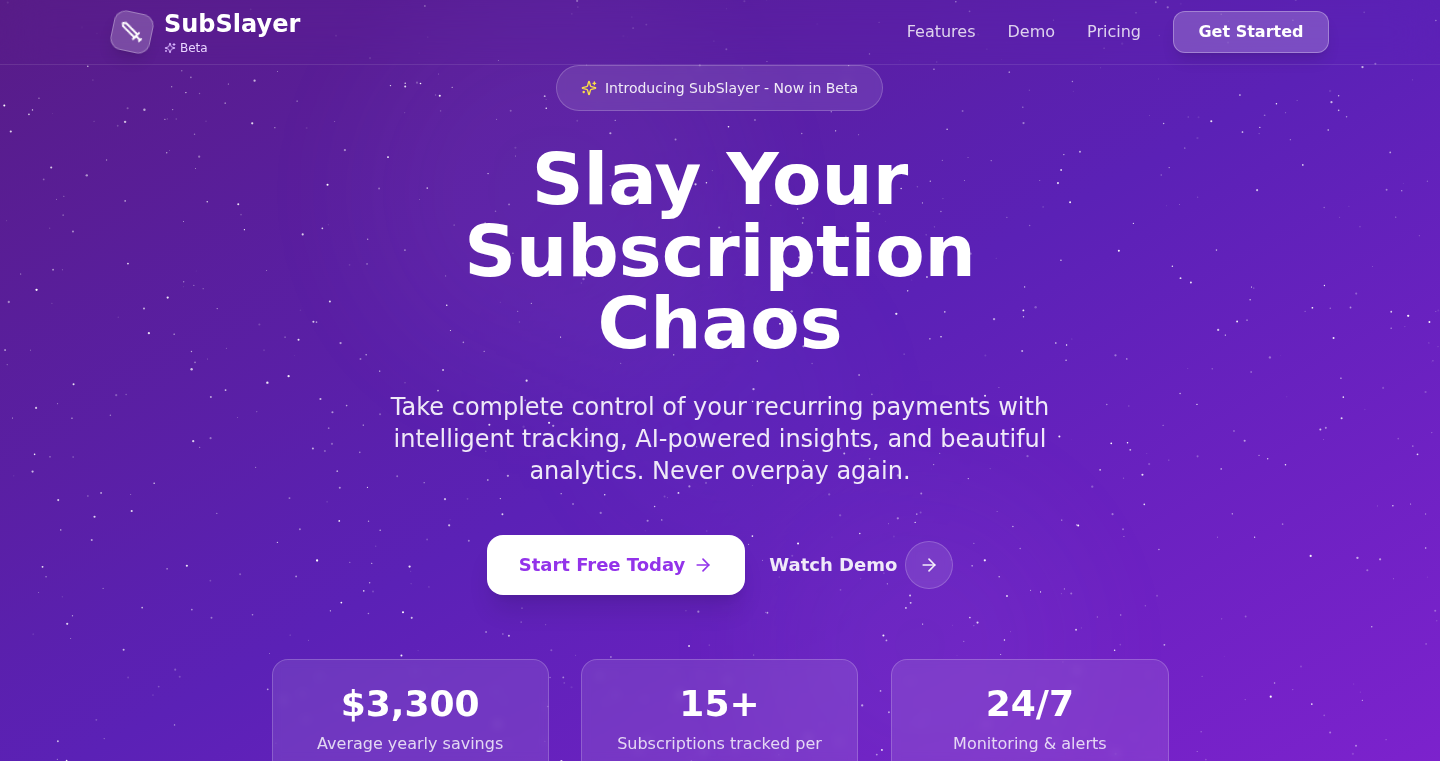
Author
danteocualesjr
Description
SubSlayer is a tool designed to help you manage your digital subscriptions effectively and save money. It tackles the common problem of forgotten or underutilized subscriptions by providing a centralized platform to track active subscriptions, set reminders for cancellations, and simulate potential savings. The core innovation lies in its focus on user awareness and financial control over digital spending, offering a practical solution for individuals struggling to manage their online subscriptions.
Popularity
Points 2
Comments 0
What is this product?
SubSlayer is essentially a digital subscription manager. It works by allowing you to input your active subscriptions, their costs, and renewal dates. The system then tracks these subscriptions, sends you reminders before renewal, and even helps you calculate how much money you could save by canceling unwanted subscriptions. Think of it as a personal finance tool specifically tailored for the digital age. The innovation is in its simplicity and focus on a very specific, and often overlooked, area of personal finance – the management of online subscriptions. So this helps me track where my money is going and save money.
How to use it?
Developers can use SubSlayer to integrate it into their own personal finance applications or build similar tools. This can be achieved by analyzing the methods SubSlayer uses to gather and present subscription information. Understanding its data structure, reminder system, and savings simulation logic can offer valuable insights for creating comparable applications. Developers could also use SubSlayer as a starting point for building more advanced features like automatic subscription analysis or integrations with other financial platforms. So this allows me to build my own subscription management tools or integrate its features into existing apps.
Product Core Function
· Subscription Tracking: Allows users to input and track all their active subscriptions, providing a centralized view of their digital spending. This helps to avoid overlooked charges and provides better control over finances. So this helps me visualize all my subscriptions in one place.
· Cancel Reminders: Sends users timely reminders before subscription renewal dates. This prevents unwanted charges and gives users ample time to decide whether to continue the service. So this makes sure I don’t accidentally pay for services I don't want.
· Savings Simulation: Simulates how much money users could save by canceling specific subscriptions. This feature motivates users to evaluate their subscriptions and make informed decisions. So this shows me potential savings and makes me more aware of my spending.
· User-Friendly Interface: The app likely offers a clear and intuitive user interface, making it easy to manage subscriptions without requiring technical expertise. So this ensures the tool is easy to use and understand.
Product Usage Case
· Personal Finance Application: Developers can integrate SubSlayer's features, such as subscription tracking and reminder settings, into a larger personal finance application, offering users a more comprehensive financial management tool. This could, for example, allow me to keep track of subscriptions alongside all my other finances, and get a holistic view of my spending.
· Subscription Management Service: A developer could use SubSlayer's design to build a dedicated subscription management service, similar to the original app, to help people track and manage their subscriptions efficiently. This would provide a focused solution for managing subscriptions across various platforms. This allows me to focus on building a specific solution for subscription management and provide real value to users.
· API Integration: Developers could potentially use an API (if available) to integrate subscription data into dashboards or financial analysis tools. This is useful to create customized reports to track spending patterns, identify potential savings, and make more informed financial decisions. This allows me to access my subscription data and customize it with my own needs and analysis tools.
60
Proread: AI-Powered Conversation Mapper
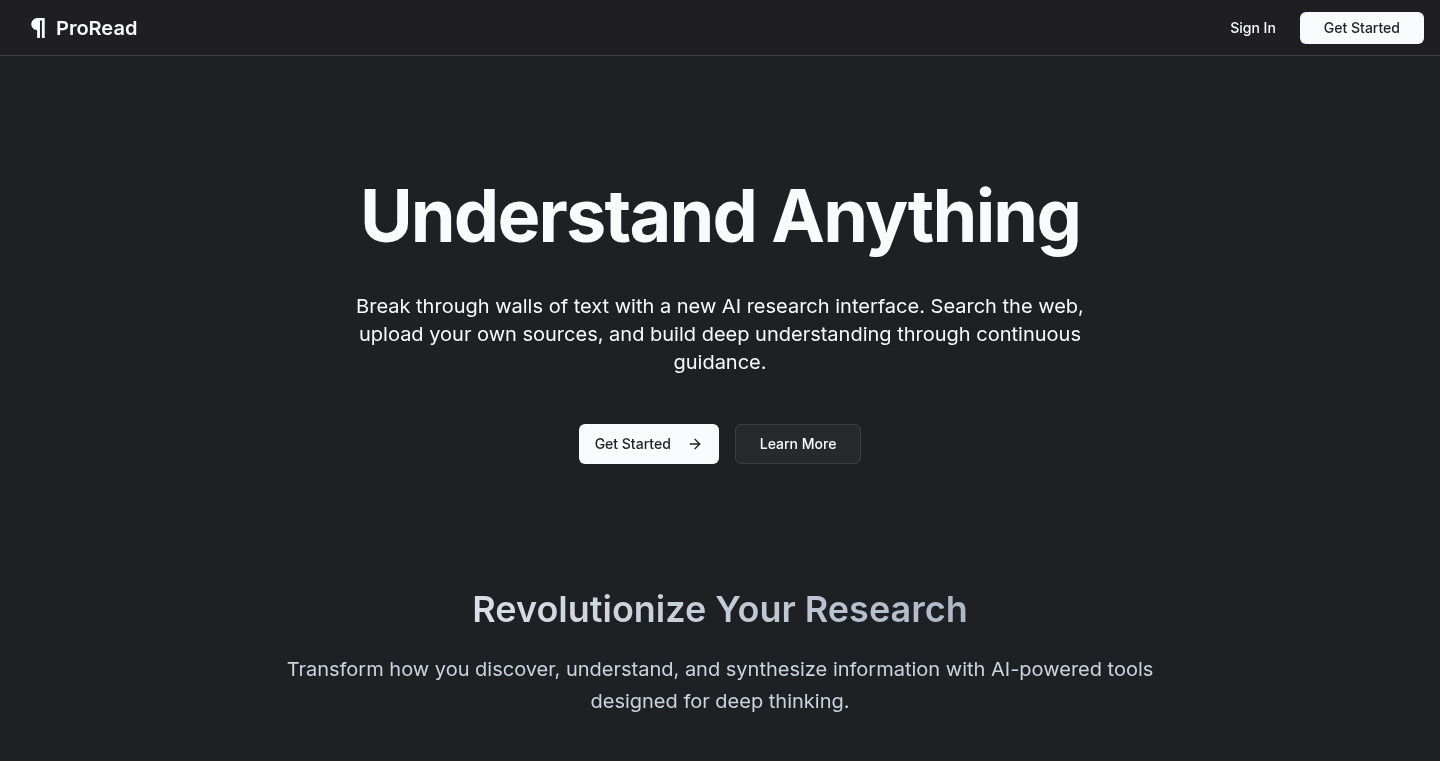
Author
kanodiaashu
Description
Proread is an AI-powered tool designed to help you navigate complex conversations with large language models (LLMs). It creates a visual map of your chats, allowing you to easily backtrack, recall information, and resume conversations across different sessions. The core innovation lies in the AI agent that continuously analyzes and organizes your chat history, making it easier to understand and retain knowledge from LLM interactions. So, this helps you truly understand the complex topics discussed in your AI chats, instead of getting lost in the conversation.
Popularity
Points 2
Comments 0
What is this product?
Proread is like a smart assistant for your LLM chats. It uses an AI agent to continuously monitor and understand your conversations. As you chat, the AI agent builds a map of the topics discussed, the questions asked, and the answers received. This map lets you easily jump back to any point in the conversation, search for specific information, and even upload documents to be analyzed alongside your chat history. The innovation is in this automated mapping process, which turns a simple chat into an organized and searchable knowledge base. So, you can actually keep track of what you learned in your AI chats, which is crucial for deeper understanding and research.
How to use it?
You would interact with Proread through a user-friendly interface, likely integrated with your existing LLM chat platform (e.g., ChatGPT, Bard, etc.). You start by initiating a chat session, and Proread's AI agent begins mapping the conversation in real-time. You can then navigate the map, view summaries, search for keywords, and access documents relevant to your discussion. To use it, you'd integrate it into your chat workflow, treating Proread as your personal knowledge organizer for LLM interactions. So, you can easily review and build upon your previous AI chats.
Product Core Function
· Real-time Conversation Mapping: The AI agent continuously analyzes your chat, identifying key topics, questions, and answers. This is valuable because it automatically organizes your conversation into a structured format, making it easy to understand the flow of information. Imagine you're exploring a complex subject with an LLM; this feature ensures you don't lose track of the different aspects of the topic.
· Backtracking and Recall: Easily jump back to any point in the conversation to review previous exchanges. This is useful for revisiting specific information, verifying details, and clarifying misunderstandings. If you want to double-check the conclusions made by your AI assistant on a complex subject, this is how you do it.
· Multi-Session Support: Proread saves your chat maps and allows you to resume conversations across different sessions. This enables you to pick up where you left off, even after closing the chat. This helps to track the complete history of your research on any given topic.
· Document Upload and Search: Upload documents related to your chat topic and search for information within both the documents and the conversation history. This empowers you to leverage your own data in addition to the LLM's knowledge. This lets you easily cross-reference your own data with the AI's output, making your research more thorough.
· AI-Powered Summarization: Proread could provide automatic summaries of key topics and conversations within the chat. This helps you quickly grasp the main ideas and concepts discussed. So, you can get a quick overview of a complex topic, saving you time and effort.
Product Usage Case
· Academic Research: A researcher uses Proread to explore a scientific topic with an LLM. They upload research papers related to the topic, chat with the LLM, and Proread maps the conversation, allowing them to easily find relevant information and references within both the chat and the documents. It allows a more effective use of LLMs for research.
· Technical Troubleshooting: A software developer uses Proread to troubleshoot a complex coding issue with an LLM. They ask questions, receive code snippets, and Proread maps the conversation. They can then easily backtrack to specific troubleshooting steps and code examples. This speeds up the debugging process.
· Learning and Skill Development: A student uses Proread to learn about a new subject with an LLM. They explore different concepts, ask questions, and Proread maps the conversation. They can then review the map to solidify their understanding and build a comprehensive knowledge base of the subject. This improves learning efficiency.
61
EveLock: The Privacy-Focused Offline Period Tracker
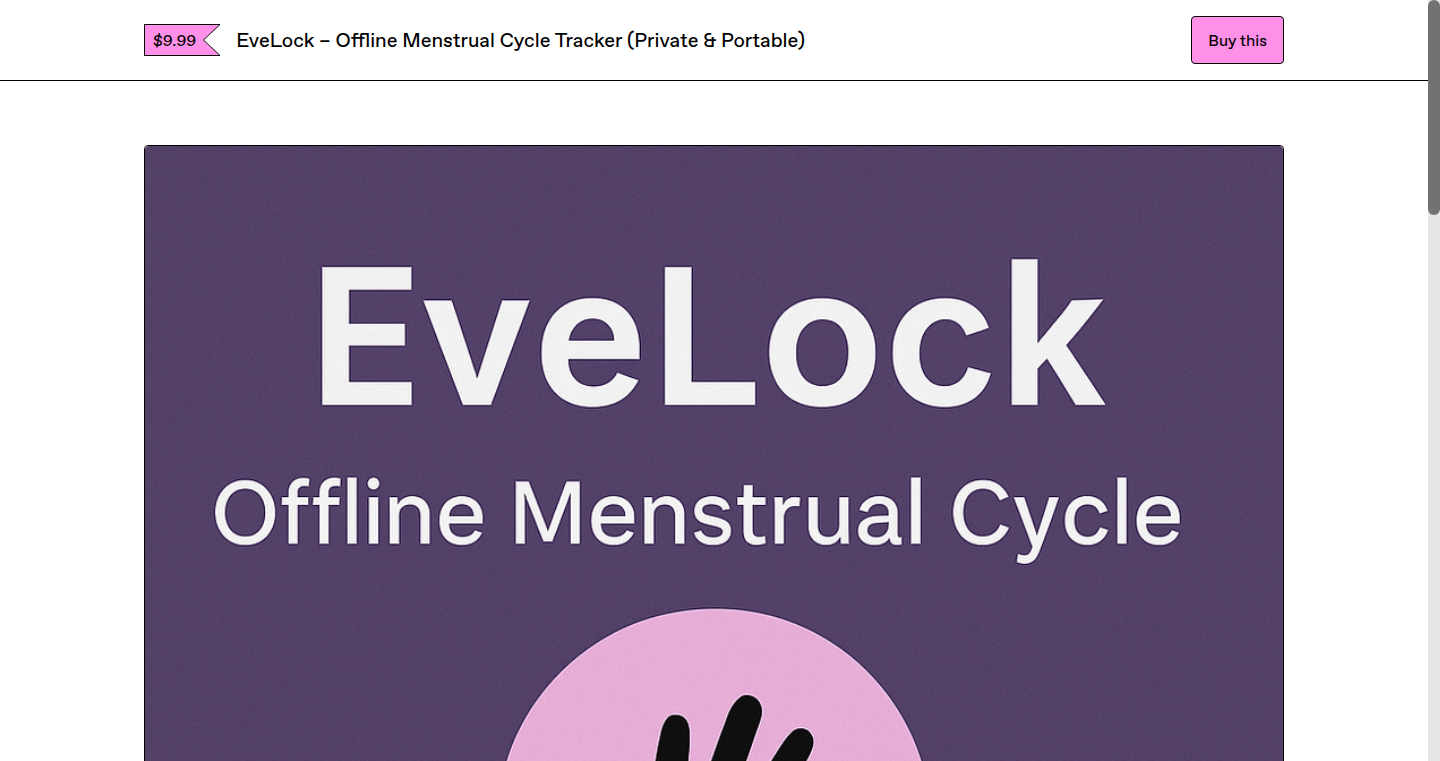
Author
kian_sage
Description
EveLock is a browser-based application designed for tracking menstrual cycles entirely offline, without requiring any cloud storage or account creation. It addresses the privacy concerns associated with traditional period tracking apps by ensuring user data remains local and secure. The project offers a lightweight, easily deployable solution (just unzip and run the index.html file), providing one-click PDF export for data backup. This embodies a commitment to user privacy and control over personal health information. So this is useful because it gives you complete control over your period data, keeping it private and accessible without depending on the internet or a third-party service.
Popularity
Points 1
Comments 1
What is this product?
EveLock is essentially a website that you can download and run on your computer or phone's web browser without needing the internet. The core technology is a 'Progressive Web App' (PWA), meaning it can function like a native app but is built using web technologies (HTML, CSS, JavaScript). It uses local storage in your browser to securely save your data, ensuring no data is sent to external servers. The innovation lies in its focus on privacy and offline functionality. Instead of relying on the cloud, it keeps your data locally, protecting it from potential data breaches or unwanted tracking. The PDF export function is also a key feature for easily backing up your data and sharing it if needed. So this means your personal health information stays private and in your control.
How to use it?
To use EveLock, you simply download the zip file, unzip it, and open the 'index.html' file in your web browser. No installation is needed, and it works on both mobile and desktop devices. You can then enter your period dates, symptoms, and other relevant information. The app will then predict your next period and ovulation dates. Data is stored locally in your browser, and you can export the data as a PDF file for easy backup. This is useful for anyone who wants a private and easily accessible method for tracking their periods.
Product Core Function
· Offline Data Storage: The core function is the ability to store user data (period dates, symptoms, etc.) locally within the user's browser. This ensures data privacy and eliminates the need for an internet connection to access the tracking information. This is incredibly valuable for users concerned about data security and those with limited internet access.
· Period and Ovulation Prediction: EveLock uses algorithms to predict future periods and ovulation cycles based on the entered data. This feature is useful for planning purposes and provides users with valuable insights into their cycle. The benefit is that you get automated insights without needing any account.
· One-Click PDF Export: The ability to export data as a PDF allows users to easily back up their data and share it with healthcare professionals if needed. This is a practical solution for ensuring data security and provides a flexible way to access and manage the tracked information. This empowers users to have a portable and shareable record of their health information.
· Browser-Based PWA: Leveraging the Progressive Web App (PWA) technology allows EveLock to function seamlessly across various devices (desktop and mobile) and operating systems without the need for separate app installations. The benefit is broader accessibility and a consistent user experience across different platforms.
Product Usage Case
· Data Privacy Scenario: A user concerned about data privacy chooses to use EveLock. They don't want their period data stored on a cloud server that could be vulnerable to hacking. EveLock provides a secure solution because all the data is stored locally on the user's device. So this helps maintain user privacy.
· Offline Access Scenario: A user frequently travels and wants to track their period cycle even when they don't have internet access. EveLock works perfectly in this situation because it's designed to function entirely offline. This ensures that the user can always access and update their tracking data regardless of their location.
· Data Backup and Sharing Scenario: A user wants to share their period tracking data with their doctor. EveLock's one-click PDF export feature allows the user to easily create a backup of their data and share it in a readable format, simplifying communication with healthcare professionals. This simplifies sharing health information.
62
PassiveCraft: AI-Powered Content Monetization Engine
Author
errabehy
Description
PassiveCraft is a SaaS platform that uses AI to automatically transform social media content (text, images, videos) into sellable digital products like ebooks, courses, and templates. It aims to solve the common problem of content creators struggling to monetize their existing online presence without needing to be tech experts or spend a lot of time. The key innovation is its AI, which analyzes content from platforms like YouTube, Facebook, TikTok, and Instagram to understand its value and structure it into ready-to-sell digital formats, minimizing manual work for creators.
Popularity
Points 2
Comments 0
What is this product?
PassiveCraft is a smart platform that helps content creators make money from their existing content. It uses AI to understand what's valuable in their social media posts (videos, pictures, text) and then turns it into things they can sell, like ebooks or online courses. The AI does all the hard work of analyzing and restructuring the content. So, if you're a creator, it's like having a robot assistant that helps you turn your social media into a business.
How to use it?
Content creators can use PassiveCraft by connecting their social media accounts (YouTube, Facebook, TikTok, Instagram). The AI then analyzes their content, identifies key themes and information, and suggests how to package it into a digital product. They can then customize the product, set a price, and sell it. This is done through a simple interface, requiring minimal technical skills. This is useful for anyone with a social media presence who wants to create an additional income stream.
Product Core Function
· AI-Powered Content Analysis: The core of PassiveCraft. This uses smart algorithms to scan content from social media platforms. It looks at your posts, videos, and everything else to figure out what the main points are. So, this is useful if you want to automatically understand and extract valuable information from your social media content.
· Automated Digital Product Creation: Taking the insights from the content analysis, the AI automatically creates digital products. It can convert your content into ebooks, online courses, templates, or premium content bundles, saving you the time and effort of manual product creation. So, this is useful if you want to quickly create and sell digital products based on your existing content.
· Multi-Platform Integration: It can analyze content from major social media platforms like YouTube, Facebook, TikTok, and Instagram. This gives creators flexibility to leverage their content from different places. So, this is useful if you use multiple platforms and want to monetize your content across them.
· Streamlined User Experience: PassiveCraft focuses on ease of use. Its simple interface lets creators easily connect accounts, create products, and sell them. So, this is useful if you want a user-friendly system that doesn't require any technical expertise to monetize content.
· Customization Options: PassiveCraft will allow users to customize the generated products. Users will likely be able to edit the AI-generated content, change the layout, and add their own branding. So, this is useful if you want to ensure your brand and your personal touch are reflected in your digital products.
Product Usage Case
· A fitness influencer can use PassiveCraft to turn their workout videos and nutrition tips into a digital ebook or a premium fitness course, giving their audience a structured way to consume their expertise and providing a new revenue stream. So, this is useful if you are an expert in a specific area with a lot of content to be reused into products.
· A travel blogger can convert their Instagram photos and travel stories into a guide or a set of templates, like a packing list or itinerary, which can be sold to their followers. So, this is useful if you are a content creator with a large audience and want to create digital products in a straightforward way.
· An educational YouTuber can utilize PassiveCraft to transform their video scripts and supporting resources into a bundled online course, accessible for paid subscribers. So, this is useful if you are a teacher or educator and want a more effective way to deliver and monetize your lesson materials.
63
Shuruka Boxing - First Person Boxing Game with Physics-Based Combat
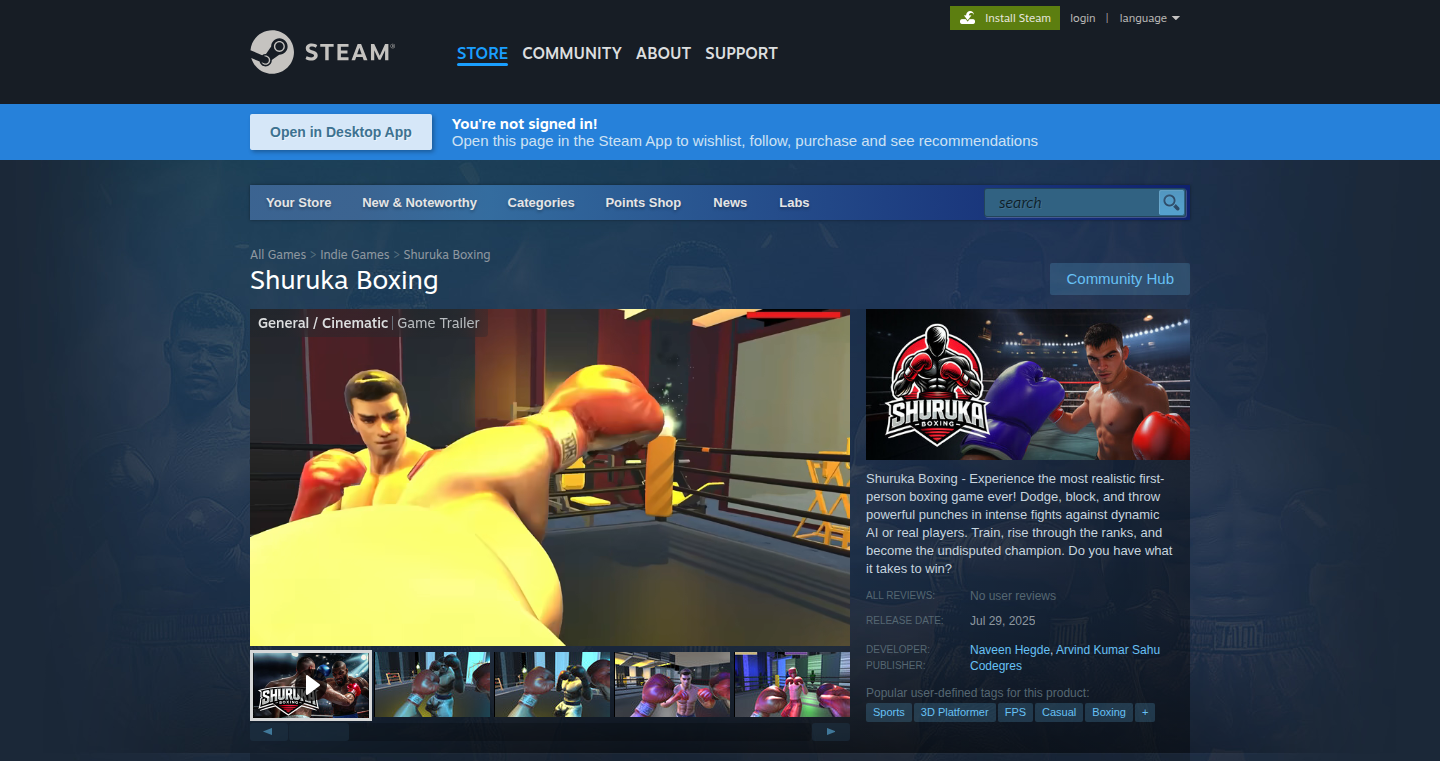
Author
Codegres
Description
This is a first-person boxing game developed using advanced physics simulation. The innovation lies in using physics engines to create realistic boxing interactions, where punches, blocks, and movements are all governed by simulated forces. It addresses the challenge of creating immersive and realistic combat experiences in a game, offering a more engaging and dynamic gameplay compared to traditional, animation-based boxing games.
Popularity
Points 1
Comments 0
What is this product?
Shuruka Boxing is a first-person boxing game. It sets itself apart by employing a physics engine to simulate the physical interactions of boxing. Instead of relying on pre-defined animations, the game's core mechanics – from punches landing to defensive blocks – are calculated using physics principles. This means that the way punches connect, the impact they have, and the player's movement are all realistically influenced by the physics model. This leads to more dynamic and unpredictable gameplay. So, this is useful because it provides a more realistic and interactive boxing experience than games that rely on animation.
How to use it?
Developers can use the underlying physics principles and game logic as a reference for building their own physics-based combat systems or games. They can study the code and implementation details to understand how to use physics engines for creating realistic interactions. This can be applied to other genres, such as fighting games, wrestling games, or any game where physical interactions are key. So, this is useful because it can serve as an educational example and a starting point for developing similar types of games.
Product Core Function
· Physics-Based Combat: The core of the game relies on a physics engine (likely something like PhysX or Bullet) to model the impact of punches, blocks, and player movement. This creates a more dynamic and unpredictable gameplay experience. So, this is useful because it allows the game to feel more realistic and responsive, making the boxing matches more engaging.
· First-Person Perspective: The game is viewed from the player's perspective, enhancing immersion. So, this is useful because it puts the player directly into the action, allowing for a greater sense of presence and control.
· Realistic Motion and Collision: The game models how punches and blocks work, so the motion and collision feel more accurate. So, this is useful because it provides a more satisfying combat experience.
· AI Opponents: The game features AI opponents that react to the player's actions. So, this is useful because it gives players someone to fight against and provides a more challenging and engaging gameplay experience.
Product Usage Case
· Creating Realistic Fighting Mechanics: Developers looking to create a fighting game can learn from Shuruka Boxing's approach to simulating punches and blocks. They could apply similar physics principles to design more realistic combat interactions. So, this is useful because it helps in developing more immersive fighting games.
· Improving Game Feel: Game developers can study the way Shuruka Boxing uses physics to create a responsive and satisfying feel. They can incorporate similar techniques into their projects to improve the overall experience. So, this is useful because it enhances the player experience by creating a better feel.
· Developing Educational Tools: Educators in the field of game development can use Shuruka Boxing as a practical example for teaching physics-based game mechanics and development. So, this is useful because it gives game development students a real-world example of how to implement physics.
64
Instant Image Forge: A Real-time Image Generation Engine
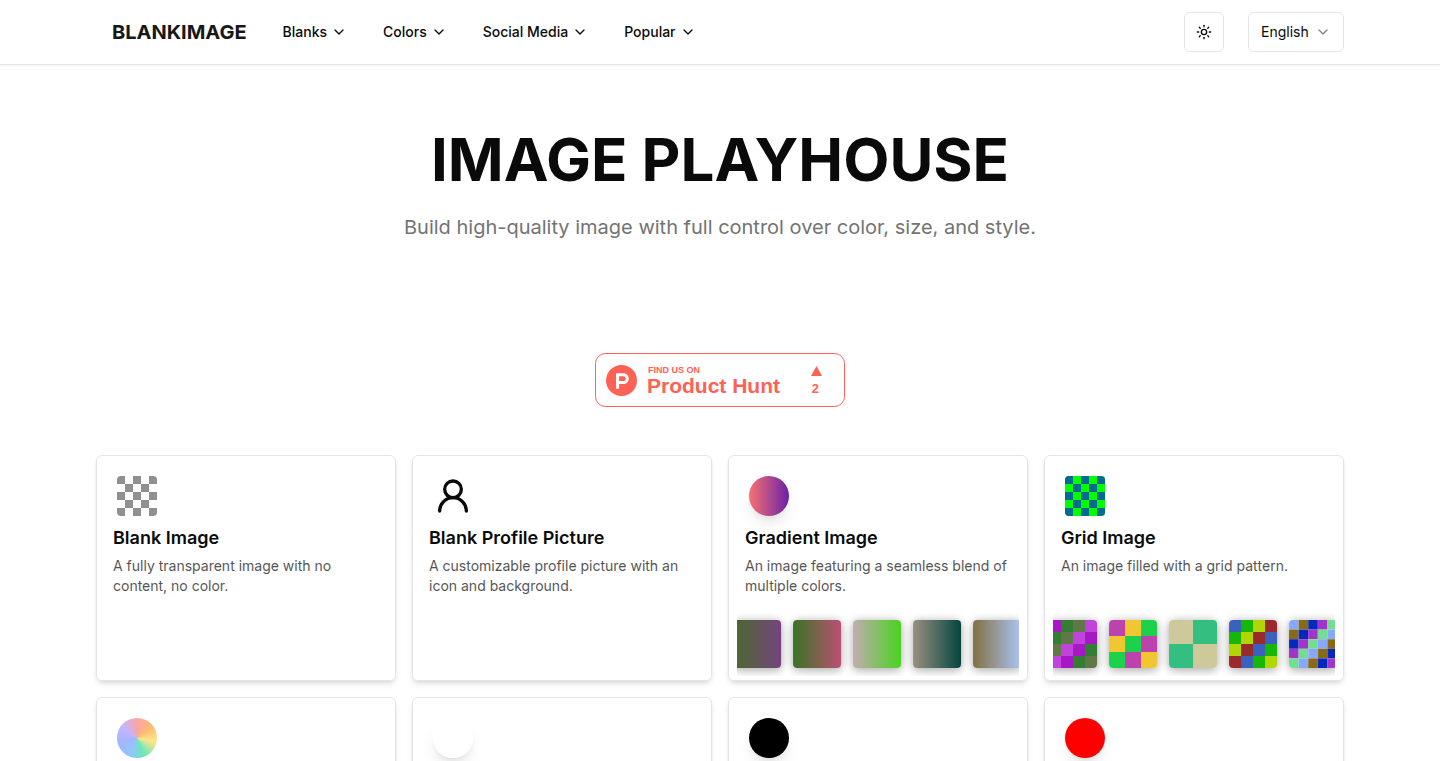
Author
dassh
Description
This project is a web tool that instantly creates various image types, including transparent PNGs, solid color images, gradients (linear, radial, conic), and grid patterns. It provides real-time preview, custom dimensions, and is designed for immediate image generation. The innovation lies in its speed and flexibility, allowing developers and designers to quickly generate placeholder images, social media templates, and custom visual elements on the fly. It solves the common problem of needing quick, adaptable images for design and development, eliminating the need for complex image editing software for simple tasks.
Popularity
Points 1
Comments 0
What is this product?
This is a web application that utilizes client-side technologies like JavaScript and HTML5's Canvas element to dynamically generate images in real-time. Users can specify parameters such as image dimensions, color, gradient styles, and grid patterns. The application then renders the image directly in the browser, allowing for immediate preview and download. The core innovation is the real-time generation of diverse image formats, simplifying the process of creating visual assets without requiring external tools or servers. So this is useful because you can rapidly create images without going through the hassle of opening up a design tool every time.
How to use it?
Developers can integrate this into their workflows through direct usage of the web application or by leveraging its functionalities programmatically. It's ideal for generating placeholder images in web development, creating social media templates with dynamic sizing, generating unique phone wallpapers, or dynamically creating visual elements for various applications. To use it, you'd simply visit the web app, adjust the settings to match your needs (dimensions, colors, gradients etc.), and then download the resulting image. Developers can potentially embed the image generation functionalities into their own web applications using API integration (if available) or by manually incorporating the front-end code. So, you can use this to quickly create the assets you need for your next project.
Product Core Function
· Transparent PNG Generation: Allows the creation of images with a transparent background, essential for layering images in design and web development. It is useful for creating logos, icons, and other graphical elements that need to blend seamlessly into different backgrounds.
· Solid Color Image Generation: Provides the ability to generate images with a single color, useful for creating backgrounds, simple graphical elements, or placeholders. This is valuable for prototyping designs and quickly visualizing content.
· Gradient Image Generation (Linear/Radial/Conic): Enables the creation of images with gradient effects, adding visual depth and style. Useful for creating backgrounds, buttons, and other UI elements, making them more visually appealing.
· Grid Pattern Generation: Allows for the generation of grid patterns within the image, useful for creating visual guides, textures, or patterned backgrounds. Helpful for designers who need structured visuals.
Product Usage Case
· Placeholder Image Generation for Web Development: Used in a development workflow to quickly generate images for placeholders or mockups, avoiding the need for external design tools during the early stages of a project. This speeds up the design process.
· Social Media Template Creation: Creating templates with specific dimensions and branding, automating the process of generating social media posts and content. This is a game changer for marketing teams.
· Custom Wallpaper Generation: Generating unique phone wallpapers with custom colors, gradients, and patterns. Users can tailor their device's aesthetics in real-time.
65
BranchLLM: Git-Inspired Branching for Large Language Models
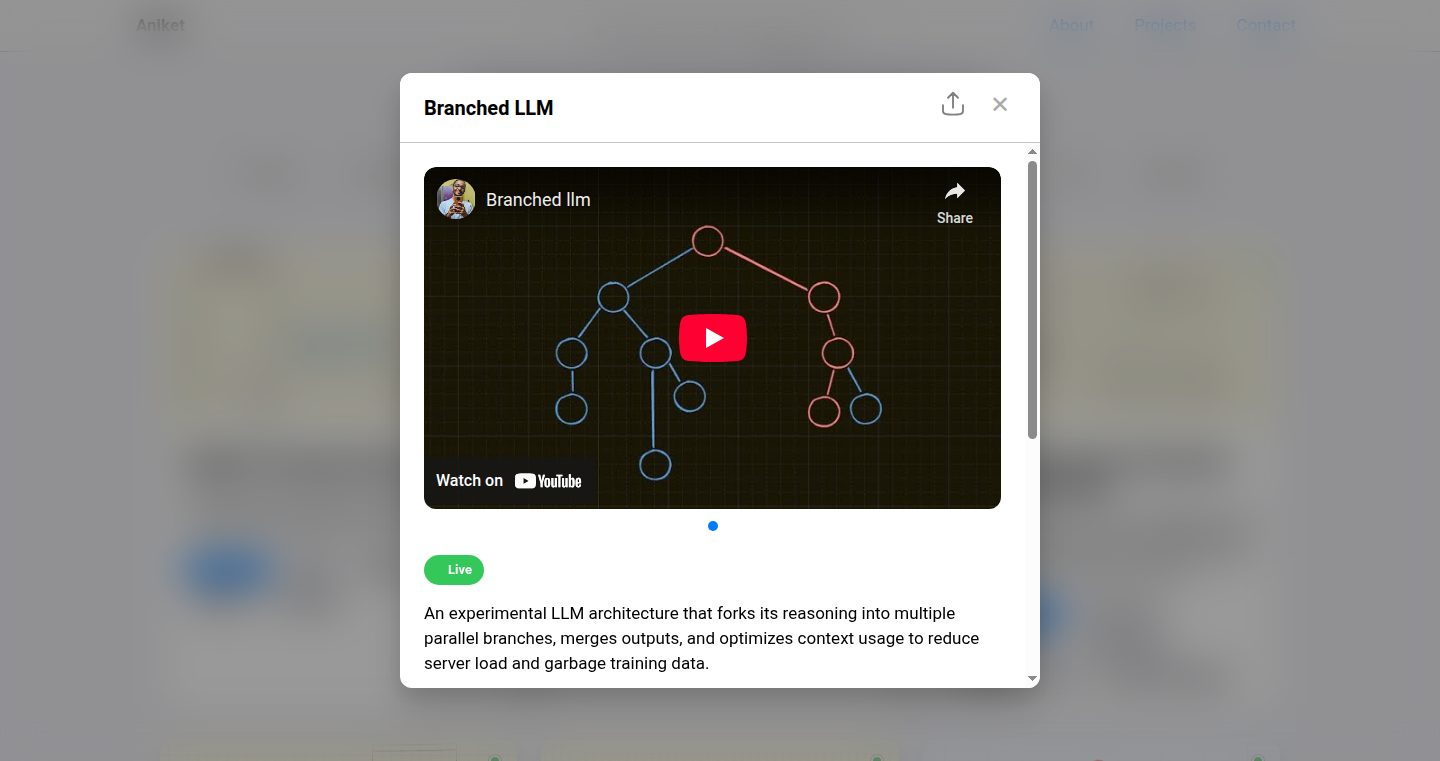
Author
aniket-gupta
Description
BranchLLM introduces a novel approach to managing and evolving Large Language Models (LLMs) by implementing a Git-style branching system. This allows developers to create isolated branches of an LLM, experiment with different configurations, and merge changes back into the main model. The core innovation lies in enabling parallel experimentation and version control for LLMs, addressing the challenges of iterative development and collaboration in the LLM space.
Popularity
Points 1
Comments 0
What is this product?
BranchLLM is like Git for your LLMs. Instead of just updating a model, you can create copies (branches) of it, make changes without affecting the original, and then decide whether to incorporate those changes. It helps developers try out different ways to improve their LLMs and keeps track of every change.
How to use it?
Developers can use BranchLLM by leveraging its command-line interface (CLI) or integrating it into their existing LLM development workflows. You can create a branch from your base LLM, customize it with different training data or fine-tuning methods, and evaluate its performance. If the changes are beneficial, you can merge them back into the main model; otherwise, you can discard the branch. This offers a controlled and auditable process for LLM evolution.
Product Core Function
· Branching: Create independent copies of your LLM, enabling parallel experimentation without impacting the core model. So this lets you test new ideas without risking breaking your existing model.
· Merging: Integrate changes from a branch back into the main LLM. This feature allows you to adopt successful experiments into your production LLM. So this helps you incorporate improvements without starting from scratch.
· Diffing: Compare different versions of an LLM to understand the changes made. This feature provides insights into the evolution of the LLM, enabling developers to track what's been changed and why. So this helps you understand the impact of your modifications.
· Committing: Save snapshots of the LLM's state at different points in time. This creates a version history of your LLM. So this gives you the ability to revert to earlier versions if something goes wrong.
Product Usage Case
· Fine-tuning: Developers can create separate branches for different fine-tuning approaches (e.g., using different datasets or training parameters). If a particular approach yields better results, they can merge the corresponding branch back into the main model. This is useful for improving model accuracy.
· A/B testing: Run multiple branches with slightly different LLM configurations to test which one performs better in real-world scenarios. So this helps optimize model performance.
· Collaboration: Multiple developers can work on different branches of the same LLM, making isolated changes and merging them later to share improvements with other team members. So this helps speed up team work on the same project.
· Rollback: In case a new version of the LLM introduces unwanted behavior, developers can easily revert to a previous version by checking out a specific commit. So this helps to ensure the stability of your models.
66
RemotelyGood.us - The Remote Job Board Reborn

Author
Theresa_i_a
Description
RemotelyGood.us is a job board specifically focused on remote work opportunities. It’s been relaunched after a recent feature in Forbes Magazine, indicating its success in the remote job market. The project leverages a simple yet effective approach to connect job seekers with remote positions, offering premium access with AI-powered career tools and daily job alerts. This project signifies a response to the increasing demand for remote work, providing a centralized platform to facilitate the connection between employers and remote employees. It helps solve the problem of finding and filtering remote jobs effectively, which can be a challenge with traditional job boards that often lack specific filters for remote work.
Popularity
Points 1
Comments 0
What is this product?
RemotelyGood.us is a website, a job board, that focuses on listing remote job opportunities. Its core innovation lies in its targeted focus and curated listings. Unlike general job boards, this site specifically caters to remote positions, which simplifies the search process for both job seekers and employers. The AI-powered career tools provide an added advantage, assisting users with resume building, interview preparation, and possibly even job matching. It is built to solve the problem of efficiently finding and filtering remote work, and this offers convenience and efficient access to remote working.
How to use it?
Developers (or anyone seeking remote work) can use RemotelyGood.us by visiting the website and browsing the listed jobs. The platform allows for easy searching and filtering of jobs based on various criteria. The premium access offers additional features such as AI career tools, which can be beneficial for resume optimization, interview prep, and personalized job recommendations. Developers can integrate this by simply using the site to find job postings, there is no direct API or SDK integration required.
Product Core Function
· Curated Remote Job Listings: This core feature provides a central location for finding remote job openings, saving users the time and effort of searching multiple platforms. So this is useful because it cuts down on the time spent searching and sifting through irrelevant job postings.
· AI-Powered Career Tools: This feature provides tools like resume optimization and interview preparation, assisting job seekers with their applications and interview processes. So this is useful because it helps job seekers to increase their chances of landing a job by improving their application materials and skills.
· Daily Job Alerts: This feature notifies users of new job postings daily, ensuring they do not miss relevant opportunities. So this is useful because it ensures job seekers stay updated with the latest job openings, increasing their chances of finding a suitable position.
Product Usage Case
· Job Search for Software Engineers: A software engineer looking for remote work can use RemotelyGood.us to quickly filter for relevant positions, saving them time and ensuring they see only remote opportunities. So, this provides a streamlined job search experience, allowing them to focus their energy on applying for the right roles.
· Remote Team Expansion: A company looking to hire remote developers can use RemotelyGood.us to find potential candidates who are specifically seeking remote work, streamlining the recruitment process. So, this provides a targeted platform, allowing them to connect with the right candidates faster and reducing the time spent on the hiring process.
67
QuickReport: CSV to Polished PDF Converter

Author
maxvmaximus
Description
QuickReport is a straightforward tool that transforms CSV files into well-formatted PDF documents without the need for complex spreadsheet software like Excel or Google Sheets. The core innovation lies in its ability to automate the formatting process, saving users significant time and effort. It addresses the common problem of quickly generating presentable reports from raw data that can be easily shared via email or other platforms. It uses React, Tailwind CSS, React-PDF, and Papaparse to achieve this.
Popularity
Points 1
Comments 0
What is this product?
QuickReport is a web-based application that takes a CSV file (a plain text format used to store data in a table) and automatically converts it into a professionally formatted PDF document. The project employs several key technologies. React is used for the user interface, making the application interactive and responsive. Tailwind CSS is used for styling, allowing for a clean and modern look. React-PDF is used for rendering the PDF, ensuring high-quality output. Papaparse is used to parse the CSV file. The innovation here is the automated transformation process, enabling users to quickly generate presentable reports. So this is useful for quickly creating shareable reports from data without needing to spend time manually formatting.
How to use it?
Developers can use QuickReport by uploading a CSV file through its web interface. The application then automatically formats the data and generates a PDF, which can be downloaded. Technically, developers can integrate QuickReport’s core functionality into their own applications, such as data analysis tools or reporting dashboards, by using its underlying libraries. For example, if you have a web application that generates data, you could use QuickReport’s logic to automatically create a PDF report when a user requests it. So this is useful for creating automated reporting features within your own projects.
Product Core Function
· CSV Parsing and Data Extraction: The application uses Papaparse to read and parse the CSV data, extracting information into a structured format. Value: Enables the system to accurately interpret and process raw data from CSV files. Application: Useful for any system that needs to ingest and work with data from CSV sources, such as importing customer lists or financial transactions.
· Automated Formatting: QuickReport automatically formats the data into a presentable layout suitable for PDF generation, addressing the need to spend time manually formatting the data in Excel. Value: Saves time and effort by handling the layout and formatting automatically. Application: Allows users to generate reports that look professional with minimal manual intervention, ideal for quick data analysis and report creation.
· PDF Generation: Utilizes React-PDF to create a PDF document from the formatted data. Value: Creates a standard, easily shareable format for data. Application: Allows the reports to be easily shared, printed, and viewed on different devices, crucial for disseminating information or data across platforms.
Product Usage Case
· Data Analysis Reporting: A data analyst receives a daily CSV file with sales figures. They upload the CSV to QuickReport and instantly get a formatted PDF report to share with the team. So this saves time and makes the report more presentable.
· Financial Reporting: A financial analyst uses QuickReport to generate monthly financial reports from CSV data exported from accounting software. The result is a clean, professional-looking PDF to share with stakeholders. So this streamlines the reporting process.
· Project Progress Reports: A project manager generates a report of project progress using data exported to CSV format. QuickReport creates a formatted PDF report that can be shared with the team. So this makes it easy to share project information and keep the team informed.
68
RentUp: A Landlord's Digital Assistant
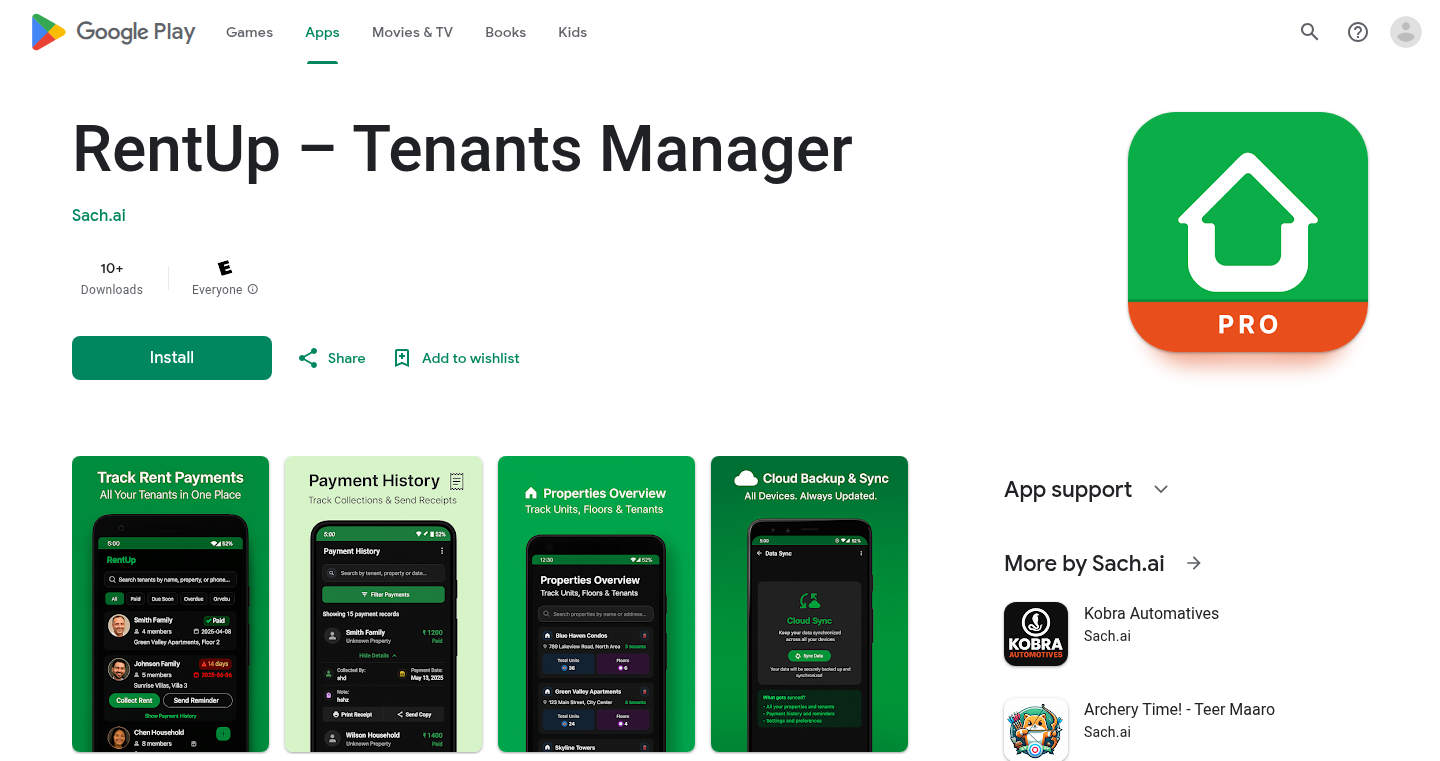
Author
Sachinrao
Description
RentUp is a mobile application designed to simplify property management, particularly for landlords who prefer user-friendly interfaces. It tackles the common pain points of juggling spreadsheets, missing tenant calls, and managing documents by offering a streamlined, color-coded rent tracking system, automated reminders, and a secure document storage. This project showcases a practical application of modern Android development technologies, emphasizing simplicity and ease of use for non-technical users. It addresses the technological gap by providing a tailored solution for a specific user group.
Popularity
Points 1
Comments 0
What is this product?
RentUp is a mobile app that acts as a digital organizer for landlords. It uses technologies like Kotlin and Jetpack Compose to create a visually clear and easy-to-understand interface. Firebase provides a secure backend for storing data and managing user authentication, and WorkManager handles tasks such as sending reminders even when the app isn't actively running. The innovation lies in combining these technologies to create a simple, accessible tool that minimizes the complexity often associated with digital property management, especially for those less familiar with modern apps. So this can help save time and avoid missed payments.
How to use it?
Landlords can use RentUp to track rent payments at a glance, with color-coded indicators highlighting overdue or upcoming payments. They can set up automated reminders for lease renewals, maintenance tasks, and tenant calls, ensuring they stay on top of their responsibilities. The app also includes a secure document vault to store important documents. This project can be useful for other developers by providing an example of how to build user-friendly mobile applications using modern Android technologies, and how to integrate backend services for data storage and authentication. For example, developers can use it to inspire them on how to implement a similar application to manage other kinds of subscriptions.
Product Core Function
· Color-coded Rent Badges: This feature visually represents the status of rent payments (paid, due, overdue), making it easy for landlords to quickly assess their financial status. This provides an immediate understanding of the financial status without needing to check complex spreadsheets. So this helps you stay organized and on top of payments.
· Automated Reminders: The app sends automatic reminders for leases, maintenance, and tenant calls. This leverages WorkManager in the background, ensuring that reminders are delivered even when the app isn't actively running. So this ensures you don't miss any important dates or appointments.
· Secure Document Vault with Biometric Lock: This provides a safe and secure place to store important documents related to the properties and tenants, and the biometric lock adds an extra layer of security to ensure documents are protected. So this keeps important documents safe and accessible only to authorized users.
· Offline Functionality & Guest Sign-in: The app works offline, allowing access to essential information even without an internet connection. Guest sign-in allows tenants to access specific functionalities without needing a full account. So this ensures that landlords can always access key information and that tenants have easy access when needed.
Product Usage Case
· A landlord with several rental properties can use RentUp to easily monitor rent payments. The color-coded badges instantly show which tenants have paid and which are overdue. The automated reminders then help the landlord to stay on top of lease renewals, maintenance tasks, and tenant calls, preventing missed appointments and potential problems. So this keeps everything in order.
· A property manager can streamline their workflow by using RentUp's document vault to securely store leases, inspection reports, and other essential files. The biometric lock protects sensitive information, while the offline capability ensures access to critical documents, even if there’s no internet connection. So this reduces the risk of lost paperwork and increase organization.
· A developer can use RentUp as a reference to learn how to use Firebase for user authentication and data storage. They can study the implementation of background tasks using WorkManager for sending reminders, and learn how to create a user-friendly UI using Kotlin and Jetpack Compose, so they are able to quickly prototype an application.
69
DF Embedder: Fast DataFrame to Vector DB Bridge
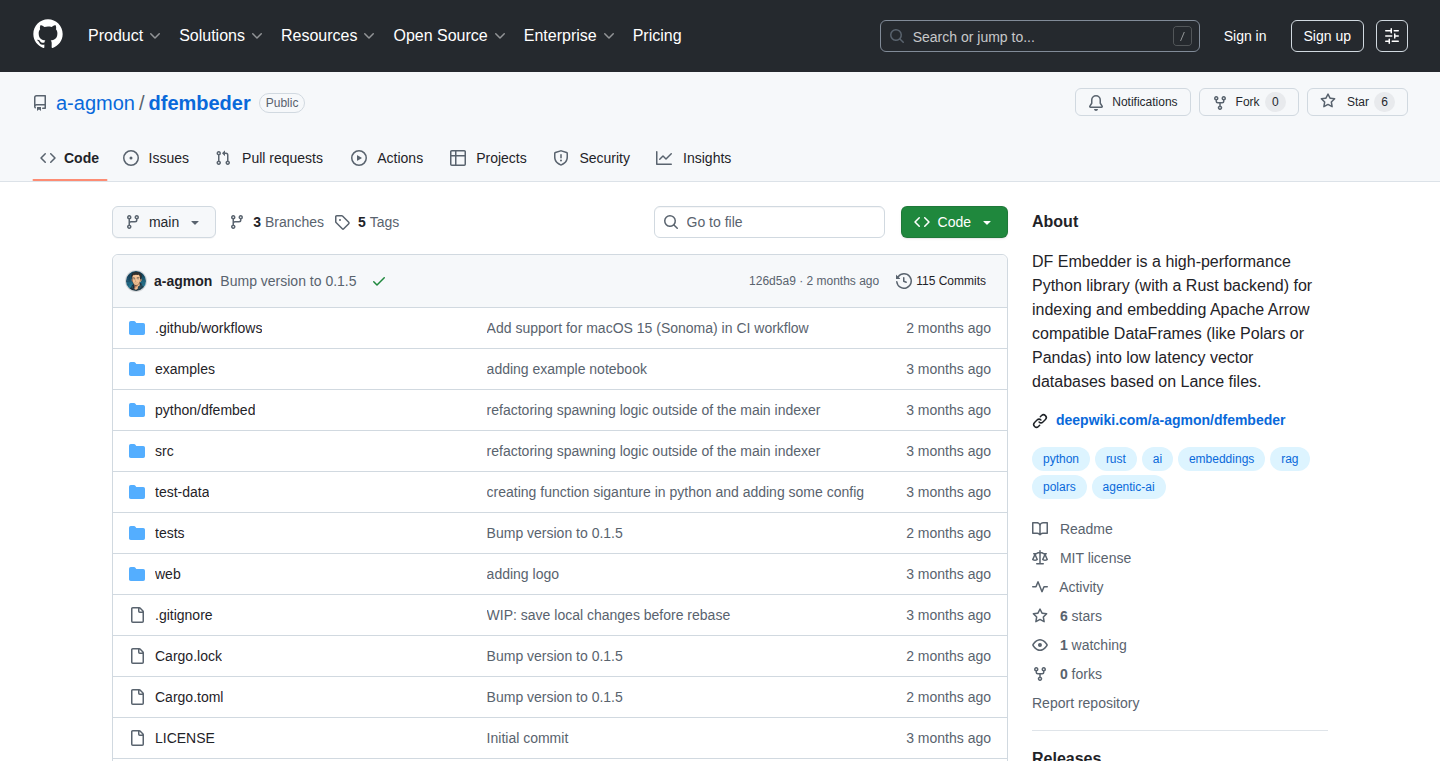
Author
alonagmon
Description
DF Embedder is a Python library, accelerated by Rust, that efficiently converts data stored in DataFrames (like those used by Pandas or Polars) into vector embeddings and stores them in low-latency vector databases using Lance files. This solves the problem of slow data loading and embedding generation when working with large datasets, enabling faster data analysis and machine learning workflows. It leverages the speed of Rust for core computations, providing a significant performance boost compared to purely Python-based solutions. So this helps me get faster insights from my data.
Popularity
Points 1
Comments 0
What is this product?
DF Embedder is a tool that takes your data organized in a DataFrame (think of it like a spreadsheet) and transforms it into a special numerical format called vector embeddings. These embeddings are then stored in a vector database, designed for fast searching and analysis of similar data points. The innovative aspect is the use of Rust, a fast and efficient programming language, to handle the computationally intensive tasks. This makes the process much quicker, especially for large datasets. So this lets me search and analyze data quickly.
How to use it?
Developers use DF Embedder by integrating it into their data pipelines. They would load their data into a DataFrame, specify the columns to embed, and then use DF Embedder to generate the embeddings and store them in a vector database. This integration is often done within data science or machine learning workflows. So this lets me easily incorporate vector search into my project.
Product Core Function
· DataFrame to Embedding Conversion: This is the core function. It takes the data from a DataFrame and turns it into vector embeddings. The value is that it allows you to represent complex data in a way that's suitable for similarity searches, enabling applications like recommendation systems or semantic search. So this is helpful for finding similar data points.
· Lance File Integration: DF Embedder uses Lance files, a file format optimized for storing and querying vector embeddings. This means faster data loading and retrieval. The value is in the performance gain, especially when working with large datasets, as it directly translates to quicker query results. So this allows for faster data retrieval.
· Rust Backend for Performance: The use of Rust provides a significant performance boost compared to using only Python. This is especially important for computationally heavy tasks like generating embeddings and handling large data volumes. The value is in the speed and efficiency, allowing faster data processing and analysis. So this ensures that my data processing is super-fast.
Product Usage Case
· Building a recommendation engine: A developer can use DF Embedder to convert product data (e.g., descriptions, features) into embeddings, store them in a vector database, and then find products with similar embeddings to recommend to users. The value is improved recommendation accuracy and speed. So this helps me build a better recommendation engine.
· Semantic search for documents: A developer can embed text documents and use DF Embedder to quickly search for documents that are semantically similar to a given query. The value is fast and accurate information retrieval, allowing users to find relevant information efficiently. So this allows me to build search engines that understand the meaning of my text.
· Image or video similarity search: A developer can extract features from images or videos, convert them to embeddings using DF Embedder, and then search for similar images or videos based on their embeddings. The value lies in enabling applications like content-based search and duplicate detection. So this is useful for finding similar images or videos quickly.
70
YouTube Podcast to MP3 Converter
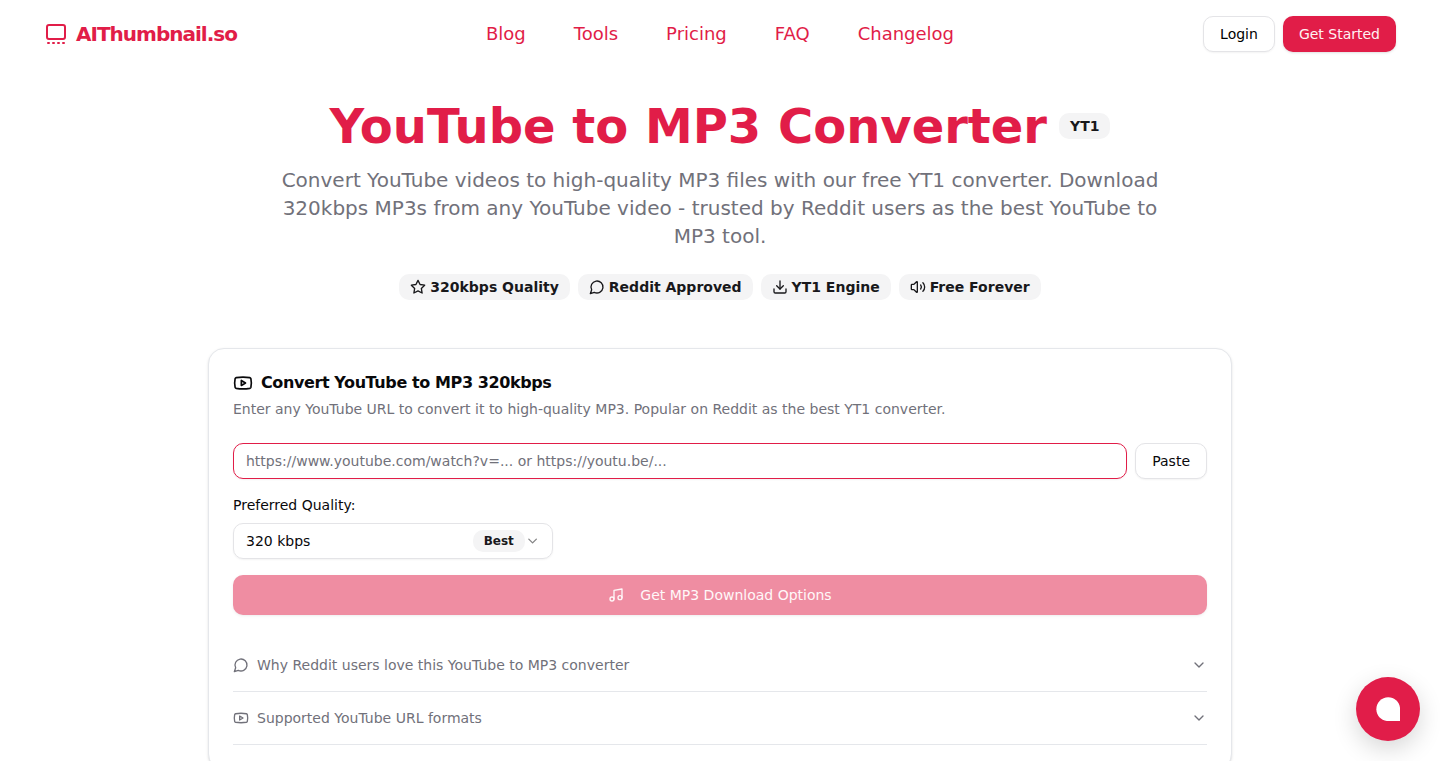
Author
sachou
Description
This project is a free tool that converts long YouTube podcast videos into MP3 audio files. The core innovation lies in its ability to automatically extract audio from lengthy YouTube videos, enabling users to easily listen to podcasts on the go or in the background. It solves the problem of manually downloading and converting YouTube videos, streamlining the process for content creators and consumers.
Popularity
Points 1
Comments 0
What is this product?
This tool utilizes a process of extracting the audio stream from a YouTube video and then converting it into the widely compatible MP3 format. The technology behind this involves interacting with the YouTube API (or similar methods) to fetch the video data and utilizing audio processing libraries to perform the conversion. This approach eliminates the need for users to manually download and convert videos, providing a simplified workflow. So this simplifies your access to the audio content of YouTube podcasts and lets you listen to them on any device that supports MP3.
How to use it?
Developers can use this tool by either using the provided web interface (if available) or, potentially, by integrating the underlying conversion logic into their own applications. Imagine creating an app that automatically converts any YouTube podcast into an MP3; this tool provides the foundational technology. So this allows you to integrate the YouTube to MP3 functionality into your own tools or projects.
Product Core Function
· YouTube Audio Extraction: The primary function is extracting audio data from YouTube videos. This involves interacting with YouTube's video streams and isolating the audio component. So this allows you to get the audio from a video, so you can listen to it later.
· MP3 Conversion: This function converts the extracted audio data into the MP3 format, making it compatible with a wide range of devices and players. This ensures accessibility and portability. So, the format is compatible with almost anything, allowing you to play on any device.
· User-Friendly Interface: Likely includes a simple interface, which might be a web form or a command-line tool, to make it easy for users to input YouTube video URLs and initiate the conversion. This is the easiest way to convert a YouTube podcast to an MP3.
· Batch Processing (Potential): Depending on the implementation, it could allow for the conversion of multiple YouTube URLs in a batch. So, you could download many podcast episodes quickly.
Product Usage Case
· Podcast Listening on the Go: Users can convert their favorite YouTube podcasts to MP3 and listen on their smartphones, tablets, or MP3 players while commuting, exercising, or doing chores. So, you can enjoy your favorite podcast without watching the screen.
· Content Creator repurposing: Content creators can use this tool to easily create MP3 versions of their YouTube content, making it available as a podcast on platforms like Spotify or Apple Podcasts, expanding their audience reach. So, this allows content creators to broaden their content distribution.
· Offline Listening: Users can download the MP3 files for offline listening, ensuring they can enjoy their podcasts even without an internet connection. This is a great feature to keep your podcasts playing even when there is no internet.
71
Go-DDD: Production-Ready Domain-Driven Design in Go
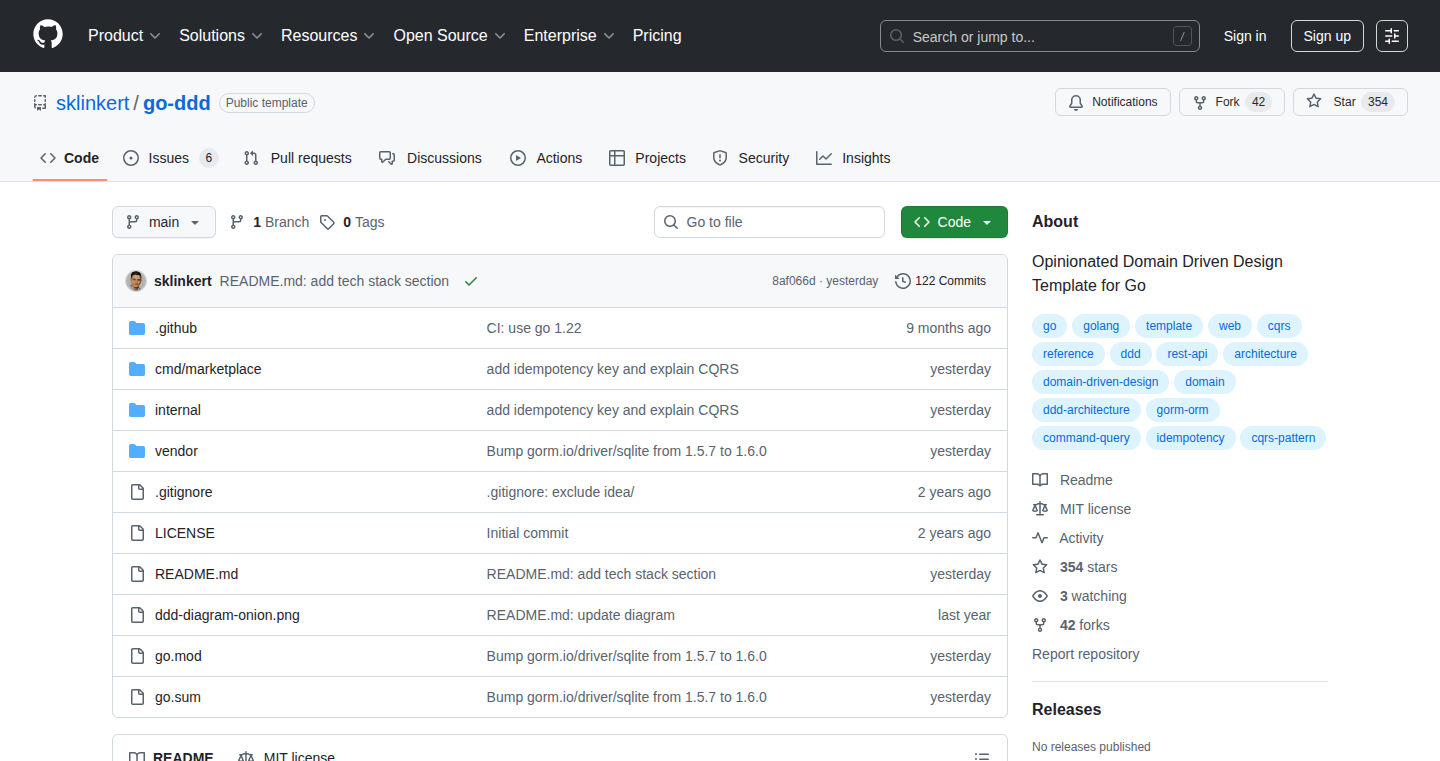
Author
sklinkert
Description
This project is a complete example of how to build software using Domain-Driven Design (DDD) principles in the Go programming language. It focuses on creating a clean and maintainable architecture, separating different parts of the application (like business logic and data storage) to make it easier to understand, change, and scale. It uses patterns like CQRS (Command Query Responsibility Segregation) to handle complex operations efficiently, and event sourcing to track changes to data over time. The project emphasizes practical, ready-to-use patterns instead of just theoretical concepts, offering a clear guide for developers to implement DDD in real-world Go projects. So this helps me understand how to build robust and scalable applications.
Popularity
Points 1
Comments 0
What is this product?
Go-DDD provides a detailed, practical implementation of Domain-Driven Design (DDD) in Go. DDD is a software development approach that focuses on modeling software around the business domain – the real-world processes and rules. This project shows how to structure a Go application using hexagonal architecture, CQRS, and event sourcing. Hexagonal architecture keeps the core business logic separate from external concerns like databases or user interfaces. CQRS splits read and write operations for better performance and scalability. Event sourcing tracks changes as a series of events, allowing you to reconstruct the state of your system at any point in time. This project aims to teach developers how to apply these patterns in a practical, production-ready way. So this teaches me how to design software that reflects the business it supports.
How to use it?
Developers can use this project as a learning resource and a starting point for their own Go projects. The project includes code examples, clear documentation, and examples of how to implement DDD patterns. You can study the code to understand how to structure your own applications. Integrate the provided patterns and architectural setup in your existing Go projects to improve their maintainability and scalability. So this helps me understand how to create more maintainable and scalable applications.
Product Core Function
· Hexagonal architecture with clear separation of concerns: Separates the core business logic from the technical details (like how data is stored or how users interact with the application). This makes the system more flexible and easier to maintain, as changes to the infrastructure don't affect the core business rules. So this allows me to keep the core of my application clean and easy to change.
· CQRS (Command Query Responsibility Segregation) patterns for scalability & reliability: Splits read and write operations into separate parts. This allows for independent scaling and optimization of each part, improving the performance and reliability of the application, especially when handling a high volume of requests. So this makes my application more scalable and able to handle more users.
· Event sourcing examples: Instead of storing the current state of data directly, the system stores a series of events that describe changes over time. This enables you to audit your data, replay events to reconstruct a state, and implement features like undo/redo functionality. So this allows me to track and understand how my data changes over time.
· Operating only on validated domain entities: Ensures that all business logic operates on valid data, preventing errors and inconsistencies. It makes your application more robust and reliable. So this ensures my application's data is always consistent and valid.
· Dependency injection setup: Manages the dependencies between different parts of the application, making them easier to test and maintain. Dependency injection improves the testability and flexibility of the application. So this makes it easier to test and modify different parts of my application.
· Handling Idempotency: Guarantees that operations can be executed multiple times without unintended side effects. This is critical for building robust and reliable systems, especially when dealing with distributed systems and network issues. So this ensures my application behaves predictably, even if something goes wrong.
· Repository patterns with multiple storage backends: Provides a standardized way to access data, making it easy to switch between different storage technologies (e.g., databases, file systems) without changing the core business logic. This increases flexibility and portability. So this lets me change where I store my data without rewriting my application's core logic.
· Testing strategies: Provides best practices and practical examples for writing tests. Good testing strategies ensure the software functions correctly and are easier to maintain. So this helps me ensure my code is working correctly and is easy to maintain over time.
Product Usage Case
· E-commerce platform: This project can be used to model the business domain of an e-commerce platform, including product catalogs, orders, payments, and customer accounts. DDD principles ensure that the application accurately reflects the business rules and processes of the platform, making it easier to scale and update. It helps me understand the product catalog management.
· Financial trading system: Implement DDD to build a financial trading system, which includes trading logic, risk management, and market data integration. This helps in managing complex financial rules and maintaining data consistency. This helps me to build reliable financial systems.
· Healthcare information system: This project can provide a structure for handling patient data, appointment scheduling, and medical records. DDD helps to capture the complexities of healthcare workflows and ensure data integrity. This helps me handle patient data.
72
Scryptogram: Sentence Unscrambling Puzzle
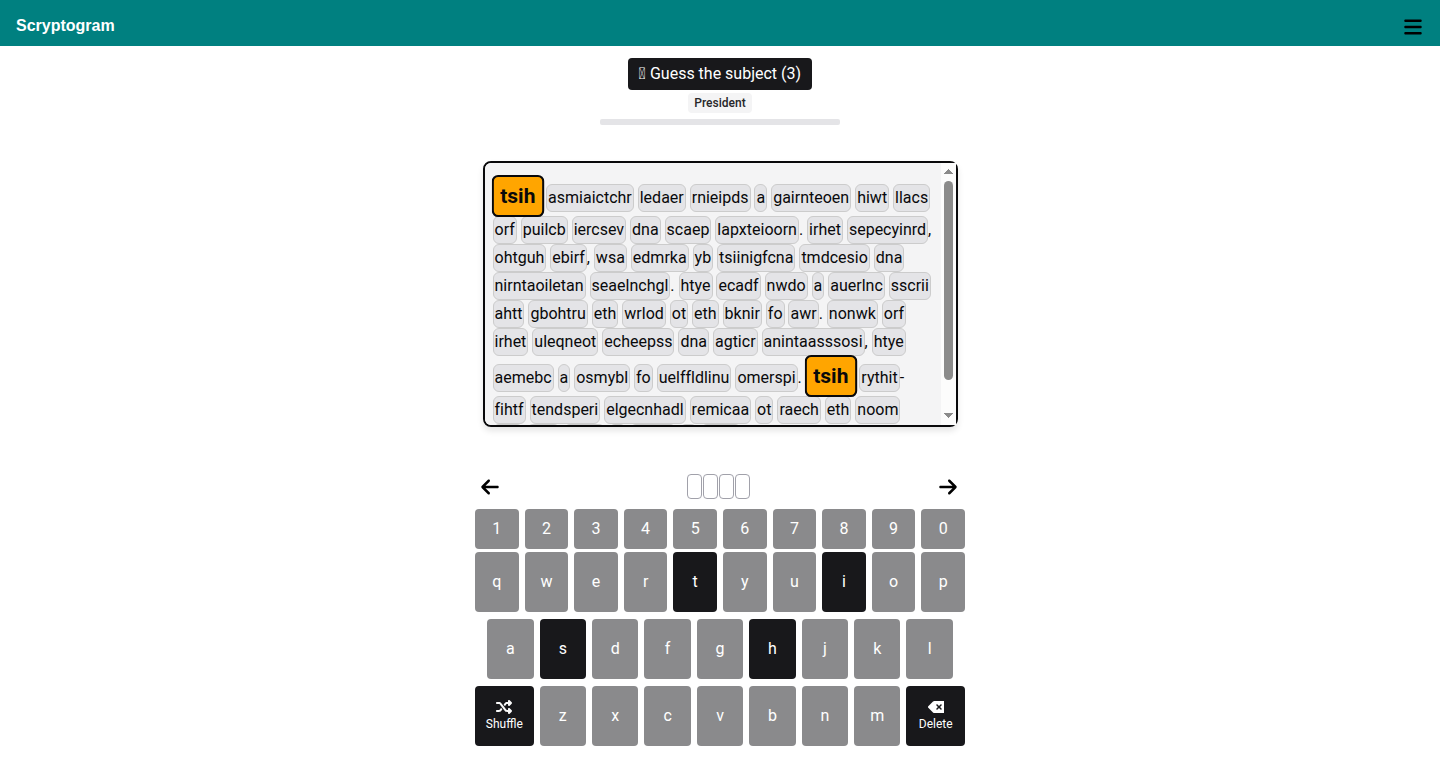
Author
sea_improvement
Description
Scryptogram is a word puzzle game that challenges you to unscramble five sentences to guess a subject (person, place, or thing). It mixes trivia with word puzzles, all within a browser-based and mobile-friendly interface. The core innovation lies in its game design - the use of scrambled sentences to create a unique guessing experience. It offers a novel approach to puzzle games, emphasizing sentence reconstruction and contextual understanding. So this is useful because it provides a fun and engaging way to exercise your brain and test your knowledge.
Popularity
Points 1
Comments 0
What is this product?
Scryptogram is a word puzzle game. The technical concept is based on the idea of transforming a set of scrambled sentences into a meaningful whole. Players need to use their language skills and knowledge to rearrange the sentences, and then guess the subject that the sentences are describing. This game is designed to be easy to use on any device with a web browser, making it a versatile entertainment option. So this is useful because it offers a unique combination of puzzle types.
How to use it?
You play Scryptogram in your web browser on your computer or mobile device. You see five scrambled sentences. Your task is to drag and drop the sentences to rearrange them. Once you think the sentences make sense and give clues to what the answer is, you can then enter your guess. The game is designed to be intuitive and easy to pick up. So this is useful because it is super easy to play, and you don't need to install anything.
Product Core Function
· Sentence Unscrambling: The fundamental mechanic of the game. Users need to reorder the sentences to create a coherent summary.
· Answer Guessing: After unscrambling, players must guess the subject, which tests their understanding of the sentences.
· Mobile-Friendly Design: The game is accessible and enjoyable on mobile devices, ensuring a wide audience.
· User-Friendly Interface: The drag-and-drop interaction for sentence rearrangement and the overall design make the game simple to use. So it's useful because it makes it easier to focus on playing the game.
Product Usage Case
· Educational Tool: Teachers could use Scryptogram to create puzzles for students, improving reading comprehension and vocabulary. It's useful for testing and improving reading skills.
· Casual Gaming: People can use Scryptogram as a fun way to pass time, improving their thinking skills while enjoying a puzzle. It's great for relaxing and sharpening your mind.
· Language Learning: The game can be used by people who want to learn a language by helping them to understand sentence structure and meaning in a fun way.
· Game Development Inspiration: Developers can look at the game design for inspiration. It is useful in creating innovative games and exploring new puzzle mechanics
73
AutoApprove: AI-Powered Approval Follow-Up Automation
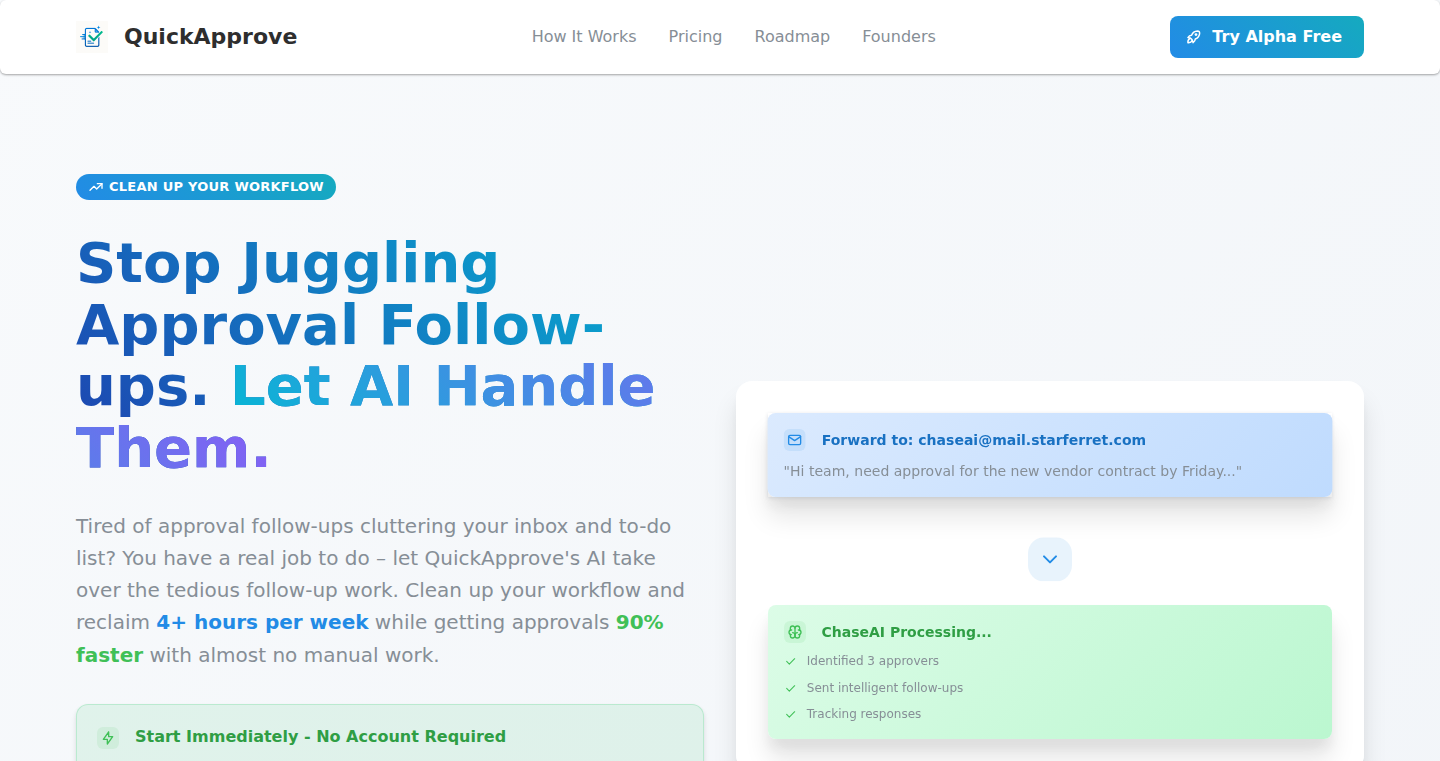
Author
xvok
Description
AutoApprove uses the power of Artificial Intelligence to automate the tedious task of chasing down approvals in your email inbox. It forwards your approval requests to the AI, which then handles the follow-up process for you, cleaning up your inbox and saving you valuable time. The technical innovation lies in its ability to understand the context of approval requests and initiate appropriate follow-up actions, a task previously requiring manual effort.
Popularity
Points 1
Comments 0
What is this product?
AutoApprove leverages Natural Language Processing (NLP) and Machine Learning (ML) to understand the content of your approval requests. Think of it as a smart assistant that reads your emails, identifies approval requests, and automatically follows up on them. The AI learns to understand the specifics of each request and intelligently prompts the approvers. So, it automates the annoying task of reminding people to approve things.
How to use it?
Developers integrate AutoApprove by simply forwarding their approval follow-up emails to a designated AI email address. The AI then takes over, streamlining the process. Imagine you’re waiting for a design review. Instead of manually emailing the designer every few hours, you just forward the initial approval request to AutoApprove. The AI will then send polite reminders until the approval is received. This is done completely behind the scenes, saving the developer from manual follow-ups.
Product Core Function
· Automated Email Forwarding and Processing: The core function is to automatically receive and process email forwards. This eliminates the need to manually read and understand each email, saving significant time and effort.
· Contextual Understanding of Approval Requests: The AI analyzes the content of the email to identify the specific request and the approver. This allows the system to send targeted and relevant follow-up messages. So, it understands what needs to be approved and by whom.
· Intelligent Follow-Up Scheduling: The AI determines the appropriate timing and frequency of follow-up emails based on the context and urgency of the request. It avoids being overly aggressive and maintains professionalism. This means it doesn't nag people too much but keeps things moving.
· Inbox Clean-up: By handling the follow-ups, AutoApprove keeps the user's inbox clean and organized, reducing clutter and improving focus. It’s a simple way to stop emails from piling up.
Product Usage Case
· Project Management: A project manager uses AutoApprove to follow up on requests for budget approvals. Instead of sending repetitive emails, the AI does it for them, allowing the manager to focus on other crucial project aspects.
· Design Review Workflow: A developer forwards the design review request to AutoApprove. The AI handles the follow-ups with the designers until the design is approved, ensuring the project keeps moving forward.
· Code Review Reminders: Developers can utilize AutoApprove for automatically following up on code review requests. This can help ensure code reviews are completed in a timely manner, promoting a faster development cycle.
74
NebulaFilterComparison: An Astrophotography Filter Performance Analyzer

Author
karlperera
Description
This project compares the performance of three different filters (Optolong L-Pro, ZWO Duoband, and No Filter) used to capture images of the Tulip Nebula. The core innovation lies in the direct comparison of image results obtained using different filters, enabling astrophotographers to optimize their filter selection based on their equipment and desired outcomes. It addresses the practical problem of choosing the best filter for capturing detailed and colorful images of nebulae.
Popularity
Points 1
Comments 0
What is this product?
This is a visual comparison project, primarily a video. The author took images of the Tulip Nebula using three different filters and then compared the resulting images. The technical principle here is to analyze how each filter interacts with the light emitted by the nebula, highlighting the subtle differences in detail and color rendition. Different filters are designed to allow specific wavelengths of light to pass through, thus affecting the final image. The innovation lies in the structured comparison of filter performance, providing concrete insights for astrophotographers. So, what's in it for you? It allows you to see which filter is best for capturing detailed images, improving the quality of your pictures.
How to use it?
The user can't directly 'use' this project as a tool, but it provides valuable information. Astrophotographers can use this comparison as a guide when selecting filters for their own projects. The video showcases the results, which can be applied in selecting filters. This is not a software to be run, but an educational resource to decide which filters to use. So, how do I use it? Use it to learn how filters perform and what might be best for you.
Product Core Function
· Filter Performance Comparison: The core function involves presenting side-by-side comparisons of images captured using different filters. This helps visualize the impact of each filter on the final image, showing details and colors. This is helpful for astrophotographers because it saves time and money by comparing before buying filters.
· Image Stacking Comparison: The project also examines the effects of stacking multiple exposures versus single exposures, showcasing differences in image quality and detail. This reveals how different processing techniques influence the final result, improving the overall image quality. Using this, astrophotographers can make better decisions for their projects.
· Equipment & Goal-Based Recommendation: The video shares the best filter choice for the users, and gives them advice. Based on the filter choices and equipment specifications, users can evaluate how it can benefit their own project. This can help you select the best filter that fits your goals.
· Narrowband Imaging Tips: The author shares their experience on narrowband imaging techniques and filter selection. Sharing such tips helps users to better understand how to use filters.
· Visual Representation: By using a video, users can better understand the nuances of filter performance.
Product Usage Case
· Astrophotographers aiming to capture detailed images of nebulae can use the comparison as a reference point. They can use the results and the author's insights to determine the best filter for their specific telescope, camera, and desired image characteristics. For example, someone with limited light-gathering capability may prefer a filter that enhances certain wavelengths.
· When a new astrophotographer is trying to decide on a filter to buy. They can learn from the project by checking the comparison of filter performance. They could see how different filters affect the final images, and how it might meet their specific needs. Then they can decide on a specific filter that they like.
· Experienced astrophotographers can use the project to refine their techniques. They can see how their filter selection aligns with others' experiences, potentially leading to improved image quality and new insights into filter usage. This can help the astrophotographers improve their existing skills.
75
GestureOS: Your PC, Controlled by Hand
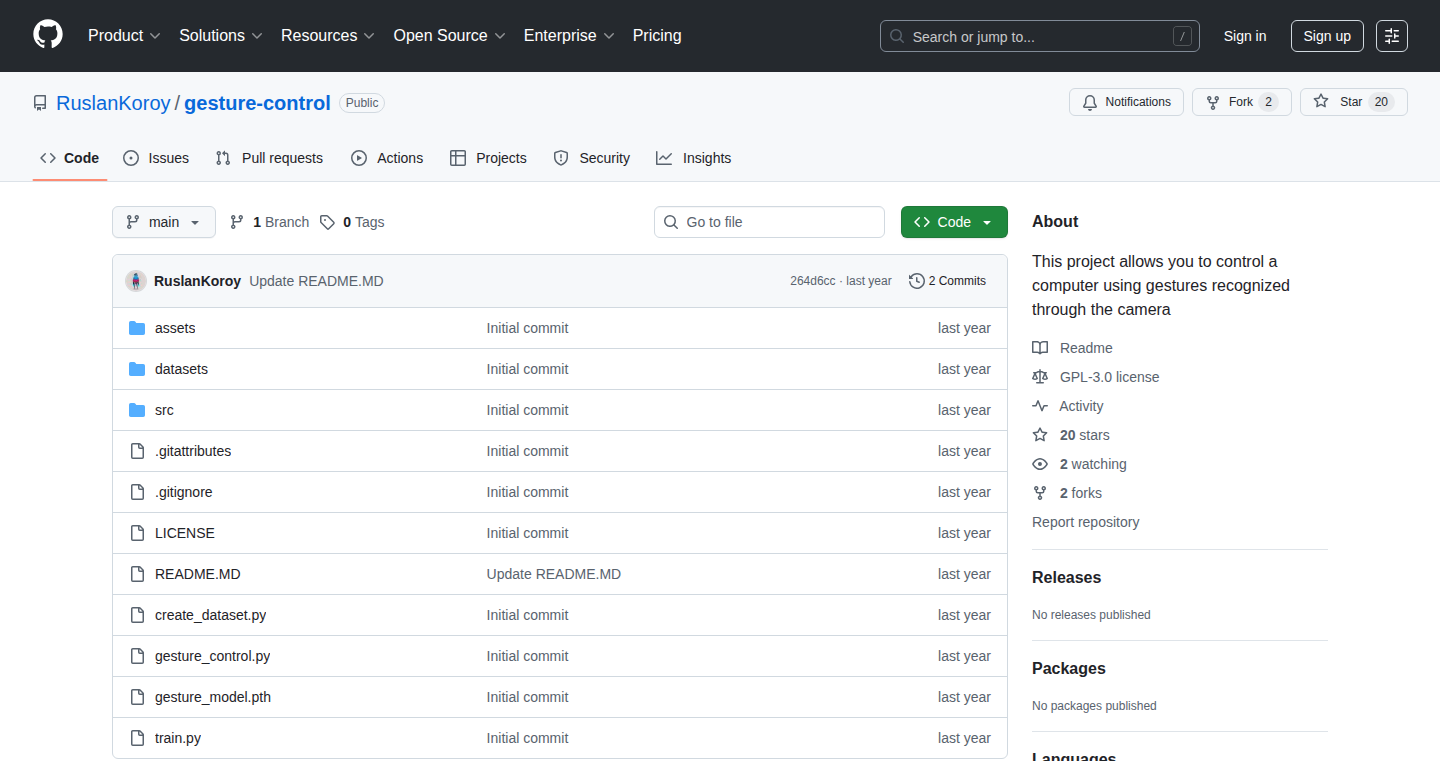
Author
cursedknowledge
Description
GestureOS allows you to control your computer using hand gestures, eliminating the need for a mouse. It leverages the power of your webcam and computer vision to translate hand movements into actions like mouse clicks, scrolling, and application switching. The innovative aspect lies in its simplicity and the creative use of readily available hardware (your webcam) to solve a common usability problem. The project tackles the need for hands-free control, offering a potential solution for accessibility and a more intuitive user experience.
Popularity
Points 1
Comments 0
What is this product?
GestureOS is a software that lets you control your computer by using your hand gestures. It uses your computer's webcam to see your hand movements and then translates those movements into commands for your computer, such as moving the mouse cursor, clicking, and scrolling. The innovation comes from its clever use of computer vision and a simple webcam to achieve this functionality, which normally requires more complex and expensive hardware. This project is about making computer interaction more natural and accessible, freeing you from the limitations of a mouse and keyboard. So this is for you if you ever wished for a simpler and more intuitive way to interact with your computer.
How to use it?
Developers can integrate GestureOS by utilizing its underlying computer vision libraries or by building upon its gesture recognition system. Imagine using this in applications that require hands-free control, like presentation software, virtual reality interfaces, or even for users with disabilities. You could start by installing the software and then configuring the gestures, or you could integrate the gesture recognition system into your own programs to provide a custom control experience. So this means, as a developer, you could create innovative and accessible applications using hand gestures as a control interface.
Product Core Function
· Hand Tracking: The core function is to track the position and movements of your hands using the webcam. This is done through computer vision algorithms that identify your hand in the video feed. So this allows the system to 'see' your hands and understand their position.
· Gesture Recognition: Once the hand is tracked, the system needs to recognize specific gestures, like a fist for clicking, or a swipe for scrolling. Algorithms are used to classify hand shapes and movements, mapping them to specific actions. So this transforms your hand movements into commands.
· Mouse Emulation: The identified hand movements are translated into cursor control on the screen. The position of your hand dictates where the mouse cursor should be, enabling you to move it around. So this allows you to control the mouse without touching it.
· Action Mapping: The gestures are then mapped to actions like left-click, right-click, double-click, scrolling, and application switching. So this lets you configure how each gesture will affect your computer, providing a customized experience.
· Customization: The system should allow users to define custom gestures and actions, letting them tailor the experience to their specific needs and preferences. So this offers flexibility, empowering you to create a personalized experience.
Product Usage Case
· Accessibility: Users with limited mobility could use GestureOS to control their computer without a mouse or keyboard, promoting greater independence and ease of use. This allows people with disabilities to use their computer in an easier way.
· Presentation Software: Presenters could use hand gestures to navigate slides, control a virtual whiteboard, or highlight content during a presentation. This improves the interaction with the audience and provides more control.
· Virtual Reality (VR) / Augmented Reality (AR): GestureOS could integrate with VR/AR applications, allowing users to interact with virtual objects and environments using natural hand gestures. This makes the virtual world more immersive.
· Hands-Free Gaming: Imagine playing games with hand gestures for a more immersive gaming experience, or using gestures to control your media player. This opens up new ways to interact with games or applications.
76
iine - Privacy-First Like Buttons
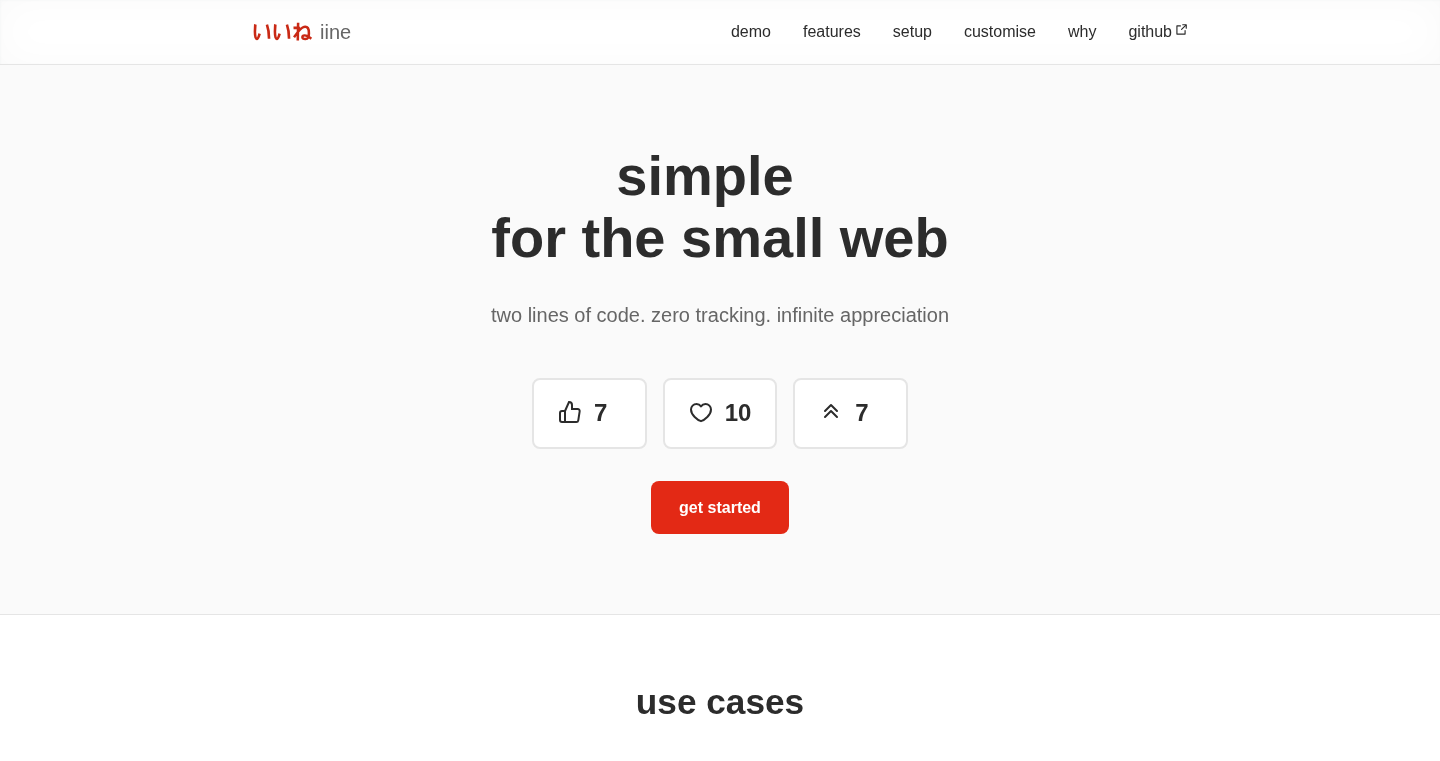
url
Author
welpo
Description
iine is a lightweight, privacy-focused like button solution designed for websites. It allows website owners to add a 'like' or 'kudos' feature without tracking users or requiring them to create accounts. The backend stores only the URL and a counter, avoiding the collection of personal data. The project emphasizes accessibility, works without JavaScript (gracefully degrades), and is self-hostable using PostgreSQL. This offers a simple way to gauge audience engagement while respecting user privacy, making it ideal for small websites and blogs.
Popularity
Points 1
Comments 0
What is this product?
iine is a simple yet powerful like button system built with privacy as the core principle. It works by storing the website URL and the number of likes it receives in a database. When a user clicks the 'like' button, it sends a request to the backend to increment the counter for that specific URL. The beauty lies in its simplicity: no user tracking, no account creation, and minimal data collection. This is achieved using a PostgreSQL database to efficiently store and retrieve the likes. The system gracefully degrades if JavaScript is disabled. So what? You get user interaction data without compromising their privacy - perfect for independent developers and bloggers.
How to use it?
Developers can easily integrate iine into their websites by including a small snippet of HTML and JavaScript. The HTML typically includes a form with a like button, and the JavaScript handles the interactions with the backend. iine is designed to be self-hostable; developers can deploy it on their own server, which provides full control over the data. If you're a blogger, or run a personal website, this is ideal, you can add like buttons to your posts easily. If you disable Javascript, it will still work using a form submission, this is a nice feature that increases the accessibility of the website.
Product Core Function
· Like Button Functionality: Allows users to 'like' or show appreciation for content. Its value is that it directly measures engagement, providing valuable feedback for content creators, and it works without JavaScript. So what? You get a basic engagement metric to gauge interest in your content.
· Privacy-Focused Data Storage: The backend stores only the URL and the number of likes, omitting any user-identifiable information like IP addresses, user agents, or timestamps. So what? You respect your users' privacy, which is critical for building trust and adhering to data protection regulations.
· Self-Hosting Capabilities: iine is designed to be self-hosted on your server using a PostgreSQL database, giving developers complete control over their data. So what? You retain complete control over your data, avoid vendor lock-in, and ensures data privacy.
· Accessibility Features: The system is designed to be keyboard-navigable and screen-reader friendly, ensuring inclusivity for all users. So what? You create a more inclusive user experience, reaching a wider audience and making your website user-friendly.
· Lightweight Design: With only ~3KB of JavaScript, iine minimizes the impact on page load times, enhancing the user experience. So what? Your website loads quickly, resulting in a better user experience and improved search engine optimization (SEO).
Product Usage Case
· Personal Blog: A blogger can use iine to add a 'like' button below each blog post, gauging which content resonates most with readers without tracking them. The developer can then use these metrics to gauge interest in topics. So what? The blog owner gets quick insights into content performance, allowing them to adjust strategy.
· Small Business Website: A small business can integrate iine into its website to gather feedback on its products or services, without compromising user data. So what? The business owner gets insights into which products/services are popular.
· Portfolio Site: A developer can use iine on their portfolio site to collect feedback on their projects from potential employers or clients. So what? You receive quick feedback without worrying about user data.
77
Podly: Your Audio Second Brain

Author
becominghim
Description
Podly transforms passive podcast listening into active learning. It tackles the problem of information retention by building a personal 'memory graph' from the podcasts you listen to. This lets you search for ideas, see how different podcast episodes connect, and explore your listening history in a structured, searchable way – like having an Obsidian-style second brain for audio content.
Popularity
Points 1
Comments 0
What is this product?
Podly uses technology to understand and organize your podcast listening habits. It essentially creates a personalized map of the ideas and topics you've encountered in podcasts. The core innovation is in how it connects the dots between different podcast episodes, allowing you to easily find and recall information. Instead of just listening, Podly helps you actively engage with the content. So what? This is useful for anyone who wants to get more value out of their podcast listening time by turning it into active learning.
How to use it?
Podly integrates with your podcast listening habits. The developer's plan is to build in search, connection tracking, and exploration features. Imagine searching for a concept, and Podly shows you all the podcast episodes where it was discussed, along with related ideas. You could integrate Podly into your learning workflow by using it to take notes, connect ideas, and build a personal knowledge base from your podcast listening. So what? This helps you use podcasts as a learning resource by making the information accessible and interconnected, enhancing your understanding and ability to recall information.
Product Core Function
· Personalized Memory Graph: Podly builds a dynamic map of your podcast listening habits. This map is built from the shows you listen to, the topics discussed, and the connections between different episodes. So what? It allows you to see the big picture of your podcast content and find connections you would never have found on your own, improving your comprehension and retention.
· Searchable Content: Podly allows you to easily search across all your podcast episodes for specific ideas or keywords. So what? This allows you to quickly find information and revisit the concepts you've heard, saving you time and effort.
· Idea Tracing: Podly will enable you to trace connections between ideas across multiple podcast episodes. This will visually represent how different concepts are related and how they build on each other. So what? This creates a more structured and interconnected understanding of the information you are consuming, improving the depth of learning and making it easier to retain information.
Product Usage Case
· Researchers can use Podly to track ideas across various podcast episodes relevant to their work. They can quickly discover connections between different research areas and concepts, leading to new insights. So what? This helps researchers efficiently organize, search, and connect information from numerous sources to advance their field of study.
· Students can use Podly to improve their learning by using it to connect key concepts discussed in educational podcasts. They can build their personal knowledge base, review the information, and improve retention. So what? This allows students to actively engage with the podcast content, building a deeper understanding of the materials presented.
· Professionals can use Podly to organize information from industry-related podcasts. They can search for specific topics, see how different experts approach those topics, and build a better understanding of their field. So what? This enables professionals to keep up with industry trends and make more informed decisions by giving easy access to important insights and knowledge.
78
PCAgents: The AI Desktop App Store
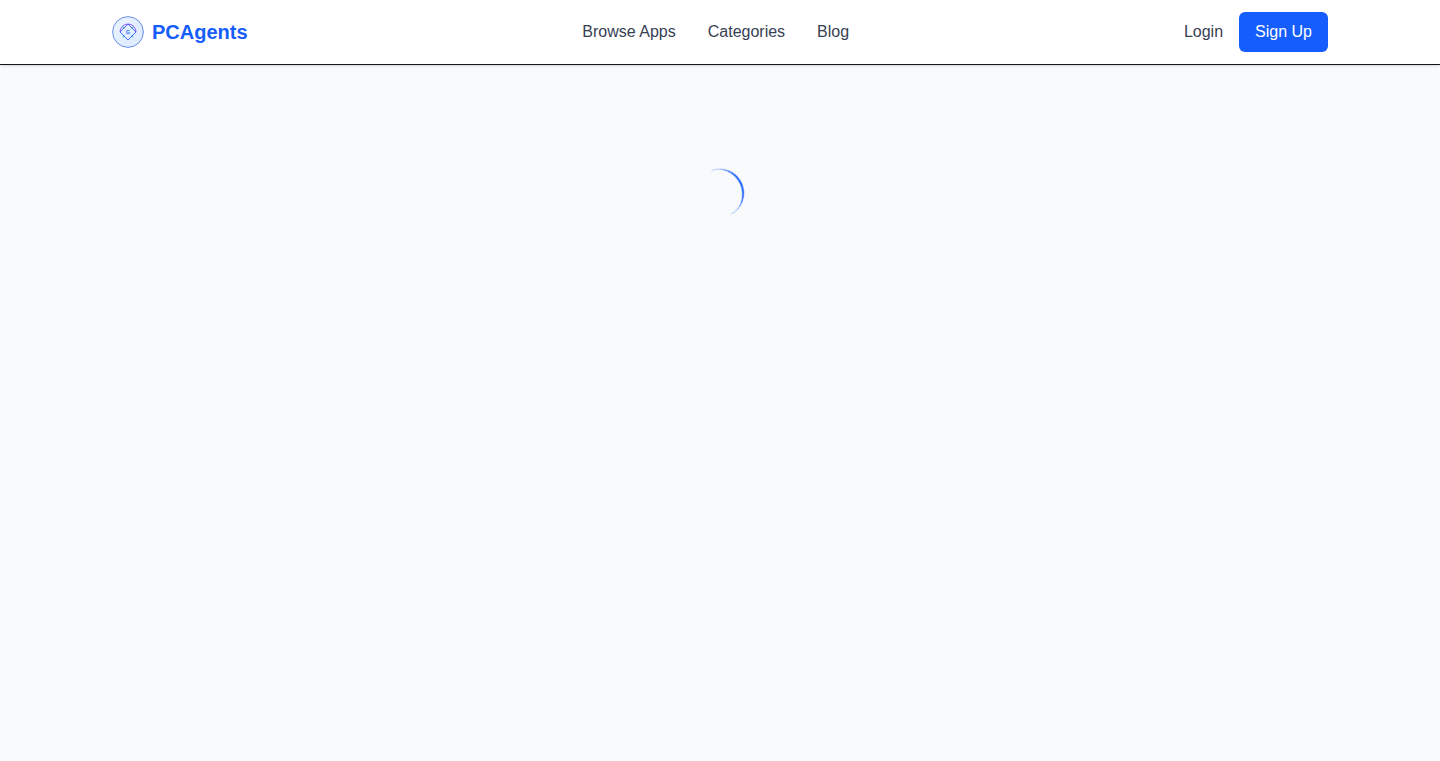
Author
the_plug
Description
PCAgents is like an App Store, but specifically for AI desktop applications. It solves the problem of discovering and installing powerful AI tools that run directly on your computer (like image generators, offline transcription tools, and local language models). Instead of using web apps that require an internet connection and send your data to the cloud, PCAgents allows you to run AI applications locally, offering faster performance, better privacy, and the ability to work offline. It addresses the critical need for a centralized platform to find and manage the growing ecosystem of desktop AI applications, promoting the 'AI desktop renaissance'.
Popularity
Points 1
Comments 0
What is this product?
PCAgents is a curated marketplace for desktop AI applications. It works by providing a centralized location where developers can publish their AI-powered desktop apps, and users can easily discover, install, and update them with a single click. The core innovation lies in focusing on desktop applications, which allows AI models to run faster and more privately than web-based alternatives. The platform includes features like quality control, cross-platform support (Windows, Mac, Linux), developer tools for distribution, and a user review system. So this is useful because it simplifies the process of accessing and using advanced AI tools, improving user experience and accessibility.
How to use it?
Developers can use PCAgents to distribute their desktop AI applications, reaching a wider audience and simplifying the installation and update process for their users. Users can visit the PCAgents store, browse available AI apps, and install them with a single click. The platform provides easy installation across different operating systems and simplifies the update process. So this is useful for developers to distribute their apps easily and for users to find and use AI tools more efficiently.
Product Core Function
· Curated Store: PCAgents reviews and approves applications to ensure quality and reliability, offering a trustworthy environment for users to discover high-quality AI tools. So this is useful because it saves you time and ensures you're using safe and functional applications.
· One-Click Installs: PCAgents streamlines the installation process across Windows, Mac, and Linux, making it incredibly easy for users to get started with AI applications. So this is useful because it removes the technical hurdles and simplifies the experience of getting new tools.
· Developer Tools: PCAgents offers tools for developers to easily distribute, update, and manage their desktop AI applications. This can include features to handle updates, collect user feedback, and more. So this is useful because it supports developers, providing them the resources they need to get their applications to market.
· User Reviews and Ratings: The platform incorporates a review and rating system, allowing users to share their experiences and help others choose the best AI applications for their needs. So this is useful because it builds community trust and helps make informed decisions when selecting apps.
Product Usage Case
· AI Video Editors: Users can install AI-powered video editing software that runs locally, enabling faster rendering times and enhanced privacy for sensitive video projects. So this is useful because it significantly improves the efficiency of video editing and protects your data.
· Offline Code Assistants: Developers can utilize AI code assistants that work without an internet connection, allowing them to write code anywhere, even in areas with limited connectivity. So this is useful because it allows uninterrupted code and reduces dependency on network.
· Writing Tools: Writers and content creators can leverage AI writing tools that never send their documents to the cloud, ensuring data privacy and offering a secure environment for sensitive content. So this is useful because it prioritizes data privacy and allows to work offline, without compromising user's content.
79
Nutrition Optimizer: A Personalized Diet Recommendation Engine
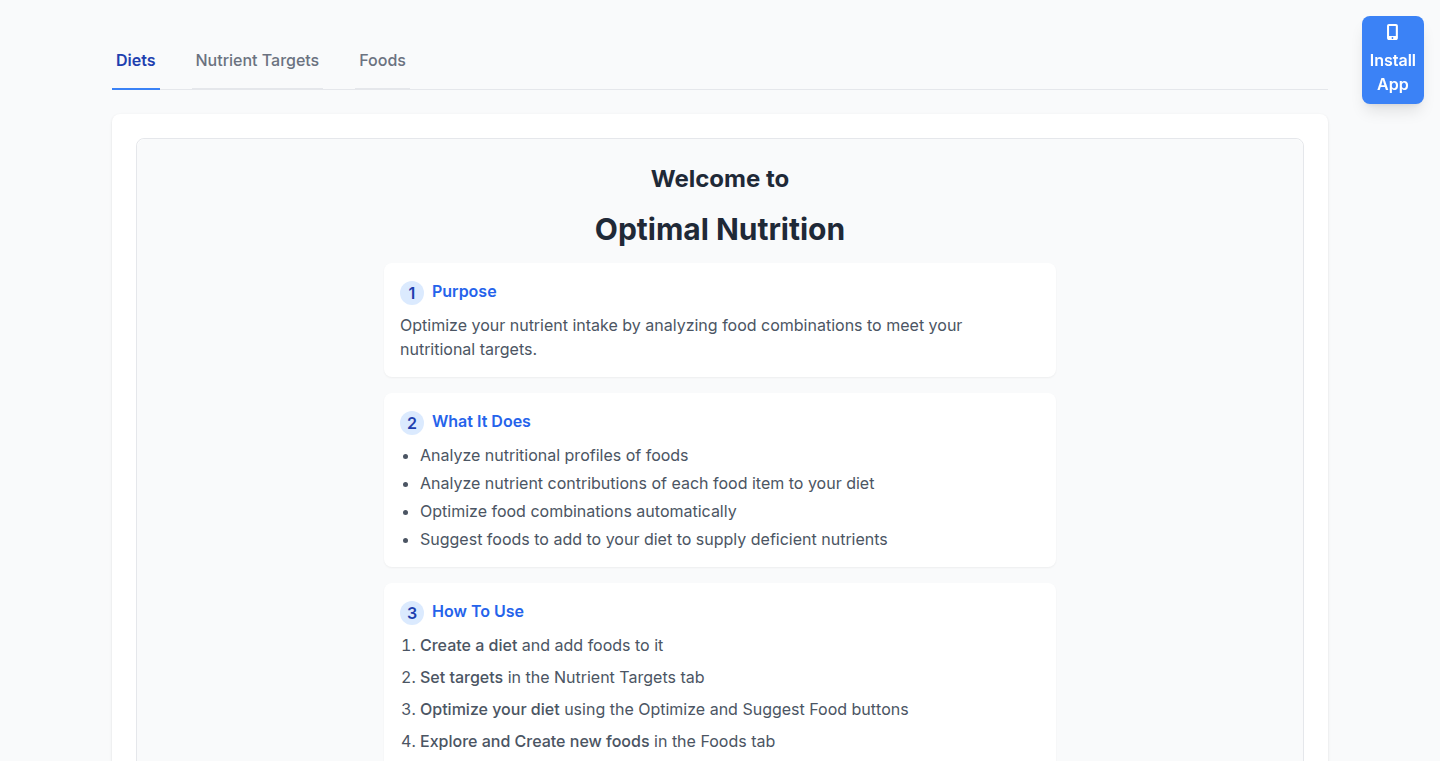
Author
wvlia5
Description
This project, a "Nutrition Optimizer", is a personalized diet recommendation engine. It takes user-provided health data and dietary preferences as input, and then leverages a nutritional database and optimization algorithms to suggest an optimal set of meals and recipes. The core innovation lies in its ability to translate complex nutritional constraints and preferences into practical, easy-to-follow dietary plans. It addresses the challenge of creating a diet that is both healthy and aligned with an individual's specific needs and tastes. So, this helps users build a healthier diet, customized just for them.
Popularity
Points 1
Comments 0
What is this product?
This project is essentially a smart recipe planner. It uses data science and a database of foods and their nutritional information. You tell it what you like to eat, any allergies you have, and maybe some health goals (like wanting more protein or less sugar). The program then crunches the numbers using optimization algorithms – think of it like complex problem-solving – to find the best combination of meals that fit your needs and give you the nutrients you require. The innovation is automating the difficult task of matching dietary goals with tasty meals. So, this means you get personalized dietary plans, avoiding the trial-and-error process, and saving you time and potentially frustration.
How to use it?
Developers could integrate this project into existing health or fitness apps. Think about a fitness tracker app that gives you personalized meal suggestions based on your activity and goals. You could use it to generate meal plans for your users, or to help them find recipes that fit specific dietary needs. Integrating it into a web application is relatively straightforward: the core functionality could be implemented as an API, with calls to fetch and filter nutritional information, and suggestions for recipes. So, if you're building a health application, you can offer smart diet suggestions without building it from scratch.
Product Core Function
· Personalized Recipe Generation: The system generates recipes tailored to a user's nutritional needs (e.g., calorie intake, macronutrient ratios) and preferences (e.g., dislikes, allergies, preferred cuisines). This provides the user with a convenient, customized diet plan. So, you get customized meals based on your specific dietary goals.
· Nutritional Data Integration: It leverages a comprehensive database of nutritional information for various food items, ensuring accurate and data-driven recommendations. This means more informed dietary decisions. So, you ensure you get factual and accurate information.
· Optimization Algorithm: The core of the engine. It employs algorithms to find the most optimal combination of meals. Think of this as a clever way to work out the best way to meet your nutritional needs. So, your diet plan is optimally tailored to your needs, removing guesswork and manual planning.
· Preference-Aware Filtering: Includes preferences for flavors and cuisine style to ensure palatable meal options. This ensures the dietary plan is enjoyable to follow. So, users are more likely to stick to their diet because it’s based on their tastes.
· User Input and Profiling: It allows users to input their individual health metrics and dietary preferences to tailor recommendations. So, you can build a diet specifically for you, based on your needs and wants.
· Integration with External Recipe Sources: The project could be extended to pull recipes from different online sources, increasing the range of recipes and enhancing user choice. So, you get a wider variety of choices when choosing your diet.
Product Usage Case
· Fitness Tracking Application Integration: A developer can integrate the Nutrition Optimizer into a fitness tracking application to provide users with diet plans tailored to their exercise routines. The application can consider the user's activity levels and caloric needs to suggest suitable meals. This creates a holistic health ecosystem and helps users optimize both fitness and nutrition. So, you provide users with a complete health solution.
· Personalized Meal Planning Service: A small business could use the Nutrition Optimizer to create a personalized meal planning service. They could input user data, generate custom meal plans, and provide grocery lists, all based on individual needs. So, you can build a business around personalized dieting.
· Health and Wellness Websites: Health and wellness websites can use this technology to offer a tool that suggests suitable meal options based on dietary needs and preferences. This improves the user experience and adds value to the website by providing helpful and personalized advice. So, you enhance your website and improve user engagement.
· Recipe Recommendation System for E-commerce: An e-commerce site selling food products could use this to suggest suitable products for users based on their dietary needs and preferences. So, you boost your e-commerce site by providing smarter product suggestions.
80
TrendPilot: Trend-Driven Content Generator
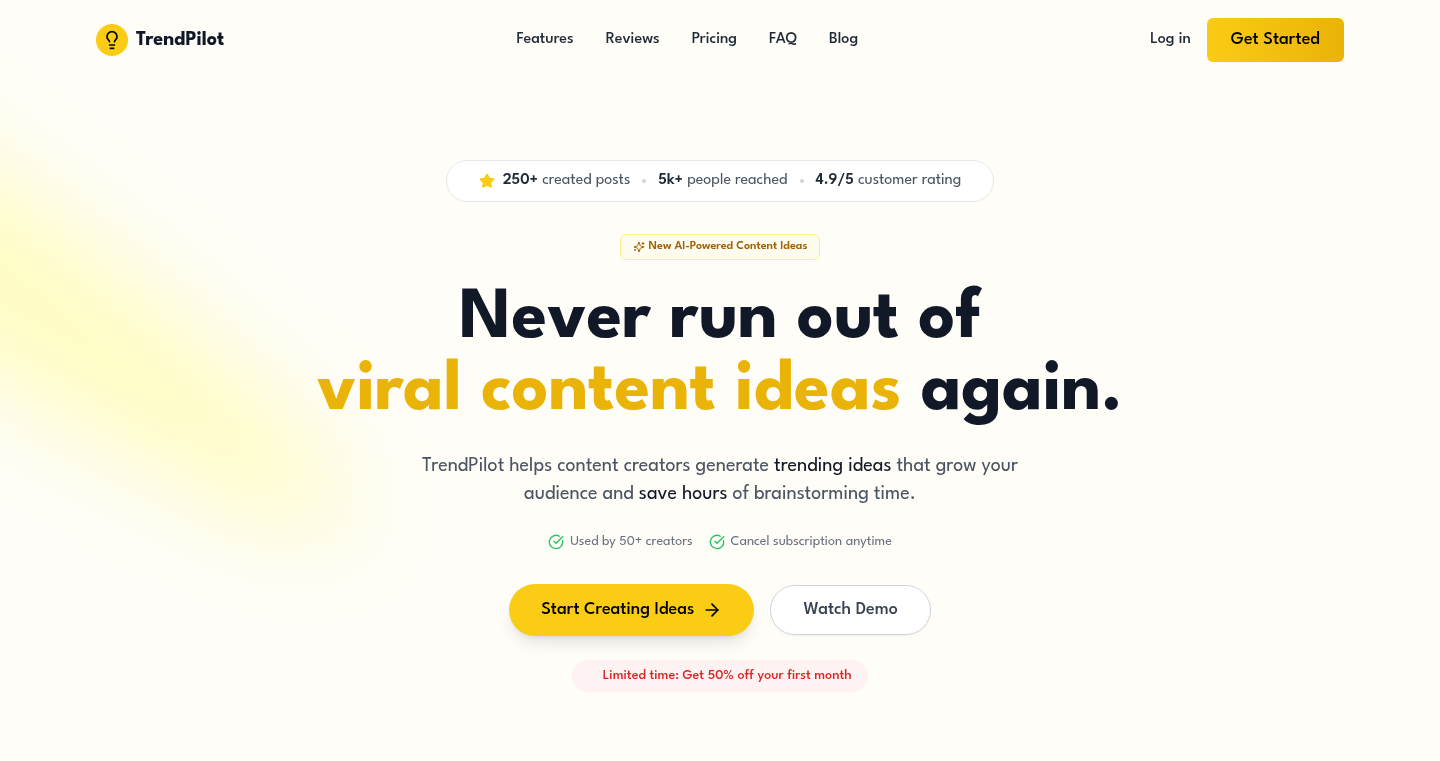
Author
niklasdev
Description
TrendPilot is a tool that helps you find trending topics and generate content ideas based on those trends. It tackles the common problem of content creators: struggling to come up with fresh ideas regularly. By pulling data from sources like Reddit, Google, and X (formerly Twitter), it identifies emerging trends in your chosen niche and suggests relevant content, allowing you to create consistent content without burnout. The core innovation lies in its automated trend analysis and content suggestion engine, streamlining the content creation process.
Popularity
Points 1
Comments 0
What is this product?
TrendPilot is a web-based application. At its heart, it uses an algorithm to scan multiple online platforms like Reddit, Google, and X. It looks for keywords and topics that are gaining traction, indicating emerging trends. Then, based on your specified niche (e.g., technology, cooking, fitness), it filters those trends and uses natural language processing (NLP) to analyze the context and suggest potential content ideas. So, instead of staring at a blank page, you get a curated list of trending topics and related content ideas, allowing you to quickly produce relevant and engaging content. This saves you time and effort, helping you consistently create content that resonates with your audience.
How to use it?
To use TrendPilot, you first need to sign up for a free account. Then, you define your niche or area of interest. TrendPilot will begin to identify trending topics related to your niche from the selected sources. You can then explore these trends and review the suggested content ideas. It's most useful for content creators, bloggers, social media managers, and anyone who needs to generate regular content. You can integrate the content ideas directly into your content calendar or use them as inspiration for your next blog post, social media update, or video script. This gives you a constant stream of fresh ideas, helping you stay relevant and engaged with your audience.
Product Core Function
· Trend Discovery: TrendPilot actively monitors multiple online platforms for emerging trends. This function scans vast amounts of data to identify topics that are gaining popularity. So what? You can stay ahead of the curve by being the first to cover new topics.
· Niche-Specific Filtering: It allows users to specify their niche or area of interest. This feature filters the trends to those relevant to the user's specific field. So what? This allows users to receive focused and relevant content ideas that align with their brand or area of expertise.
· Content Idea Generation: Based on the identified trends and the user's niche, TrendPilot generates content ideas. This uses NLP techniques to suggest content formats and topics. So what? You no longer need to spend hours brainstorming. Instead, you have a list of content ideas, saving you time and energy.
· User Interface (UX): The tool provides a user-friendly interface for exploring trends and content ideas. So what? Even if you’re not tech-savvy, you can navigate and use the tool to discover new ideas.
Product Usage Case
· A tech blogger wants to write about the latest innovations in AI. They use TrendPilot to discover trending AI topics on Reddit and then generate blog post ideas related to those topics, such as a comparison of different AI models, an analysis of AI's impact on business, or a tutorial on using AI tools. So what? They are consistently putting out timely and relevant content.
· A fitness coach needs social media content. Using TrendPilot, they identify trending fitness topics on X, such as a new type of workout, and then generate content ideas, like creating a short video demonstrating the workout or a post discussing its benefits. So what? They are easily able to keep the social media active with fresh content.
81
FileMock: Instant Test File Generator
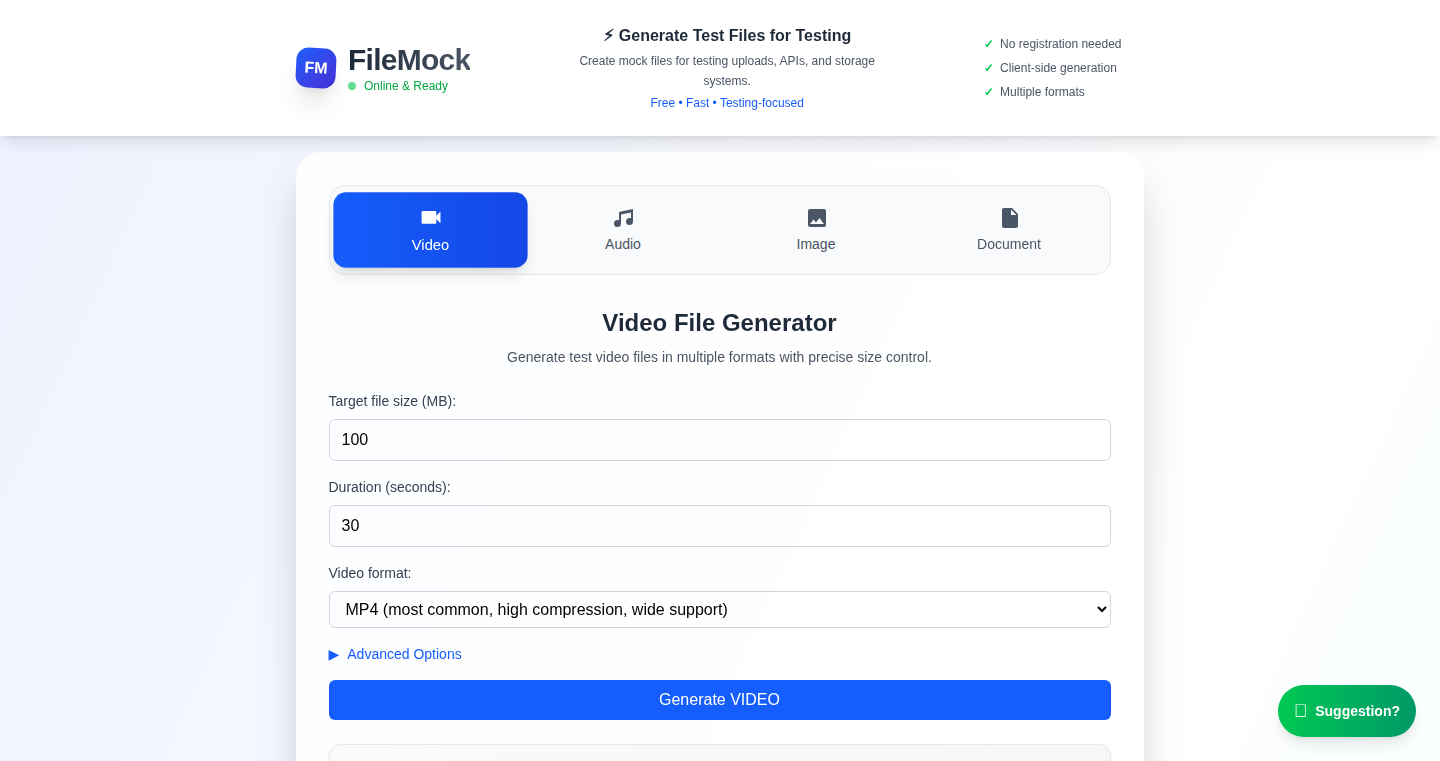
Author
humast
Description
FileMock is a web-based tool that lets developers create mock files of various formats (video, audio, images, documents) directly in their browser. It solves the common problem of needing test files for software testing, API development, and cloud storage systems. The innovation lies in its client-side processing using technologies like Canvas API, Web Audio API, and FFmpeg.wasm, eliminating the need for server-side processing and ensuring user privacy. So this is useful for generating test files quickly and securely without needing to upload any data.
Popularity
Points 1
Comments 0
What is this product?
FileMock is like a digital file factory running inside your web browser. It uses web technologies like Canvas and Web Audio APIs (usually used for displaying and playing multimedia) and a special version of FFmpeg (a powerful video processing tool) compiled to run inside your browser. This allows it to create various file types such as videos, audios, images, and documents, based on your specifications. The key innovation is that all the file generation happens locally in your browser, without sending any data to a server, ensuring your data's privacy and making the process very fast. So this is useful because you can generate test files instantly without worrying about privacy.
How to use it?
Developers can access FileMock through a web browser and specify parameters like file type, size, and sometimes other specific characteristics of the file. They can then download these generated files to use in their testing, development, or deployment workflows. Integration is straightforward; you simply download the file and use it with your code or system. So this is useful because it's a simple and quick tool that seamlessly integrates into your development process.
Product Core Function
· File Generation: FileMock can create various file types like MP4 videos, MP3 audios, PNG images, and DOCX documents. This eliminates the need to manually create sample files.
· Precise Size Control: Users can specify the exact size of the files they need, which is essential for testing upload limits or storage quotas. This is useful when you need to test upload limits.
· Client-Side Processing: All file generation happens within the user's browser. This means no data is sent to a server, ensuring privacy and fast generation speeds. So this is useful because it keeps your data safe and provides an instant file generation.
· Format Support: FileMock supports a wide range of file formats (20+), making it versatile for different testing scenarios. So this is useful because it provides all the formats you need.
· Web-Based and No Registration: The tool is web-based and doesn't require any user registration, offering immediate access to file generation. So this is useful because you can use it immediately without wasting your time.
Product Usage Case
· Testing Upload Functionality: Developers can use FileMock to generate test files to simulate different upload scenarios, such as testing upload limits or ensuring that a file is processed correctly.
· API Endpoint Testing: When developing APIs that handle file uploads, developers can use FileMock to generate various file types and sizes to test the API endpoints. This is useful when you want to test your APIs.
· Cloud Storage Testing: When using cloud storage, developers can use FileMock to generate files to simulate different storage quotas or test the performance of uploading or downloading different types of files.
· CI/CD Pipeline Testing: Developers can incorporate FileMock into their continuous integration/continuous deployment pipelines to automatically generate test files and validate the behavior of file processing steps. This is useful because you can fully automate the testing process.
· Frontend Development: Frontend developers can use FileMock to generate mock image or video files to check the display of different file types. This is useful for checking the frontend's design
82
Gistpod: Consulting Insights Summarizer
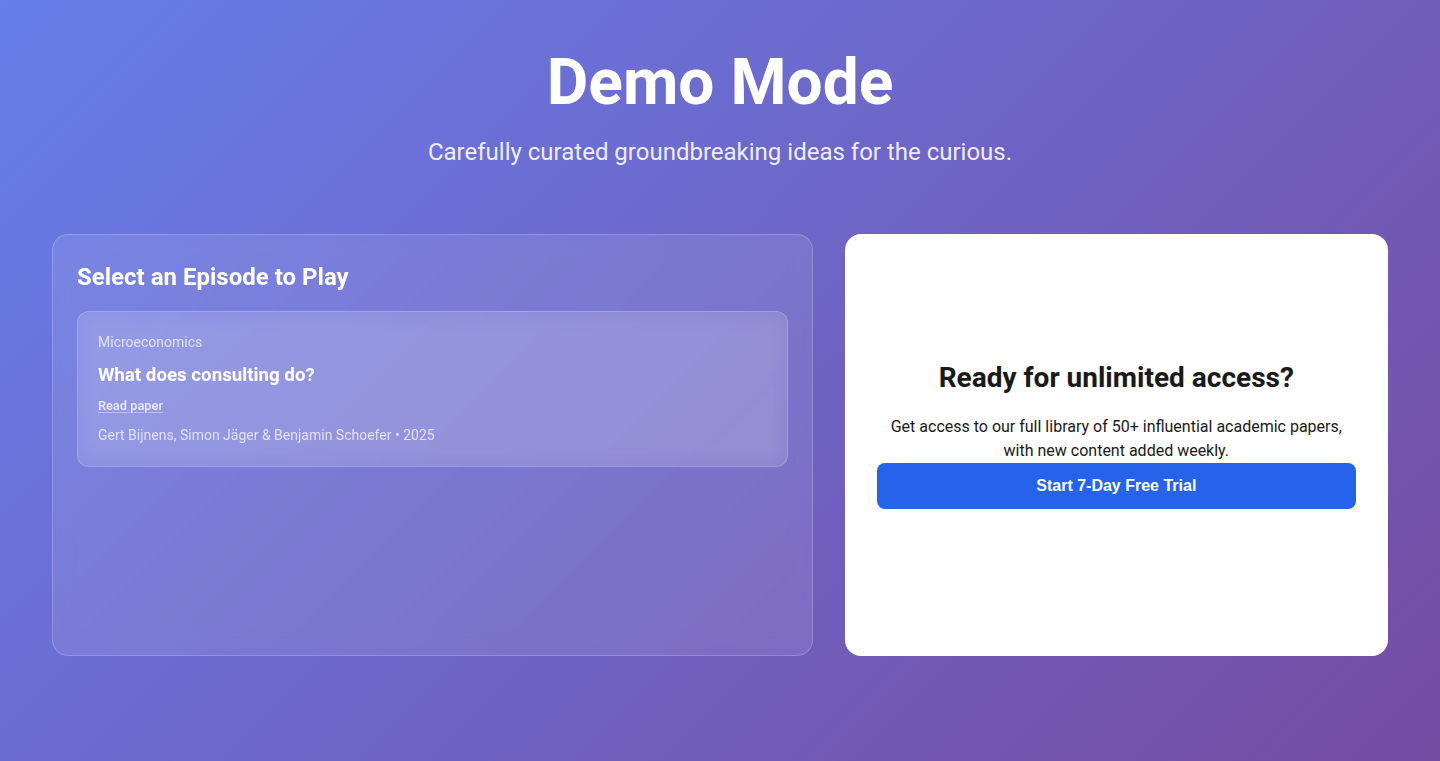
Author
WasimBhai
Description
Gistpod is a tool that automatically summarizes complex consulting documents, such as reports and presentations, into concise, digestible audio podcasts. It leverages the power of natural language processing (NLP) to extract key information and generate summaries. The innovative aspect lies in converting detailed text into a format suitable for passive consumption (audio), allowing users to grasp the core concepts quickly without intensive reading. It addresses the problem of information overload and the inefficiency of manually extracting key takeaways from lengthy documents.
Popularity
Points 1
Comments 0
What is this product?
Gistpod uses advanced NLP techniques, like text summarization and text-to-speech (TTS), to analyze consulting documents. It identifies important sentences, paragraphs, and sections within these documents and generates a short audio version highlighting the main points. The innovation lies in the automated conversion of text-heavy, complex information into a readily consumable audio format, similar to turning a long article into a podcast. This eliminates the need to read through lengthy reports, saving time and improving information accessibility. So this is useful because you can understand crucial information on the go, like when you are commuting or exercising.
How to use it?
Developers can use Gistpod by uploading consulting documents (e.g., .pdf, .docx) or providing a link to online resources. The system then processes the document and generates an audio podcast. The output can be easily shared or consumed directly through a mobile app or web player. Integration could involve using Gistpod's API to summarize documents within a larger platform, like a project management tool, allowing team members to quickly grasp crucial updates. It is useful for anyone who needs to quickly understand lengthy technical documents and consulting reports.
Product Core Function
· Automated Document Summarization: This function analyzes the document and extracts key information, condensing long texts into shorter summaries. This is valuable because it enables quick understanding of complex information, saving time and effort in going through lengthy consulting reports and technical documentation.
· Text-to-Speech Conversion: Gistpod converts the summarized text into human-sounding audio, making it easy to listen on the move. This is valuable because it enables users to consume information passively, in environments where reading is not convenient, such as during a commute or workout.
· Podcast Generation: Gistpod creates audio podcasts from document summaries, making information easily accessible through standard podcast players. This is valuable because it provides a streamlined way to organize and consume summarized information, allowing for easy sharing and distribution of knowledge.
· Multi-Format Support: Gistpod supports a variety of document formats, allowing for seamless processing of different kinds of reports and presentations. This is valuable because it gives the user flexibility in consuming information across different document formats.
Product Usage Case
· Project Management: A project manager can use Gistpod to quickly summarize complex project status reports, share it with the team as an audio podcast during a team meeting or as a quick briefing, thus improving team communication and making sure everybody is on the same page, thus reducing the time spent on lengthy reports.
· Knowledge Sharing: A consultant can use Gistpod to create audio summaries of their detailed project findings and share it with clients. This makes it easy for clients to quickly understand the high-level key takeaways of the project without necessarily diving into the full detail, thus improving the client relationship and providing them with information in a convenient form.
· Internal Training: A company can utilize Gistpod to summarise technical whitepapers or internal training materials and create audio content that can be used as a training tool for new employees. This simplifies the onboarding process, and provides all employees easy access to the most important information.
83
Cloudlvl: AI-Powered Cloud Infrastructure Management
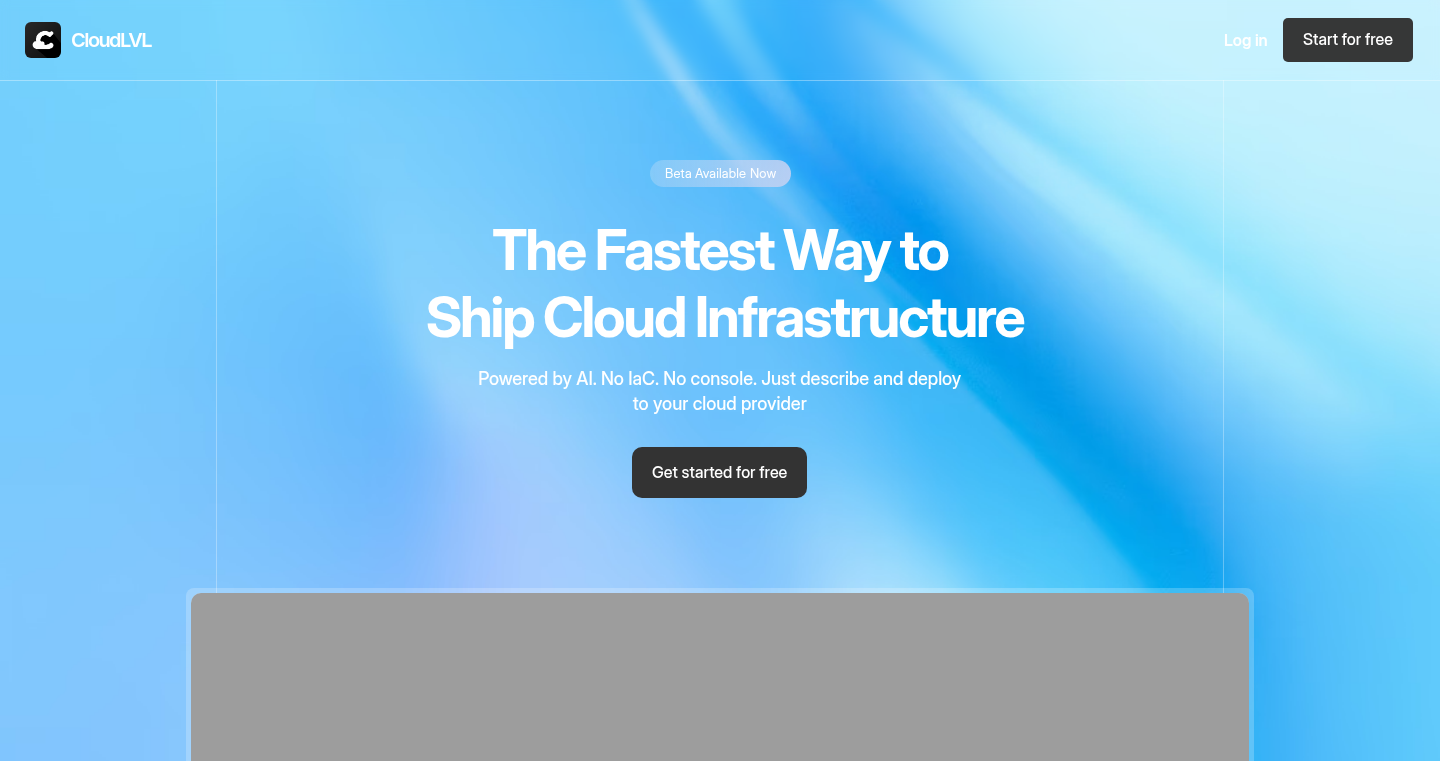
Author
mavdol04
Description
Cloudlvl is a tool that lets you control your cloud infrastructure using plain English. Instead of writing complex code, you can describe what you want your cloud services to do, and the system will handle the technical details of setting it up. It's particularly good at deploying serverless functions, like AWS Lambda. This allows developers to focus on the 'what' instead of the 'how', which represents a significant shift in how we manage cloud resources. So this makes building applications on the cloud faster and easier.
Popularity
Points 1
Comments 0
What is this product?
Cloudlvl uses the power of Artificial Intelligence to understand your instructions and translate them into the necessary code to set up and manage cloud resources, especially on AWS. Imagine you want to deploy a function that responds to HTTP requests. Instead of manually configuring all the AWS services, you can simply tell Cloudlvl, in simple terms, what you want, and it will handle the complex configuration behind the scenes. The core innovation lies in its use of natural language processing to automate the setup of cloud infrastructure. So this lets you skip learning the complicated details of AWS services.
How to use it?
Developers can use Cloudlvl by simply describing the desired cloud setup. You write a simple description like 'Create a Lambda function that triggers on HTTP requests'. Cloudlvl then interprets this request, generates the necessary configuration, and deploys the function. You don't need to know the specifics of AWS Lambda, API Gateway, or any other underlying services. It integrates into existing development workflows by taking human-readable instructions as input and producing deployed cloud resources. So you can build and deploy applications much more quickly.
Product Core Function
· Natural Language to Infrastructure: This core feature allows developers to use everyday language to define cloud resources. It converts human instructions into actual cloud configurations, bypassing the need for detailed knowledge of cloud provider APIs. So this removes the steep learning curve associated with cloud deployment.
· Serverless Function Deployment: Cloudlvl excels at deploying serverless functions (e.g., AWS Lambda). This is a key value proposition as serverless architectures are becoming increasingly popular. This function automates the process of creating, configuring, and deploying functions. So this simplifies the deployment of modern, scalable applications.
· AWS Service Support: The system currently supports several AWS services. The value here is the ability to easily orchestrate different AWS components, linking them together via natural language commands. So this creates a more user-friendly way to manage cloud services.
Product Usage Case
· Rapid Prototyping: A developer can rapidly prototype a new web application by describing the desired functionality in natural language, allowing them to quickly deploy and test serverless functions. For example, deploying a simple API endpoint to handle user login in minutes. So this can significantly speed up the development cycle.
· DevOps Automation: DevOps teams can use Cloudlvl to automate the infrastructure provisioning process. Instead of manually writing configuration files or using complex scripting, you can describe the desired state of your infrastructure, and Cloudlvl will manage the deployment. So this helps in creating automated and reliable deployments.
· Simplified Cloud Management for Beginners: Developers new to cloud computing can use Cloudlvl to learn and experiment without getting bogged down in the complexities of AWS services. By describing desired functionality in simple terms, they can easily deploy and manage cloud resources. So this lowers the barrier to entry for using cloud services.
84
Refactorly: Data Science for Domain Experts
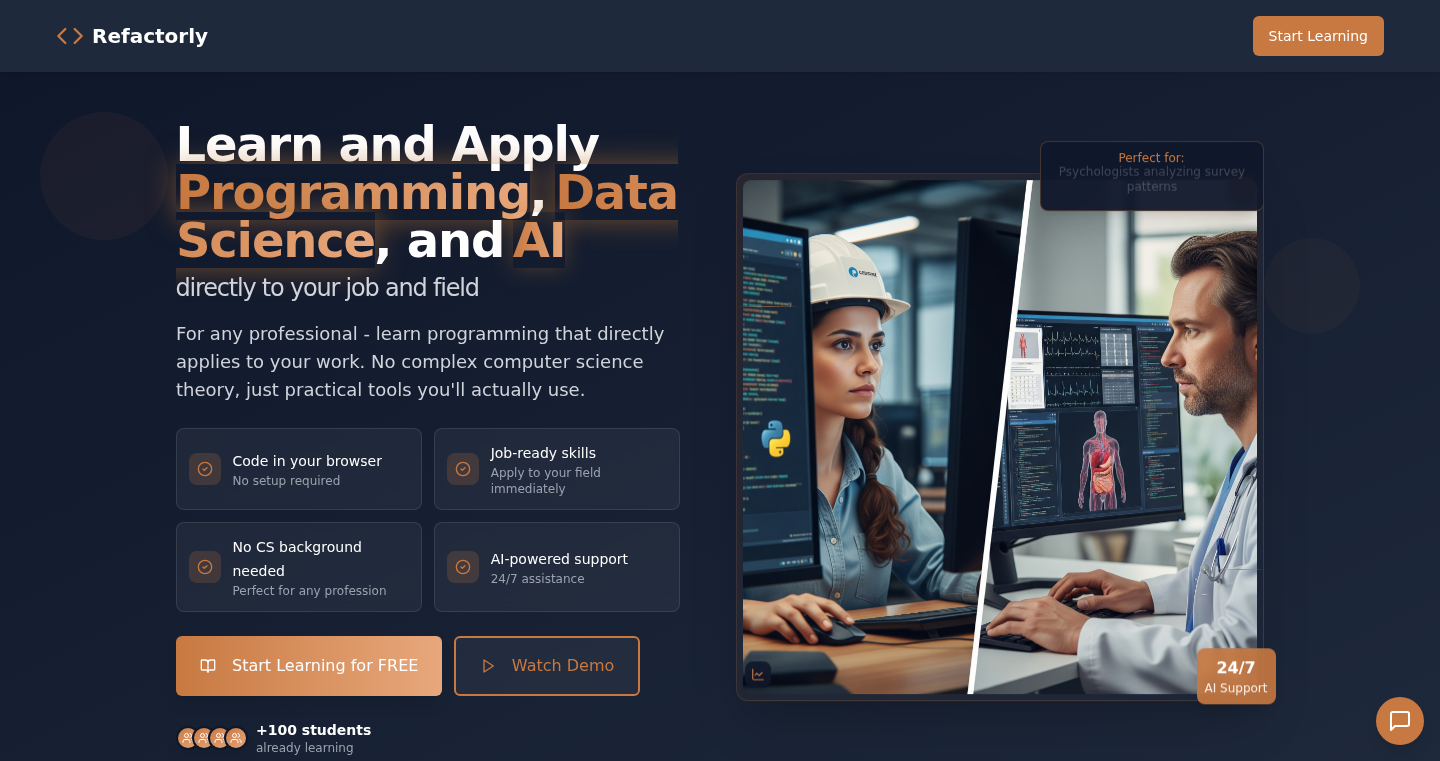
Author
leoBravoRain
Description
Refactorly is a platform designed to teach data science to professionals outside of the traditional computer science field, like chemical engineers, economists, and psychologists. It focuses on providing a practical, hands-on learning experience, helping users apply programming and data science techniques to their specific areas of work. The key innovation is its domain-specific approach, offering tailored content and examples relevant to different professional backgrounds. So, this helps you bridge the gap between theoretical data science and real-world application in your profession.
Popularity
Points 1
Comments 0
What is this product?
Refactorly is essentially a learning platform that helps you learn data science with examples and problems that are specific to your field. Instead of generic programming tutorials, it offers content tailored to chemical engineering, economics, psychology, and other fields. It likely uses interactive exercises and projects to make learning more engaging. The innovation lies in its focus on practical application, making data science accessible and useful for people who are not software engineers. For example, if you're a chemical engineer, you can learn how to analyze chemical reactions using data science tools. So this allows you to apply cutting-edge techniques directly to your daily work.
How to use it?
You would likely use Refactorly by creating an account and choosing your field of expertise. The platform would then guide you through a series of lessons, tutorials, and projects related to your area of work. You might use it to analyze datasets, build predictive models, or visualize data specific to your profession. Integration might involve importing your own datasets, connecting to relevant databases, or collaborating with colleagues on data science projects. So, you can apply data science directly to your own data and problems.
Product Core Function
· Domain-Specific Curriculum: Offers data science content tailored to various professional fields, ensuring relevance and practical application. This helps you learn the exact tools you need for your job.
· Interactive Learning: Uses interactive exercises and projects to reinforce learning and make the process engaging. This lets you learn by doing, making concepts stick.
· Practical Application: Focuses on applying data science techniques to real-world problems in different domains, allowing users to see immediate value. This means you can solve actual problems at work using what you learn.
· Foundation Building: Aims to provide a strong foundation in programming and data science fundamentals, enabling users to build upon their skills. This gives you the necessary skills to handle more complex tasks.
· User-Friendly Interface: Likely has a user-friendly interface that makes learning accessible to people outside of computer science. This makes learning data science less intimidating and easier to understand.
Product Usage Case
· Chemical Engineering: A chemical engineer can use Refactorly to analyze experimental data, optimize chemical reactions, or predict product yields. This helps improve processes and make better decisions.
· Economics: An economist can use the platform to analyze economic trends, build predictive models for financial markets, or assess the impact of policies. This allows for better forecasting and informed decision-making.
· Psychology: A psychologist can use Refactorly to analyze experimental results, identify patterns in patient behavior, or build predictive models for mental health outcomes. This enhances research and understanding of complex behaviors.
· Data Analysis in General: Anyone with numerical data in their profession can use the platform to analyze data. For example, an engineer can use it to monitor the performance of a piece of equipment, or a doctor can use it to analyze patients' health records.
85
Treasure Guessr: A Geo-Guessing Game Powered by Google Sheets
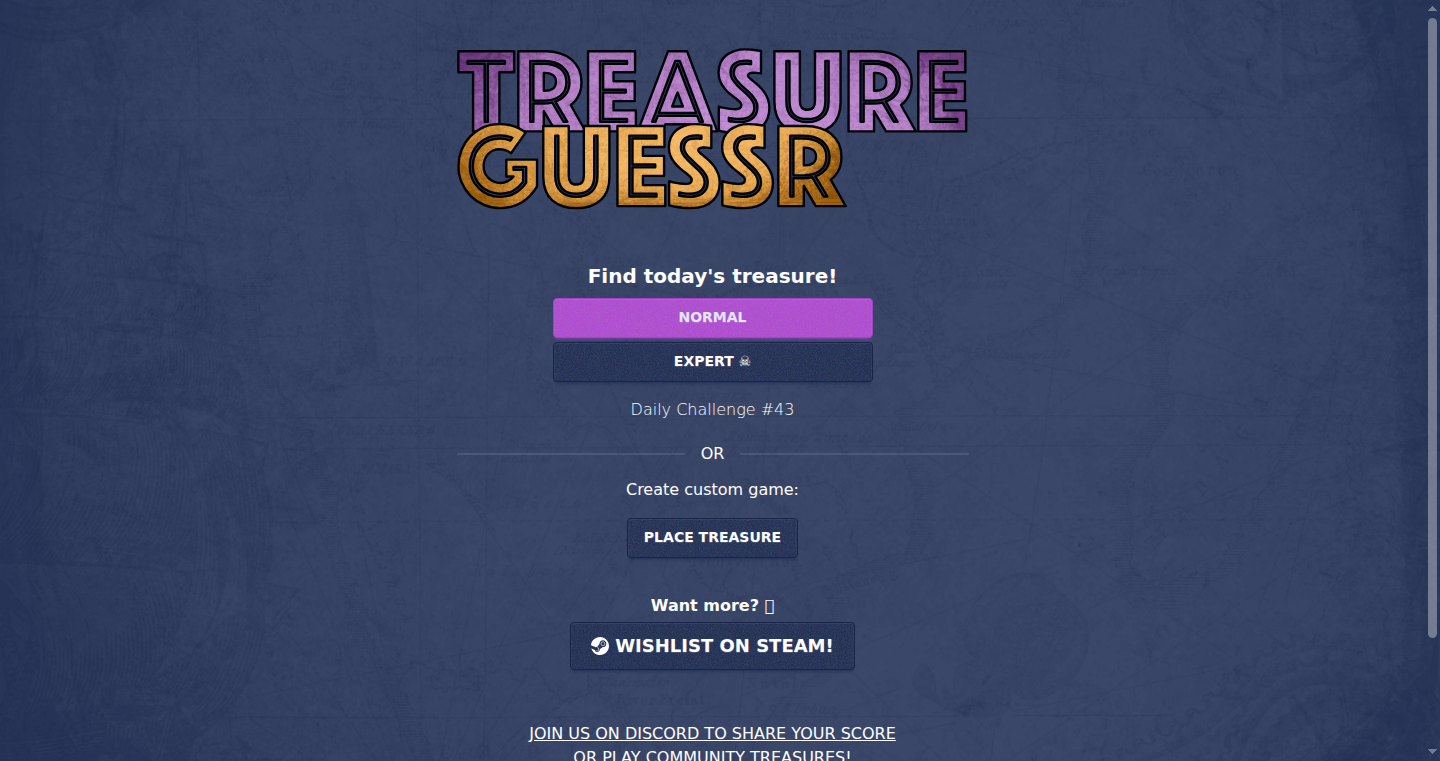
Author
teuteuf
Description
Treasure Guessr is a web-based game where you're shown a zoomed-in snippet of a world map and have to guess its location on a larger map. The innovative aspect lies in its simple yet effective backend: a shared Google Sheet directly feeding data to a React-based frontend. This showcases a clever approach to rapidly prototyping a game with minimal infrastructure, highlighting how readily available tools can be leveraged for creative projects. It addresses the challenge of quickly building a game with geographic data without needing complex database setups. So this is useful because it lets anyone build a simple location-based game very quickly and cheaply, without needing to learn complicated database technology.
Popularity
Points 1
Comments 0
What is this product?
Treasure Guessr is a fun, browser-based game inspired by GeoGuessr, but using a zoomed-in "treasure map" to challenge players. What's interesting is its backend. Instead of a complex database, it uses a Google Sheet. The game's frontend, built with React, directly pulls the data from the Google Sheet. This means setting up and managing the game's data is very easy. The innovation here is using a Google Sheet as a quick, scalable, and easily manageable data source for a game. So this is useful because it shows a simple, fast way to create a game that gets data from somewhere else.
How to use it?
Developers can use Treasure Guessr as inspiration for building location-based games or quizzes. The approach of using Google Sheets for the data backend is easily adaptable. You could create your own game with different maps, different types of data, and customize the React frontend to match the game's needs. The direct integration with Google Sheets simplifies data management. It's a great starting point for projects with limited budgets and teams. So this is useful because it shows you how to quickly create a similar type of game, by using tools you're already familiar with and how to reduce the work it takes to get started.
Product Core Function
· Zoomed-in Map Display: Displays a cropped view of a location on a global map, posing the challenge of location identification. This leverages the power of map APIs and image manipulation, offering a unique gaming experience. Application: Game designers can use it as a starting point to build location-based games or interactive experiences. It also demonstrates a simple technique to create map-based challenges.
· Global Map Interaction: Provides a global map for players to identify and pinpoint the zoomed-in location. It leverages the user interface of the map to create a game. Application: Educational applications where the users need to interact with a map to find a place and test its knowledge, or the map can be the base for the next game.
· Google Sheet Backend: Uses a shared Google Sheet to store and manage the game's data. This eliminates the need for a dedicated database setup, making it a low-cost solution. Application: Developers can use it as a model for building projects where data is frequently updated and doesn't require complex database interactions. In short, it gives you a simple and efficient data management technique.
· React Frontend: The game’s user interface is built with React, creating an interactive and responsive user experience. This showcases modern web development principles. Application: Developers can learn from the use of React to build web interfaces. The UI structure allows for easy customization and expansion.
Product Usage Case
· Educational Quizzes: A teacher creates a quiz where students have to locate historical events or landmarks using a map interface, powered by Google Sheets for simplicity. This provides a user-friendly interactive learning experience.
· Travel Planning App Prototype: A developer quickly builds a prototype for a travel game that involves guessing locations and planning itineraries. This helps streamline the development process and keeps costs down.
· Community-Based Geolocation Challenge: A community builds a map-based scavenger hunt where users share photos of specific locations and challenge each other to find them, all managed through a shared Google Sheet.
86
AssetForge: A Free App Store Image Generator
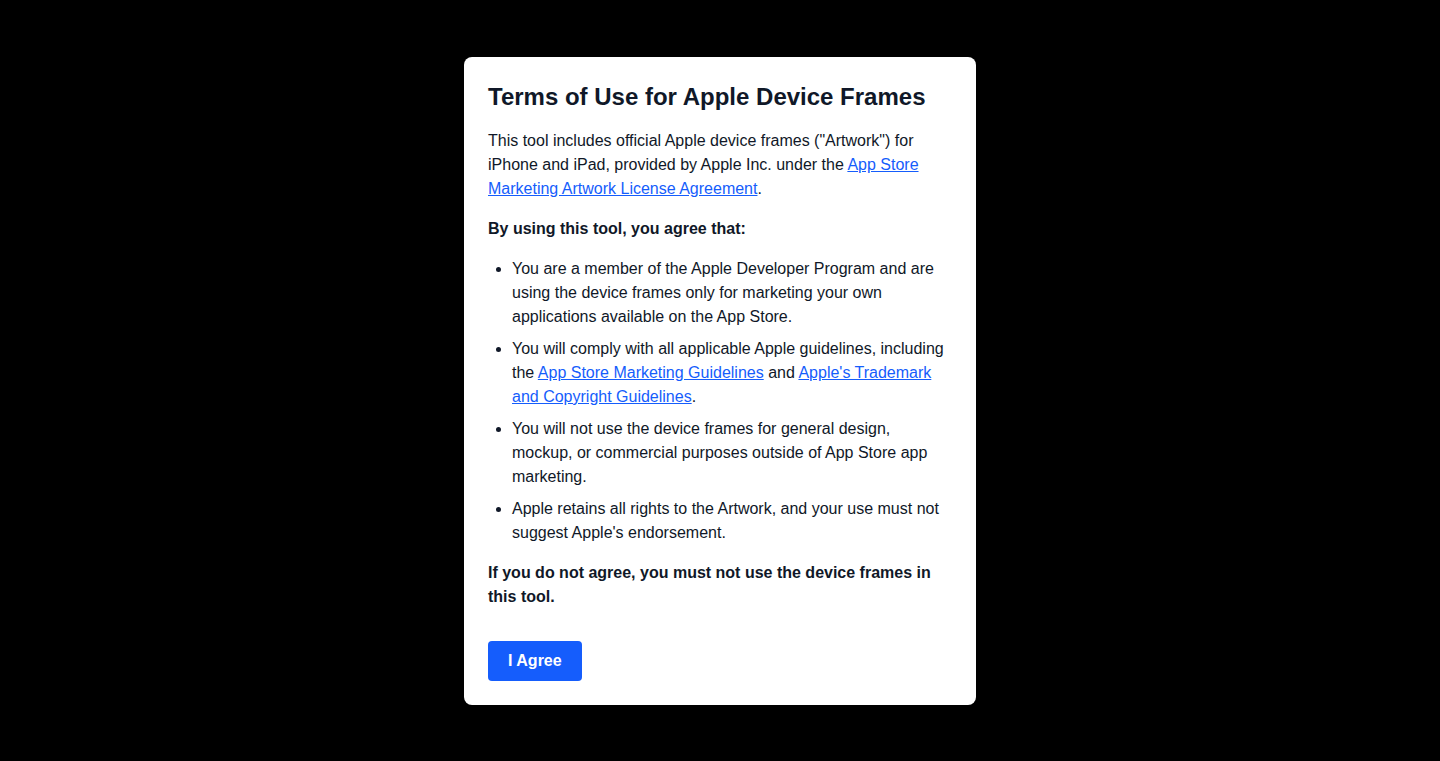
Author
boxedsound
Description
AssetForge is a straightforward, free tool designed to help developers create app store images without any sign-up required. It tackles the common problem of expensive or overly complex existing tools by offering a simple, accessible solution. The core innovation lies in its ease of use and focus on rapid asset generation, allowing developers to quickly export images for their app store listings. So this helps me by quickly and easily generating images for my app store listing, saving me time and money.
Popularity
Points 1
Comments 0
What is this product?
AssetForge is essentially a simplified image editor specifically tailored for creating app store assets. Instead of complicated features, it concentrates on the essentials: providing a basic set of tools for creating canvases (the image areas) and exporting them in a format suitable for the app store. The key technology is likely a web-based canvas implementation (using technologies like HTML5 Canvas or similar), allowing for easy cross-platform access through any web browser. The innovation is in its simplicity and the removal of barriers like sign-ups and complex interfaces. So this means I can easily generate app store images without the need for expensive software or a complicated learning curve.
How to use it?
Developers can use AssetForge by visiting the website, creating their images within the provided interface, and then exporting the generated assets. The integration is seamless; the exported images are directly ready for upload to the app store. This might involve adjusting image sizes and adding basic text or graphics. So I can quickly create a set of app store images, ready to be uploaded, without needing a separate image editing program.
Product Core Function
· Canvas Creation: This function allows users to define the working area (the image) for their app store assets. This is crucial for creating images of the right dimensions for various devices. This is useful because I can tailor the images to the size requirements of different devices in the app store.
· Basic Editing Tools: AssetForge likely provides basic tools for adding text, shapes, and perhaps basic image manipulation. This is essential for creating visually appealing assets. This helps me add visual elements to the images to make them more attractive.
· Export Functionality: This is the core feature, allowing users to export the generated images in common formats (like PNG or JPG) ready for upload to the app store. This is because I can have a ready-to-use image with the right format.
· No-Signup, Free Access: The accessibility is significant. The absence of a signup process and the free-of-charge access lowers the barrier to entry, making it easy for anyone to quickly generate images. This helps me to start using the tool right away without the hassle of creating an account.
Product Usage Case
· A developer launching a new mobile game can quickly create promotional images showcasing gameplay screenshots and key features, preparing their app store listing for launch. This solves the problem of needing professional image editing skills or paying for expensive software.
· An indie developer updating an existing app can use AssetForge to generate new app store assets to refresh their listing and increase visibility, showcasing new features or promotions. This addresses the need for quick and efficient image updates.
· A small business owner releasing a business app can use AssetForge to design app store images that clearly communicate the app's purpose and benefits, attracting potential users. This offers a cost-effective way to visually represent the app.
87
Vibe Foto: Prompt-Driven Image Editing

Author
zigakerec
Description
Vibe Foto is an experimental image editor that lets you modify photos using text prompts instead of traditional mouse-based tools. It uses the power of AI to understand your instructions, allowing you to remove objects, change styles, remodel rooms, add elements, and much more, all by simply typing what you want to happen. The core innovation lies in its text-to-image manipulation capabilities, offering a more intuitive and flexible way to edit photos compared to conventional methods. So, it's like having a virtual assistant that understands what you want to do with your pictures.
Popularity
Points 1
Comments 0
What is this product?
Vibe Foto is built on the principle of using artificial intelligence (AI), specifically natural language processing (NLP) and computer vision, to understand and execute your image editing requests. You type a description of what you want to change (e.g., 'remove the person,' 'make the room modern'), and the AI algorithms analyze the image and modify it accordingly. The core technology revolves around generative models that can create and manipulate images based on textual descriptions. It simplifies complex editing tasks, making it accessible and efficient. So, it eliminates the need to learn complex software interfaces and makes photo editing more about your vision than technical skill.
How to use it?
Developers can use Vibe Foto in various ways. They could integrate it into other applications that require image editing capabilities, or they could use it as a base to experiment with advanced image processing techniques. For instance, a real estate developer could use it to quickly visualize interior design changes. A marketing team could easily create compelling visuals for social media. It could be used to build custom image editing tools for specific needs. So, if you're building an app that needs to edit images, you can save time and effort by using text prompts instead of complex UI controls.
Product Core Function
· Object Removal: Allows users to erase unwanted objects from images by simply describing what to remove. The AI intelligently fills in the background, making the change seamless. This saves time and effort compared to manual retouching. So, you can easily clean up your vacation photos or remove distractions.
· Style Transfer: Enables users to transform the style of an image, such as making a photo look like a painting or applying a specific artistic effect, by using a text prompt. The AI analyzes the desired style and applies it to the original image. This opens up creative possibilities without requiring artistic skills. So, you can turn your photos into art with ease.
· Scene Remodeling: Allows users to change elements within a scene, for example, remodel a kitchen or change the furniture. It allows for rapid design iterations and visualizing modifications to an image's environment. So, this is perfect for interior designers or anyone planning home improvements.
· Object Addition: Lets users add new objects or elements to an image by describing what they want to add. The AI generates the new objects and integrates them into the scene naturally. This unlocks new creative possibilities. So, you can visualize different scenarios for product placement or simply add fun elements to your photos.
· Color Modification: It provides the option to change the color of specific elements like hair. It gives flexibility and customization to edit images. So, it allows users to easily experiment with different looks in images.
Product Usage Case
· Real Estate: A real estate company uses Vibe Foto to quickly stage photos of properties, adding furniture or changing the decor without the need for physical staging. So, this reduces costs and accelerates the marketing process.
· E-commerce: An online store uses Vibe Foto to remove the background from product images and create visually appealing product shots with consistent styling. So, it makes the product photos better and more consistent.
· Social Media: A social media influencer uses Vibe Foto to edit photos by adding special effects or removing blemishes, enhancing their content for their followers. So, it helps creators to quickly improve the look and feel of their social media posts.
· Interior Design: An interior designer uses Vibe Foto to show clients how their designs will look in a space, allowing for virtual remodeling and style experimentation. So, it allows designers to save time and money on staging and mockups.
88
Snowflake Native Fivetran Cost Monitor
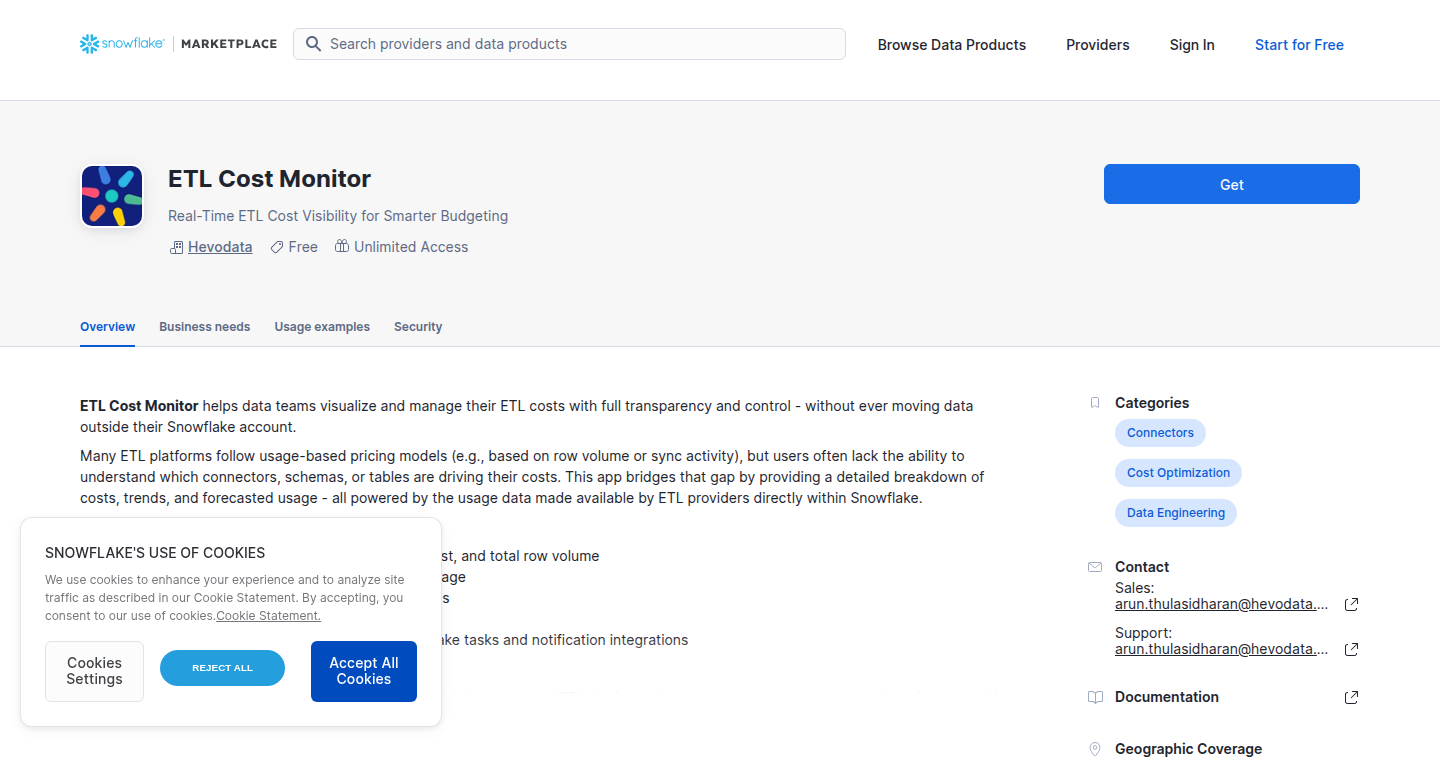
Author
abhilashtdharan
Description
This project is a cost monitoring application built directly inside Snowflake, a cloud data warehouse. It addresses the problem of complex Fivetran pricing by analyzing your data usage. The core innovation lies in its native integration within Snowflake, leveraging Snowflake's features for cost calculation, forecasting, and alerting. It provides detailed breakdowns of Fivetran costs, connector-level insights, and budget alerts, all within the Snowflake environment, so you don't need to leave your data warehouse to track costs.
Popularity
Points 1
Comments 0
What is this product?
This application calculates and forecasts your Fivetran costs, helping you understand where your data spending goes. It utilizes data from Fivetran's metadata tables and integrates directly with Snowflake. The technology is based on SQL queries and calculations performed within Snowflake itself. It also offers email alerts to keep you informed about your spending. This is innovative because it avoids the need for external tools or complex integrations, making cost management easier.
How to use it?
Developers can use this by installing the application from the Snowflake Marketplace. Once installed, it uses your Fivetran data and Snowflake's resources to calculate and display your costs. You can set up monthly budgets and receive email alerts when your costs exceed a certain threshold. The app provides insights into connector-level and table-level costs, enabling developers to optimize their data usage. This means you can monitor your Fivetran costs and data usage directly from within your Snowflake account.
Product Core Function
· Cost Calculation: It calculates your current and predicted Fivetran costs using your current pricing model and any contracted discounts, giving you a clear picture of your spending. This is useful because it helps you understand your current and future spending on Fivetran.
· Connector and Table-Level Breakdown: The application breaks down your costs by connector and table, helping you identify which connectors or tables are consuming the most resources. This enables you to optimize data pipelines and reduce unnecessary costs. So you can pinpoint the costliest data sources and make informed decisions.
· Cost Forecasting: This feature predicts your future costs based on current usage patterns, helping you budget effectively. This helps you to plan your spending and avoid surprises.
· Budget Alerts: The application allows you to set a monthly budget and receive email notifications if your actual or forecasted costs exceed the threshold. This enables you to control costs and prevent overspending. With this you can keep your costs under control and stay within your budget.
· MAR Spike Alerts: You'll receive alerts for sudden spikes in MAR (Monthly Active Rows) usage. This helps to quickly identify potential issues that are driving up costs. This means you can respond quickly to unexpected cost increases.
Product Usage Case
· Data Engineering Teams: Data engineers can use this application to proactively monitor and manage their Fivetran spending within their Snowflake environment, optimizing data pipelines and reducing costs. So you can immediately see how your data pipelines impact your budget and make necessary adjustments.
· Finance Departments: Finance teams can use it to get a clear understanding of Fivetran costs, enabling them to create accurate budget forecasts and monitor spending against budget. With this, you can track spending and make accurate predictions about future costs.
· Cost Optimization: Companies can use this application to identify cost-saving opportunities by pinpointing the most expensive data connectors and tables. This is helpful because you can take steps to reduce your data transfer costs by optimizing these areas.
89
CanonForge: AI-Powered Headcanon Generator

Author
TheraDeng
Description
CanonForge is a web application that uses AI to generate unexpected and detailed headcanons for fictional characters. It takes a character's name and a few descriptive traits as input, then leverages a language model (Claude Code from Anthropic) to produce hidden motivations, quirks, or backstories. This project aims to accelerate the creative process for fanfiction writers, role-players, and anyone who enjoys exploring the depths of fictional characters. The technical innovation lies in the application of AI to creatively generate text based on user input, providing a starting point for imaginative storytelling.
Popularity
Points 1
Comments 0
What is this product?
CanonForge utilizes a large language model (LLM) named Claude Code, essentially a sophisticated AI that understands and generates human-like text. You input a character's name and some characteristics, and the AI analyzes the information to create unique headcanons. The innovation is in using AI to spark creative ideas, turning a blank page into a starting point for fans to explore deeper into the character's world. So this is useful if you want to quickly brainstorm ideas for character development or generate interesting background stories for your favorite characters.
How to use it?
Users simply visit the website, enter a character's name and some details about them. The AI processes this and produces a headcanon, like a hidden motive or a quirk. You can use the generated text as inspiration for your writing, roleplaying, or just for fun. The site is browser-based and doesn't require any sign-up. It's built with Next.js and React, deployed via Cloudflare. So you can easily integrate this into your writing workflow, using the generated ideas as a catalyst for further creative exploration.
Product Core Function
· Character Input: Users provide the name of a fictional character and relevant traits.
· AI-Powered Headcanon Generation: The system uses Claude Code to produce creative headcanons.
· Output Display: Presents generated headcanons to the user.
· Web-Based Interface: Provides a user-friendly interface accessible through any web browser.
· Free Access: The application is freely available to use, without requiring registration.
· Next.js & React Frontend: The user interface is built using React, allowing for a dynamic and responsive experience.
Product Usage Case
· Fanfiction writers can use CanonForge to overcome writer's block by generating unexpected character motivations or backstories, giving them a starting point for their stories.
· Role-players can use the application to develop complex and nuanced character personalities for their roleplaying sessions, creating deeper engagement.
· Creatives can use it to explore different interpretations of a character, to inspire new character designs or stories.
· Teachers can use it to encourage students to do creative writing projects and explore character analysis. This will help them see how characters will be used in stories.
· Game designers can use it to quickly generate plot points or character arcs to reduce the time to make games.
90
AEO Navigator: A Guide to Answer Engine Optimization
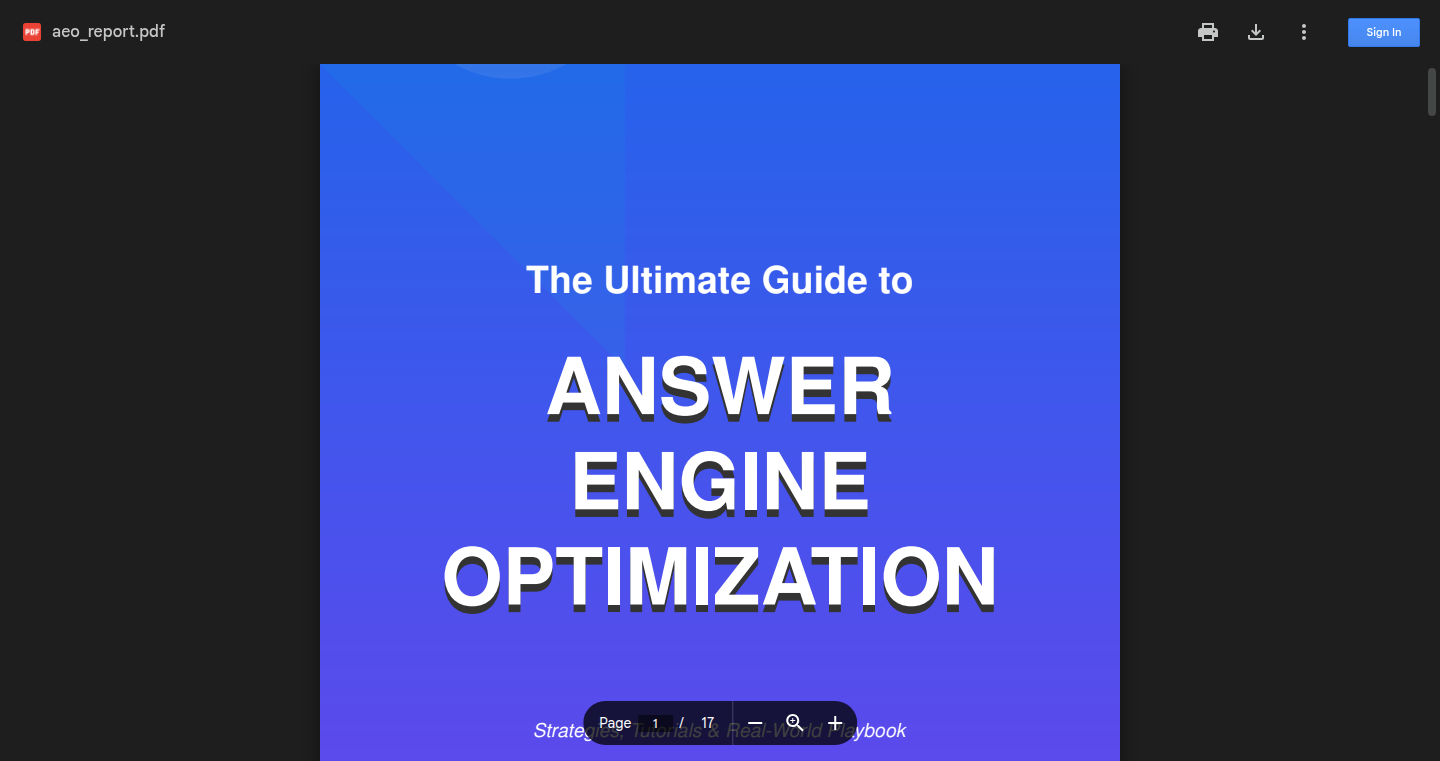
Author
sukhmani1303
Description
This project offers a beginner's guide to Answer Engine Optimization (AEO), a new approach to online content that focuses on making your content the direct answer within AI platforms like ChatGPT and Google's AI Overviews. It addresses the shift away from traditional SEO, where the goal was clicks, and towards being the source of truth for AI search results. The guide emphasizes the importance of structured content, schema markup, and E-E-A-T (Experience, Expertise, Authoritativeness, Trustworthiness) in this evolving search landscape. So, it helps you understand how to get your content featured directly in AI responses instead of just appearing in search results.
Popularity
Points 1
Comments 0
What is this product?
This is a PDF guide that explains Answer Engine Optimization (AEO). Instead of focusing on getting people to click on your website link (traditional SEO), AEO aims for your content to be the direct answer that AI platforms like ChatGPT and Google AI use. It shows how to optimize content so that it's cited as the source. The guide explains technical concepts like schema markup (a way to structure your website data so that search engines can understand it better), and why factors like experience and trust (E-E-A-T) are now more important than ever. It also provides real-world examples and business opportunity insights in this emerging field. So, you'll understand the future of search.
How to use it?
You can use this guide to understand how AEO works and how to improve your content strategy. It's designed for marketers, founders, and content creators. By learning about schema markup and E-E-A-T, you can start structuring your content to be more easily understood by AI search engines. The guide offers examples and case studies to guide you, it is a great reference for creating content that AI platforms will prioritize. So, you can adapt your content strategy for better visibility in AI-powered search.
Product Core Function
· Understanding the shift from SEO to AEO: Explains why traditional SEO is becoming less effective and how AEO is the new focus. This is valuable because it helps you understand that the rules of the game are changing and you need to adapt your strategy to be visible.
· Deep dive into Schema Markup: Explains what schema markup is and how to use it to structure your content. This is extremely valuable as it is a key aspect of making it easier for AI platforms to understand and rank your content.
· Focus on E-E-A-T (Experience, Expertise, Authoritativeness, Trustworthiness): Highlights the importance of these factors in AEO. This matters because it directly influences how AI platforms judge the quality of your content and cite it as a source.
· Real-world examples and case studies: Provides concrete examples of how AEO works in practice. This is very important for you to visualize and understand how to implement the tips mentioned in the guide.
· Identification of business opportunities in AEO: Shows you where the emerging business opportunities are in this field. You can use this to discover new avenues for generating traffic, leads and building brand authority.
Product Usage Case
· A content creator uses the guide to restructure their blog posts with schema markup, and their content is then featured as the direct answer in Google's AI Overview. So, it drives more visibility and authority.
· A marketing agency implements AEO strategies based on the guide's recommendations for a client's website, resulting in the client's content being cited by ChatGPT as a source. This delivers more qualified leads.
· A startup leverages AEO best practices to optimize its website content, improving its ranking on AI-powered search results. This can lead to increased website traffic.
· A founder uses the guide to better understand how to position their product to rank well in AI-powered searches. This is how you get a competitive edge.
91
TyxonQ: Quantum-Classical Hybrid Computing Platform
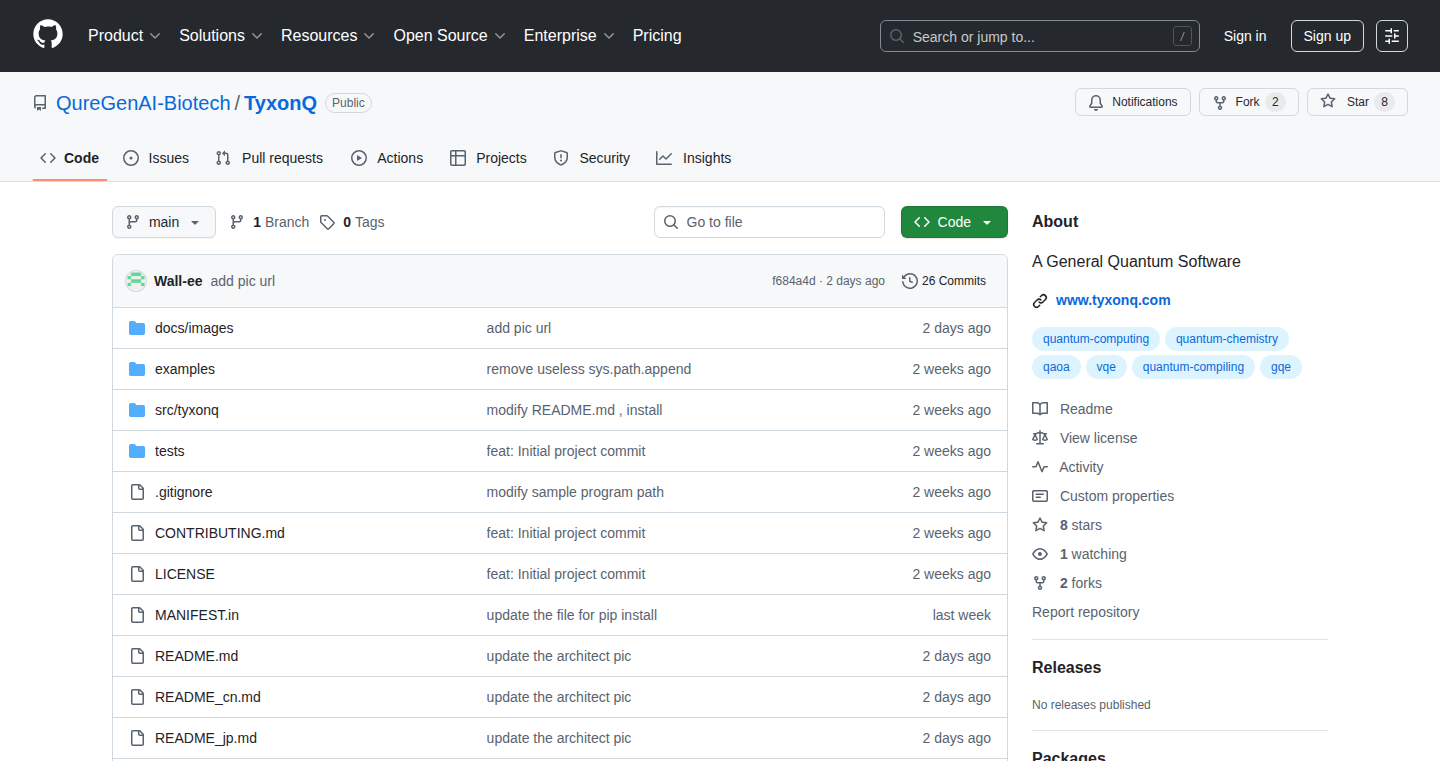
Author
TyxonQ
Description
TyxonQ is a full-stack quantum software framework that aims to simplify access to quantum computing. It allows users to run algorithms on real quantum hardware (superconducting processors) and integrates quantum computing with AI. The platform provides tools for designing and running quantum circuits, and it's designed to be user-friendly for both quantum computing experts and those new to the field. It offers a 'Quantum-Per-Second' (qps) billing system, which makes it easier to understand and manage the cost of using quantum resources. The project uses an open-source license (Apache 2.0), encouraging collaboration and innovation in the quantum computing community. It is particularly focused on applications in drug discovery and materials science.
Popularity
Points 1
Comments 0
What is this product?
TyxonQ is a software platform that makes quantum computing more accessible. Think of it as a bridge between complex quantum hardware and practical applications. It allows users to create and run programs (quantum circuits) on real quantum computers, not just simulations. The core innovation lies in the integration of real quantum hardware with AI, providing tools for natural language to quantum circuit translation and integration with machine learning models. This enables researchers and developers to explore the potential of quantum computing for solving complex problems, like drug design and materials science. So, it provides tools to leverage the power of quantum computers without needing to be a quantum physics expert.
How to use it?
Developers can use TyxonQ to build and run quantum programs. You write code to define a quantum circuit and send it to the platform to be executed on a quantum computer. It provides a simple Python API to interact with the quantum hardware. For example, you might use the following code to submit a task:
python
import tyxonq as tq
from tyxonq.cloud import apis
apis.set_token("YOUR_API_KEY")
task = apis.submit_task(device="homebrew_s2", circuit=my_circuit)
Then, it integrates with popular machine-learning frameworks such as PyTorch and TensorFlow. This allows developers to use existing AI tools alongside quantum computing. So, you can use this platform if you are a researcher wanting to test quantum algorithms, or a developer who wants to explore the future of computation by combining quantum computing with AI.
Product Core Function
· Direct Quantum Hardware Access: This allows developers to directly schedule and run tasks on superconducting quantum processors. This is valuable because it allows users to experience real-world quantum computing, not just simulations.
· AI-Native Quantum Compilation: Translates high-level instructions into quantum circuits more efficiently. This simplifies the development process and makes it easier for researchers to express their ideas in terms of quantum operations.
· Generative Quantum Eigensolver (GQE): Uses AI to help design quantum circuits. This can streamline the process of developing quantum algorithms, opening up new avenues for discoveries.
· Quantum Chemistry Simulations: It enables the simulation of molecular structures and reactions. This is beneficial in drug discovery and materials science as it allows for exploring molecular behavior.
· Integration with Machine Learning Frameworks: TyxonQ is compatible with PyTorch/TensorFlow, simplifying the combination of quantum computing and AI algorithms.
· Open-Source License (Apache 2.0): This promotes transparency and collaboration, enabling other developers to contribute to the platform's development, improving the platform’s quality and utility.
Product Usage Case
· Drug Discovery: Researchers could use TyxonQ to simulate the behavior of drug molecules, accelerating the process of discovering and developing new medicines. This can speed up research, potentially leading to faster development of life-saving treatments.
· Materials Science: Scientists can design new materials by simulating their properties on quantum computers. This leads to improvements in the performance of solar panels, batteries, and other technologies.
· Quantum Machine Learning: Developers can utilize existing machine learning models and combine with quantum computing. This will offer novel solutions in a wide variety of fields from finance to data analysis.
· Financial Modeling: Financial analysts could utilize quantum algorithms to optimize investment strategies and predict market trends more accurately. This can allow for making smarter decisions and getting a competitive advantage.
· Cryptography: Security experts can explore quantum-resistant cryptographic algorithms on the platform. This will strengthen security systems against future quantum computer attacks.
92
iChatroom: A Retro-Modern Chatroom Reimagined
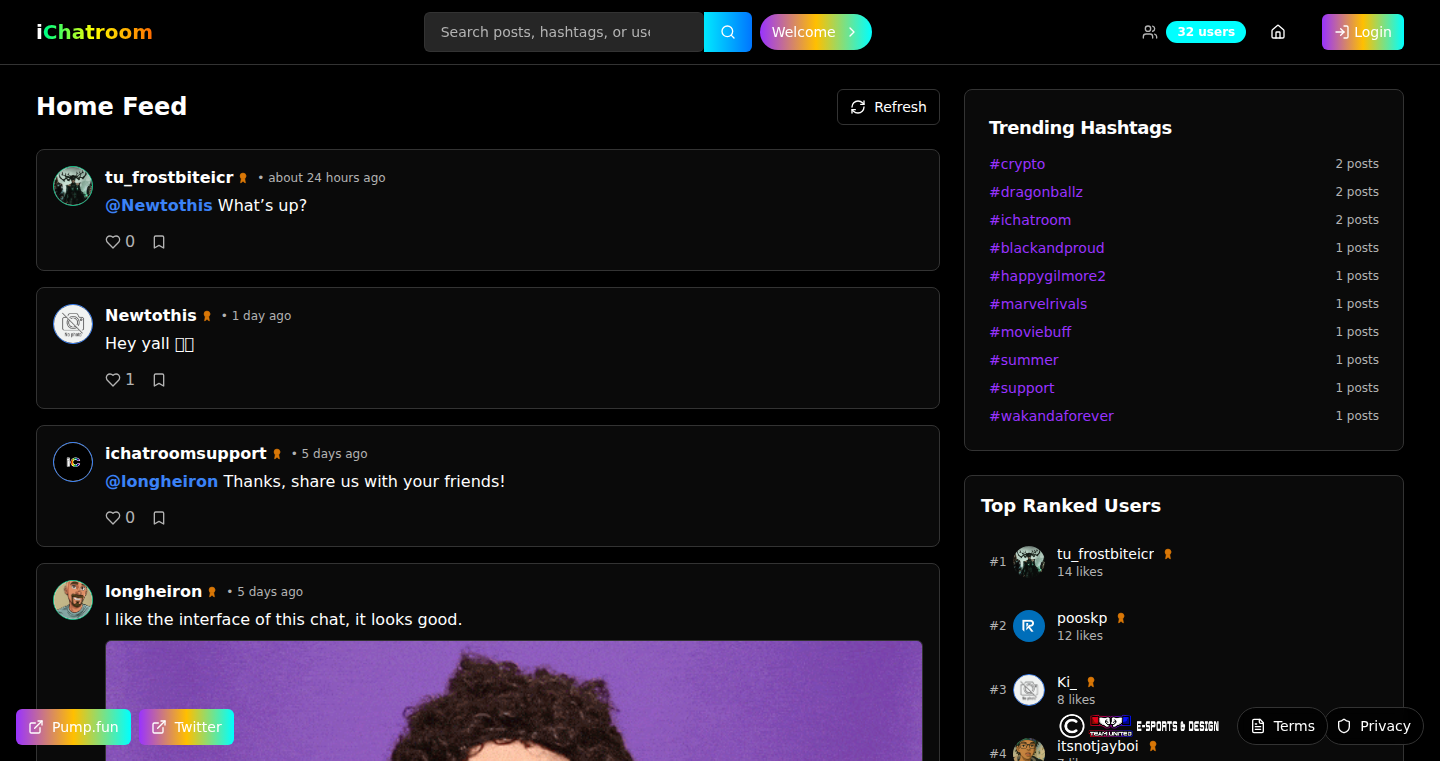
Author
teamunited
Description
iChatroom is a basic chatroom, bringing back the feel of early internet forums and chat services. It's built as a way to facilitate open discussions, providing a space for venting, debate, and social interaction. The core innovation is its focus on simple functionality and a straightforward user experience, emphasizing conversation over advanced features. This project explores the concept of building a functional communication platform with minimal dependencies and a focus on core principles.
Popularity
Points 1
Comments 0
What is this product?
This is a chatroom, like the ones from the early days of the internet. Instead of fancy features, it focuses on simple text-based communication. It's built with a 'dark web' aesthetic in mind, which means it's designed to be a straightforward and easy-to-use platform without a lot of visual clutter. The technical innovation is its commitment to fundamental chatroom mechanics, suggesting a lightweight and highly customizable design that could easily be deployed and maintained.
How to use it?
Developers can use iChatroom as a foundation or example for building their own chat applications. Its simplicity makes it ideal for learning about real-time communication technologies and network programming. You can integrate it into your projects by studying its source code, which likely involves technologies like WebSockets or server-sent events for real-time updates. So you can quickly build a chat feature into your website or app.
Product Core Function
· Basic Text-Based Chat: The core function is to allow users to send and receive text messages. It enables real-time, back-and-forth conversations. This is useful because it provides a simple, reliable communication system that's the foundation of any chat application.
· User Presence Indication: The project possibly includes basic features to indicate who is online, which enhances user experience by displaying user activity. This is useful because it helps users see who is available and fosters a sense of community and engagement.
· Message History and Persistence: It probably saves messages, to allow users to review the conversation history. This is useful because it provides context and allows new users to understand previous discussions when they join.
Product Usage Case
· Building a Lightweight Chat Application: Developers can study and adapt iChatroom's code to create a custom chat application for their own use, possibly with a simple architecture to reduce dependency. So you can quickly build a chat feature into your website or app.
· Educational Tool for WebSockets: iChatroom can be used as a practical example to learn the fundamentals of real-time communication using WebSockets. This is useful because you get a hands-on understanding of how data can be exchanged instantly over the internet.
· Developing a Minimalist Communication Platform: The project is suitable for developers aiming to build a very basic and fast chat application with no bells and whistles, such as the one used in a small community to facilitate communication.
93
VoxChat: Decentralized Anonymous Voice Connection

Author
huhtho
Description
VoxChat is a free and anonymous voice chat platform. It allows users to connect with strangers worldwide with just a click of the 'Start Chat' button. The core innovation is its commitment to complete anonymity and a clean user experience, solving the common problems of existing platforms which often lacked true anonymity or suffered from poor design. It's a voice-only platform with optional age/gender preferences, facilitating instant connections without requiring any user accounts. So this allows for quick and private conversations with anyone, anywhere.
Popularity
Points 1
Comments 0
What is this product?
VoxChat is built upon the idea of a server-client architecture, focusing on low latency and secure voice transmission. The technology behind it is likely utilizing WebRTC (Web Real-Time Communication) for real-time audio streaming directly between users' browsers or clients, minimizing the need for a central server relaying all audio data and potentially improving privacy. The anonymous nature is achieved through obfuscating user identities, likely using techniques such as IP address masking and not storing any identifying information. This innovative approach emphasizes user privacy and a user-friendly interface, contrasting with the often cluttered and identity-requiring designs of similar platforms. So this gives you a truly anonymous platform for real-time voice communication.
How to use it?
Developers can't directly 'use' VoxChat in the traditional sense, as it's a user-facing application. However, developers can learn from the project's design and implementation. For example, developers building similar applications requiring real-time communication can study the use of WebRTC for direct audio streaming. They can also glean insights into designing anonymous systems and implementing user preferences for matching. The clean interface and instant connection aspects offer a lesson in UX design for developers aiming to build user-friendly real-time applications. So this provides valuable insights and techniques for developers working on real-time communication platforms, especially those emphasizing user privacy.
Product Core Function
· Anonymous Voice Chat: The core functionality is the ability to instantly connect with another user for a voice conversation without requiring any registration or identification. The technical implementation behind this involves establishing a WebRTC connection for direct audio streaming, bypassing the need for a central server to handle the audio data, thus improving privacy. This is useful for private conversations, anonymous feedback, and spontaneous interactions, providing a low-barrier entry to voice communication.
· Age/Gender Preferences: Users can optionally filter their matches based on age and gender. This feature likely involves a matching algorithm that takes these preferences into account when connecting users. This functionality uses data filtering on the client to get users that align with their preferences and offers a better communication experience for the users.
· Instant Connection: The platform prides itself on connecting users immediately. This functionality relies on optimized server infrastructure and efficient algorithms to quickly find and match available users. Developers can draw inspiration for building applications with minimal wait times for users.
· Clean Interface: The project's interface emphasizes simplicity and ease of use. This is a fundamental aspect of user experience, achieved through careful design choices. Developers can learn from its example to create user interfaces that are intuitive and easy to navigate, prioritizing functionality over visual complexity and improving user engagement.
Product Usage Case
· Anonymous Peer Support Groups: Imagine a platform where people can connect anonymously to discuss sensitive issues. VoxChat's anonymity features allow for such safe spaces to be created. Users can voice their thoughts and concerns without fear of judgment or identification, enabling a genuine and secure exchange.
· Language Practice: For language learners, VoxChat offers an environment for real-time spoken practice with native speakers. Without revealing any personal information, users can converse casually, providing an open and non-intimidating environment to practice their verbal skills.
· Casual Discussions: Individuals can use VoxChat to have a free-flowing conversation. Random connection to people from all over the world creates many new conversations and connections, that might not have been possible otherwise.
94
MuseumWhisper: AI-Powered Instant Audio Guide
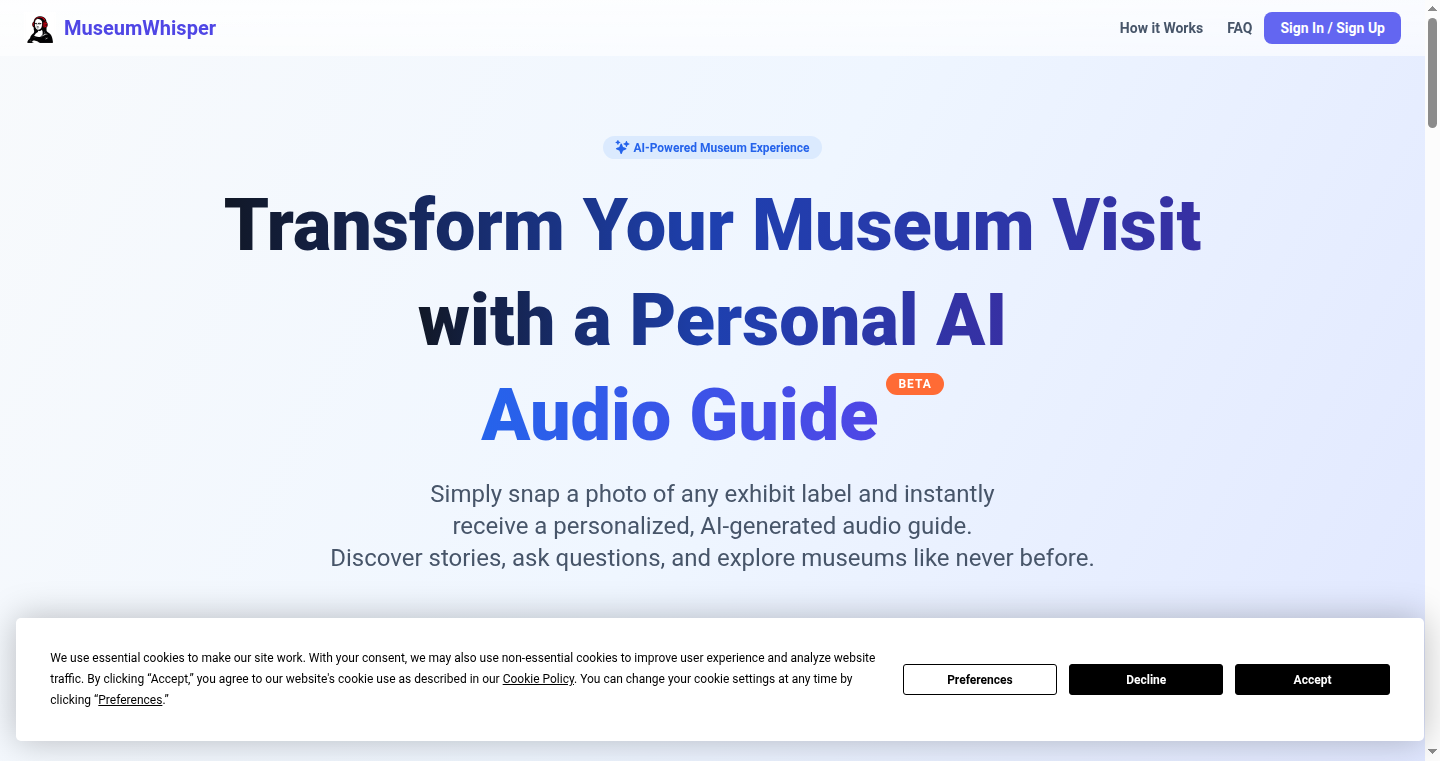
Author
ywsp
Description
MuseumWhisper is a web app that generates instant audio guides for museum exhibits. By simply taking a photo of an exhibit label or typing in the information, users can receive an AI-generated narration, enhancing the museum experience. The innovation lies in leveraging AI to provide on-demand, personalized audio content, addressing the limitations of traditional museum audio guides and the time-consuming nature of reading labels. It's a practical application of AI in the cultural sector, offering a more engaging and informative way to learn within a museum setting. This project highlights a user-friendly approach to incorporating AI into everyday experiences, specifically focused on improving accessibility and information delivery in cultural contexts.
Popularity
Points 1
Comments 0
What is this product?
MuseumWhisper utilizes Artificial Intelligence (AI) to create audio guides on demand. The core technology involves Optical Character Recognition (OCR) to extract text from exhibit labels captured via photo. This text is then processed by an AI model to generate a concise and informative narration. The system uses Natural Language Processing (NLP) to understand the text and synthesize a spoken explanation. The innovation lies in the combination of OCR, NLP, and text-to-speech (TTS) to deliver a personalized audio experience. So this gives you a personal tour guide right in your pocket.
How to use it?
Developers can use MuseumWhisper by integrating it into their own museum apps or developing browser extensions that can easily pull information from websites. A developer could create a custom interface for the user to capture the images and access the audio output. The AI could be used as a foundation for creating other educational tools. For instance, the AI-generated narrations can be used to build flashcards or provide supplemental information by linking the content to other related data. So it’s very simple to get started, and if you are a museum, it lets you add AI-powered tours to your exhibits easily.
Product Core Function
· Image-to-Text Conversion: Utilizes OCR technology to extract text from images of exhibit labels. This allows the app to understand the exhibit information, useful for extracting text from any photo.
· AI-Driven Narration Generation: Employs AI to analyze the extracted text and create a concise, informative audio narration. This enables it to create instant tour guides for any exhibit.
· User-Friendly Interface: Provides a simple interface for capturing label information (photo or manual input) and accessing the generated audio guide. This allows anyone to easily get a narration for an exhibit.
· Dynamic Content Adaptation: The AI models can be continuously updated to refine the audio guide based on user feedback and new information. This creates a better experience over time.
· Accessibility: Allows users with visual impairments or those who prefer auditory learning to access exhibit information more easily. This allows you to make museums more accessible to more people.
· Multilingual Support: The system potentially can be expanded to support multiple languages for a broader audience. This allows users to experience museums regardless of language.
Product Usage Case
· Museum App Integration: Integrating MuseumWhisper's API into a museum's existing mobile app can provide an instant audio guide feature, improving the user experience. For example, a museum could incorporate this technology so a user could select the exhibit and the tour would start automatically.
· Education Application: In classrooms or educational programs, the technology can be used to create quick summaries and explanations of text-based materials. The result is a deeper understanding of the content.
· Personalized Learning Tools: Users could use this technology to help to create customized study guides and educational materials. It provides personalized learning paths.
· Virtual Museum Tours: Implementing MuseumWhisper's features in virtual reality (VR) museum experiences to create an immersive, interactive tour. You could have a virtual tour guide using the AI and get all of the information in real time.
· Accessible Information for the Visually Impaired: This technology can be used to generate an audio description of objects in museums, providing a more accessible experience for visually impaired individuals.
95
Unlimitalk: Your iOS Audible Companion with AI Voices
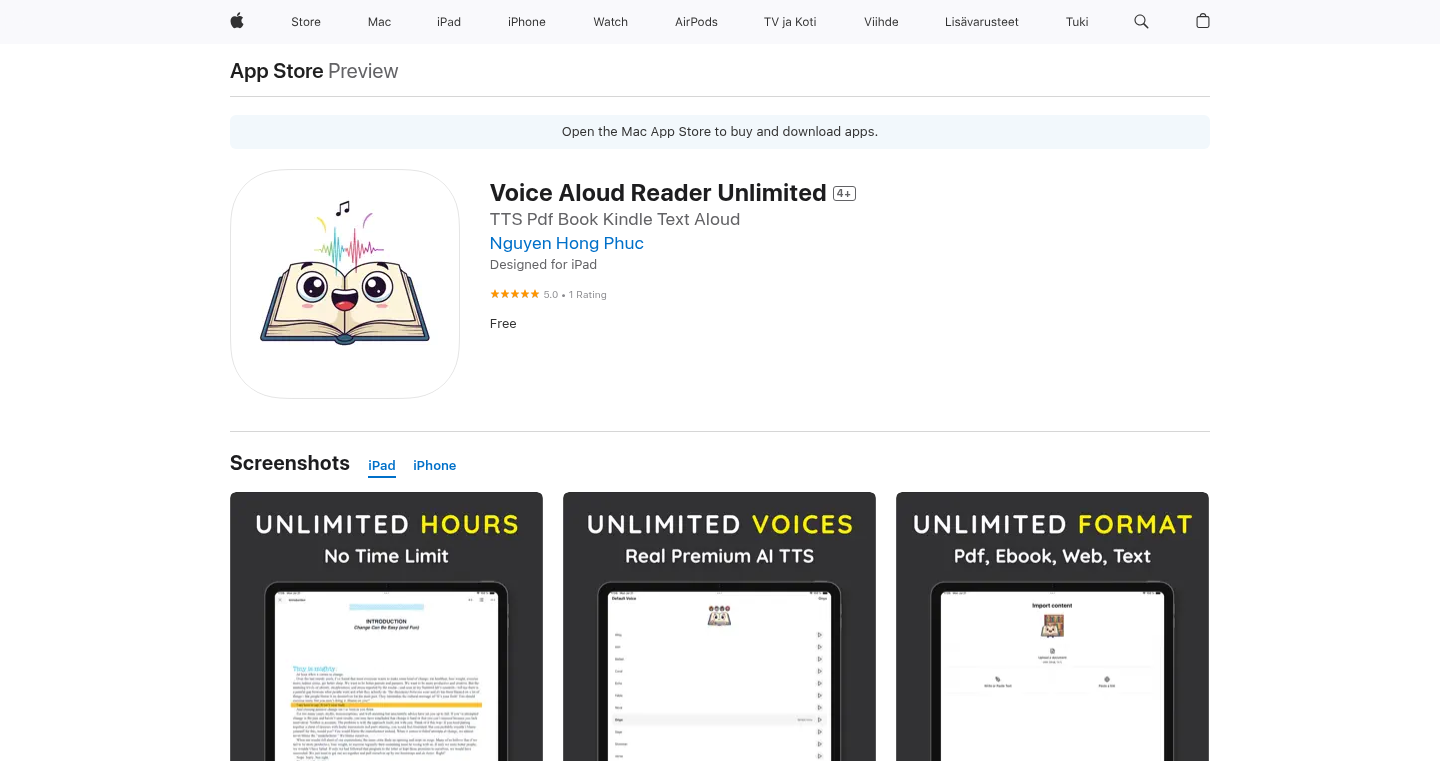
Author
stevenhp
Description
Unlimitalk is an iOS application designed to convert text to speech, offering an unlimited listening experience without the limitations of character counts or time constraints. It leverages advanced AI voices to deliver natural-sounding audio, making it ideal for listening to long-form content such as ebooks and articles. It aims to solve the common user frustrations with existing text-to-speech tools, providing a seamless and enjoyable listening experience, especially for Kindle books.
Popularity
Points 1
Comments 0
What is this product?
Unlimitalk is a text-to-speech (TTS) application for iOS. It stands out by offering truly unlimited listening hours, meaning you can listen to content for as long as you want without worrying about usage limits. The application uses high-quality, modern AI voices that sound very human-like, unlike the robotic voices often found in older TTS tools. This allows users to listen to various content, including PDFs, EPUBs, web articles, and, importantly, Kindle books. So, it enables you to effortlessly listen to ebooks, articles, or documents on your iPhone or iPad, providing a more convenient and immersive way to consume information. It's a personal listening assistant, transforming your reading into listening.
How to use it?
Users can easily import text from various sources. You can upload PDF and EPUB files, copy and paste from websites, or directly integrate with your Kindle library. Once the content is loaded, Unlimitalk will begin reading aloud using the selected AI voice. It’s as simple as importing the text and pressing play. So, you can listen to your favorite books or articles hands-free while commuting, exercising, or doing chores.
Product Core Function
· Unlimited Listening: Unlimitalk allows users to listen to content without any restrictions on hours or character counts, providing a seamless and uninterrupted listening experience. This is valuable because it removes the barrier of limited usage, allowing users to consume large amounts of content without interruption, something existing TTS apps often limit.
· High-Quality AI Voices: The application incorporates advanced AI voices that sound natural and engaging, which significantly enhances the listening experience compared to older, robotic-sounding text-to-speech systems. This helps make the listening experience more enjoyable and reduces listener fatigue, improving retention and enjoyment.
· Multi-Source Content Import: Users can import text from PDFs, EPUBs, web articles, and Kindle books, offering a versatile solution for consuming a wide variety of content. This improves the user's ability to consume information from multiple platforms, greatly increasing flexibility and adaptability.
· Kindle Book Integration: A key feature is the ability to read Kindle books directly within the app, providing a convenient way for Kindle users to listen to their books on the go. This feature removes the need to use multiple apps and streamlines the process of listening to Kindle books.
· Android Version (Future): While currently iOS only, an Android version is in development. This extends the usability of the app to a broader range of users and devices. This helps make the experience available to more users on their devices, making it an inclusive design choice.
Product Usage Case
· Commuting Audiobook Consumption: A user can import a Kindle book into Unlimitalk and listen to it during their daily commute without worrying about time limits or the quality of the voice. This solves the problem of reading during commute and offers a better alternative to listening to low-quality audiobooks.
· Hands-Free Learning: Students can upload lecture notes or articles and listen to them while doing other tasks, enhancing their understanding and retention of the material. It solves the problem of passive reading and allows them to actively listen while being productive in other ways.
· Accessibility for Visually Impaired: Individuals with visual impairments can utilize Unlimitalk to convert text into spoken words, providing access to various forms of content that would otherwise be inaccessible. This ensures information accessibility.
96
BacktestAI: Strategy Backtesting from Natural Language
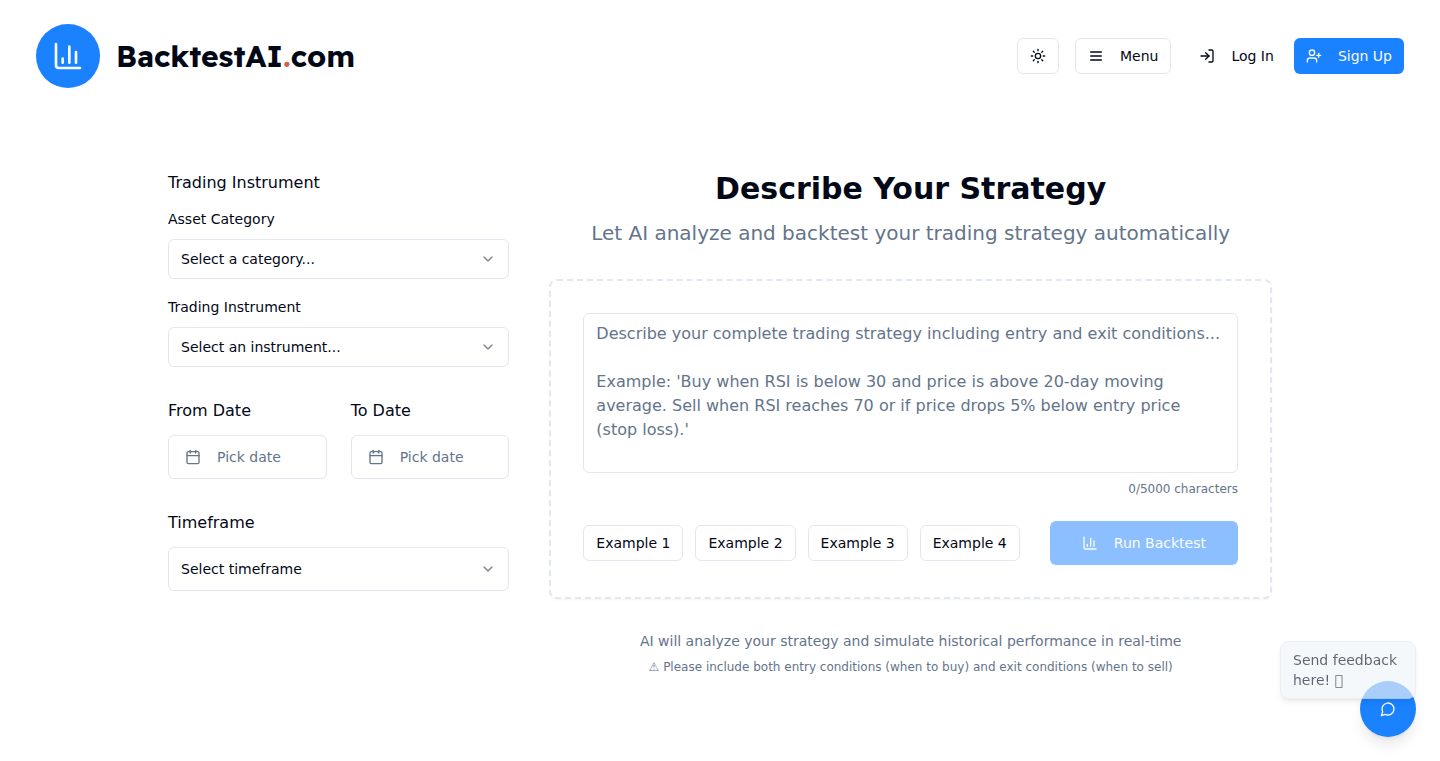
Author
AmineBl
Description
BacktestAI is a tool that lets traders test their trading strategies by simply describing them in plain English. It overcomes the time-consuming and complex nature of manual backtesting or the need for coding skills. Users can input their strategy in natural language, and the tool automatically runs backtests on historical data, providing results, metrics, and even AI-driven suggestions for improvement. This is a significant innovation because it democratizes the backtesting process, making it accessible to traders without technical expertise and greatly accelerating the strategy evaluation process.
Popularity
Points 1
Comments 0
What is this product?
BacktestAI takes your trading strategy descriptions, written in everyday English, and automatically runs them against historical market data. Imagine you tell it, 'Buy when the stock price goes above yesterday's high, sell if it drops too low or reaches a certain profit.' The tool understands this, simulates trades based on these rules, and shows you the results – how much money you would have made or lost, how often you would have won, etc. This is achieved through natural language processing (NLP) to understand the strategy and then computational finance techniques to simulate trades. The innovation is that it bridges the gap between human-readable instructions and complex financial analysis, making it easy for anyone to test their trading ideas. So this is useful for traders to quickly validate or refine their strategies without having to code or spend hours manually analyzing data.
How to use it?
To use BacktestAI, you simply type your trading strategy into the system, using plain English. For example, you might write: 'Buy when the 50-day moving average crosses above the 200-day moving average. Set a stop-loss at 2% below the entry price, and take profit at 4%.' The tool then processes this description, backtests the strategy on historical data, and presents the results in an easy-to-understand format. You can then analyze these results to see if the strategy is profitable and make adjustments to improve it. You don't need to be a programmer; just describe your strategy. This is applicable in any scenario where you want to test a trading strategy before putting real money at risk, across various financial markets, including stocks, forex, and cryptocurrencies. So this means you can test your trading ideas easily.
Product Core Function
· Natural Language Processing (NLP) for Strategy Interpretation: The tool uses NLP to translate human-readable trading strategies into actionable code. Value: This removes the coding barrier, allowing traders to express their ideas directly and eliminating the need to learn a programming language like Python or R. Application: Allows non-technical traders to quickly prototype and test new trading ideas.
· Automated Backtesting Engine: Once the strategy is understood, the engine runs backtests on historical data to simulate trades. Value: Provides rapid feedback on the performance of a trading strategy, including profitability, risk metrics, and potential drawdowns. Application: Crucial for risk management and refining strategies before live trading.
· Performance Metrics and Reporting: Generates detailed reports on strategy performance, including key metrics like profit factor, win rate, and average trade duration. Value: Provides clear, actionable insights into the strengths and weaknesses of a trading strategy. Application: Enables data-driven decision-making for optimizing trading strategies.
· AI-Driven Strategy Suggestions: The tool may offer AI-powered suggestions for improving the tested strategy. Value: Helps traders refine their strategies by identifying potential areas of improvement. Application: Facilitates strategy optimization and discovery of new trading opportunities.
· Entry Screenshots: The tool generates entry screenshots showing exactly when and where the strategy would have entered a trade. Value: Provides visual confirmation of trade execution and helps traders understand the mechanics of the strategy. Application: Aids in debugging strategies and verifying their implementation.
Product Usage Case
· Developing a Swing Trading Strategy: A trader can describe a swing trading strategy based on price breakouts and volume. BacktestAI runs the strategy on historical stock data, providing performance metrics. Using the tool, the trader quickly identifies that the strategy is more profitable with a higher volume threshold, improving their strategy. The trader avoided weeks of manual backtesting, using BacktestAI.
· Testing a Mean Reversion Strategy: A trader believes a specific stock tends to revert to its mean price after extreme price movements. They describe this in plain English. The backtesting tool then runs simulations, revealing the strategy's win rate and potential for profit. The trader can use the data to determine the best period and the risk parameters for their strategy. The trader saves time on analysis.
· Optimizing a Breakout Strategy: A trader wants to improve a breakout strategy. They describe it, run the backtest, and notice a low win rate. By using AI suggestions from the tool, they adjust parameters (like the time of day to trade) which improves profitability significantly. The trader used the tool for strategy refinement.
97
Scrutiny: AI-Powered Writing Assistant
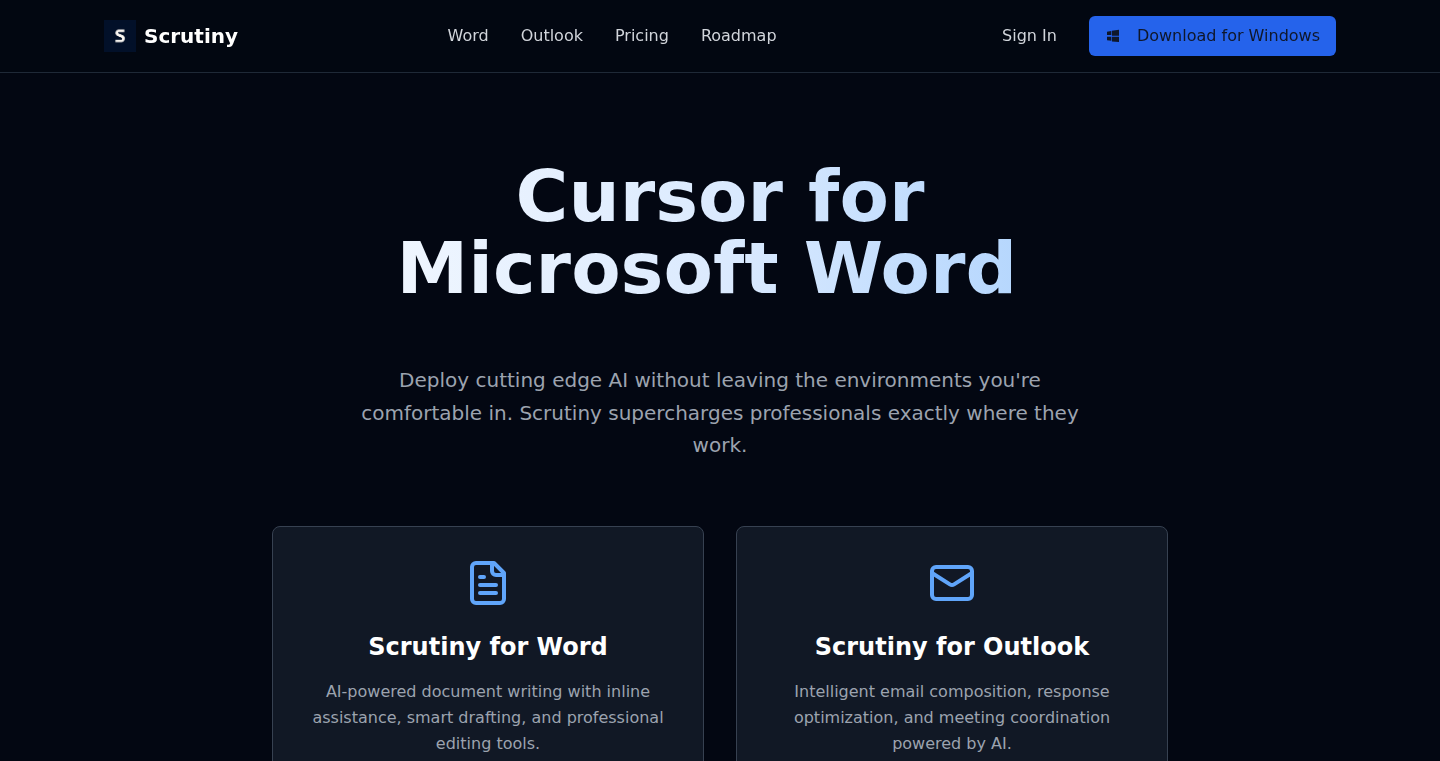
Author
manzodale
Description
Scrutiny is an AI-powered writing assistant designed to provide a smoother and more integrated experience than existing tools like Copilot. It aims to address the clunky integration and limited functionality of current AI writing tools, offering a more intuitive and efficient way for professionals to generate, refine, and polish written content directly within their workflows.
Popularity
Points 1
Comments 0
What is this product?
Scrutiny works by integrating advanced AI models directly into your writing process. Instead of having to copy and paste text into external services like ChatGPT, Scrutiny allows users to access AI-powered suggestions, corrections, and generation capabilities seamlessly within their document and email writing applications. This innovative approach addresses the inefficiencies and frustrations of current AI writing tools, providing a unified and user-friendly experience. So this gives you better and faster writing.
How to use it?
Developers and professionals can use Scrutiny by integrating it as an extension or plugin within their preferred writing environments, such as word processors or email clients. This integration allows them to leverage AI assistance directly within the context of their work. For example, if you are a developer writing a technical specification document, Scrutiny could suggest improvements to your wording, help you rephrase sentences for clarity, or even generate initial drafts based on your prompts. You can also use Scrutiny to polish documents or emails automatically. So, you can get your writing done without switching apps.
Product Core Function
· AI-powered content generation: Scrutiny can generate drafts of content based on user prompts, saving time and effort in the writing process. This is valuable because it allows users to quickly create initial versions of documents, emails, and other written materials, acting as a starting point for further refinement. So this helps you start faster.
· Contextual suggestions and corrections: The tool provides real-time suggestions and corrections to improve writing quality, including grammar, style, and clarity. This is important because it allows users to automatically improve the quality of their writing and avoid common errors, leading to more professional and effective communication. So this helps you write better.
· Seamless integration: Scrutiny integrates directly with existing writing environments, eliminating the need to switch between applications. This integration streamlines the workflow and minimizes disruptions. So this helps you focus on your work.
· Polishing and refinement: Scrutiny can automatically polish and refine written content, improving overall quality and presentation. This means your documents will look professional and easy to read.
· User-friendly interface: The tool provides an intuitive and easy-to-use interface, even for users without prior experience with AI writing tools. So it’s simple for anyone to start using.
Product Usage Case
· Developers writing technical documentation: Scrutiny can help developers write and edit their documentation more efficiently, ensuring clarity and consistency. For example, when a developer is writing API documentation, Scrutiny could suggest improvements to the description of the API parameters, clarify technical jargon, or generate sample code snippets to illustrate the functionality. So this saves you time and gets you good documentation.
· Consultants writing reports and proposals: Consultants can use Scrutiny to generate drafts, refine their wording, and ensure professional presentation in reports and proposals. For example, when a consultant is preparing a client proposal, Scrutiny can assist in creating compelling and persuasive content, ensuring that the proposal is polished and effective. So this makes you look more professional.
· Email composition: Scrutiny can assist professionals in composing clear, concise, and effective emails, improving communication and saving time. For instance, a user can leverage Scrutiny to rephrase sentences in an email to be more professional, suggest better wording for the subject line, or automatically check for grammar errors. So you get better emails.
· Academic Writing: Scrutiny can improve the clarity, conciseness, and overall quality of research papers and academic publications. For example, it can suggest better phrasing for complex ideas, correct grammatical errors, and ensure the academic tone is suitable.
98
NotebookLM Explainer: Demystifying GPT with Interactive Explanations

Author
mandarwagh
Description
NotebookLM Explainer provides an interactive way to understand the groundbreaking GPT model (likely referring to the models discussed in the 'Attention is All You Need' paper, the foundation of many GPT architectures) using Google's NotebookLM Explainer feature. It lets users explore the concepts behind GPT, making complex natural language processing (NLP) ideas more accessible. The project focuses on making cutting-edge AI research understandable, particularly the principles of Transformer models, which are the backbone of many modern AI models, allowing users to grasp how these complex models work without needing to be AI experts. So this helps me understand how the AI I use actually thinks!
Popularity
Points 1
Comments 0
What is this product?
This project leverages the explanatory capabilities of Google's NotebookLM to illuminate the internal workings of GPT, a type of AI model. It simplifies the intricate concepts behind the Transformer architecture and attention mechanisms – the key technologies that enable GPT to understand and generate human-like text. It's like having a virtual AI tutor that explains how the AI 'thinks.' So, it helps me understand the AI models behind the tools I use, such as chatbots or text summarizers.
How to use it?
Developers can use the NotebookLM Explainer by accessing the interactive explanations provided. They can then use the insights gained to enhance their own NLP projects. It can be integrated to help them better understand the underlying technologies used in their development, potentially leading to more effective AI integrations. For example, if I'm developing a chatbot, this tool can help me understand how GPT models interpret user queries and generate responses, leading to better prompt engineering or a better understanding of model limitations. So, I can use this to improve my understanding and ability to develop with AI.
Product Core Function
· Interactive Explanations: The project provides a step-by-step breakdown of GPT and Transformer models, utilizing visual aids and simplified language to explain intricate AI concepts. This is valuable because it transforms complex research papers into digestible content, allowing developers of all levels to understand the fundamental building blocks of GPT models and explore more advanced concepts.
· Visualization of Attention Mechanisms: The project likely visualizes the attention mechanisms within the models. This offers insights into how the model focuses on different parts of the input to create meaningful outputs. This is valuable because it enables users to see what aspects of the input influence the model's decisions, enabling better interpretability and tuning of their own models.
· Conceptual Mapping: By simplifying complex concepts, the project provides a structured overview of the GPT architecture. This clarifies the relationships between different components and helps developers grasp how they interact. This is valuable because it builds a solid foundation in NLP and AI, enabling developers to quickly learn and apply complex model architectures to their own projects.
Product Usage Case
· AI Model Training and Tuning: Developers can use the insights gained from NotebookLM Explainer to fine-tune their own language models more effectively. For example, by understanding how the model processes input, I can tailor training data to improve performance in specific tasks. So, this helps me build better AI.
· AI Research and Education: The Explainer can serve as an educational resource for students and researchers entering the field of NLP, simplifying the study of advanced models such as Transformers and related techniques. So, it is helpful for me if I'm learning or researching about AI.
· Prompt Engineering Optimization: By providing visibility into how the models interpret input, the Explainer aids in creating more effective prompts for AI systems. This will enhance the quality and relevance of AI-generated text, leading to better outcomes. So, this helps me create more effective prompts.
99
ParallelMistral: Fine-tuning MistralAI 7B with RLHF and Lora using DeepSpeed
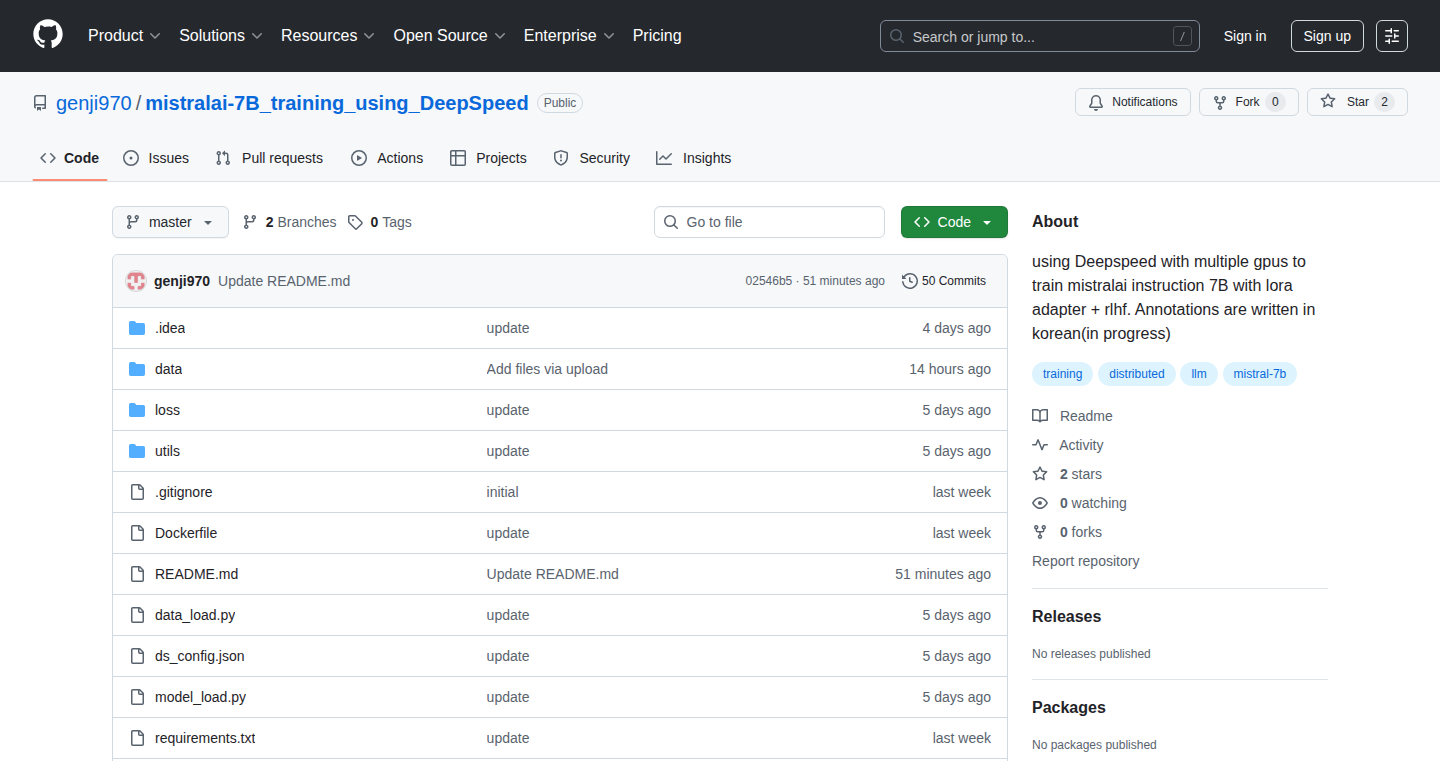
Author
genji970
Description
ParallelMistral is a project that tackles the challenge of training large language models like MistralAI 7B. It leverages techniques like Lora (Low-Rank Adaptation) and RLHF (Reinforcement Learning from Human Feedback) alongside DeepSpeed for distributed training across multiple GPUs. This allows developers to efficiently fine-tune massive models, customizing them for specific tasks and datasets. The core innovation lies in the optimized distributed training approach, enabling faster and more affordable experimentation with large language models, making advanced AI techniques more accessible.
Popularity
Points 1
Comments 0
What is this product?
This project is essentially a toolkit for training a 7-billion-parameter language model (MistralAI 7B) using cutting-edge techniques. It uses Lora, which is like adding small, specialized 'helper' networks to speed up training and reduce memory usage. It also incorporates RLHF, a process where human feedback is used to refine the model's output, making it more helpful and aligned with human preferences. The project utilizes DeepSpeed, a framework that enables efficient training across multiple graphics cards (GPUs), making the training process much faster. So this is like a turbocharged engine for training AI models. The innovation is in combining these techniques for efficient and affordable fine-tuning of powerful language models.
How to use it?
Developers can use this project as a starting point for fine-tuning the MistralAI 7B model on their own datasets. They would need to have access to multiple GPUs and some understanding of deep learning frameworks. The project provides a framework for data preparation, model configuration, and training. You could integrate it into your own machine learning pipeline by adapting the provided code and configurations. Imagine wanting to create a chatbot that specializes in a specific area (like medical advice or customer service). You could use this project to fine-tune MistralAI 7B on a dataset relevant to that area, enabling the chatbot to provide accurate and helpful responses. So this lets you build custom, powerful AI models with relative ease.
Product Core Function
· Lora Fine-tuning: This allows developers to quickly adapt a large language model to a new task without retraining the entire model. It is achieved by adding new specialized 'layers' to the original model to improve the performance on a specialized domain. Applications include quickly adapting a pre-trained model to new domains like financial analysis or medical documentation. So this means you can adapt powerful models for your specific tasks more efficiently.
· RLHF Integration: This uses human feedback to refine the model's outputs, making it more aligned with human preferences and improving its helpfulness. This involves collecting human evaluations of the model's responses and using them to reward or punish the model’s behaviour. Applications include improving the quality of chatbots or generating more natural and human-like text. So this enables creating AI that behaves as you want it to.
· DeepSpeed for Distributed Training: This uses a powerful tool (DeepSpeed) to spread the model training process across multiple GPUs, significantly accelerating the training time. This is essential for training very large language models efficiently. Applications include speeding up the training of large models for various NLP tasks. So this makes training large, complex models much faster.
· External Dataset Integration: This project allows the utilization of external data sources for training the model. This provides flexibility for users to use datasets that align with their specific use cases and requirements, fostering innovation. Applications include building chatbots that specialize in specific fields, providing targeted knowledge-based systems or generating content based on particular needs. So this opens up possibilities to train models on a variety of data.
Product Usage Case
· Building a specialized medical chatbot: A developer could use this project to fine-tune MistralAI 7B on a dataset of medical information, incorporating RLHF to ensure the chatbot provides accurate and helpful responses to patient inquiries. So this allows you to create advanced and accurate specialized AI applications.
· Creating a custom financial analysis tool: By fine-tuning the model on financial data and using Lora to add specialized capabilities, a developer could create a tool that quickly analyzes financial reports and provides insights. So this enables creating powerful, specialized tools for data analysis.
· Developing a better customer service chatbot: Using RLHF, a developer could refine a language model to better understand and respond to customer inquiries, leading to improved customer satisfaction. So this enables the creation of advanced customer service solutions.
100
French Grammar Explorer: A Free and Interactive Learning Platform
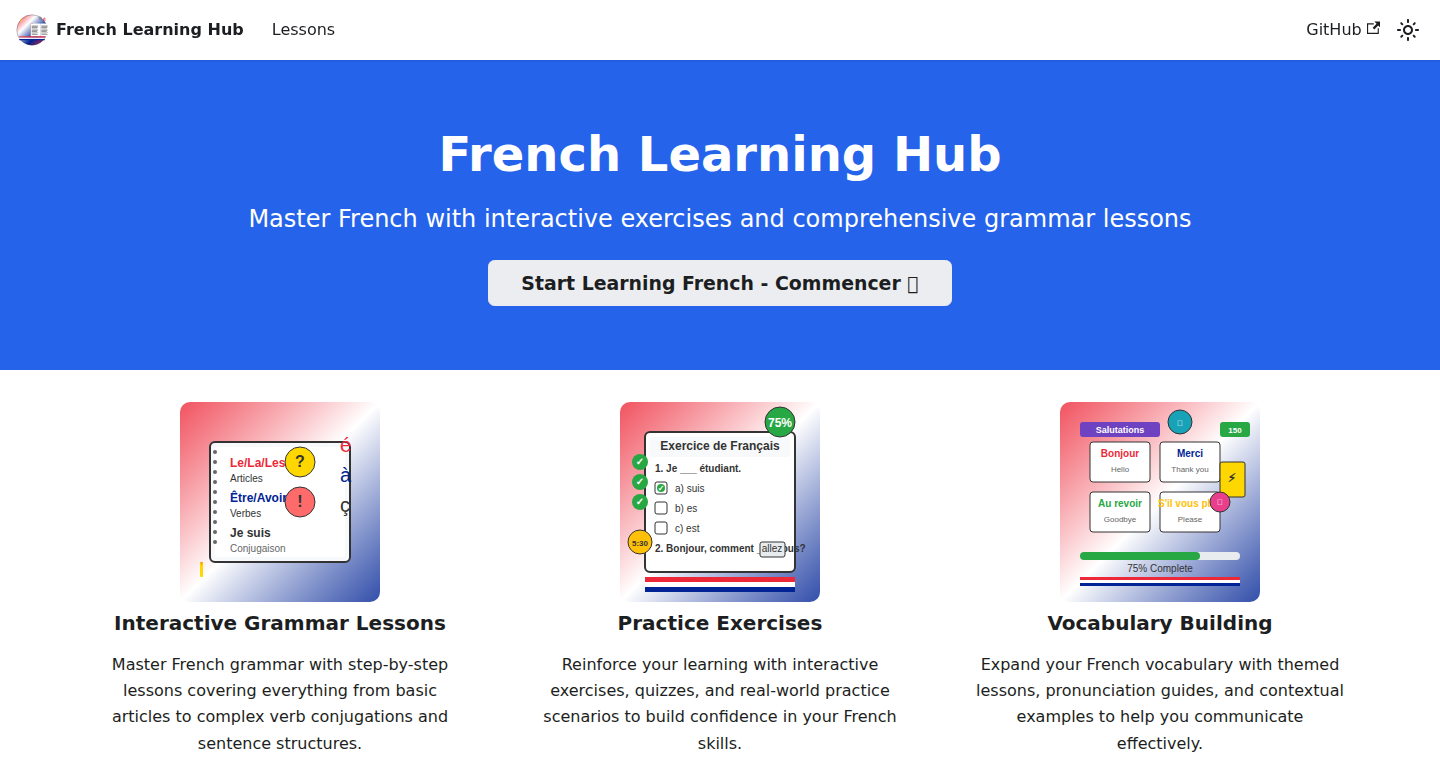
Author
hn_amallick
Description
This project offers a free and interactive platform for learning French grammar, focusing on active learning and practical application. It addresses the common problem of ineffective grammar-focused language learning approaches by providing concise lessons, practice quizzes, and real-world examples. It leverages AI to generate exercises and uses a local storage system to track progress. This provides a structured and engaging approach to mastering French grammar, enabling learners to progress efficiently.
Popularity
Points 1
Comments 0
What is this product?
This project is a website designed to teach French grammar from the beginner (A1) to intermediate (B2) levels. It uses a structured approach, breaking down grammar concepts into easily digestible lessons. The innovative aspect lies in its interactive design, with practice quizzes and exercises for each lesson. These are dynamically generated using AI and stored in a JSON format. It also incorporates goal-setting, allowing learners to track their progress. So, instead of passively reading, you actively practice, reinforcing what you learn. It provides a free and accessible alternative to expensive language courses and apps.
How to use it?
You can access the platform through your web browser. Each grammar topic is broken down into a lesson, followed by interactive exercises. The exercises test your understanding and provide immediate feedback. The site stores your progress locally, so you can pick up where you left off. You can use this platform alongside other language learning tools, like flashcards and immersive input materials. So, you can use it as a primary learning tool for French grammar or as a supplement to other learning methods.
Product Core Function
· Interactive Grammar Lessons: The platform provides concise and focused lessons on various French grammar topics, from basic to advanced, structured into levels (A1-B2). This way, you can start from the very beginning and gradually build your skills.
· AI-Generated Exercises: AI is used to generate a variety of practice quizzes and exercises for each grammar lesson. This means you get constant opportunities to test and improve your understanding. This enables active learning and better information retention.
· Real-world Examples: The platform includes pronunciation guides and sentence examples, allowing learners to see grammar concepts in context. This allows you to understand how to use grammar in real-life situations.
· Progress Tracking and Goal-Setting: Learners can track their progress and set goals using the built-in checklist. This provides motivation and helps learners stay on track. This way, you can measure your progress and know what to focus on.
· Free and Accessible: The entire platform is free to use, making it accessible to anyone who wants to learn French grammar. This removes financial barriers to language learning.
Product Usage Case
· Language Learners: A student starting French can use this platform to build a solid foundation in grammar, complementing vocabulary learning through flashcards and practice.
· Self-learners: Someone interested in improving their French grammar can use this platform to refresh their knowledge and identify areas for improvement without having to pay for a tutor or a course.
· Educators: Teachers could use this platform as a supplemental resource for their students, offering exercises and examples in addition to their own teaching materials. It can also be a good starting point for complete beginners.
· Developers: The use of AI for exercise generation and the local storage of progress provides a template for others looking to create interactive learning experiences. This allows them to build on existing work for their own education tools.
101
Digital Tombstone Generator
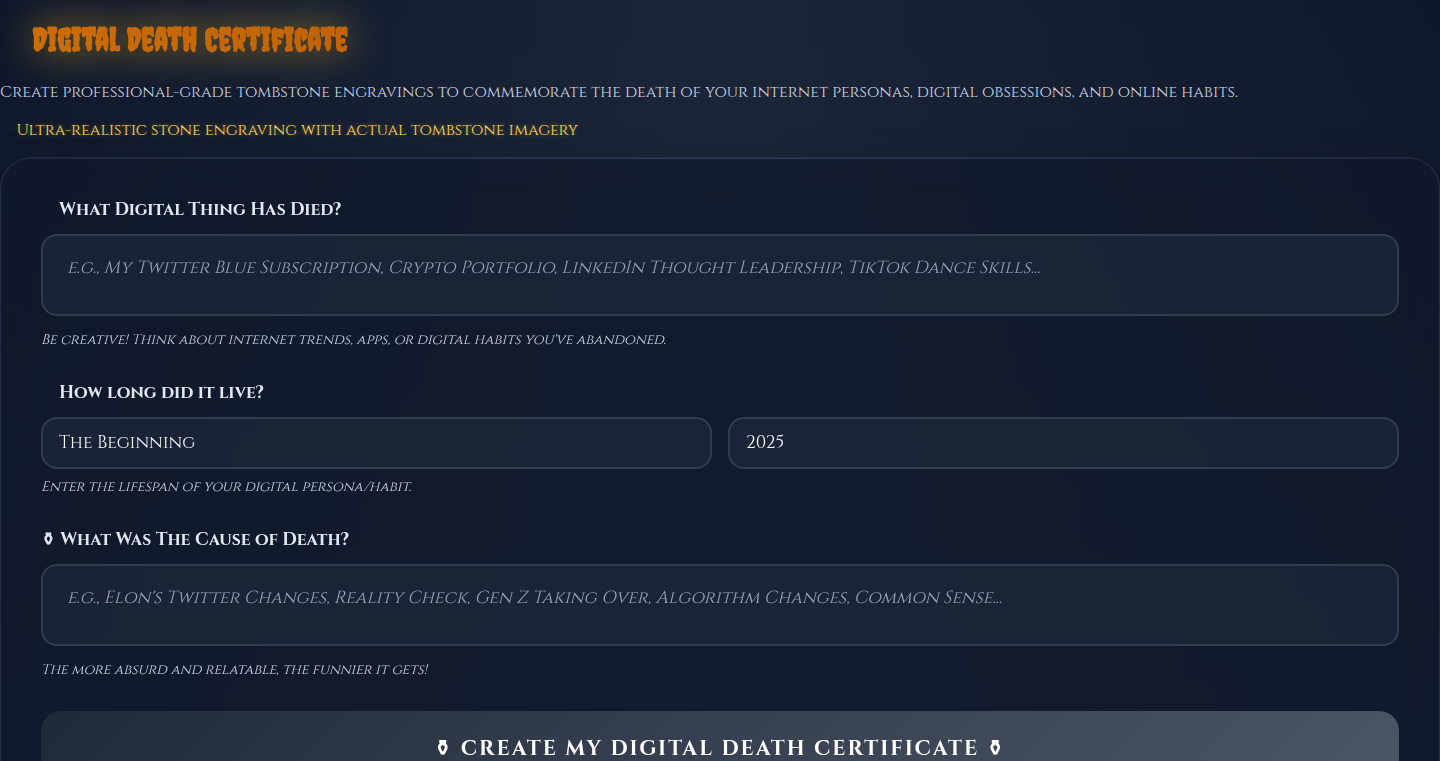
Author
SalzDevs
Description
This project allows you to create a humorous digital tombstone for things you've 'killed off' online, like bad habits or failed projects. It's a fun, creative tool that leverages simple image generation techniques to provide a unique way to reflect on digital experiences. The innovation lies in its playful approach to internet culture, turning personal digital failures into shareable, meme-worthy content. It addresses the need for a lighthearted way to mark the end of something online.
Popularity
Points 1
Comments 0
What is this product?
This project is a web-based tool that generates stylized tombstones. You provide information about the 'deceased' (e.g., a Twitter Blue subscription) including its 'lifespan' and 'cause of death.' It then uses image generation to create a tombstone image that you can download or share. The core innovation is its application of image generation to create personalized, shareable content around online experiences. So this is a fun way to document the end of your digital life.
How to use it?
Users can access the website, input the required information about their digital 'loss,' and the system will generate a tombstone image. You can then download the image or share it on social media. It's designed to be simple and intuitive. You can use it in any situation where you want to commemorate or memorialize something that has ended in your digital life. So you can create memes to share with friends on social media to have fun.
Product Core Function
· Tombstone Generation: The core functionality involves taking user input and generating an image of a tombstone. This likely uses simple image manipulation techniques, perhaps drawing on pre-made graphics and combining them with user-provided text. This is valuable because it quickly creates a custom visual asset, eliminating the need for users to design the image manually. You can use this to create personalized images quickly.
· Text Input and Formatting: Users input text for the 'deceased' (the thing that 'died'), lifespan, and cause of death. The tool then formats this text onto the tombstone graphic. The value is that it allows for flexible content creation, enabling users to express various types of digital experiences in a visually appealing way. So you can customize it and make it your own.
· Shareability and Download: The tool allows users to download the generated tombstone image or share it directly to social media. This ease of sharing is crucial for the project's viral potential. The value lies in its capacity to facilitate user engagement and content dissemination. So you can share it with friends and make it go viral!
Product Usage Case
· Social Media Content: A user cancels their subscription to a social media platform. They create a digital tombstone to humorously 'commemorate' the end of their subscription and share it on social media. This showcases the project's ability to create shareable, engaging content, boosting online interaction. So you can use it for a social media profile and become famous!
· Personal Reflection: A developer abandons a project due to lack of time. They create a tombstone to remember the failed project and the reasons for its end, using the digital tombstone as a form of digital journaling. The project helps the user to reflect on experiences. So it is useful for self-reflection.
· Community Engagement: A group of friends collectively end a shared online habit (e.g., a video game). They create a tombstone together, sharing it within their community, creating a shared experience. This demonstrates the power to foster community building through a shared digital artifact. So you can share with your friends!
102
Meditations Companion: A Collaborative Philosophical Exploration Tool

Author
huttiepant
Description
This project is a web application designed to facilitate deeper understanding and discussion of Marcus Aurelius's "Meditations." It moves beyond superficial AI-generated questions, leveraging insights from philosophy professors to craft thought-provoking prompts. The core innovation lies in its collaborative approach, allowing users to discuss their interpretations and engage with complex philosophical concepts in a structured environment. It tackles the challenge of making dense philosophical texts more accessible and stimulating intellectual discourse. So this helps me to learn and discuss philosophical books, making complex ideas more understandable.
Popularity
Points 1
Comments 0
What is this product?
It's a platform that presents users with chapter-end prompts and questions derived from "Meditations." These prompts are designed to encourage critical thinking and deep engagement with the text, moving beyond simple summaries. It's not just about reading; it's about interacting and discussing the ideas. This platform features collaboration features, allowing for discussions to enhance the learning experience. So this lets me actively learn and discuss philosophical concepts.
How to use it?
Users can access the platform, navigate to chapters of "Meditations," and respond to the provided prompts. Discussions are encouraged within the platform. Integrating it involves simply accessing the web app and participating. It's ideal for anyone interested in philosophy, self-improvement, or critical thinking. So I can use it by simply reading the book, using the questions and answers to think deeply.
Product Core Function
· Chapter-Specific Prompts: The platform offers carefully crafted questions and prompts for each chapter of "Meditations." These prompts are designed by experts to go beyond surface-level understanding, encouraging users to delve deeper into the text's philosophical concepts. So this provides me with thought-provoking questions for each chapter, ensuring a more in-depth study.
· Collaborative Discussion Forum: Users can participate in discussions surrounding the prompts, sharing their interpretations, and engaging with others' viewpoints. This collaborative aspect fosters a community of learners and provides diverse perspectives on the material. So this lets me discuss my thoughts with others to gain diverse perspectives.
· Expert-Curated Content: The questions and prompts are created and refined with the help of philosophy professors. This ensures the intellectual rigor and depth of the learning experience. So I can access prompts and questions created by experts for more meaningful discussions.
· Structured Learning Environment: The platform provides a structured way to approach the text, making complex philosophical ideas more accessible and manageable. The prompts act as a guide, directing users through the key concepts. So I can easily learn by following the prompts and learning complex ideas in a structured way.
Product Usage Case
· For Students of Philosophy: Students studying philosophy can use the platform to deepen their understanding of "Meditations." The prompts and discussions can aid in essay writing and preparing for exams. So this provides me with a collaborative tool for in-depth study and exam preparation.
· For Self-Improvement Enthusiasts: Individuals interested in self-improvement can use the platform to reflect on their own lives and practice critical thinking. The prompts provide a framework for self-reflection. So I can use it to cultivate a habit of self-reflection and develop a strong critical thinking ability.
· For Book Clubs: Book clubs or reading groups can use the platform to facilitate discussions about "Meditations." The prompts can serve as discussion starters, and the forum can be used to organize the conversation. So this lets me easily create and manage discussions on Meditations.
103
Medici: Open-Source Expense Manager
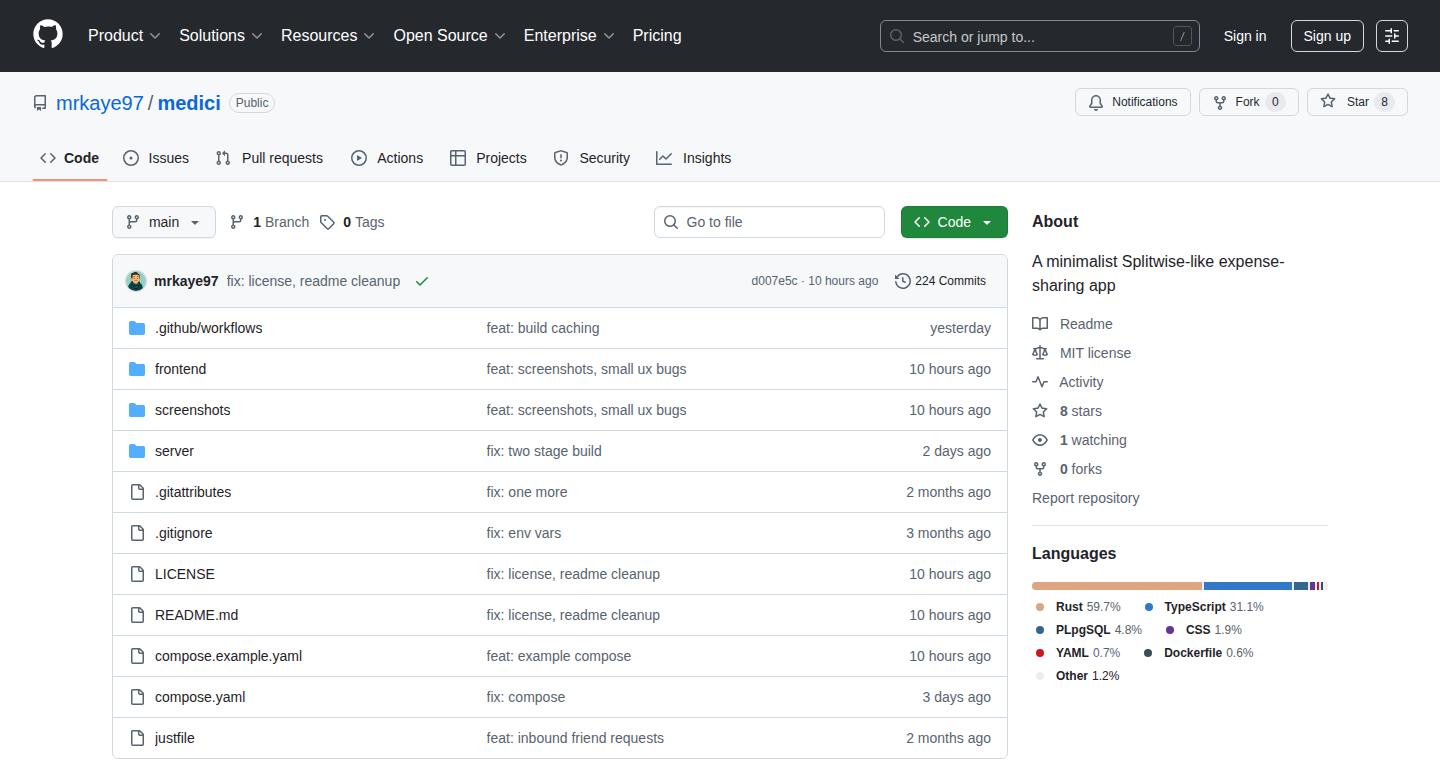
Author
mrkaye97
Description
Medici is an open-source application, much like Splitwise, designed to help you manage shared expenses. The core innovation lies in its decentralized nature and open-source architecture. Unlike proprietary solutions, Medici empowers users with control over their data and infrastructure, allowing self-hosting and customization. It tackles the limitations of commercial apps by providing unlimited expense entries and complete data ownership. This addresses the common frustration of restricted usage and data access, offering a flexible and privacy-focused alternative.
Popularity
Points 1
Comments 0
What is this product?
Medici is a web application that keeps track of who owes what in a group setting. It functions similarly to Splitwise, but with added benefits of being open-source. The main technical concept involves using a database to store expense data, implementing algorithms for debt simplification (finding the easiest way to settle debts), and providing a user-friendly interface for inputting and viewing expenses. The innovation stems from its open-source nature, allowing users to self-host it on devices like a Raspberry Pi and have full control over their data. So, the primary innovation is its open source nature and the ability to self-host on devices like Raspberry Pi.
How to use it?
Developers can use Medici by either deploying it on a server or self-hosting it. It's particularly useful for groups who share expenses, such as roommates, travel buddies, or teams. Developers can adapt and integrate Medici into their own projects. For instance, one can use the open-source code to create a custom expense management system tailored to specific needs. The integration involves setting up a server environment, configuring the application, and setting up a database. So, developers can use it to manage shared expenses or as a base to build on top of to meet custom needs.
Product Core Function
· Expense Tracking: Medici allows users to record expenses with details such as the amount, participants, and who paid. This is achieved by using a structured database to store the information and a user-friendly interface for inputting this data. This is useful for tracking all expenses among a group.
· Debt Simplification: The application simplifies debts by calculating the most efficient way for users to pay each other. The system uses algorithms to identify the minimum number of transactions needed to settle all debts. This saves time and reduces the hassle of individual settlements. This is useful for minimizing the effort in settling group expenses.
· Different Splitting Options: Medici supports various expense splitting options (e.g., equal split, split by percentage, custom amounts). This functionality involves programming the logic to handle different methods of division, allowing each user to customize the way the expenses are divided. This provides flexibility for different scenarios (e.g., shared resources used in varying quantities).
· Self-Hosting: Users can host Medici on their own server (e.g., a Raspberry Pi) rather than relying on a third-party provider. This uses a server-side application, such as a web server to display the application to the user. This gives the user complete control over their data and the application's availability. This is useful for users who prioritize privacy and data control.
· Open-Source: Medici's open-source nature means that the source code is available for anyone to view, modify, and contribute to. The code is typically managed on a platform like GitHub. This encourages community involvement, allowing developers to improve the application and customize it according to their needs. This is useful for people who want to customize the application or contribute to its improvement.
Product Usage Case
· Roommate Expense Tracking: A group of roommates can use Medici to track their shared expenses (rent, utilities, groceries). They enter their expenses, and Medici calculates who owes what, and it keeps a running total. The benefits are simplified debt management, transparency, and easy settling of dues. So, it is useful for making sure everyone pays their fair share in a group.
· Travel Group Expense Tracking: When traveling with friends, Medici can be used to manage shared costs (transportation, accommodation, activities). This application records who spent money and who contributed. The system then calculates the balance and simplifies the debts. This is particularly helpful for keeping track of travel expenses among multiple people.
· Team Project Budgeting: A team can use Medici to manage project-related expenses (software, tools, etc.). By inputting the expenses and assigning them to members, it tracks the budget. This feature is useful for tracking team expenses during a project.
104
BossOrToss: Anonymous Executive Voting Platform

Author
santiix
Description
BossOrToss.wtf is a platform for anonymously voting on real executives using publicly available LinkedIn data. The core innovation is using publicly available data and user submissions to create a gamified system for evaluating leadership. This solves the problem of providing a safe, anonymous space for employees to voice opinions about their leaders. The platform is designed to be satirical and encourages open commentary on executive performance without collecting personal data.
Popularity
Points 1
Comments 0
What is this product?
This project leverages public LinkedIn data and user submissions to create profiles of executives. Users can anonymously vote on these profiles, generating a 'Boss' or 'Toss' ranking. The system relies on a database that stores the executive profiles, vote counts, and generates leaderboards. This provides a fun, anonymous way to discuss and rate leadership. So what? This provides employees with a voice and offers a different perspective on leadership.
How to use it?
Developers can't directly use BossOrToss.wtf's core functionalities. However, developers could leverage the platform's concepts. For example, they could build similar voting platforms, analyze sentiment around leadership using open data, or create tools to facilitate anonymous feedback within their organizations. So what? It offers inspiration and a model for building applications with anonymous voting and data analysis.
Product Core Function
· Anonymous Voting System: The core functionality is allowing anonymous votes on executive profiles. This includes handling vote submissions, storing vote counts, and protecting user anonymity. So what? Provides a safe space for honest feedback without fear of repercussions.
· Executive Profile Aggregation: The system aggregates executive profiles using publicly available LinkedIn information. This involves data scraping, data cleaning, and profile display. So what? Automates the creation of a database of leadership profiles.
· Leaderboard Generation: Based on the votes, the platform generates leaderboards, ranking executives by their 'Boss' or 'Toss' rating. This involves calculating the overall score and presenting it in an easily digestible format. So what? Creates a gamified ranking that encourages user interaction and provides a clear metric for assessing leadership perception.
· User Submission System: The platform allows users to submit new executive profiles that aren't yet in the system. This needs moderation to ensure quality and prevent abuse. So what? Ensures the platform has a comprehensive profile list and allows for user contributions.
· Data Privacy Focus: The platform is built with a strong emphasis on data privacy by not collecting personal data. It utilizes only public data and user-provided submissions to provide anonymity. So what? Allows user participation without privacy concerns.
Product Usage Case
· Building Anonymous Feedback Tools: A developer could create an internal feedback tool for a company that uses a similar anonymous voting system to gauge employee sentiment about leadership or specific projects. So what? This allows for gathering valuable feedback.
· Sentiment Analysis of Public Figures: Developers can create a similar system focused on analyzing public sentiment towards public figures. This would involve collecting publicly available data and allowing users to vote and comment, aggregating the results to gain insights. So what? This allows the analysis of public opinion on leaders.
· Creating Gamified Social Platforms: The underlying principles of BossOrToss.wtf could inspire developers to create gamified social platforms focused on various topics. This could include rating products, sharing opinions, and creating communities. So what? Provides a model for building engaging and fun social platforms.
105
Rhome: Curated Content Discovery
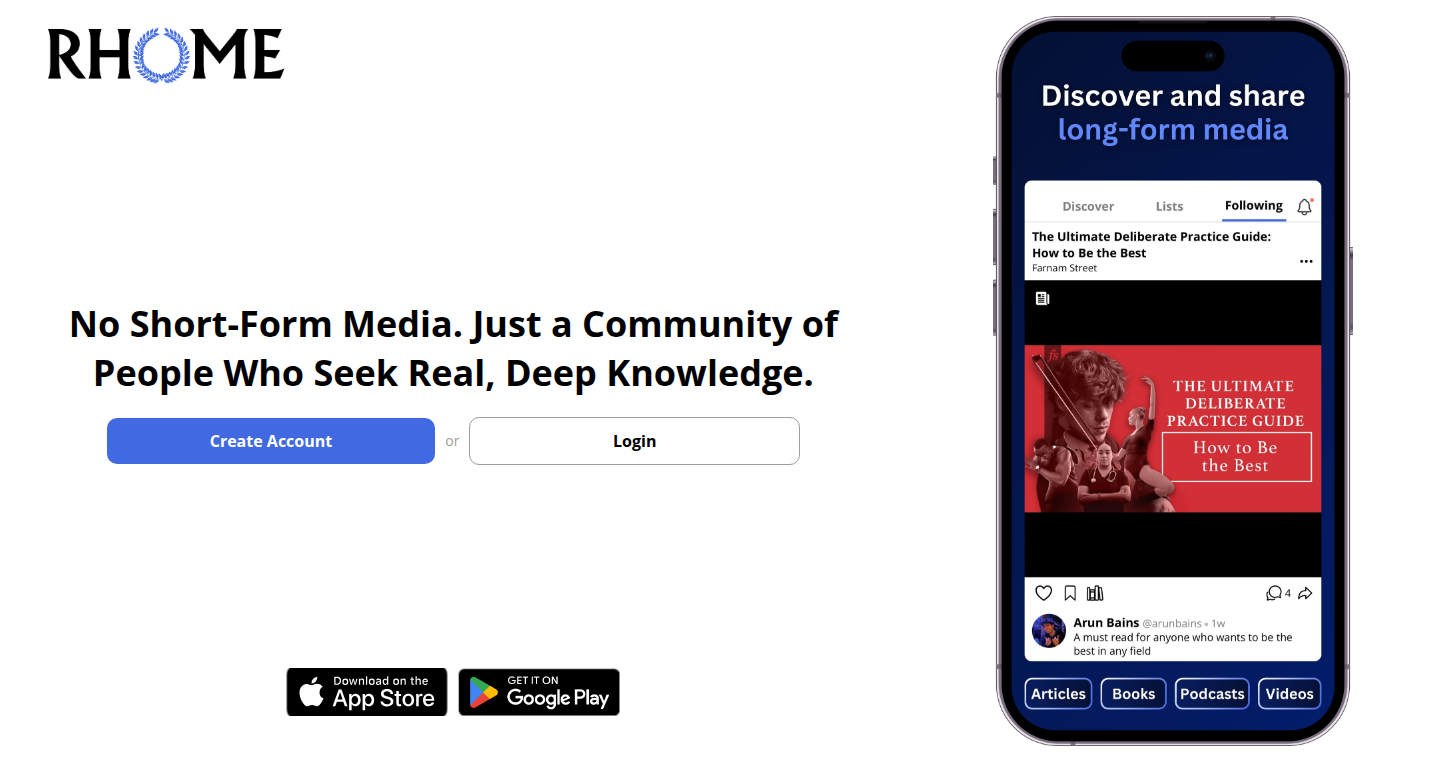
Author
rohannihalani
Description
Rhome is a platform designed to combat the overwhelming amount of short-form, low-effort content prevalent on many platforms. It focuses on delivering trusted recommendations of longer-form content like books, articles, podcasts, and movies, curated by friends and thoughtful individuals. The core innovation lies in its intentional avoidance of infinite feeds, meaningless likes, and the dopamine-driven loops of quick content. Instead, it offers a more focused and meaningful content discovery experience, prioritizing quality over quantity and connecting users with content shared by people they trust. So this helps me discover quality content without getting lost in a sea of fleeting information.
Popularity
Points 1
Comments 0
What is this product?
Rhome is essentially a recommendation engine, but instead of algorithms pushing random content, it relies on human curation from trusted sources. It works by allowing users to share their favorite longer-form content. The platform then aggregates these recommendations, creating a personalized and curated feed. The innovation is in its focus on quality and the user's trusted network, providing a refreshing alternative to platforms that prioritize engagement metrics and short-form content. So it's a better way to find good books, articles, etc., because it is curated by my friends, not by some algorithm.
How to use it?
Users can explore recommendations by following friends or specific curators. They can also contribute by sharing their own content recommendations. For developers, Rhome's potential lies in its API (if available), allowing integration with other apps or services to pull curated content into their own platforms. Imagine building a book club app that utilizes Rhome's curated lists. So, I can use it to find good content to read and can be used in my own apps.
Product Core Function
· Curated Recommendation Feed: The core function is presenting a feed of content recommendations from trusted sources. This eliminates the information overload that plagues many platforms, ensuring users only see content they are likely to find valuable. This benefits me because I can find interesting content without having to wade through tons of useless content.
· Social Content Sharing: Users can share their own content recommendations, forming a community around shared interests. This leverages the power of social networks to filter and curate information, enhancing the quality of content discovered. This is useful because I get to see what my friends are interested in and find more interesting content myself.
· Anti-Dopamine Loop Design: The platform is designed to avoid the addictive features common on social media. This means no infinite scrolling, no obsessive 'like' counts, and no short-form content designed for quick consumption. This design choice promotes a healthier relationship with content consumption. This is useful because I will not be easily addicted to checking the platform and I will be able to maintain focus.
· Content Filtering and Categorization: Rhome likely offers features that allow users to filter and categorize the content they are looking for or sharing. This could be tags, categories or other metadata. This makes it easier for users to find the exact content they are looking for and enhances discovery. This is very useful because I can narrow down the content I am interested in.
· User Profile and Following: Users can create profiles and follow other users to build a personalized experience based on trusted individuals' recommendations. It creates a network effect for trusted sources of content. So I can easily filter the content based on the people I trust.
Product Usage Case
· Building a Book Club App: A developer could use Rhome's API to populate a book club app with recommended books from a community of book lovers, ensuring members get access to curated, high-quality recommendations instead of relying on generic lists. So my book club app will be more interesting.
· Creating a Personalized Learning Platform: A developer could integrate Rhome to provide users with curated articles and podcasts relevant to their learning goals, ensuring a more focused and less distracting learning experience. So my students will have access to more reliable learning resources.
· Developing a Content Discovery Extension: A browser extension could be built to integrate with Rhome, allowing users to easily save and share content they find interesting while browsing, providing a seamless way to contribute to the platform's curated ecosystem. So, I can seamlessly share content without using the platform directly.
· Developing a platform to share long-form content: A developer can build an app similar to Rhome, allowing users to share and discover long-form content in a more human-centric way, which means people actually recommend the content instead of some algorithms. This ensures that the user receives more high quality content.
106
Tube2Note: YouTube Channel Summarizer
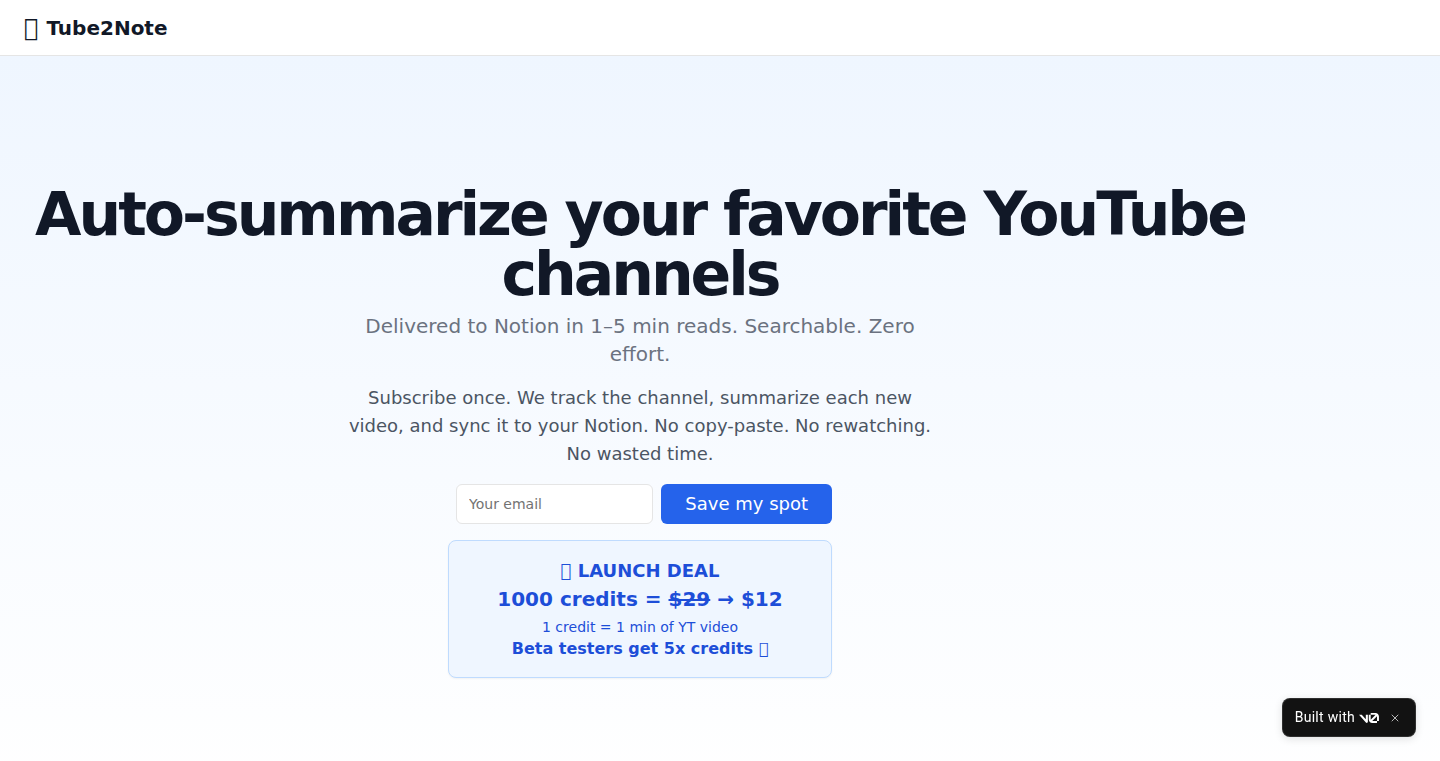
Author
geekykalai
Description
Tube2Note is a tool that automatically generates concise, two-minute summaries of YouTube videos from a given channel and integrates them into your Notion workspace. The core innovation lies in its ability to process video transcripts, extract key information, and format it into easily digestible summaries within Notion. This simplifies the process of keeping up with content from multiple YouTube channels, turning long videos into quick, actionable insights.
Popularity
Points 1
Comments 0
What is this product?
Tube2Note works by taking the transcripts from YouTube videos (converting speech to text), analyzing them to find the most important parts, and then summarizing those parts into a two-minute digest. It then automatically adds these summaries to your Notion notes. This is a clever way to quickly get the gist of a video without watching the entire thing. So, it gives you a faster way to learn from videos.
How to use it?
To use Tube2Note, you simply provide it with the URL of a YouTube channel. It will then automatically generate summaries for all the videos on that channel and add them to your Notion database. This allows you to integrate video content directly into your existing note-taking workflow. You can then easily search, organize, and review these summaries alongside your other notes. So, you can use it to build a personal knowledge base from your favorite YouTube channels.
Product Core Function
· YouTube Transcript Extraction: Tube2Note extracts the text from YouTube video transcripts. This is the foundation for all other features, enabling the tool to analyze video content without manual input. For example, if you need to quickly understand the content of a tutorial video, this feature directly provides the textual data needed.
· Summary Generation: It summarizes lengthy video transcripts into brief, two-minute overviews. This helps users to quickly grasp the essential ideas of a video without investing a lot of time. If you are researching a topic, this allows you to scan several videos quickly.
· Notion Integration: The tool seamlessly integrates the video summaries into a user's Notion workspace. This helps users to organize the video summaries alongside other notes, which helps to create a consolidated knowledge base. This allows easy access to all your important notes from different sources.
· Automated Processing: Tube2Note automatically processes all videos on a given YouTube channel. This saves the user from manually summarizing each video. If you are following multiple YouTube channels, you can automate your learning process without manual involvement.
Product Usage Case
· Research and Learning: A researcher following multiple tech channels can use Tube2Note to quickly understand the content of new videos without watching them in their entirety. By receiving the key insights of a video in 2-min summary, the researcher can determine which videos are most relevant for deeper study.
· Knowledge Management: A student can use Tube2Note to summarize educational videos and add the summaries into their Notion notes. This creates an organized and accessible knowledge repository for exam preparation or project work.
· Content Curation: A content creator can use Tube2Note to summarize competitor's video content and store the summaries into their Notion. This facilitates quick content analysis and competitive research.
· Personal Productivity: Someone who uses YouTube for learning can utilize Tube2Note to efficiently extract the core information of the video into structured, searchable notes. This enables faster information retrieval and knowledge retention.